- All Tours & Activities
- Northern Lights Tours
- Golden Circle Tours
- South Shore Tours
- Blue Lagoon Tours
- Sky Lagoon Tours
- Hvammsvík Hot Spring Tours
- Hot Springs & Pools
- Volcano Tours
- Adventure Tours
- Reykjavik City Tours
- Super Jeep Tours
- Special Offers
- Private Tours
- Meet on Location
- Highland Bus

Your Cart is empty
Looks like you haven’t picked any tours yet!
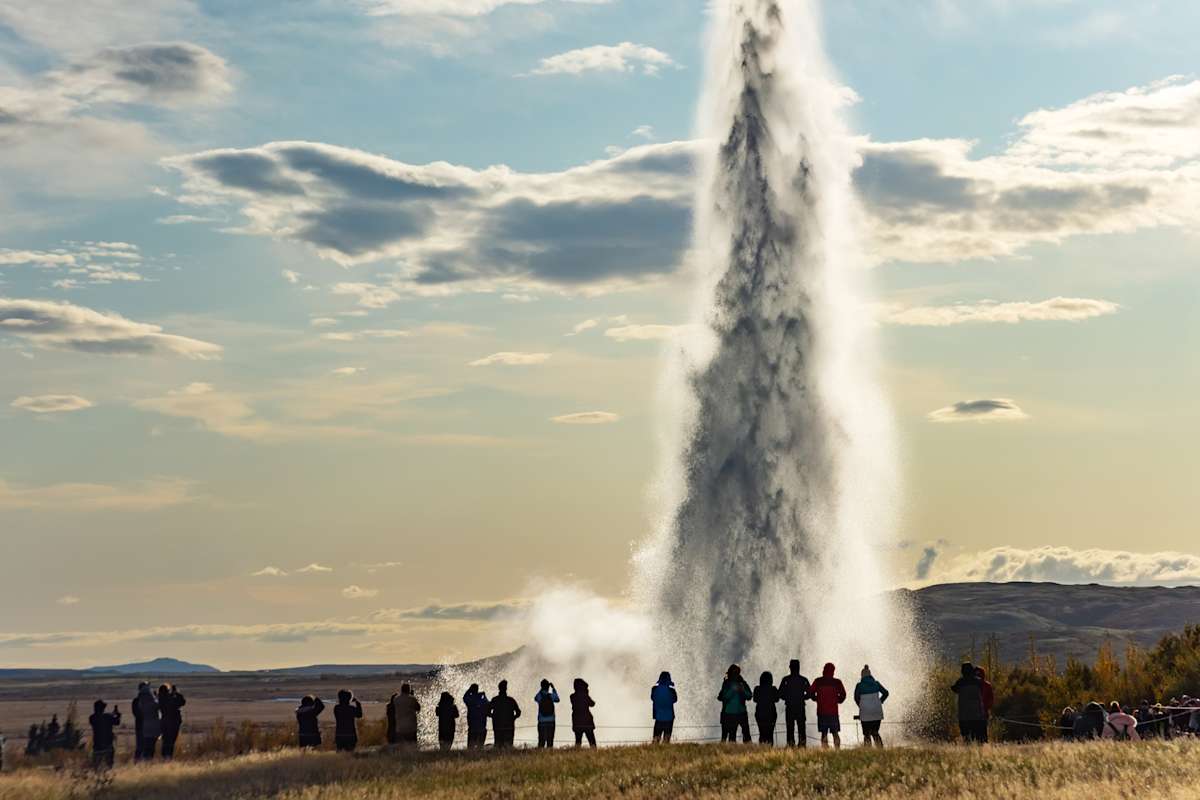
Your Ultimate Guide to Geysir, Iceland: All You Need to Know
November 2, 2022
The Great Geysir, or often simply Geysir, is truly a must-see on any trip to Iceland. It’s not just because of its awesome power and captivating display—although that might well be enough. But it’s also due to its crucial role in the history of geology. Combined these facts make for an unforgettable destination. Read on to find out why the place holds such a fascination—and how you can visit for yourself. While you’re here, discover the best tours to see Geysir in Iceland too.
What is the Geysir in Iceland?
The Geysir, Iceland, is one of the most impressive geological sights in the country, among tough competition. It’s where visitors can see the power of the earth’s geothermal activity up close.
A geyser is a phenomenon where water is dramatically ejected from below the surface of the earth. It’s a type of spring, but not one where you can enjoy a tranquil bath. Rather, geysers are known for their violent eruptions that can fire water high into the sky.
Iceland’s Great Geysir is the place that originally gave this phenomenon its name. That’s because it was the first geyser to be known by Europeans, as far back as 800 years ago, when eruptions were actually much higher and much more frequent. That’s why, when you come to Geysir, you’re walking in an important historic place—not just in the site of an incredible geological display.
Today, the geyser fires water up into the sky to a height of about 70 metres (230 feet). However, in recent decades it has become a little unreliable. You’ll be very lucky if you witness an eruption for yourself.
Yet, as you’ll discover, Geysir—whose name means something like “the one who gushes”—is not the only geothermal wonder in the area. Here in the larger Geysir Geothermal Area, you’ll find other geysers—such as Strokkur—as well as fumaroles, hot springs, and more.
Explore the Geothermal Area on Iceland’s Golden Circle, probably the most famous travel itinerary in Iceland. Discover more about this favourite site below.
The history of Geysir
Today, Geysir is known as one of the most compelling sights in all of Iceland. And in truth, it’s been that way for years, if not centuries. As early as the 18th century scientists and curious visitors were coming to the site, but the area likely held fascination long before that too.
In fact, recent investigations have shown that Geysir has been active for at least 10,000 years. And the site has definitely been known about since at least 1294, when dramatic earthquakes caused new springs to form in the area.
It’s said that Geysir once erupted with a much more powerful force. Reports suggest that back in the 19th century, its waters would reach up to 170 metres (560 feet) high. In the year 2000, some eruptions caused the water to reach 122 metres (400 feet). However, such heights haven’t been seen since.
What’s particularly interesting is that Geysir’s periods of intense activity often come at times just after large earthquakes—and then tend to subside afterwards. Historical sources suggest that once upon a time, Geysir’s eruptions were so strong that they made the earth tremble.
These days, the Great Geysir is less reliable, occasionally erupting with great power, but usually not doing very much at all. Luckily, though, there are other geysers to keep you entertained.
Strokkur geyser and other sights in the Geothermal Area
After Geysir itself, Strokkur is the most impressive geyser in the geothermal area. It doesn’t quite reach the heights of Geysir in its prime, but it’s an incredible display nonetheless. The waters of Strokkur often reach over 40 metres (131 feet).
What’s more, Strokkur is more regular, erupting every 5 to 10 minutes. Each gushing torrent of water is accompanied by the gasps and cheers of the surrounding crowds. And for good reason: it’s a euphoric collective experience.
However, that’s not the only sight you can witness here in the Geothermal Area. To begin with, there are other geysers—including the spellbinding Smiður and Litli-Strokkur, both smaller than Strokkur but no less charming.
Then, notably, there are the fumaroles, bubbling holes in the ground releasing steam and other gases. They’re not just for geology nerds. Rather, these steaming cavities give you an insight into what’s happening beneath the surface of the earth.
Geysir and the Golden Circle
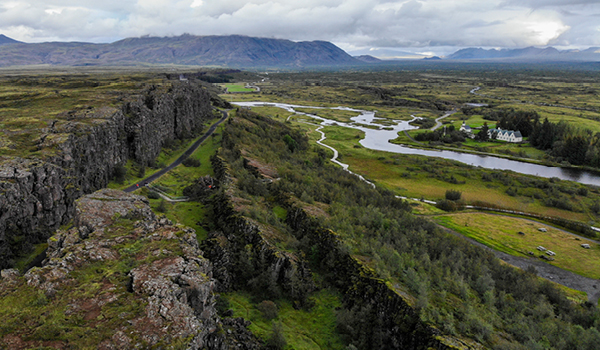
The Geysir Geothermal Area sits on the Golden Circle, probably the best-known travel itinerary in Iceland. Also including Gullfoss Waterfall and Þingvellir National Park , the Golden Circle takes you through the most important historical and scenic sights in the south of the country. If you have only limited time in Iceland, this is the itinerary you should choose.
You’ll see why for yourself. Gullfoss Waterfall, with its powerful torrent of glacial water that surges through the canyon, is simply astonishing in its drama. By some estimates, it’s the largest waterfall in Europe by volume. It’s definitely up there among the most beautiful.
Then there’s Þingvellir National Park. This was the site of Iceland’s original parliament, the Þingvellir, which was formed here back in the year 930 to become the oldest continual parliament in the world. It’s no exaggeration to say that you’re walking in the footsteps of history.
Yet that’s not the only thing to see at Þingvellir. For example, you can explore the fissure between two continents. Or, if you’re brave enough, dive into Silfra, the intercontinental canyon at the heart of the Þingvallatn Lake. It’s said to have the clearest waters in the world.
- Find out more: Your Ultimate Guide to the Golden Circle
Visiting Geysir and the Geothermal Park
The captivating power of Geysir and Strokkur await in the Geothermal Area. But what do you need to know before you get there? Here we have some tips so you can best prepare your visit.
Where are Geysir and Strokkur located?
Geysir and Strokkur are located in the Geysir Geothermal Area, in the valley known as Haukadalur Valley in South Iceland. It’s a short distance from the foot of the glacier, Langjökull.
The area is about 1.5 hours from downtown Reykjavik by road, travelling toward Iceland’s Highlands, making it really easy to reach by car or coach.
How to get to Geysir?
Most visitors to Iceland reach Geysir using one of two options. Ultimately, the choice is yours.
Firstly, many choose to hire a car and make the journey themselves. This has its perks, including the freedom to travel on your own schedule and decide for yourself how long to spend at Geysir. However, it does come with its disadvantages, including the fact that in winter the roads can be a little difficult to navigate if you’re not experienced in Icelandic conditions.
Alternatively, you can join a tour. These will take the stress out of the travel, while offering added extras, including an expert guide and trips to nearby sights, so you can get a full experience.
Whichever way you choose to visit, we recommend you add Þingvellir and Gullfoss to your trip to Geysir—so you can enjoy the full Golden Circle experience.
How much time do you need at Geysir Iceland?
Most people recommend spending at least an hour at Geysir, so that you can see all of the geothermal displays that the area has to offer. However, for the keen visitor, the area can reward much longer.
In fact, if you have the time to spare, we recommend that you take a longer walk into the Haukadalur Valley. Even if the geysers weren’t here, you’d still be in an incredibly beautiful place.
Facilities at the Geysir Geothermal Area
At Geysir, you’ll find plenty of facilities to make your visit comfortable. Alongside free parking and separate coach parking, there are toilets and even a campsite and plenty of hotels.
You’ll also find a restaurant, shop, and a golf course at the nearby Geysir Centre.
Natural springs and hot water in Iceland
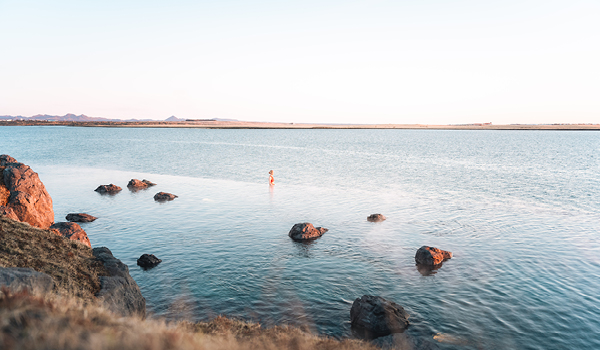
They might be the most spectacular sight, but geysers are not the only incredible feature of Iceland’s geothermal activity. Thanks to the country’s subterranean heating system—i.e. active volcanic processes—you can enjoy other amazing experiences too.
Imagine bathing in a natural warm river, or taking a dip in the wild pools in the heart of the Icelandic highlands. More mundanely, but perhaps no less impressive, consider showering at home beneath water heated by the power of the earth.
In Iceland, all this is possible. And besides offering the tranquil beauty of the hot springs, all this hot water gives Iceland one of the most sustainable energy systems in the world too.
- Find out more: Hot Water in Iceland: Your Complete Guide
What is the best time of year to visit the Geysir Geothermal Area?
Like most of the other incredible sights on Iceland’s south coast, there’s no best time to visit Geysir. During both the bright nights of Icelandic summer, and the short days of winter, when snow fills the Haukadalur valley, this remains a spectacular place.
Geysir is open all year round and rewards a visit whenever you come to explore. The only thing to consider is the weather.
See Geysir in the summer
Visiting the Geysir Geothermal Area in summer is simply a joy. Temperatures are comfortable—sometimes even above 20°C (68°F)—and the snows are likely to have disappeared completely.
Meanwhile, the longer days of summer allow for longer visiting hours. In fact, visiting the area at night is a special, mystical experience. As you might expect, visitor numbers are higher in the summer, but this won’t affect the wonder of the experience. It’s a delight to behold Strokkur’s dramatic eruptions nonetheless.
Visit Geysir in winter
The mood of the Geothermal Area changes during the winter. The ground is typically white and the cold air adds a wild element to the area. What doesn’t change is Strokkur’s incredible spurts of water.
Arriving at Geysir in late winter morning as the sun comes up can be one of the best times to photograph the waters of the geysers. The light is tranquil and muted, offering a softer backdrop to the violence of the eruptions.
Watch out though. Driving yourself to the site in winter can be difficult, with dark skies and unpredictable weather. Many visitors prefer to take a bus during this time.
Obviously, don’t forget to wrap up warm. Even though the waters of Strokkur are warm, there’s no doubt you’ll feel the cold.
Spa experiences in Iceland
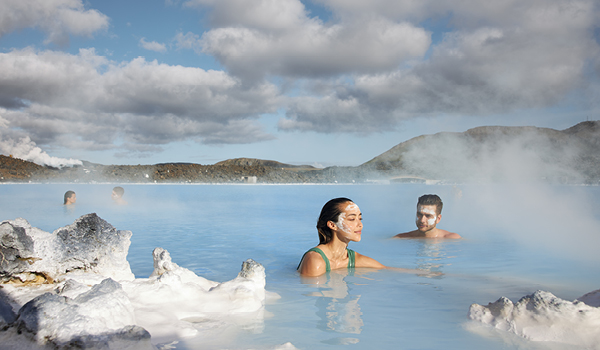
The same power that heats the waters of Geysir also makes one of Iceland’s most famous experiences possible. Geothermal energy warms the waters of spas and pools across the country, offering Icelanders and visitors the perfect places to relax.
Probably the most famous is the Blue Lagoon , whose mineral-rich waters are thought to have therapeutic qualities. Its name comes from the blue appearance of the water, caused by the silt at the bottom of the pool.
The newest addition to Iceland’s range of spas is the Sky Lagoon . Only a stone’s throw from downtown Reykjavik, here you can enjoy the spa’s heated waters while overlooking the wild waves of the Atlantic Ocean.
Wherever you are in Iceland, there are many more spas to choose from—including Geosea in Húsavík or the dramatic Giljaböð, the Húsafell Mountains Baths. - Find out more: Hot Springs & Geothermal Pools in Iceland: Your Guide
FAQs about the Geysir Geothermal Area
Want to know more about Geysir and the surrounding area? Here, we answer some of your most frequently asked questions.
How often does Geysir in Iceland erupt?
Once upon a time, Geysir would erupt frequently—often as regularly as every 3 hours. However, the Great Geysir is no longer as reliable as it once was. While it’s still technically active, it erupted last in 2016 and before that only in 2000.
However, this can change. Typically, eruptions tend to happen after earthquakes. If there’s one soon, Geysir may become more regular again.
How often does Strokkur in Iceland erupt?
Unlike its more famous counterpart, Strokkur erupts regularly. We’re talking every 5-10 minutes. Not every eruption is equal in size, but they can reach up to 40 metres high. If you only see a small burst, wait for the next eruption, which will likely be much larger.
How deep is the Geysir in Iceland?
When it’s not erupting, Geysir is a circular pool. This pool is 1.2 metres deep (about 4 feet) and 18 metres in diameter (60 feet). However, the cavities that feed the geyser are much much deeper, stretching down far into the crust of the earth.
Can you swim in Geysir?
No, you cannot swim in Geysir—and nor would you want to. The waters of the pool—and that of the other geysers in the area—are hot enough to burn you. Please don’t try it!
Do you have to pay to see the Geysir in Iceland?
No, you do not have to pay to see the Geysir in Iceland. Entrance to the area is free and there is no charge for the car park.
Can you see Geysir at night?
The Geothermal Area is open 24 hours a day, meaning that you can see Geysir at night too. In fact, some visitors suggest that the best time to visit is late in the evening, when the sun is just about to set.
Tours of Geysir and other attractions
Whenever you want to visit the incredible display of the geysers, at Reykjavik Excursions we can help. Throughout the year, we run tour packages that can take you to all of the most impressive sights across southern Iceland and the south coast.
The Golden Circle direct is our classic tour of Iceland’s most famous itinerary, taking in the Geysir area, Gullfoss Waterfall, and Þingvellir National Park. It’s an unforgettable day out. But you can visit the Geysir on any of our tours of the Golden Circle, including:
Langjökull and Golden Circle tour
Geysir sits just below the imposing glacier known as Langjökull. On a combined tour, you can see all of the sights of the Golden Circle and explore the glacier by monster truck. Alternatively, visit the glacier by snowmobile. - Book your tickets: Golden Circle and Langjökull tour
A short distance from Geysir is one of the most surprising places in southern Iceland: Friðheimar, a greenhouse and restaurant in which ingredients are grown with geothermal heat. It’s an incredible way to see how Icelanders have put geothermal activity to innovative use.
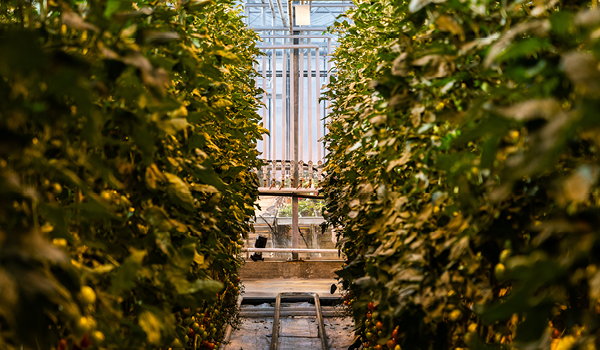
Book it here: Northern lights and the Golden Circle
Lava Tunnel
At Geysir, you’ll see how geothermal energy forces hot water out into the world above ground. But you can get a different perspective on these amazing natural processes by venturing below the surface of the earth yourself. That’s what you can do at the Lava Tunnel at Raufarhólshellir. In places reaching 30 metres wide (98 feet), this tunnel is thousands of years old and testament to the power of volcanic activity.
- Add it to your Golden Circle itinerary: Lava tunnel and Golden Circle tour
Laugarvatn Fontana Geothermal Spa
After a long day exploring the Golden Circle, why not unwind in the warm waters of a geothermal spa? Laugarvatn Fontana is one of the most luxurious spa locations close to Geysir, and it’s the perfect way to bring your journey to a close. - Book your tickets here: Laugarvatn Fontana Geothermal Spa and Golden Circle
Visit Geysir for yourself with Reykjavik Excursions
At Geysir, all manner of wonders await. And when joining a tour with Reykjavik Excursions, you can enjoy all that this amazing place offers in comfort and hassle-free.
Whichever tour you choose, we’ll ensure your journey is easy, packed with expert information, and full of the joys of authentic travel. We run the vast majority of our tours all year round, so we’re a reliable presence across the south of Iceland whichever season you visit.
Alternatively, if a group tour is not for you, we can help you organise custom trips that give you exactly what you want from your stay in Iceland—whether that’s private tours or group visits.
- Get started by exploring our tours to visit Geysir and Strokkur geyser in Iceland .

GOLDEN CIRCLE BLOG
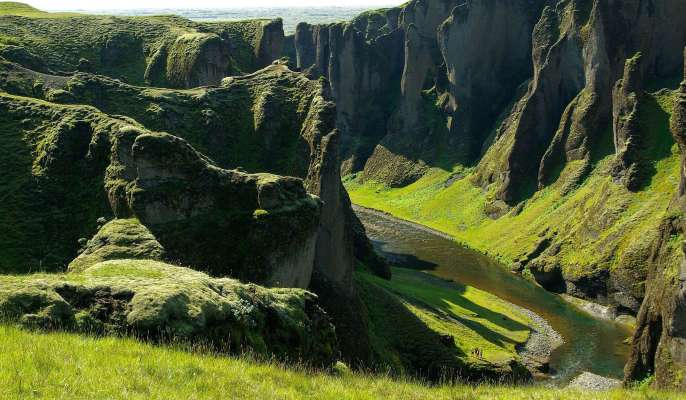
Your Top 15 Must-See Places Around Iceland
Volcanic peaks, Europe’s largest glaciers, and otherworldly coastlines—Iceland is home to some of the most captivating landscapes in the world. And on a trip to Iceland, you’ll experience some of these awesome sights for yourself.

Geysir, Iceland: The Ultimate Guide for a Great Visit
For travelers planning an itinerary that includes Geysir in Iceland, whether it is during the cold of winter or the warmer month of July, there is no lack of things to do, places to go, and interesting things to experience.
And with both the Great Geysir itself and the area around it being some of the most spectacular things to see in Iceland, knowing just what to see and do will help you make sure you take full advantage of this incredible place!

Table of Contents
What is Geysir in Iceland ?
Geysir is one of the most well known and spectacular geological features in Iceland. Located in the middle of the Golden Circle’s Haukadalur Valley, this famous hot spring is visited by thousands of tourists every year and is an absolute must-do for anyone traveling to the country.
Considering Iceland is a country known for its almost otherworldly features like volcanoes, craters, and glaciers, naming this as one of the most impressive things to see is really saying a lot. If you also make the trek to come and see the area’s stunning natural display, stick around long enough and you’ll soon say the same.
Geysir offers a volcanic natural phenomenon that causes eruptions shooting jets of boiling water up to 70 meters (230 feet) into the air. This haven of volcanic activity is one of the most popular destinations in Iceland, and making the trip out there will definitely be a highlight.

While the earliest written accounts of the Geysir and the surrounding hot springs in the Hakadalur Valley only date back to 1294 , research suggests that Geysir has been active for around 10,000 years. It is possible that records of the phenomenon only go back to the medieval period because earthquakes in the area around that time caused the landscape to shift, creating roughly the same environment in Iceland’s valley that we know today.
FYI: In case you were wondering, “Geysir” is the namesake for the English word “geyser” , which is used to describe any geothermal phenomenon of water shooting out of the ground. It’s because Geysir in Iceland was the first geyser discovered by modern Europeans.
Unfortunately, catching the Geysir in action is not as simple as traveling out to it and waiting for it to erupt. The Great Geysir in Iceland is firmly in its inactive phase, with the nearby geyser called Strokkur being much more impressive, erupting every few minutes up to 30 meters (98 feet) in height.
How often does Geysir in Iceland erupt?
The Great Geysir currently lies dormant and has been inactive since 1916. Since 2000, it has only erupted twice (once in 2000 and again in 2016). So, unless you’ve unlocked the secret of time travel, your odds of seeing this beast in action are, sadly, quite low.
However, a trip out to the Haukadalur Valley is still plenty worth your while, as the area boasts several other geysers that are much more active, even if they aren’t as big. In particular, as just mentioned, Geysir’s little brother, Strokkur, for example, erupts every 15 minutes or so.
How does Geysir erupt?
Because the Haukadalur Valley and Golden Circle are extremely volcanic areas, there are tons of hot bedrock lying deep below the surface. Once groundwater comes into contact with this hot bedrock, pressure is built, and the water starts to heat up. Over time, once the water reaches peak pressure and temperature, it causes an eruption.
With that being said, Geysir in Iceland has erupted a few times in the past 100 years, but these instances have been almost completely isolated from one another.
For example, in 1935 a furrow was built under the Geysir in order to restore its activity, but in time, it began to lose its effect. The furrow was reopened a few more times in the 20th century, but since Geysir went dormant in 1916, there have only been a couple of instances of natural eruptions.

Why did the Great Geysir start erupting again in 2000?
Throughout its history, earthquakes have been known to reverse the Great Geysir’s inactive status by briefly resuscitating it from its inactivity. There have been a couple of examples of this since 2000. A particularly powerful earthquake caused Geysir to erupt for two days straight, shooting water up in the air to a maximum height of 122 meters.
This towering jet of water would have been much higher than what 19th-century research suggests the typical height for an eruption was when it was still active, which was roughly 45-55 meters (148-177 feet).
Geysir saw another – albeit much less dramatic – eruption in 2016 , which was little more than a tower of steam shooting out of the spring. Still, considering it has been inactive for so long, there was much more activity than the area is used to.
How long do you need at Geysir in Iceland ?
For Geysir itself, you really don’t need too much time to visit. As you may have already gathered, the odds of anything really exciting and worthwhile happening here are slim to none. But, there is still plenty to do once you are in the Hakadalur valley, and it’s easy to spend an hour or more there.
Because the Strokkur geyser erupts roughly every 15 minutes , at the very least, you should spend enough time waiting around the area so you can see it erupt. Taking a video or two and some good pictures will definitely be worth your time.

Once you see Geysir and an eruption or two at Strokkur, as well as checking out the other smaller geysers in the area, you ought to take a hike around the surrounding area in the Hakadalur valley. An hour or two should be plenty, and there are some incredible photo ops all over.
After a quick hike and some sightseeing, you might want to grab a bite to eat nearby before either heading back to your hotel or exploring the rest of the valley and the Golden Circle. Some crowd favorites for food in the area are Skjol, Geysir Glima Restaurant, and Vid Faxa.
How much does it cost to visit Geysir?
Fortunately for all you adventurers out there, getting to visit the natural phenomenon of Geysir is absolutely free. Hakadalur Valley has absolutely no entry fee, so you can enjoy all the stunning nature that it has to offer without putting a burden on your wallet.
However, there are, of course, costs associated with actually getting to Geysir. Assuming you’re staying in Iceland’s capital, Reykjavik, a bus ticket to Hakadalur Valley would cost the equivalent of between $90 and $119. This, along with renting a car, is the quickest way to get there, and it takes between two and a half to three hours.
Related: Can You Use Euros in Iceland to Pay for Things?
For those looking to experience the Geysir in Iceland, the Hakadalur Valley, and the Golden Circle in its entirety, there are plenty of tour companies that offer to take tourists around the whole 250 kilometers (155 miles) area, which includes Geysir, the Gullfoss Waterfall, and the Thingvellir National Park. The whole tour takes around seven hours, and while operators vary in pricing, many of them sell tickets all year round and for very reasonable prices.
Is Geysir parking free?
Just like how there are no entrance fees to visit the Great Geysir and the surrounding trails, springs, and geysers, visitors do not have to pay for parking. Parking there is not only absolutely free, but it is extremely plentiful too.
If you are staying at a hotel near Geysir, it’s very possible you can just walk and keep your car parked at the hotel. Otherwise, most tourists park at the visitor center across the street, which includes a casual restaurant and a gift shop. Just be careful not to park in the bus parking lot.
Can you visit Geysir at night?
Yes, you can absolutely visit Geysir at night. In fact, doing this might be one of your best options, especially if you go during the height of the tourist season in the middle of summer. Given that Iceland only stays dark at night for a few hours during the summer, a trip at dawn or dusk works well.
If you go this route, you will have plenty of light to guide your path and light all your amazing videos and pictures while still avoiding the bulk of the tourists.

Alternatively, if you’re feeling a bit more adventurous, Geysir in Iceland also offers a few campsites that travelers like you can stay in. The two most popular sites you can stay in are Camping Geysir and Skjol Camping.
Both of these offer cabins, but if you and your fellow travelers prefer to bring your own tents and set up camp yourself, then you can stay at the general Geysir camping ground, which offers terrific views of the geysers and has its own hot spring.
Where to stay near Geysir
Aside from the few campgrounds and sites that Geysir and the surrounding areas like Thingvellir National Park have to offer, there are plenty of other hotels and accommodations that can be found throughout the area for those who – understandably – aren’t so excited about sleeping in a cabin or on the ground.
The accurately (although a little uncreatively) named Hotel Geysir is one of the most popular spots in the area to stay, and it offers a wide variety of accommodations. The property features a bar, outdoor BBQ area, and restaurant – all of which will feel very rewarding after your long journey through the Golden Circle. Each room is also built with an emphasis on comfort in mind, providing each of their guests with a bidet, flatscreen TV, and coffee machine.

Additionally, the Hotel Geysir features a relaxing spa complete with a sauna, in case you need something extra to round off your Scandinavian travel experience. There is hardly any better way to relax after a long hike through Haukadalur’s difficult terrain.
If you are looking for a place with a more rustic, homey feel, another well-known spot is the Litli Geysir Hotel. This property is a collection of cozy cottages designed to give its guests a soothing and warm stay, particularly in Iceland’s dark, cold winter from September to April. What better environment to view the famous Northern Lights from? The hotel is also located only 650 feet from Geysir and provides free parking to its guests, meaning visiting the natural phenomenon is nothing but a stress-free walk down the road.
Not only is it very convenient and comfortable, but its staff is always available to help you plan any elements of your trip that you may need. Whether you’re looking to book a snowmobile ride, go river rafting, or do some golfing, this staff is well-trained, hospitable, and more than happy to help with anything you may need to enhance your trip to Iceland (and given how widely English is spoken in Iceland , that won’t be a problem either).
What to visit near Geysir?
Because of its location in the Haukadalur Valley, which is a well-known geothermal hot spot, several attractions in Geysir draw visitors to the country each year to experience the beauty and impressive visual impact of the geysers, hot springs, and waterfalls.
Located in the southwest portion of Iceland, the Great Geysir is a simmering pool of geothermic bubbling water. At one time, it was noted for 200-foot streams of hot water sailing through the air easily from depths of 65-feet. Today, the sleepy geyser gurgles and steams randomly, which makes one wonder when it plans to put on another big show.
- Strokkur , aka the Churn, is the opposite of the great Geysir. Located at the heart of the geothermal area, literally a few steps from Geysir itself, Strokkur makes its presence known every few minutes. While it may not shoot as high in the sky as the Great Geysir, there is no denying visitors are looking at Mother Nature in action when the hot steaming water is skyward bound.
- Gullfoss waterfall. If you add Gullfoss Waterfall to your day trip, plan on getting wet, but it is well worth the soaking upon arrival. Gullfoss is a nature preserve and one that offers an enormous return for providing spectacular visual views. The falls, which are one of the largest in volume, are massive and, when reflecting the sunlight, produce a golden hue.
- Thingvellir National Park is a World Heritage site added to the list in 2004. Less than an hour’s drive from Geysir, take time to explore all that the park has to offer with a weekend, or longer, camping adventure at one of several sites. Other activities available include hiking trails , horseback riding, angling, or diving in the crystal-clear water.
- Haukadalsskogur Forest is considered one of southern Iceland’s largest forests. Visitors who enjoy an invigorating walk in the forested landscape will find short and long walking paths weaving throughout the forest. Paths are also wheelchair accessible. Also, within the forest and worth a look is the Tree Museum and at the historic Haukadalsskogur Church.
How to get to Geysir?
Geysir is 66 miles (106 km) from Reykjavik, with travelers to Iceland having several transportation options to get there. These include hiring a car or joining an organized tour, as there is no public transport that will take you to Geysir.
Essentially, how you travel throughout the Geysir area is dependent on whether you want to travel on your own or with a group. If you want to go with a group, check out this list of Iceland websites which has some good local travel operators who’ll be able to help you out.
For going it alone, when you arrive at either Reykjavik Airport or Keflavik International Airport, there are several companies available to secure a car, van, or SUV. Some of the agencies include Hertz Car Rental, Avis, Budget, Firefly Car Rental Iceland, Atak Car Rental, Enterprise, and Nordic Car Rental, to name just a few. They’re all very reliable in getting you on your way on your Iceland road trip .

Some travelers prefer the wind in their hair and the freedom of the open road aboard a motorcycle. In Reykjavik, you will find several rental agencies offering some of the best-known brands, such as Honda, BMW, and Harley Davidson. Book ahead of time or once you settle in, then pick up your bike and have an adventure of a lifetime.
It is estimated that Geysir plays host to more than 2 million travelers annually. This can mean crowds and busy highways to deal with when traveling around the area. Because of this, taking an organized tour to get to Geysir is a popular option for seeing the sites along what is known as the Golden Circle Tour, as it takes the stress out of driving and leaves it up to the tour guide.
Although there are taxi services and public bus transportation in Reykjavik, these services are not available to take travelers to Geysir. There are also no Uber or Lyft services at this time in Iceland. That said, there are private taxi tours that can be booked that go to many locations, including the Blue Lagoon and the Golden Circle.
You may also be interested in: Iceland vs Greenland: What’s the Difference?
How far is Geysir to Reykjavik?
The distance from Geysir to Reykjavik is 66 miles (106 km) and takes approximately 1 hour and 30 minutes when traveling via routes 37 and 365. This will take you via Thingvellir (Þingvellir) and Laugarvatn, which offer some great sights and accommodation options, if needed.
What to wear when visiting Geysir?
One of the main things to consider when deciding what to add to your wardrobe for a trip to Geysir is clothing that can stand up to the seasonal elements from head to toe. Clothes also need to be Geysir-friendly, meaning, be prepared for wet, cold, and moisture.
Wintertime means cold temperatures and often snow and ice. In Geysir, winter runs from October to April, when it is best to plan your wardrobe around layers to support warmth. Winter clothing should include a base layer, a mid-layer, and an insulating layer, such as a warm jacket to enclose the layers, plus a waterproof shell to keep everything dry.
Summertime in Geysir runs from May through August and although it is the high season with lots of travelers, summer temperatures in Iceland are nowhere near the traveler’s experience in tropical destinations. Also, while not as rainy, summer can still be wet and windy, so plan on waterproof pants and jackets to stay warm and dry. Layering is also still recommended.

Whatever you do, do not forget to consider the type of terrain you will be traversing. Whether it is a forest trail, near a waterfall, or close to the hot springs, your shoes need to be a pair of water-resistant shoes for general hiking along rugged trails or waterproof hiking boots for in-depth exploration. While you won’t need extreme hiking boots to visit Geysir, you might want to consider bringing a pair depending on how adventurous you plan to get during your Iceland vacation.
Having access to a hat, gloves, socks, and scarf can make or break having a good time while exploring Geysir. With temperatures running from moderately cold to very chilly, these accessories help with the retention of body heat. These warmth-supporters, along with the mentioned waterproof clothing, will not let you down whether trekking the forest or watching for the Northern Lights.
Additional accessories include a backpack to store items in, such as a bathing suit when taking a dip in one of the hot pools and thermal underwear (although you can’t do that at Geysir).
Can you swim in Geysir?
No, you can’t swim in Geysir, but there are specified hot spring locations in Iceland where visitors can swim. The hot springs in the Geysir geothermal area provide an extraordinary opportunity to walk around and observe the natural beauty of the area plus the geyser activity, but it is best not to touch the water.
One of the most sought-after pools tourists are drawn to is the Blue Lagoon. The milky blue mineral waters maintain a fresh flow of water, which keeps the lagoon in a fresh and invigorating condition. The Blue Lagoon is a refreshing day trip about two hours from Reykjavik.
First opened to the public in 1891, the Secret Lagoon remains the oldest pool in the country. Located in Fludir, the relaxed and peaceful pool is 30 minutes from Geysir. While it is relatively smaller than the Blue Lagoon, the naturally heated pool is deeper. Totally refurbished in 2014, the lagoon continues to welcome travelers from around the world.
For a mini-day trip, Gudrunarlaug is about three hours from Geysir. There are no crowds or fancy amenities, just a natural hot spring surrounded by green grass and scenic views. The hot spring has a long history as a place for relaxation for more than a thousand years and continues to be a draw for the wild western region of Iceland.
How hot is Geysir in Iceland?
While some of the hot springs in Iceland are swimmable, Geysir is not due to its extreme temperature that surpasses the boiling point of water. When the geyser erupts, the Geysir’s feeder channel can reach as much as 125 ° C (257 °F) . The nearby Geysers are also not swimmable.
Given these temperatures, even going near the water can be extremely dangerous, so don’t plan a quick dip in the warm waters here. Instead, other lagoons in Iceland are much better for this purpose.
This is also why, if you’re bringing your dog to Iceland , you must keep it on a leash when visiting Geysir.
How to be safe when visiting Geysir?
Although Iceland is referred to as the Land of Fire and Ice, it has been considered a safe destination since 2008 based on information from the Global Peace Index (GPI). To keep safe, there are a few tips to consider that will enhance your feeling of security while traveling the highways, byways, and off the beaten track destinations.
Anytime traveling is on the agenda, purchasing travel insurance before leaving home is recommended. The insurance not only protects you and your family’s health, but insurance also covers things, such as your luggage, bank account, planned activities while traveling, and your flights. Put insurance at the top of your “to do” list for peace of mind.
If you plan to rent a car or motorcycle for getting around Geysir, or even if you plan to rent a bicycle for local touring, know before you go about road safety. Apart from the distractions of magnificent views and a herd of sheep crossing the road, it is important to understand the driving laws of the land before heading out. This not only helps ensure your safety, but it also ensures others out and about are safe, too.
The weather is always something to consider in Geysir. Whatever your plans may be, staying safe with proper clothing and accessories is important. You will also want to be aware of any potentially bad weather that may be on the horizon before heading out for a hike, bike ride, or other activity, where bad weather could result in a dangerous situation.
No matter where you travel, taking precautions with your money, jewelry, and other valuables is standard procedure. A few tips include not flashing your cash in public, don’t wear a lot of expensive jewelry, never leave your items, such as a camera, tablet, phone, etc. unattended, and placing valuable items in the hotel’s safe or your room’s safe, if applicable. A good way to protect your cash is to wear a secure money belt – that’s if you plan to carry cash, which may be good if, say, you plan to tip in Iceland (which certainly isn’t expected).
Whether you are traveling solo or with someone, if plans are to explore remote areas, always let someone know where you will be going. Leave a message at the front desk of your hotel or send an email to friends or family, for example, so that in case of an emergency, your plans and whereabouts for the day are known.
Geysir Hot Springs, Iceland: 2024 Visitor’s Guide
When traveling to Iceland, one place you simply can’t miss is the Geysir Hot Springs!
Located in the Haukadalur geothermal area in the Golden Circle, Geysir is home to the famous Great Geysir and Strokkur Geysir, as well as smaller hot springs and stunning walking areas.
There’s so much to know about Geysir Iceland, so read on to discover more about this remarkable attraction.
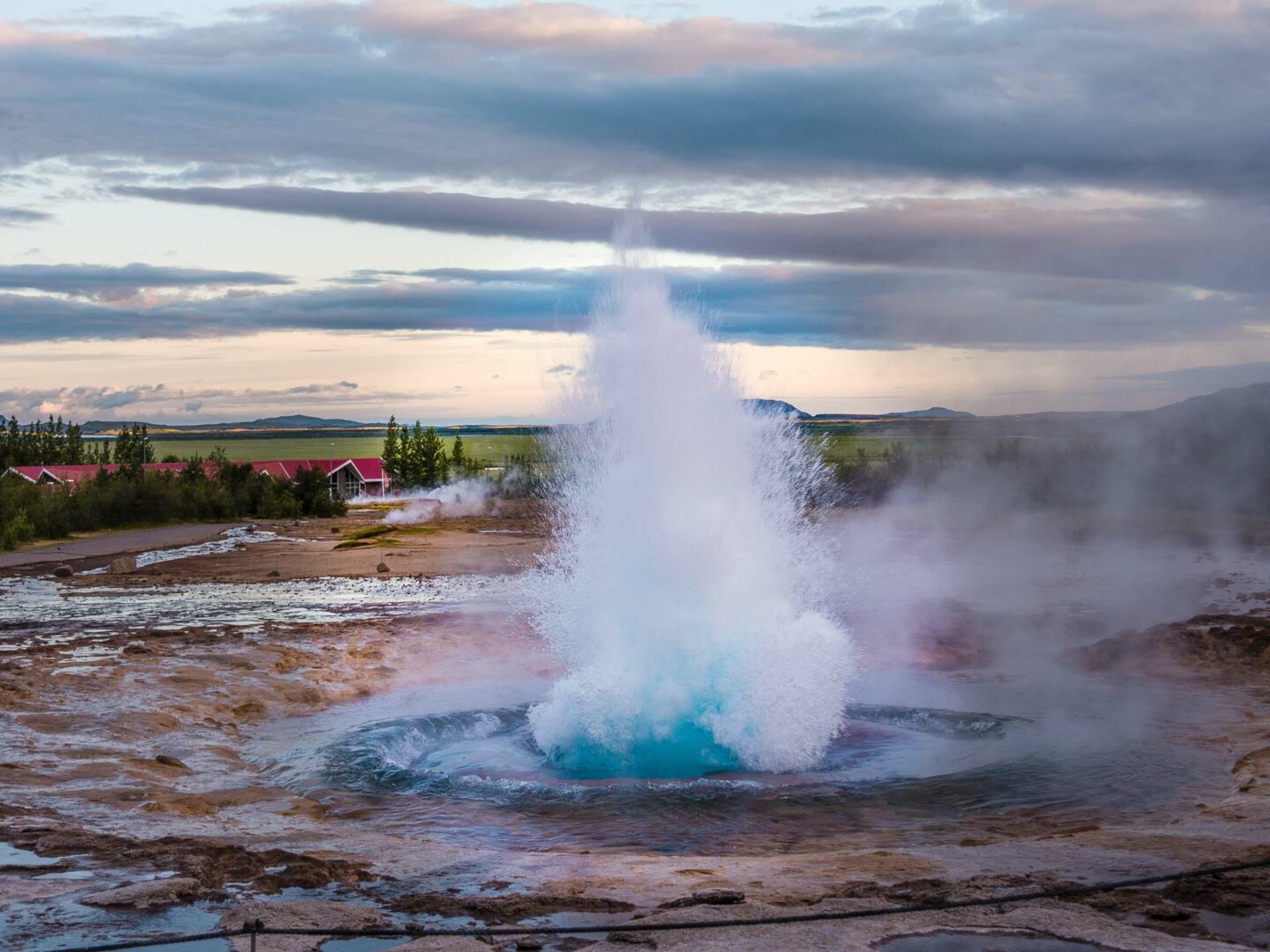
Table of Contents
QUICK ANSWERS: GEYSIR HOT SPRINGS
Before going into the main topic, let’s cover some quick answers about the Geysir geothermal area including where it’s located, how to get there, the opening times, and more.
WHAT IS GEYSIR HOT SPRINGS?
Geysir Hot Springs is a geothermal area that is home to the Great Geysir and Strokkur, two of the most active geysers in the world.
Strokkur erupts every 4 – 10 minutes, usually reaching heights of 15 – 20 meters (49 – 65 feet) and sometimes even 40 meters (131 feet).
WHERE IS THE GEYSIR GEOTHERMAL AREA?
The Geysir geothermal area is located in Haukadalur Valley in southwest Iceland, about 1.5 hour’s drive from the capital city of Reykjavik.
Click here to see the location on Google Maps.
HOW TO GET TO GEYSIR HOT SPRINGS?
Located approximately 100 km from Reykjavik, the area is easily accessible by car via Route 35 or Route 37.
It takes about an hour and a half to get there from the capital city, depending on your route, and you can easily reach the Geysir geothermal area from the capital city.
Alternatively, the most convenient way to reach Geysir Iceland is by joining a day tour around the Golden Circle .
This tour will take you to the iconic Geysir hot spring, as well as other nearby attractions such as the Gullfoss Waterfall and Kerid Crater .
It’s a great way to explore the region if you don’t have your own vehicle or prefer to leave the driving to someone else.
BEST GEYSIR HOT SPRINGS TOUR
The best way to visit Geysir Hot Springs Iceland is to join a Golden Circle Tour !
It includes hotel transfers, the best spots in the Golden Circle, and a fun guide to spend the day with!
WHAT IS THE BEST TIME TO VISIT THE GEYSIR GEOTHERMAL AREA?
The best time to visit Geysir Iceland is during the summer months from June to August.
During this time, temperatures are mild and the days are long, allowing for plenty of time to explore the area.
The Great Geysir is especially active during these months, with Strokkur erupting every few minutes.
WHAT ARE THE OPENING TIMES & ENTRANCE FEES?
Geysir in Iceland is open 24/7 and is free to visit.
Geysir Visitor Center, on the other hand, which is home to a souvenir shop and a restaurant, is open from 10.00 am to 7.00 pm.
WHAT TO EXPECT AT THE GEYSIR GEOTHERMAL AREA
I traveled to Geysir in the month of May as part of my Golden Circle itinerary and we parked the car right outside of the hot springs.
Almost immediately, you’ll make your way to the famous Strokkur Geyser, which is the most active and erupts every few minutes.
When reaching Strokkur, you’ll join a small crowd around waiting for the geyser to erupt.
Every few minutes, the anticipation would build as the water in the geyser’s mouth began to churn and bubble.
And then, without warning, Strokkur will shoot a powerful column of scalding hot water up to 30 meters into the air – what a show to enjoy!
You can spend about 30 minutes exploring the Geysir geothermal area, walking along well-maintained boardwalks, and stopping at various points.
It’s worth noting that, despite the Strokkur Geysir being pretty active, the smaller ones are inactive, so don’t expect them to erupt.
After seeing the eruption a few times, you can hike up the hill nearby and see the views from above, which only adds some uniqueness to the experience!
Before leaving, don’t forget to stop at the Geysir Visitor Centre , which is home to a souvenir shop, an ice cream store, and two restaurants.
Plus, if you have to use the restroom, this is the place to go.
STROKKUR GEYSIR
Strokkur is the largest geyser in Iceland, located in the Geysir Geothermal Area of Haukadalur Valley in the Golden Circle .
It is one of the most popular tourist attractions in the country. As mentioned earlier, it erupts hot water up to 15-20 meters (49-65 feet) and sometimes even as high as 40 meters (131 feet).
As soon as you get to Geysir Iceland, you’ll see Strokkur, as it’s easy to spot it from afar.
Visiting Strokkur is a must for anyone looking to experience Iceland’s unique geothermal activity.
The Most Functional Day Pack EVER!
The Nomatic 20L Travel Pack is perfect for everyday use and for those shorter 1-3 day adventures.
With 20+ innovative features and a minimalist design, this functional day pack gives you confidence for life on the move!
FACILITIES AT HAUKADALUR GEOTHERMAL AREA
The Haukadalur geothermal area (or Geysir geothermal area) has a few convenient facilities which I have listed below.
- Parking lot
- 2 restaurants
- An ice-cream shop
- A souvenir store
- The Geysir Hotel
- The Geysir Campiste
Despite being a small area, at the Geysir Hot Springs, there is a lot to do and you can even spend the night here at The Geysir Hotel which is convenient.
GEYSIR HOT SPRINGS – FAQ
I couldn’t end this Geysir Hot Springs guide without going through some frequently asked questions from first-time visitors.
IS GEYSIR ICELAND WORTH VISITING?
Geysir is definitely worth visiting while in Iceland as it’s one of the most impressive geological sights in the country. It was the first geyser known to Europeans.
The Great Geysir is not the only famous geyser in the Geysir hot spring area – there’s also Strokkur, which erupts every few minutes and reaches heights of up to 40 meters.
As the Geysir geothermal area is a very popular tourist attraction, it’s recommended to book your Geysir Hot Springs tour ahead of time.
HOW FAR IS GEYSIR FROM REYKJAVIK?
Geysir is located approximately 100 kilometers east of Reykjavik, the capital city of Iceland.
It is part of the Haukadalur Valley geothermal area and is known for its impressive hot springs and geysers.
HOW OFTEN DOES GEYSIR STROKKUR ERUPT?
Geysir, which gave the name to the smaller ponds around, is not active anymore. However, Strokkur is.
Strokkur Geysir is Iceland’s most active geyser and one of the three major attractions on the Golden Circle sightseeing route.
It consistently gives spectacular eruptions that occur every 5 to 10 minutes.
IS IT SAFE TO VISIT THE GEYSIR GEOTHERMAL AREA?
Absolutely, visiting the Iceland Geysir is very safe, however, there are a few things to keep in mind.
First of all, always stay on the designated trails or pathways while exploring the area. This will help you avoid any potential hazards such as boiling water or steam vents that could cause serious injury.
Additionally, make sure you keep a good distance from any of the active geysers and hot springs – these can become very hot and unpredictable at times.
There are designated areas around the geysers and you’ll want to stay within those for safety reasons.
Have you got travel insurance for your trip?!
We all know accidents can happen and having Heymondo Insurance will save you thousands of dollars if something goes wrong.
Heymondo offers low-cost Travel Insurance to keep you covered on all your adventures.
WHAT’S THE DIFFERENCE BETWEEN A HOT SPRING & A GEYSER?
A hot spring is a pool of water that is heated by the Earth’s internal heat, usually located near volcanoes or other areas of high geothermal activity.
The water in these pools is typically warm to the touch and can reach temperatures up to 50°C.
Geysers, on the other hand, are hot springs that periodically erupt with water and steam. These eruptions occur when pressure builds up beneath the surface due to heated groundwater and eventually forces its way out.
WHERE TO STAY NEAR ICELAND GEYSIR?
There are a few properties near Geysir Iceland to suit the needs of luxury travelers, budget backpackers, and everyone in between.
Below you’ll find my top picks of places to stay in the area.
LUXURY: HOTEL GEYSIR
MID-RANGE: LITLI GEYSIR HOTEL
BUDGET: GEYSIR HESTAR
FOR MORE OPTIONS, SEARCH ON BOOKING.COM
More iceland travel guides.
Click the button below to view all articles related to Iceland!
WHAT TO PACK FOR ICELAND
When visiting Iceland, here is a list of items I highly recommend bringing with you:
Must-Have Travel Essentials
Hidden money wallet.
Keep your cash and other valuables safe with this anti-theft hidden money wallet!
Reusable Water Bottle
The GRAYL GeoPress is the best reusable bottle that allows you to purify water from anywhere!
Travel Backpack
The Nomatic Travel Backpack has 20+ innovative features, perfect for everyday use!
Quick-Dry Travel Towel
The most compact, lightweight, and quick-dry towel for traveling!
Portable PowerBank
Keep your phone, laptop, and accessories charged while you’re on the go with the Anker PowerBank!
SUMMARY – GEYSIR ICELAND
In conclusion, visiting the Geysir Hot Springs is a must-do when visiting Iceland.
With its unique geothermal activity and stunning views, it’s easy to see why this area is one of the most popular attractions on Iceland’s Golden Circle, so make sure to include it in your itinerary!
I hope you enjoyed reading this article and if you have any questions, please leave me a comment below and I will get back to you as soon as I can.
For a quicker response, be sure to join Jonny Melon’s Travel Tribe on Facebook and post your questions or recommendations to our awesome community.
TRAVEL RESOURCES FOR YOUR NEXT TRIP
Whether you’re a seasoned traveler or it’s your first trip overseas, here are some useful travel resources to help you kick-start your next adventure!
Search and book accommodation worldwide.
Compare and book cheap flights to anywhere.
Find tickets, tours, and experiences around the world.
Book buses, trains, and transfers online in advance.
Search all rental cars in your next destination.
Need travel insurance for your next trip?
THANKS FOR READING
Hey friend, thanks for reading this guide!
Please know this post may contain affiliate links. When making a purchase through one of my links, I earn a small kickback at no extra cost to you and it’s a big help to keep the site up and running. Rest assured, I only promote products and services that I personally use and recommend.
Click here to find out how you can support the site organically .
Leave a comment cancel reply.
Notify me of follow-up comments via e-mail.
Work with us
Support the site
Plan Your Trip
Travel guides
Destinations
Hotel guides
Find best tours
Travel Gear
Travel resources
How to start a blog
Photography guides
Follow On Socials
© 2024 Jonny Melon Adventure Travel Blog. All rights reserved.
Privacy Policy | Terms | Sitemap
THE 10 BEST Geysir Tours & Excursions
Geysir tours.
- Ports of Call Tours
- Historical & Heritage Tours
- Sightseeing Tours
- Multi-day Tours
- Private Tours
- Walking Tours
- Cultural Tours
- Photography Tours
- Hop-On Hop-Off Tours
- Archaeology Tours
- Helicopter Tours
- Up to 1 hour
- 1 to 4 hours
- 4 hours to 1 day
- 5.0 of 5 bubbles
- 4.0 of 5 bubbles & up
- 3.0 of 5 bubbles & up
- 2.0 of 5 bubbles & up
- Chinese (Traditional)
- Likely to Sell Out
- Special Offers
- The ranking of tours, activities, and experiences available on Tripadvisor is determined by several factors including the revenue generated by Tripadvisor from these bookings, the frequency of user clicks, and the volume and quality of customer reviews. Occasionally, newly listed offerings may be prioritized and appear higher in the list. The specific placement of these new listings may vary.

1. Golden Circle, Sky Lagoon and Kerid Crater Tour from Reykjavik

2. Golden Circle Tales, Tomato Farm & Kerid! Small Group Adventure

3. Golden Circle, Kerid Crater & Hvammsvik Geothermal Hotspring

4. Golden Circle and Kerid Volcanic Crater Small-Group Day Tour

5. 3-Day Golden Circle, Ice Cave, Glacier Lagoon and Canyon Tour

6. Golden Circle Day Tour in Mini Bus from Reykjavik with Fridheimar Tomato Farm

7. Golden Circle Super-Jeep Tour and Snowmobiling from Reykjavik

8. Golden Circle 7 Hours Bus Tour from Reykjavik

9. 8-Day Summer Ring Route of Iceland with Snaefellsnes Peninsula

10. Golden Circle, Silfra Snorkeling & Fridheimar Tomato Farm Lunch

11. Iceland's Golden Circle Shared Tour for 6 people maximum

12. Perlan Ice Cave Admission & Golden Circle Tour in Reykjavik

13. Private Golden Circle Tour from Reykjavik

14. Private Tour Of The Golden Circle With Farm Visits In Iceland

15. Golden Circle Small Group from Reykjavik Port

16. 2-Day South Coast Tour | Golden Circle, South Coast & Black Beach

17. 3-Day Golden Circle, Ice Cave, Glacier Lagoon & Waterfalls Tour

18. Golden Circle Private Tour on premium class car Tesla

19. Small Group Golden Circle and Hvammsvik Lagoon Full-Day Tour

20. Golden Circle and Sky Lagoon Geothermal Spa Tour from Reykjavik

21. From Reykjavík: 4, 5, 6 or 7-Day Small-Group Ring Road Tour

22. Golden Circle & Northern Lights Tour from Reykjavik

23. 6-Day Summer Ring Route of Iceland Small-Group Tour

24. Private Golden Circle Tour in Iceland With 5+ Attractions

25. Private Superjeep Tour to Golden Circle & Langjökull Glacier

26. Golden Circle & Northern lights in Iceland

27. Landmarks from Above: Helicopter tour with Geothermal Bath

28. Golden Circle, Northern Lights and Blue Lagoon Tour with Ticket

29. Iceland's Golden Circle Self-Guided Audio Driving Tour

30. 13 Days Self-Drive Tour with Pick Up - Explore Iceland - 4X4 Campervan
What travelers are saying.
- Geof P 1 contribution 0 5.0 of 5 bubbles Must do trip Fabulous. Fun. Relaxed. Great tour company. Blue Lagoon an absolute highlight. Informative. Considerate. Could not ask for more. Read more Review of: Golden Circle Full-Day Tour with Sky Lagoon and Kerid Crater Written April 24, 2024 This review is the subjective opinion of a Tripadvisor member and not of Tripadvisor LLC. Tripadvisor performs checks on reviews.
- Small-Group Golden Circle and Kerid Volcanic Crater Day Trip from Reykjavik
- Golden Circle Tales, Tomato Farm & Kerid! Small Group Adventure
- Golden Circle Full-Day Tour with Sky Lagoon and Kerid Crater
- Golden Circle Tour Including Gullfoss and Geysir from Reykjavik
- Golden Circle, Northern Lights and Blue Lagoon Tour with Ticket

- What to see
- Golden Circle
One of the highlights of Iceland's Golden Circle , Geysir is home to geysers - yes, that's where we get the English word from! - which hurl boiling water up to 200 feet into the air .
Along the Haukadalur valley lies one of the most active geothermal areas in Iceland , home to a number of geysers - including one called Geysir, which is where the English word originally comes from! While Geysir, which is said to be the first known to modern Europeans, has been inactive for some time, you're highly likely to see the nearby Strokkur erupt.
Strokkur's eruptions of boiling water may not reach quite the same heights as the enormous Geysir - up to 230 feet, or 70 meters - but it hurls a steaming jet of water up to 100 feet (30 meters) into the air every six to ten minutes , making it an incredible spectacle.
If you plan on visiting Geysir in winter, we recommend bringing crampons to enjoy the experience comfortably.
How to visit Geysir?
The geothermal area in which Geysir is located is found in the Golden Circle, around 70 miles (110 km) from Reykjavik , and 37 and 6 miles (60 and 10 km) from Thingvellir and Gullfoss respectively. It's easy to reach if you're renting a car in Iceland , and there's a free parking area in the vicinity.
If you'd prefer not to drive, we recommend booking an organized tour of the Golden Circle to see all of its incredible sights in one day. Our Golden Circle Tour takes you to visit Geysir and its surrounding landmarks with transport from Reykjavik and an English-speaking guide - all you have to worry about is enjoying the excursion!
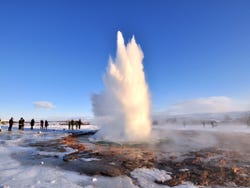
Southwest Iceland, 110 km from Reykjavik .
You may also be interested in
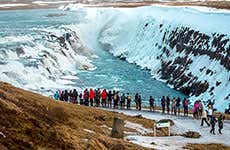
Gullfoss is not only Iceland's best-known waterfall, but also one of the most striking and impressive thanks to its double tiered waterfall plunging a total of 105 feet (31 metres).
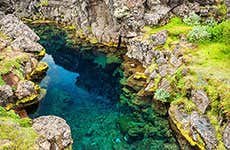
Thingvellir
Discover what to see and how to visit Thingvellir, one of the highlights of the Golden Circle and one of Iceland's most important historical and geographical sites, thanks to its location between the North American and Eurasian tectonic plates.
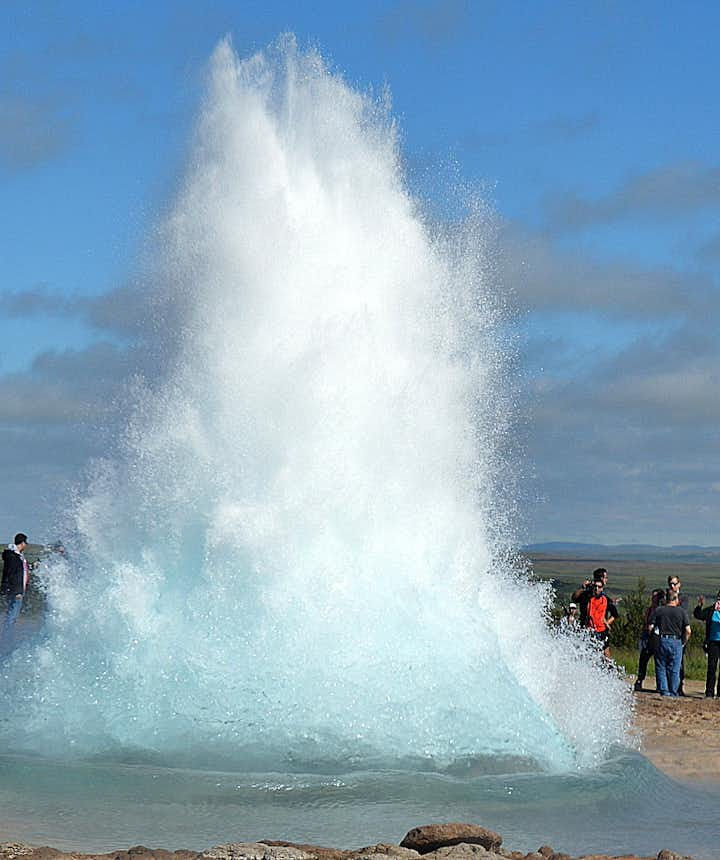
The spectacular Geysir Geothermal Area - Strokkur and all the other Hot Springs

Geysir hot spring
Strokkur - the churn, blesi hot spring, konungshver hot-spring, mt. laugarfjall - laugarfell, litli-geysir and all the other smaller hot-springs.
- Smiður - the Carpenter
Dangers in geothermal areas
The geysir troll & wrestling.

I have by now written some 300 travel-blogs about different locations in Iceland, which I have visited all around my country, some in very remote areas.
I dedicated my last travel-blog to the Gullfoss waterfall - the Golden waterfall, which gives a name to the most popular route in Iceland; the Golden Circle . So I find it fitting to write about Geysir geothermal area now, as these 2 very popular sights are only 10 km apart, and are always visited together.
The Majestic Gullfoss - Iceland's Golden Waterfall, which gives a Name to the Golden Circle
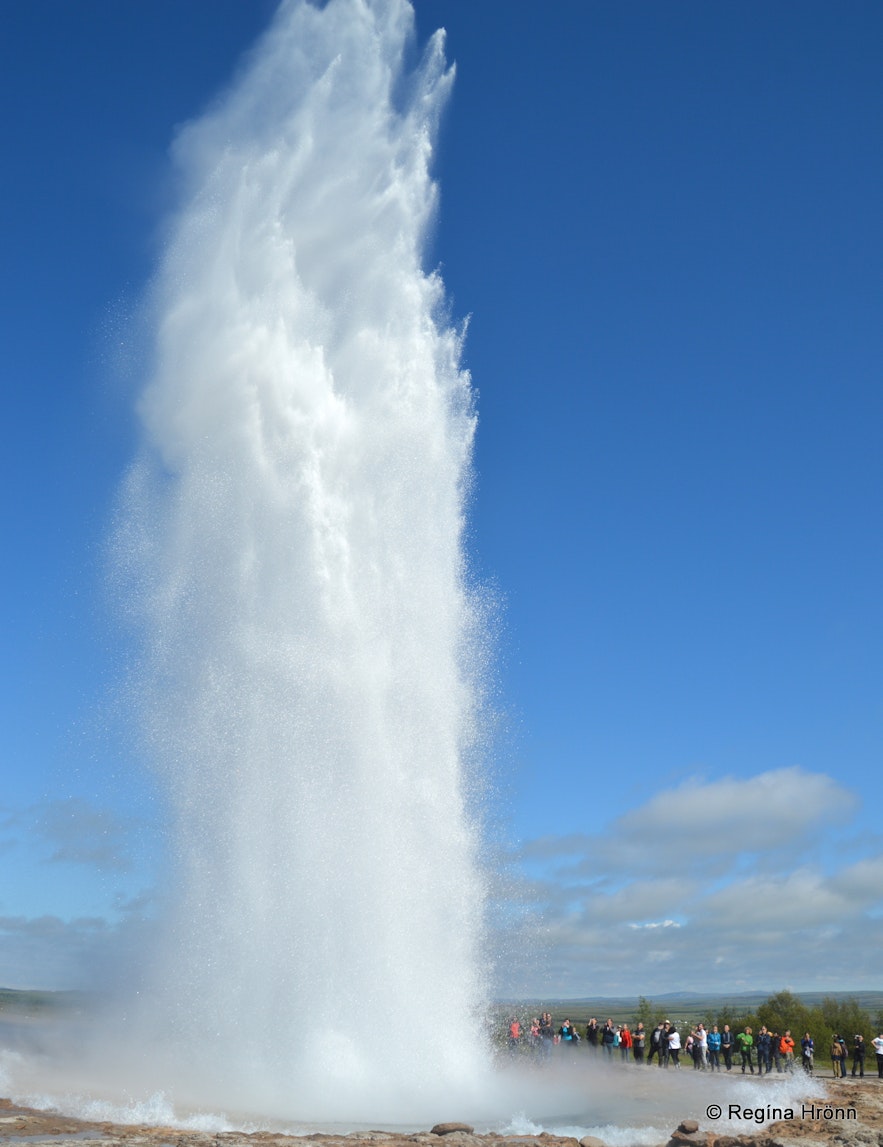
The Geysir geothermal area is a big attraction on the Golden Circle, which traditionally includes Þingvellir national park , Geysir geothermal area, and Gullfoss waterfall (I also include Skálholt episcopal See ).
I show all my foreign visitors these beautiful sights and I never tire of visiting them. I believe that most foreign visitors to my country visit the Golden Circle.
Apart from those who have only a few hours to spare while stopping over at the airport; they visit the Blue Lagoon .
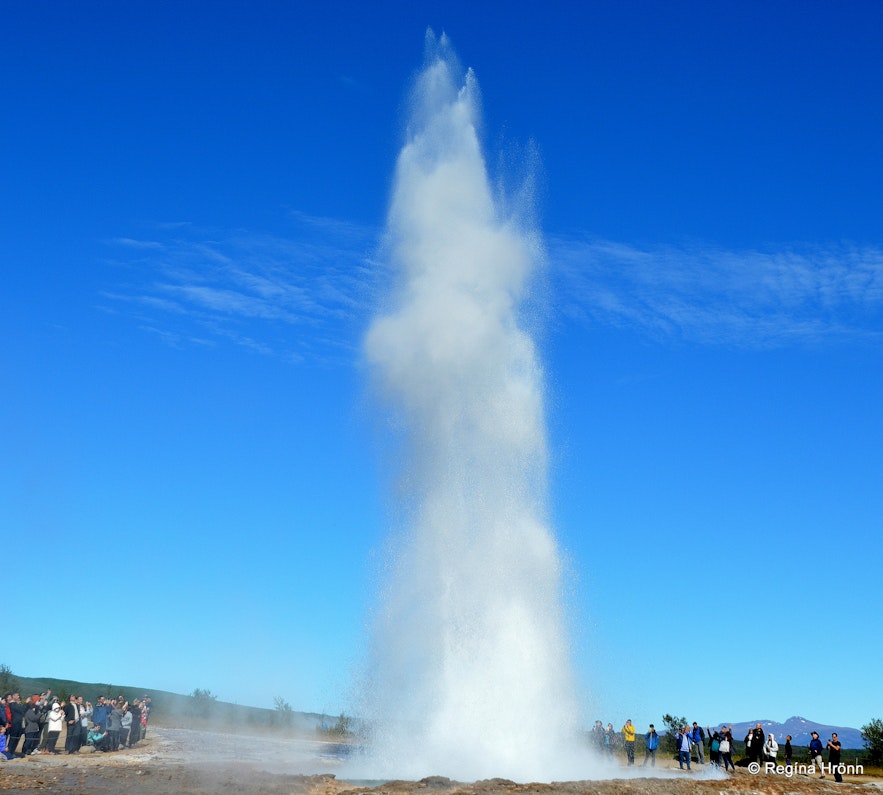
In 2018 I took a group of 60 friends to Geysir and it was one of the worst days of the rainy summer of 2018 with warnings of swellings of rivers in the south! Bad luck, eh, as my friends missed the beautiful sight of seeing Strokkur erupting.
For obvious reasons (explained in the next chapter of this travel-blog) I have no photos of Geysir erupting, but I long to see it erupt. So all my photos of erupting geysers in my travel-blog are of Strokkur .
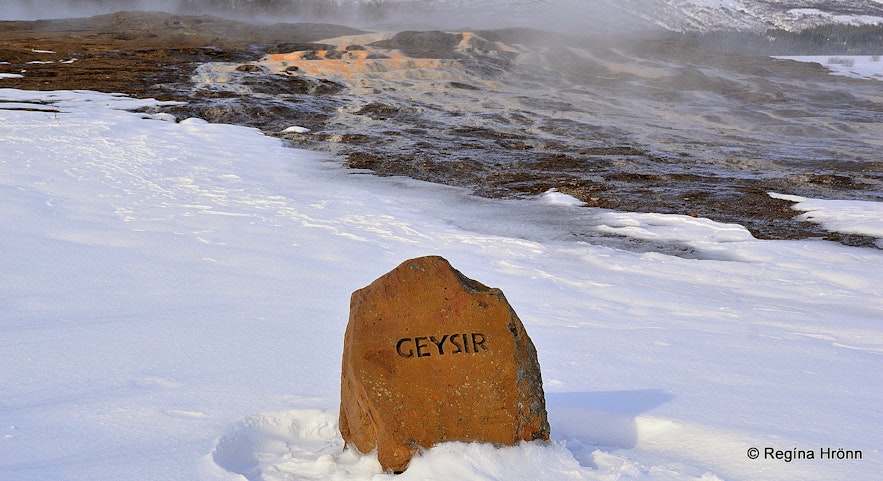
The Geysir geothermal area is a well-known high-temperature geothermal area. And Geysir itself is one of the best-known geysers in the world and has given a name to other spouting hot springs around the world; geyser . In Icelandic, the term Geysir is derived from the verb gjósa , which means to erupt.
The Icelandic pronunciation of Geysir is like "hey!" while the English pronunciation is more like "hi" or "he". You can hear the Icelandic pronunciation here .
Another word derived from the original Geysir is geyserite, as characteristic of the old Geysir is the huge geyserite which surrounds it.
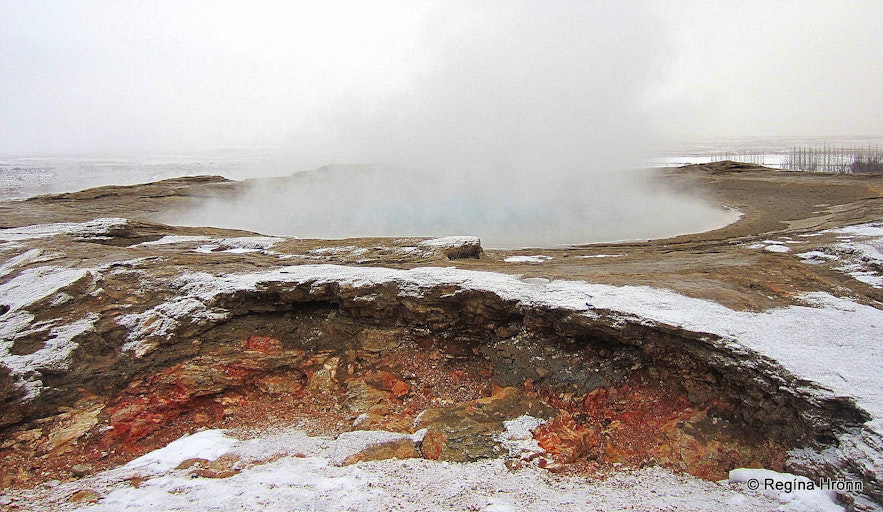
Geysir is almost dormant these days, but what you can see now when you visit the original Geysir is the 18 m in diameter bowl surrounded by thick geyserite (hverahrúður in Icelandic). The geyserites are among the most beautiful features of the geothermal areas in my opinion.
The shaft of the hot spring is around 20 m deep. It is difficult to get a decent photo of Geysir and the bowl as it is fenced off. And the Geysir geothermal area is a no-drone zone.
Geysir is believed to have started erupting after a big earthquake, Suðurlandsskjálftinn , in 1294. That is the first time this area was mentioned in written sources, Oddaverja annáll. But it might be much older or younger than that as the sources only mention that some hot springs disappeared and new ones appeared.

Geysir was at its most active following these big earthquakes in the south, and it was apparently very active following the earthquake in 1630. Following these earthquakes, new hot springs emerged and others disappeared in the Geysir geothermal area.
There were other big earthquakes in 1789 and 1896 (we think that there were 5 big ones that year) which changed the geothermal area and the frequency of Geysir's eruptions.
These big earthquakes are called Suðurlandsskjálftinn - the South-Iceland Quake, and they happen at an approximately 100-year-interval, the last one shaking South Iceland back in 2008 (6.3 on the Richter scale).

On the 17th of June 2000 (our National day), we had a big earthquake, and another one on the 21st of June, 6.5 on the Richter scale; and Geysir started erupting again on average 3 times a day for some period of time.
These earthquakes sometimes come in pairs and a pair of earthquakes shook South Iceland as well back in 1912.
We, who live in this part of Iceland, dread these Suðurlandsskjálfti earthquakes. When I was a kid we often passed by Mt. Ingólfsfjall and my grandparents and parents always used to mention that the big earthquake was due, scaring the living daylights out of me.

But it so happened that the epicentre of the 2008 earthquake was right beneath Mt. Ingólfsfjall .
When you pass this mountain in the south you will see big boulders which have rolled down the mountain hills during such earthquakes.
The Viking Settler Ingólfur Arnarson, Mt. Ingólfsfjall and Ingólfsskáli Turf Longhouse in South-Iceland
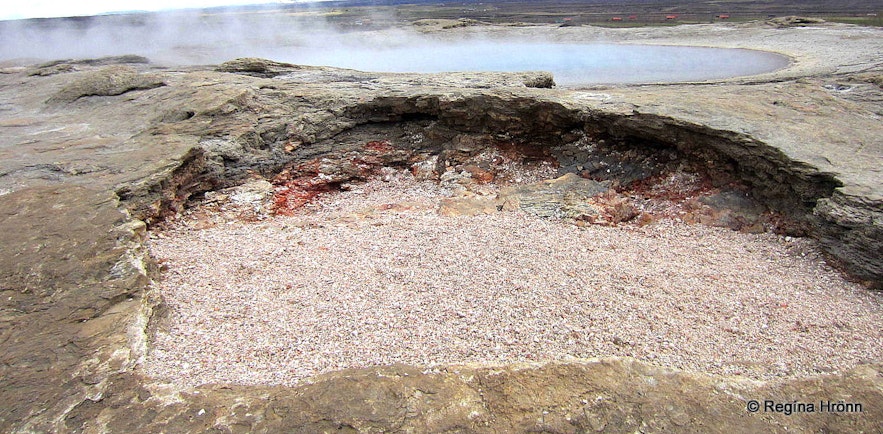
Geysir slowly stopped erupting after the turn of the 20th century and became dormant after 1916. In 1935 a furrow was made in the bowl to lower the water level which made it erupt again until 1950. The split then got filled by sinter with time.
Then in August 1981 a well-known Icelandic filmmaker, Hrafn Gunnlaugsson , my husband's second cousin, opened the furrow, as he wanted Geysir to erupt for one of his films " Okkar á milli í hita og þunga dagsins ".
Remember, that technology wasn't as advanced back then, so a real eruption was needed for the filming.
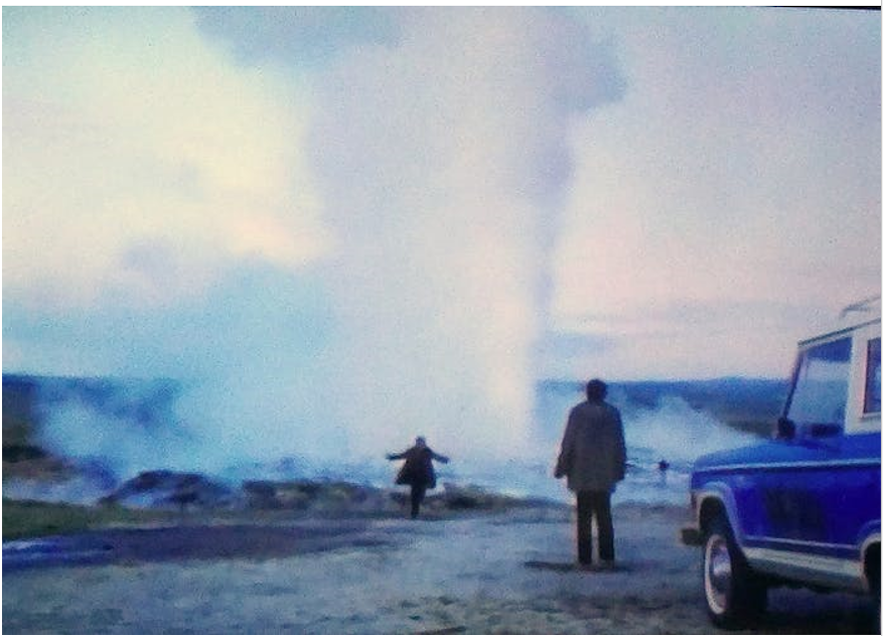
Hrafn talked to the farmers at Geysir, reopened the furrow and enlargened it. This was not well regarded as the furrow was thought to be unsightly, but Geysir started erupting again.
Geysir and the geothermal area was not protected but are on the Nature Conservation Register. On the 17th of June 2020 - our national holiday, the Geysir geothermal area was finally protected.
On big occasions, such as for royal visitors and Verslunarmannahelgin long weekend, the furrow was opened or 40 kilos of soap were put into the bowl forcing an eruption. But that stopped in 1992.
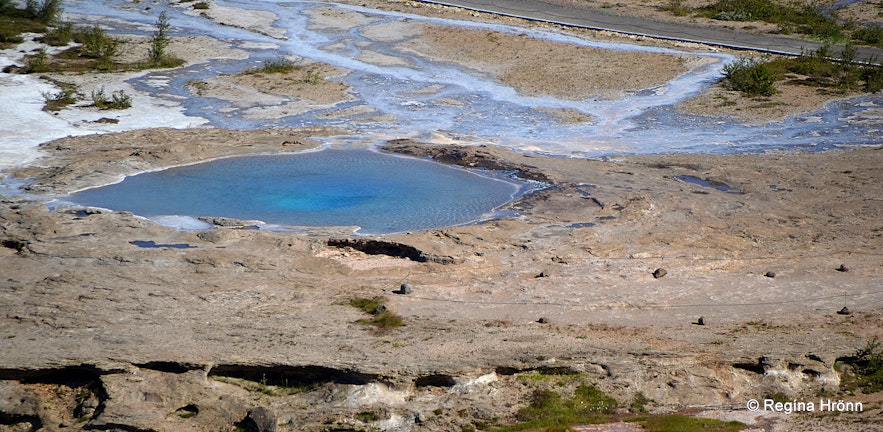
Geysir was a big attraction in Iceland and foreigners would travel to Iceland to see this strange phenomenon. I have read several Icelandic travel journeys from the 18th and 19th centuries written by foreign travellers to Iceland.
And they especially came to Iceland to see Geysir erupt. They didn't seem that interested in the majestic Gullfoss waterfall while staying in this area, just Geysir and Þingvellir.
Back then Europeans didn't know much about other spouting geysers in the world. And together with the Yellowstone Park geyser, Geysir is the most famous geyser in the world.

We have of course no photos from this time, but drawings were made of this spectacular phenomenon. Some of the travellers waited for days to see Geysir erupt, and camped in the geothermal area. Amongst them were Napoleon (nephew of Napoleon Bonaparte) and his entourage who visited this area back in 1856.
Back then there were no roads and few bridges and these foreign guests would have to hire a guide and travel on horseback, so it would take them a couple of days to reach this area.
Þingvellir, the old parliament of the Vikings , was also a big attraction on the way to Geysir and many would stay for the night at the vicarage there.
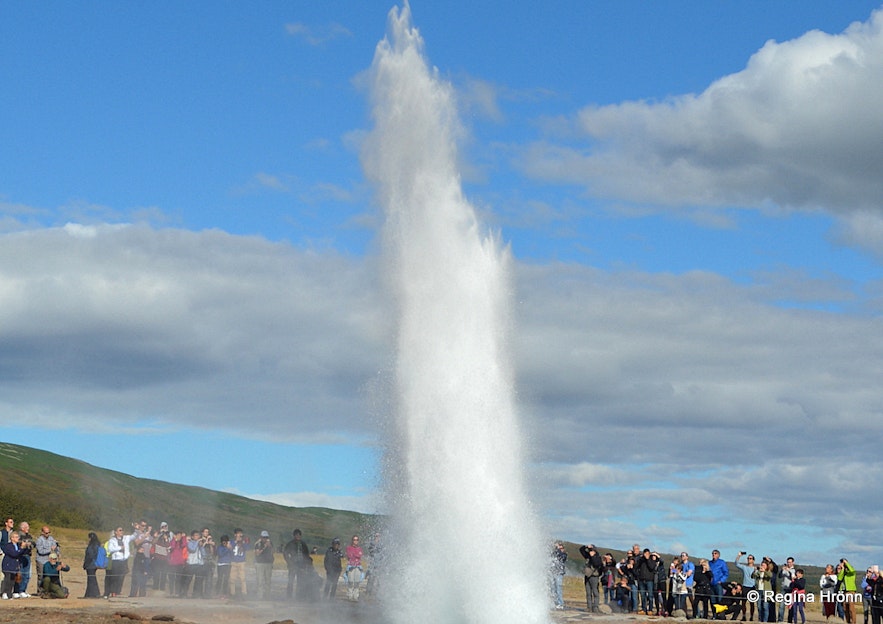
When Geysir erupted back then it must have been a sight to see as it erupted around 60 metres into the air, sometimes even more and sometimes less! And Strokkur also had some majestic eruptions.
Loud thumps are heard before Geysir erupts. In December 2008 after the last big earthquake, a British couple was in grave danger and had to run away from Geysir as it was erupting.
By chance, an Icelandic tour guide was passing by and recognized that the thumps were an indication of a Geysir eruption and could warn them in the nick of time.
I took this photo below back in June 2008, a month after the big earthquake. Then it had not yet been completely fenced off and unsuspecting tourists were standing right next to the bowl, looking into it!
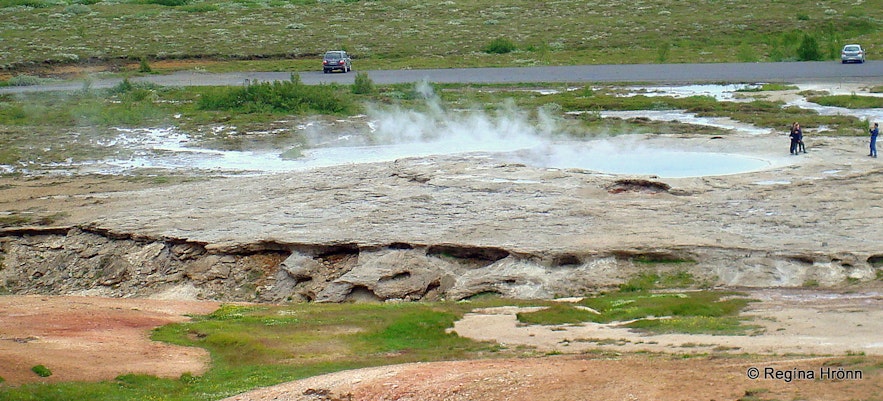
After that last Suðurlandskjálftinn earthquake, there was no knowing when Geysir would erupt.
I was standing further up in the Geysir geothermal area by Konungshver hot spring, praying that it would not erupt when the tourists were standing on top of it.
You can also see in the photo that the brittle geyserite had not yet broken as much as in my other photos of Geysir.
A Geysir eruption was caught on video back in 2016:
Rare eruption of Iceland's most famous hot spring Geysir
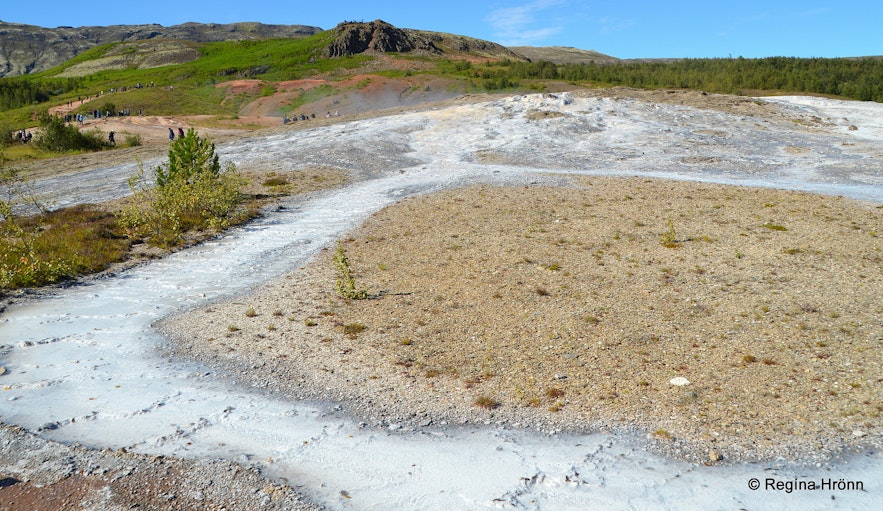
Geysir now only erupts from time to time and has been fenced off, but you can walk very close to it.
I have visited the Geysir area many many times and have never seen Geysir erupt. I would absolutely love to see it though.
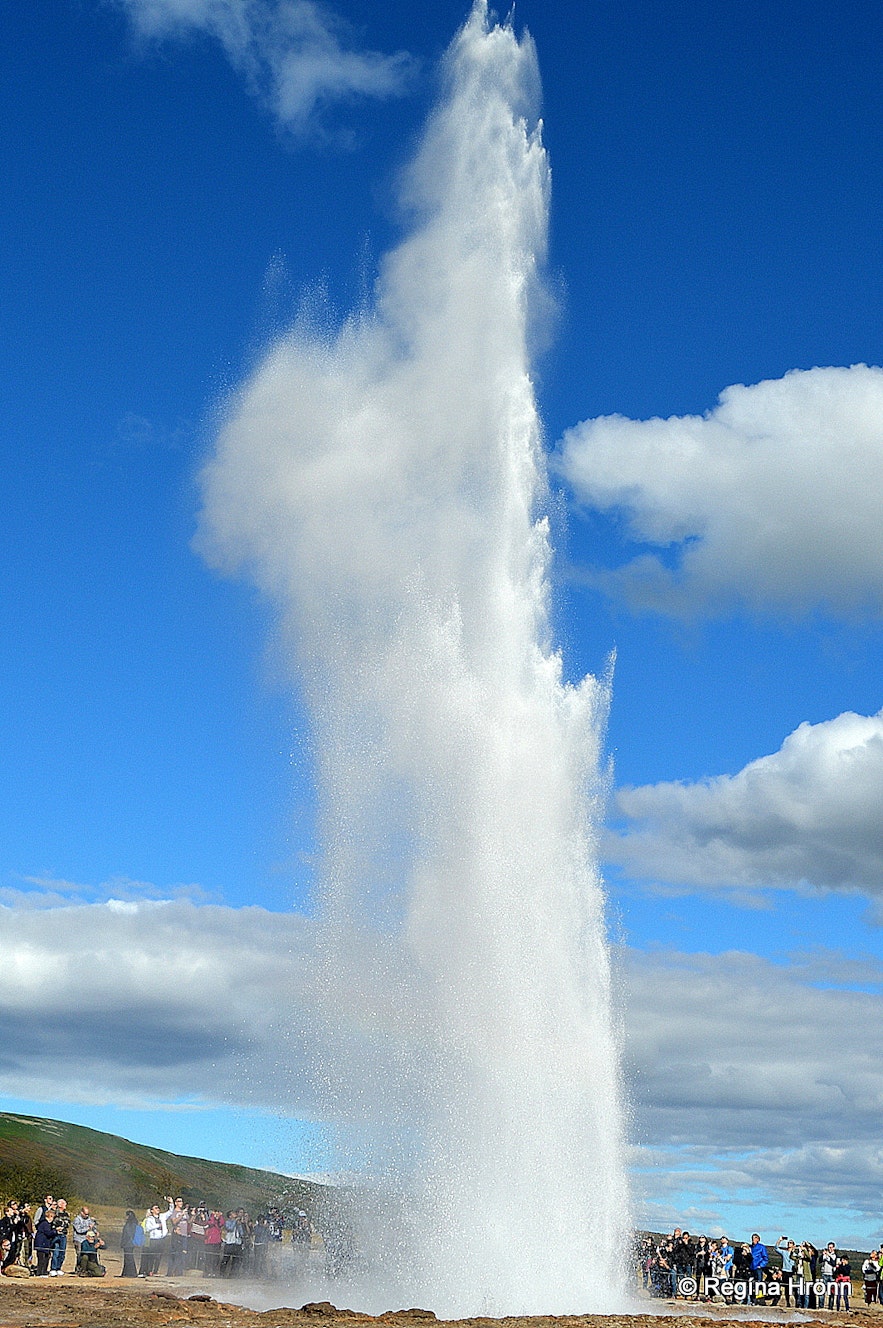
Strokkur is the main attraction at the Geysir geothermal area, since Geysir all but stopped erupting. This spouting hot spring got formed in a big earthquake back in 1789 and was active until 1896.
It erupts now with approximately an 8-minute interval some 25-35 m into the air. But that can change and I have seen it surprise me and erupt when I was totally unprepared, and then erupt again.

And it can be a really small eruption or a magnificent one. If it is a small one then I have heard murmurs of disappointment from other travellers ;) But this is nature and not a show so nothing is certain here.
The name Strokkur means Churn, like in the old instrument for churning butter, and stems from the shape of its shaft.
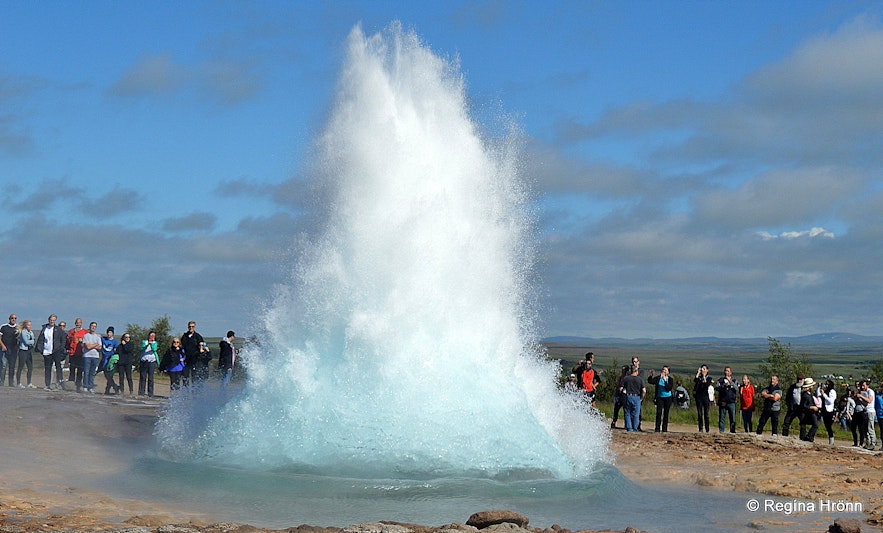
I also read in an old travel journal, "Íslandsferð J. Ross Browne 1862" that it was called the Churn as it returned everything that was put into it (turf and stones) after churning it.
But it was a common practice "back then" to throw turf into the hot springs to make them erupt. In this book, they put more turf into Strokkur than was the normal amount and Strokkur went amok to try to get rid of it.
When turf was thrown into Strokkur the water spouting in the air turned black!

When Strokkur became almost dormant for decades after an active period, measures were taken to clear out the shaft and revive it again, and 40 m were drilled into the shaft.
This was back in 1963 and it has been erupting regularly since.
The way things work here is that this is an active geothermal area with an underground plumbing system, so to speak. Pressure builds up when water comes into contact with a hot basement or bedrock, it heats up and the result is a beautiful eruption.

The hot springs don't have the strong overwhelming smell of sulphur like the mud pots in so many of the other geothermal areas I have visited on my travels in Iceland.
Mývatn in North-Iceland - Part IV - Mt. Námafjall, Krafla & Leirhnjúkur Geothermal Areas

When you visit the Geysir geothermal area you will see crowds around Strokkur awaiting its next eruption.
I always join the crowd, but it can be tedious standing with your camera ready to catch the eruption on film, as Strokkur erupts on average every 8 minutes.
Keep your eyes on the bowl because it shows some signs prior to an eruption. I have stood here in all kinds of weather, once in -10 degrees C and wind freezing my butt off ;)
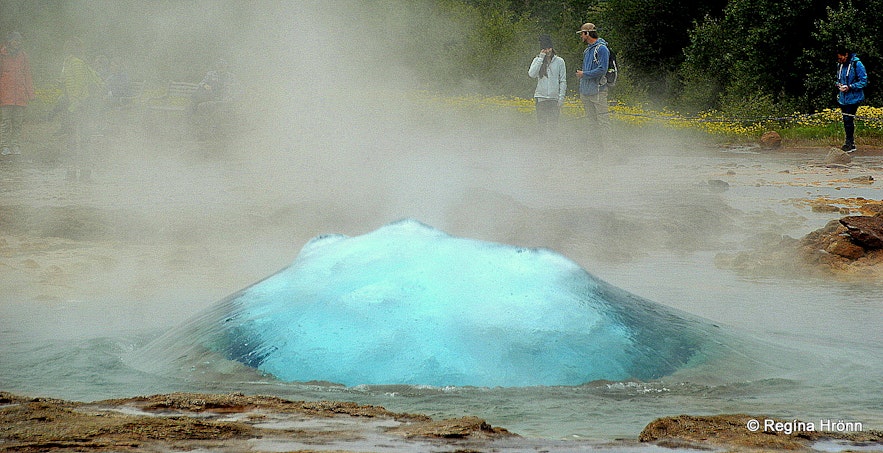
What I like to do the most is to stand north of it and try to catch a photo of the bubble.
That is pretty difficult and if you press the button too soon or too late then you have to wait for the next eruption.
And I have got so many photos from failed attempts. I must remember to put it on multiple images next time around.
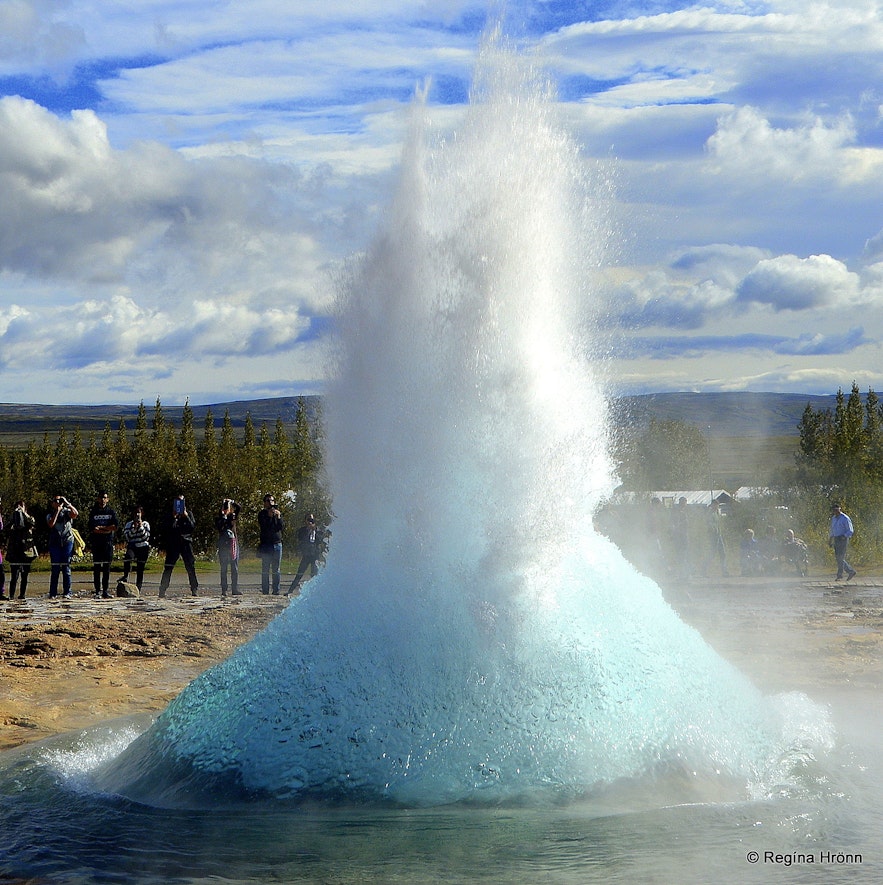
This is my favourite shot of the bubble bursting
Once I was walking upwind of Strokkur when it erupted and I got engulfed in the steam with drops of water landing on my head.
Take that into account when you take your place in the crowds by Strokkur and check from which direction the wind is blowing. I was fortunately too far away for the water to burn me.
See my chapter on "Dangers in geothermal areas" for further information on people who weren't as lucky.
There have been attempts to charge an entrance fee to the Geysir geothermal area, and only a few years ago (2014) I remember it being closed to the public and you could only enter it if you paid an entrance fee.
I was travelling with a group of Canadians, and none of them was willing to pay to enter the geothermal area.
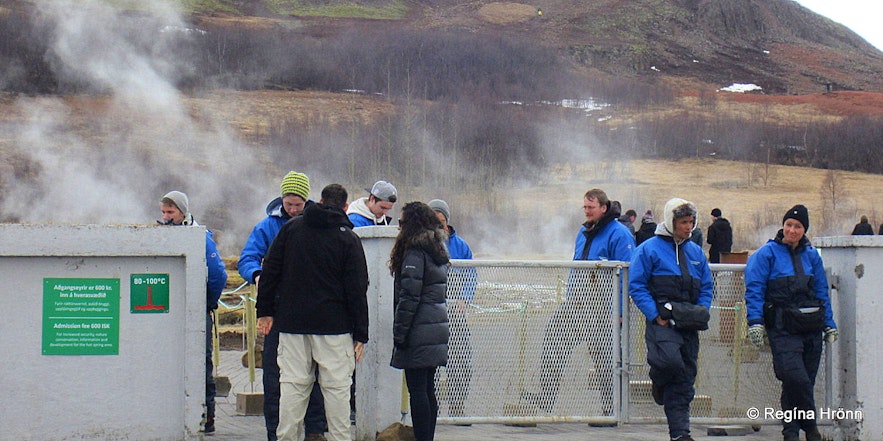
Back in April 2014, when there was an entrance fee to the Geysir geothermal area
But that wasn't the only attempt to charge for admission, as back in 1894 the farmer in Haukadalur sold Geysir to an Englishman. The Englishman, James Craig, charged an entrance fee to travellers.
The lovable Nonni - Jón Sveinsson , visited Geysir back in 1894 and at that time Geysir was pretty active, although Nonni only saw it erupting from afar after he had left this area.
In his travel journal, "A Journey Across Iceland" he mentions that the Englishman, who had bought Geysir, had plans of building a small railway from Reykjavík to Geysir. This never came to fruition though.
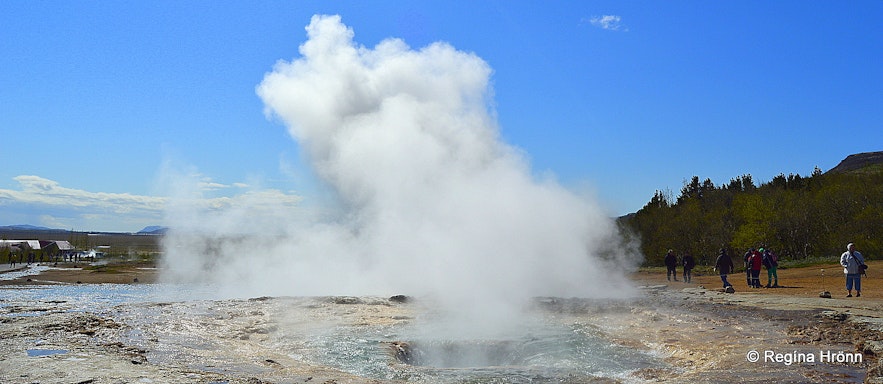
Geysir changed foreign hands a couple of times until in 1935 a director in Reykjavík, Sigurður Jónasson, bought the land and donated it to the Icelandic nation (around 15.3 ha).
The Icelandic State-owned some 34% of the fenced-off area including Geysir, Strokkur and Blesi, but the rest belonged to other landowners. The Icelandic state sued the landowners and the entrance fee was dropped.

Blesi hot spring is one of the main hot springs in the Geysir area, above Geysir and Strokkur to the west. It is divided into two and looks like two blue eyes or a pair of glasses.
After the big earthquakes in 2000, Blesi started bubbling and boiling, but it is dormant now. I have actually never seen it active, but I love the absolutely fabulous serene blue colour of this hot spring.
You can see the same blue colour at The Blue Lagoon .
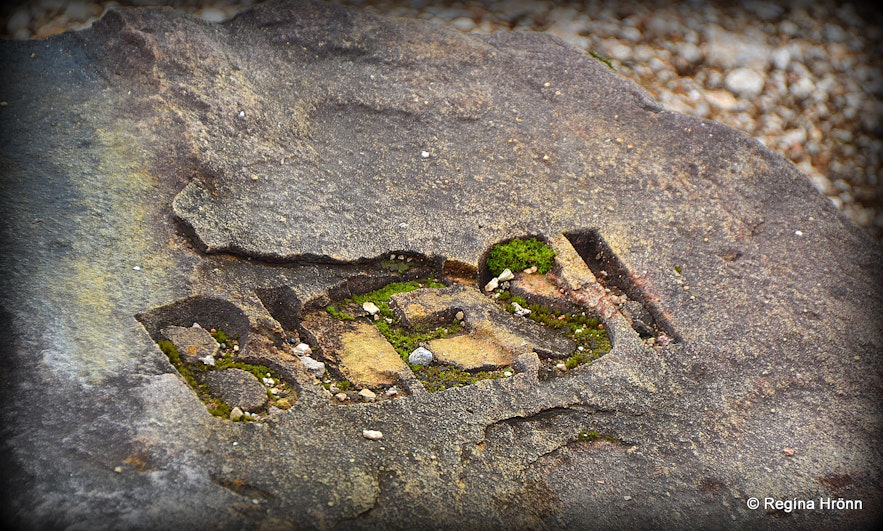
And Bláhver in the same geothermal area of Hveravellir.
Hveravellir - the beautiful Oasis in the Highland of Iceland
Such hot springs are my favourite hot springs in the geothermal areas of Iceland :) See also my travel-blog: A Local's Favourite Geothermal Areas in Iceland .

Blesi (which is a common name for a horse here in Iceland) consists of 2 hot springs; the northern hot spring and the southern hot spring. The northern hot spring is the one sporting this fabulous blue colour, which stems from colloidal silica when it comes in touch with the atmosphere, or something of that sort ;)
Not that I understand this, but I adore the effect it has on the water in the northern eye.
I have seen the northern eye lose its fabulous colour and become reddish and cold with ice on top on a cold March day on my last visit to Geysir. That was a sad sight for me.
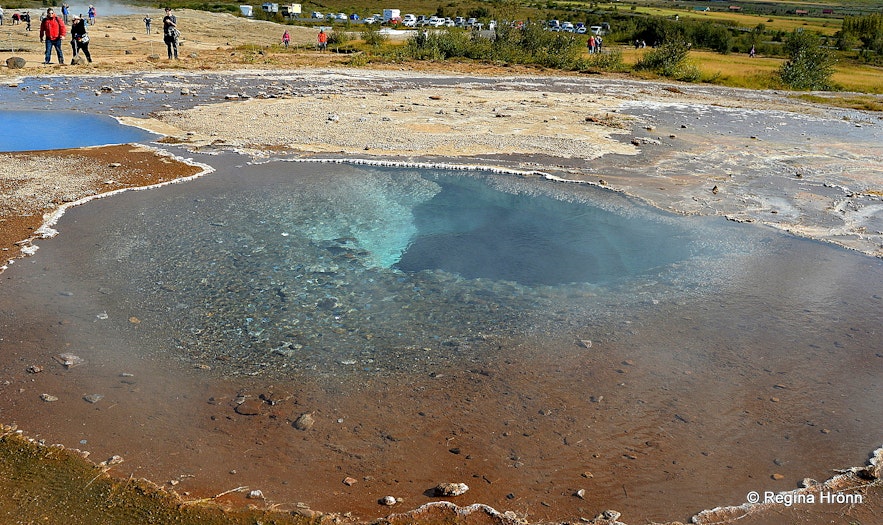
The other part of Blesi, the southern hot spring, which is separated from the blue colour by a narrow strip of land (called blesi in Icelandic), is quite different looking; very clear, deep and much hotter than the northern eye.
You can look down into the clear water and see the hole from which the boiling hot water originates.
The water from the southern eye flows over to the northern eye and heats it up, as the northern hot spring is only around 1 metre deep and has got no source of water.
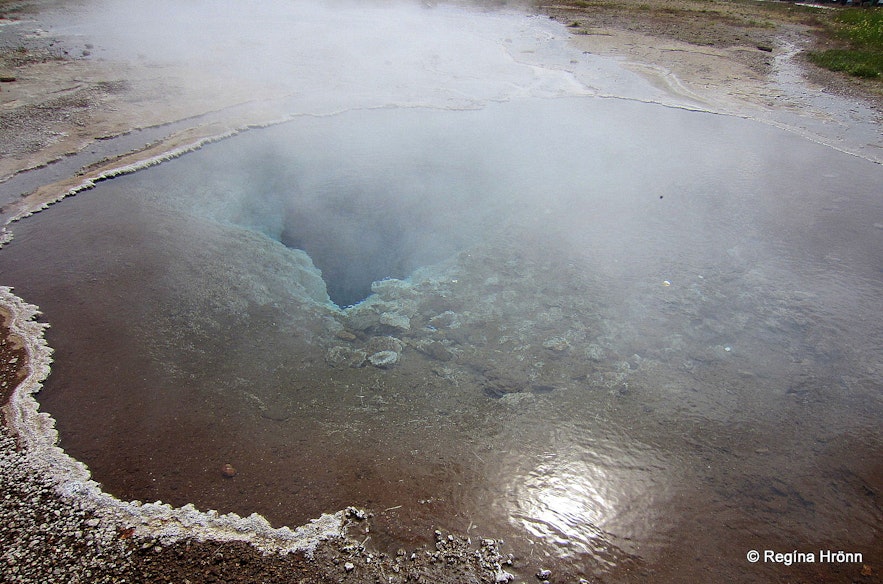
The temperature in the northern eye of Blesi is around 40 degrees C, and in the early days, a brook, which seems to have been running from Blesi back then, was used by travellers for bathing and washing clothes as it had a comfortable temperature.
And travellers in the old days would heat tea and heat up food in pots in Blesi.
The water was good enough to be used for tea, to warm up the visitors who had to spend days in a tent in the Geysir geothermal area waiting for Geysir or Strokkur to erupt.

What irritates me a lot is spotting coins in Blesi hot spring :(
By the entrance of the Geysir geothermal area, people are urged not to leave garbage in this area and not to throw coins into the hot spring. It is littering and damaging and we don't want any of that in nature today.
There is one fissure at Þingvellir national park where it is allowed to throw coins and make a wish; at Nikulásargjá a.k.a. Peningagjá - Money Fault, only in that one spot in Iceland, nowhere else.
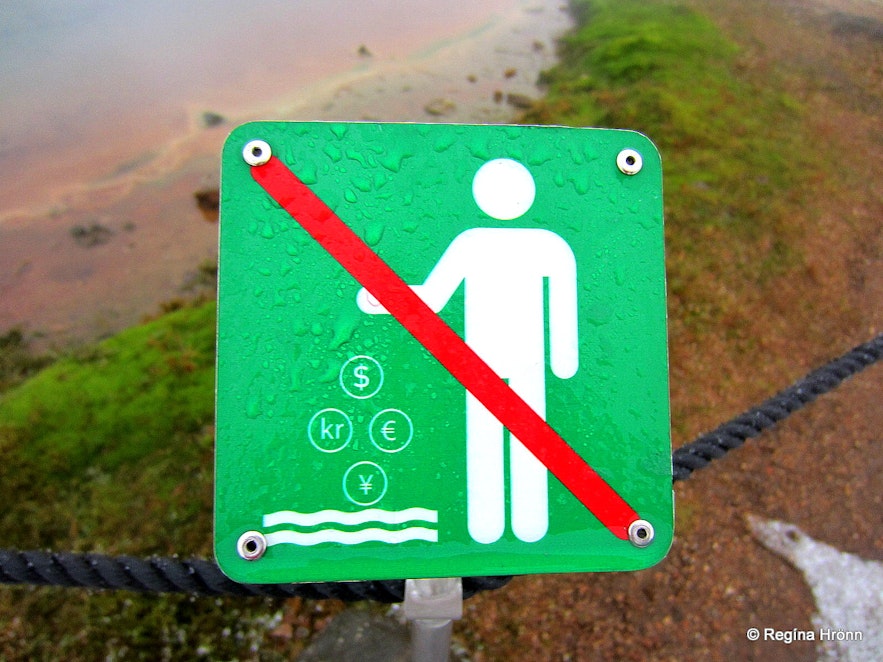
And when you see us locals throwing money into Peningagjá then we are making a wish, and we have to follow the coin with our eyes until it lands on the bottom of the rift.
This has been a tradition since Nikulásargjá was bridged back in 1907, and people started throwing coins into the fissure.
I learnt this from my grandparents who had a summer cottage at Þingvellir. And I still do it when I visit Þingvellir.
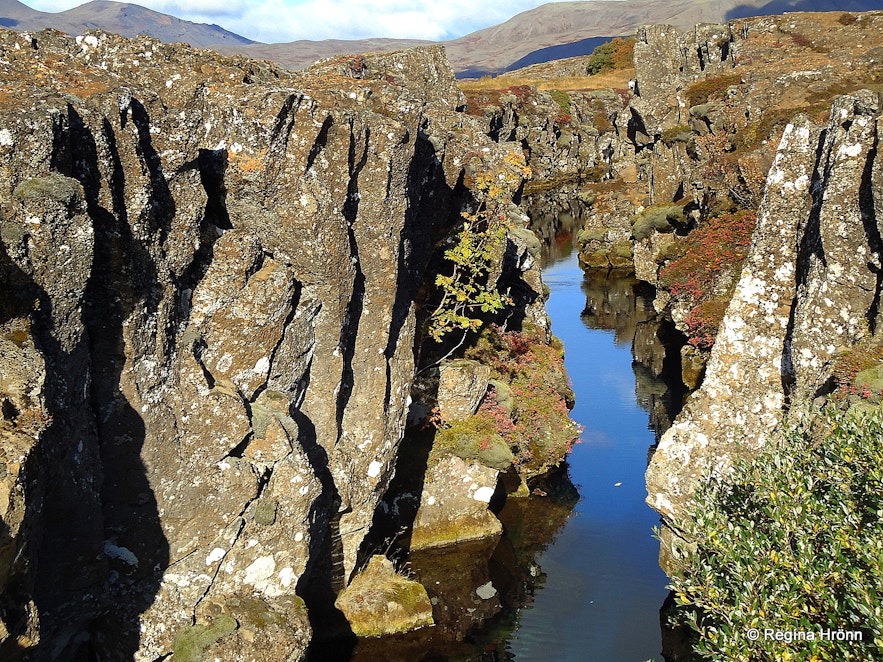
If you google Peningagjá the first link that comes up is an April Fools' Day joke on the official website of the national park, telling us that it was only allowed to throw Icelandic coins into the fissure and that they were charging people who wanted to throw coins into the fissure ;)
A Local's Experience of the Golden Circle Tour in Iceland
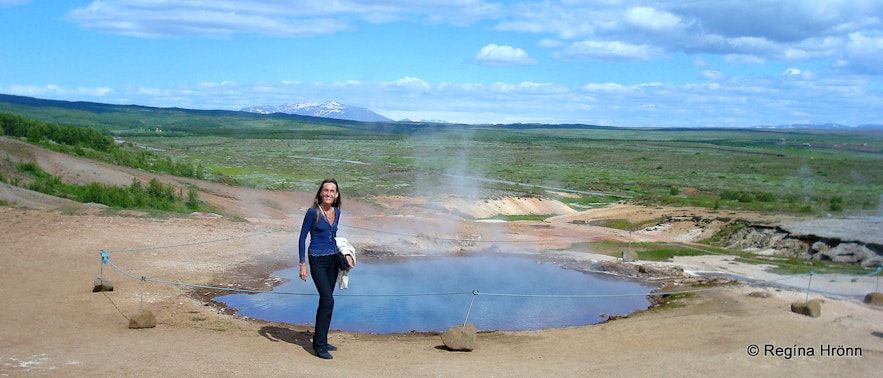
One of the hot springs in the Geysir geothermal area is called Konungshver - the King's hot spring or the Royal hot spring.
It is at the west end of the Geysir geothermal area above Geysir and Blesi. It is named after the Danish King Christian IX, who visited Geysir back in 1874.
Geysir didn't erupt for the king, but clods of turf were thrown into the bowl of Strokkur to force it to erupt for the king. This practice, might with time have blocked the shaft of Strokkur so it stopped erupting.
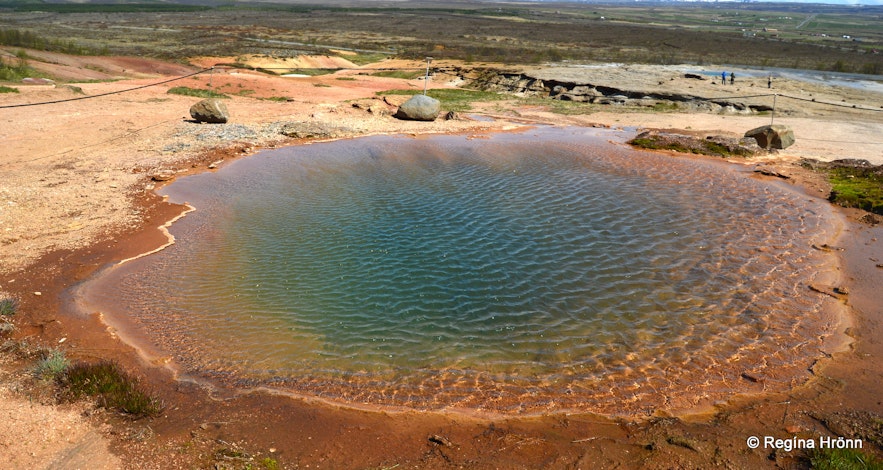
Konungshver appeared some 20 years after the king's visit, or in 1896 after a big earthquake, and even erupted 1 m in the air, gradually becoming smaller and smaller.
At the bottom of Konungshver, there are some rocks that might be blocking the shaft.
Then again after the earthquakes in 2000 Konungshver became active with spouts from 1.5 - 1 m in the air.
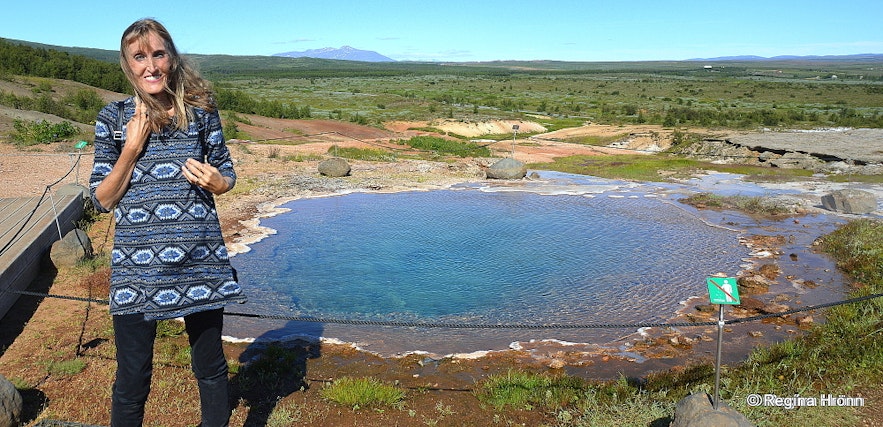
Konungshver changes in colour and never looks the same to me. I have had my photo taken by it for 19 years now and it always looks different to me.
If you look closely up at the hill behind Konungshver in my next photo, you will see 3 rocks with some carvings on them.
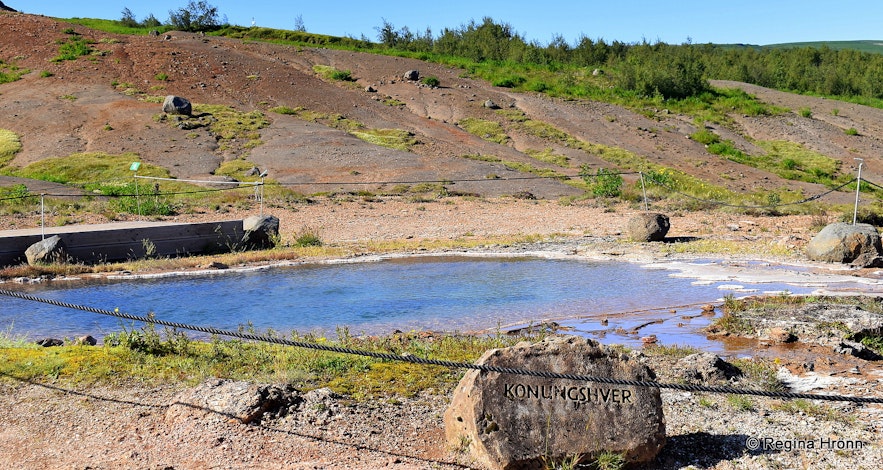
One of the rocks is almost hidden by the vegetation. These 3 rocks are called Konungasteinarnir or the Rock of the Kings .
The initials of 3 Danish kings are carved in these rocks to commemorate the Iceland visit of these kings.
Of course, they visited the Geysir geothermal area.

CIX 1874 is carved in the 1st rock in my photo below, meaning King Christian IX who visited this area back in 1874.
The other rocks have the names of the Danish Kings Frederik VIII (1907) and Christian X (1921).
I was not able to get a clear enough photo with the initials of Christian X as it is almost hidden away in the trees.
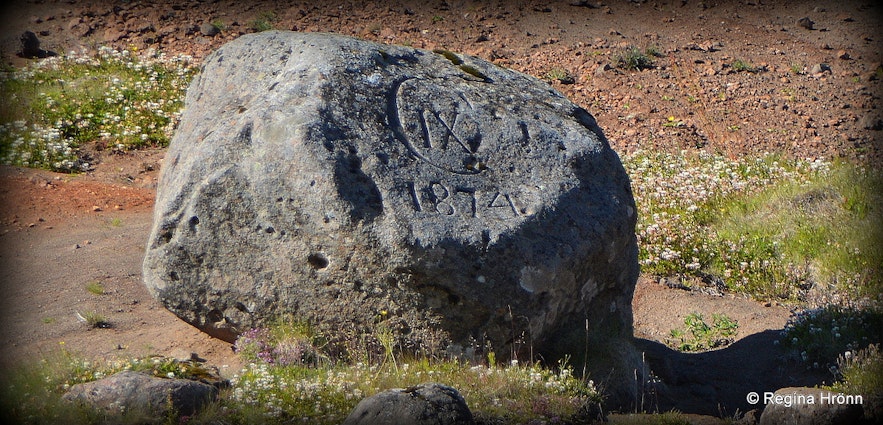
But in my photo below you will see the initials of King Frederik VIII who visited Iceland back in 1907.
I have read an old book about his Iceland visit, called 1907, and he arrived with a large entourage of ministers and politicians and such and they had a lot of fun on this tour.
The Danish King Frederick VIII visited Iceland back in 1907 - I had to zoom in from afar, this is the best I could do.

Frederick VIII
I had to zoom in as much as I could to be able to get the photos and that is why they are out of focus, but they give you a general idea of the stones, which very few people notice.
It is a shame that these rocks cannot be visited. These 3 rocks are natural rocks and as there are only 3 of them only the names of 3 Danish kings were added.
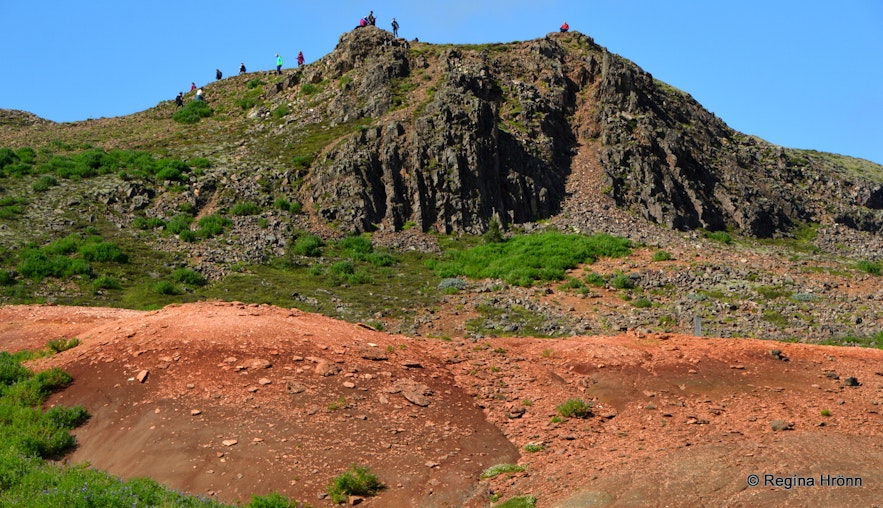
Mt. Laugarfjall - Laugarfell rises above the geothermal area. The reason why I put 2 names is that on the map of the National Land Survey of Iceland I found Laugarfjall, but on the view-dial is written Laugarfell.
On the way to Mt. Laugarfjall, you will pass a beautiful view-dial and a sundial designed by Jón J. Víðis back in 1965.
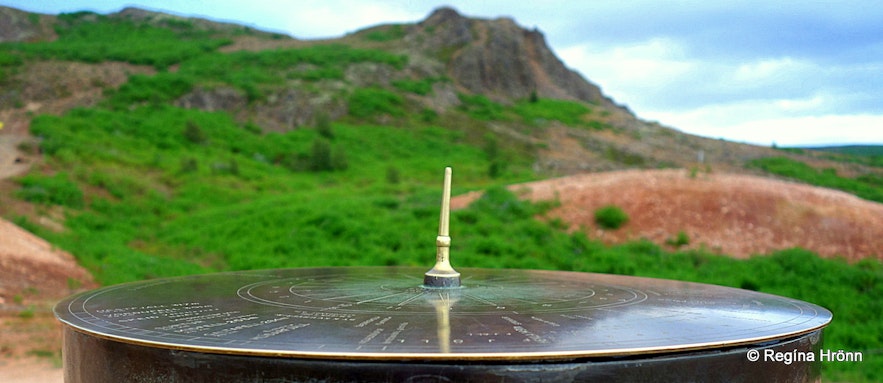
His assistant and nephew was Jakob J. Hálfdanarson, who is my father-in-law, but he took over from Jón J. Víðis and designs the view-dials now.
I stop by all the view-dials I can find on my travels in Iceland and take photos of them for my collection, but all in all, there are a little under a hundred view-dials in various locations in Iceland.
Many people hike up the mountain Laugarfjall while visiting the Geysir geothermal area.
It is a short hike and gives you an excellent view of the geothermal area and Haukadalur valley.
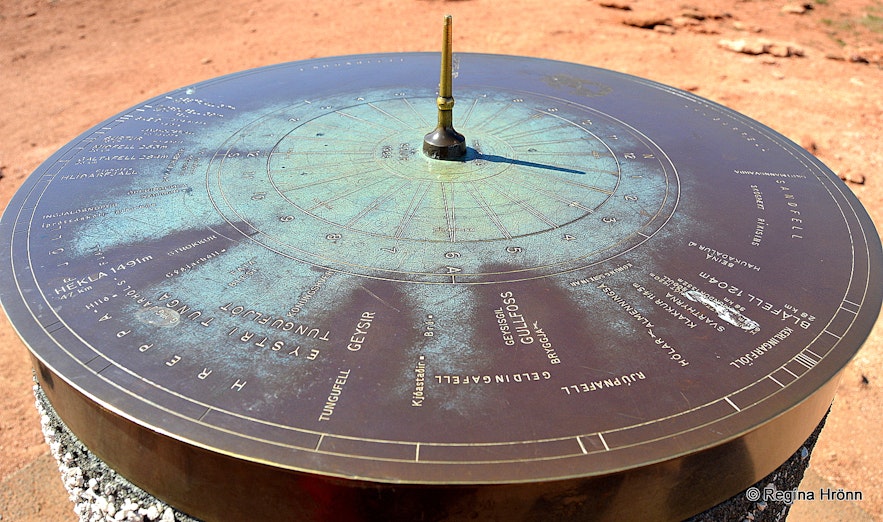
I hiked to the top of Mt. Laugarfjall for the first time in the summer of 2020, after a path and observation platforms had been added.
On the way, you will pass a hot spring with bright geothermal colours.
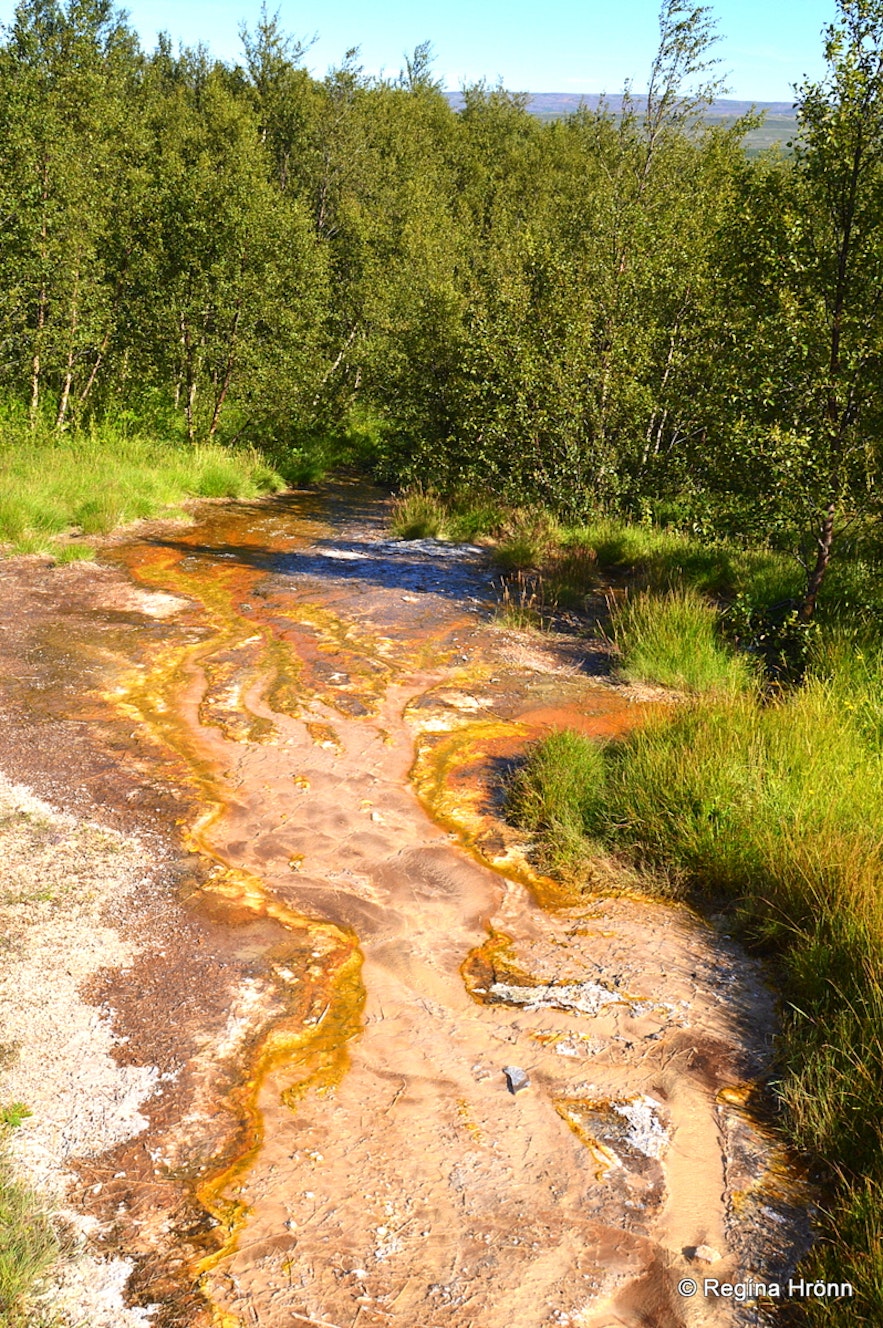
You follow the path leading from Konungshver hot spring straight up to Mt. Laugarfjall.
The last time I visited 2 observation platforms had been added, one pointing away from the geothermal area into Haukadalur valley.

The other observation platform offers a view of the geothermal area.
The observation platforms are a fantastic addition to the Geysir geothermal area. This is a highly recommended hike given that you have enough time during your Geysir visit.
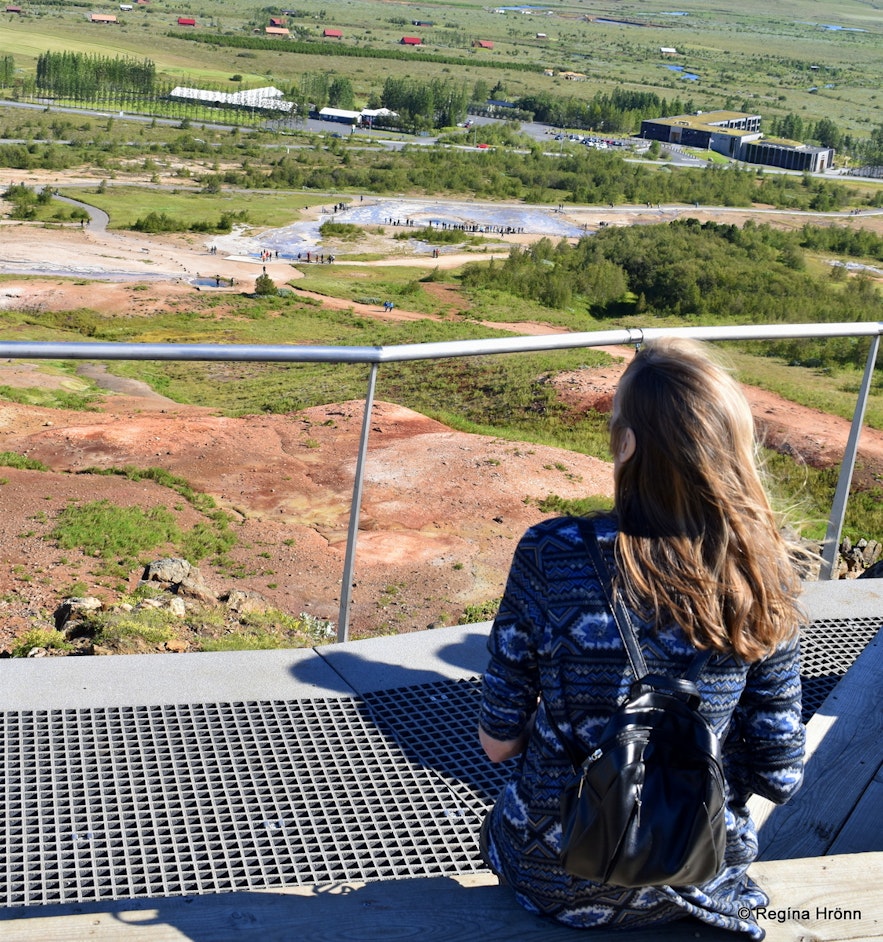
I usually don't have enough time when I am showing my foreign visitors the Golden Circle, but in the summer of 2020 nobody came from abroad to visit us, so we had plenty of time to travel in our country at our own pace.

There are several small hot springs in the Geysir geothermal area, especially in the south end. One of them is called Litli-Geysir or the Little Geysir. Litli-Geysir is a small hole with bubbling and boiling water.
Litli-Geysir sometimes spouted 6-9 m in the air following an earthquake and was once one of the 3 active geysers in the geothermal area.
Smiður - the Carpenter
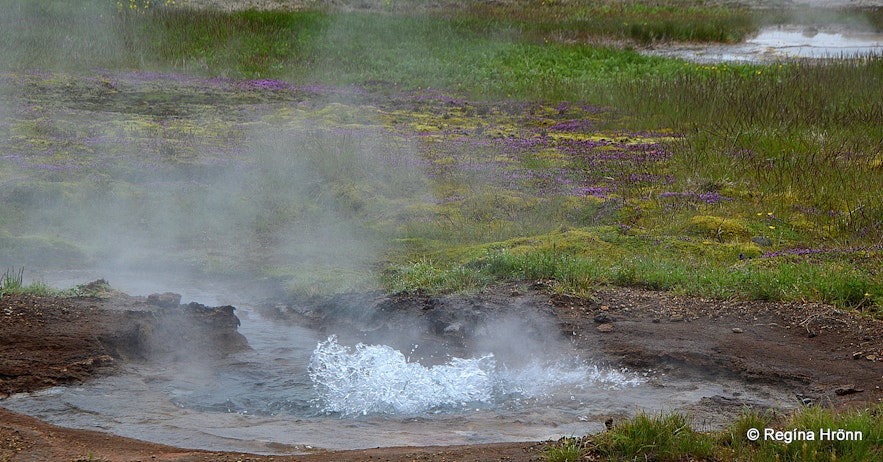
Smiður - the Carpenter is another churning and bubbling hot spring in this area.
Prior to the royal visit of the Danish King Frederik VIII, apparently, a carpenter dug out Smiður and thus it got its name. Sometimes soap was added to Smiður, which made it erupt 3-7 m in the air.
Soap was frequently used to force the hot springs to spout, but as I told you earlier then this practice stopped in 1992.

The reason why soap was used to make the hot springs erupt might stem from when laundry was done in the hot springs and soap was used in the process, maybe resulting in an eruption. It is just a suggestion on my behalf though.
Soap was first put in a hot spring around 1900 so this practice lasted for almost 100 years.
There are so many geothermal springs inside the closed-off area that I must confess that I don't know which is which as I didn't see any signs, apart from that by Litli-Geysir and Smiður. One of them is called Litli-Strokkur - Little Strokkur.
The hot spring in my video was the most active one of those I could spot from the path, together with Litli-Geysir, which was boiling and bubbling.
This hot spring was constantly boiling and water from it was forcefully bubbling into the air.
On the map below you can see how many other hot springs there are in the Geysir geothermal area. I haven't seen them all as they are fenced off, but have tried my best to identify them and find information about them.
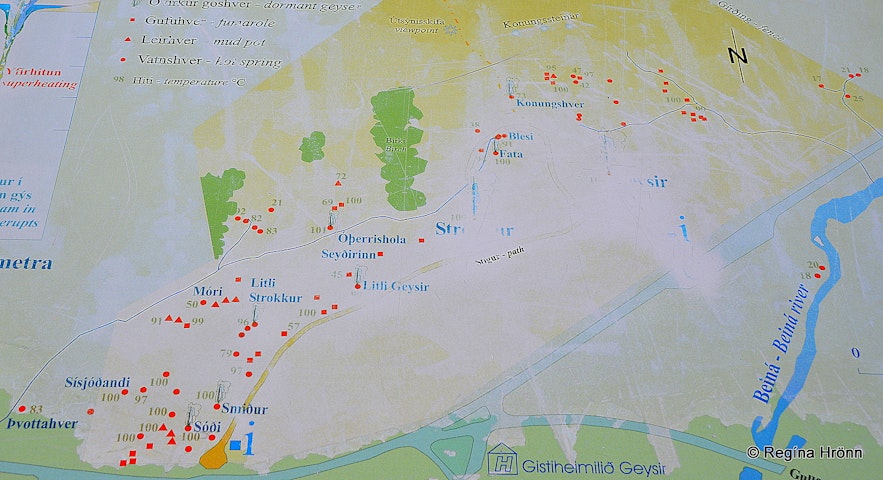
The following website is the absolute best source I have found on geothermal areas around the world:
Volcanic Springs
Another hot spring which used to spout is Fata - Bucket, which apparently is in the shape of a bucket. It is located below Blesi in a now fenced-off area, so I haven't got a photo of it. But after the 2000 earthquakes, it erupted for a while.
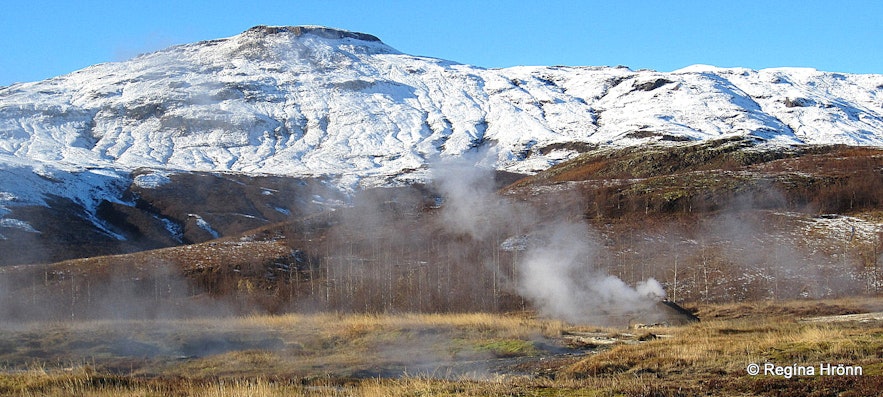
Then we have f.ex. Vigdísarhver, Seyðir, Þykkvuhverir (a mud pot area) and Sóði - the Slob, as it erupted dirty water, and Sísjóðandi (constantly boiling), which was apparently used for boiling food at Laugar farm and for laundry.
Óþerrishola (Wet hole or hot spring) can predict rain as it has been known to erupt when the barometer falls. After the earthquakes in 2000, it erupted from time to time.
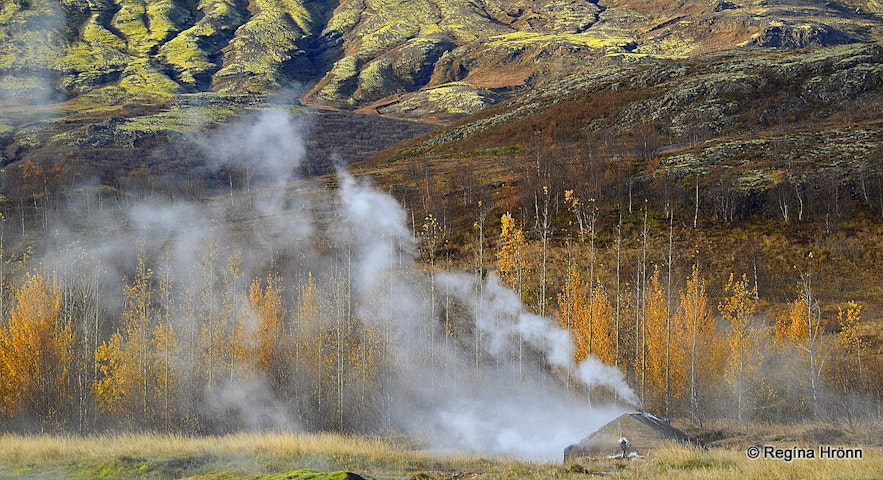
I hope that sometime in the near future a path will be added around this area, so we can visit its myriad of hot springs and get better acquainted with this part of the Geysir geothermal area.
Never enter this fenced-off area on your own as there are too many hot springs, which makes this a danger zone if you don't know where the hot springs are lurking.
A special type of dark rye bread is traditionally cooked in hot springs in Iceland, and I have sometimes seen the chefs at the restaurants at Geysir come to pick up their bread in the geothermal area.
The bread is cooked for 24 hours in a hole by the hot springs and the bread from the Geysir area is considered to be amongst the best rye bread on the Icelandic market.
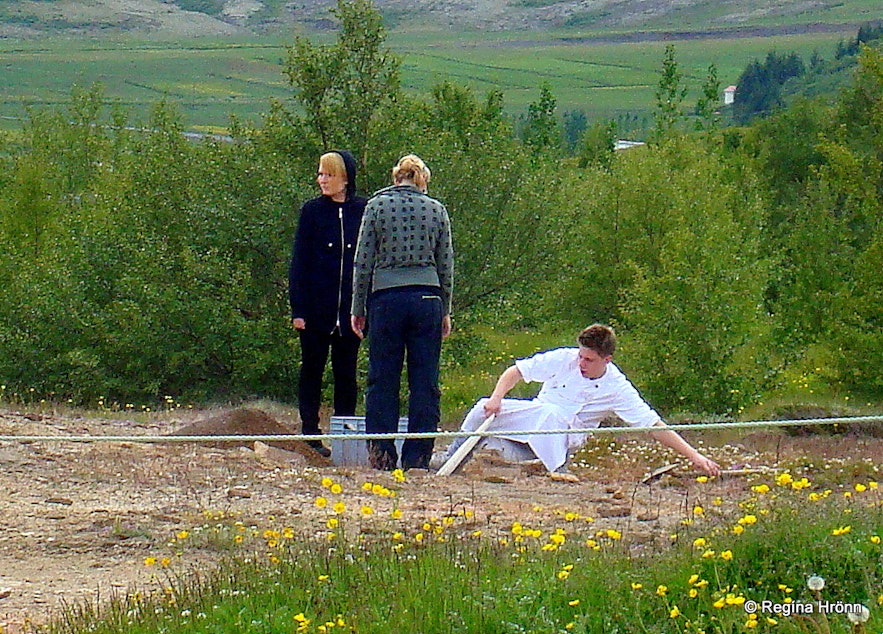
The long cooking procedure breaks down the starch in the bread making it very massive and juicy.
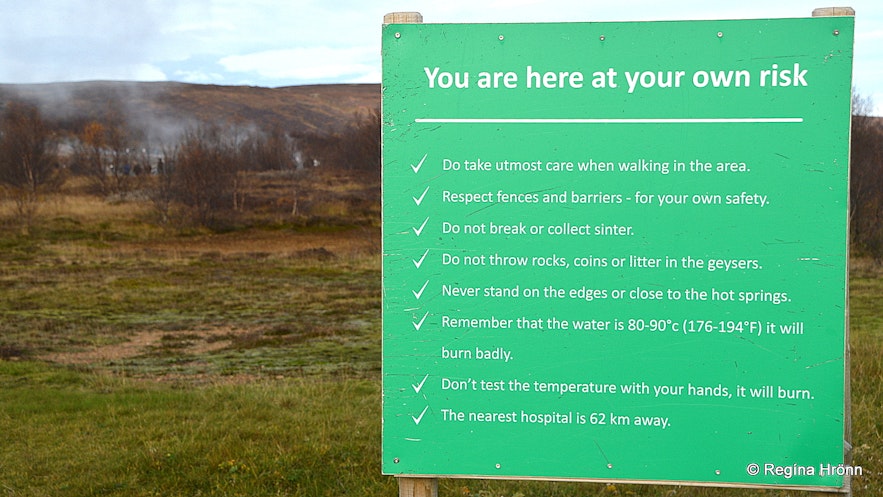
Be aware that the whole Geysir area is a high-temperature geothermal area, so stay within the boundaries and never touch the water as it is HOT (80-100 degrees C)!
Geothermal areas are danger zones and should be treated as such.
The dangerous part is that we never know what is going on underneath the thin surface in geothermal areas.
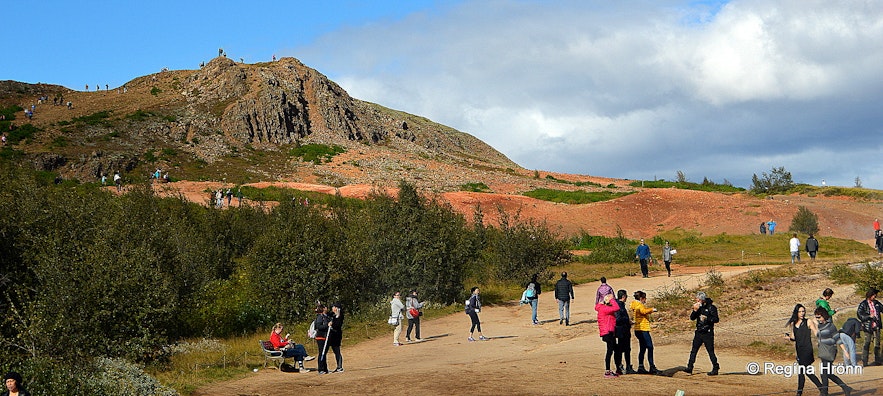
That is why there are marked paths. People who have wandered off the marked paths have found themselves stepping into boiling hot water hidden by the grass or hidden beneath a thin crust.
When my mother was around 9 years old, she saw a man stepping through a thin crust here at the Geysir geothermal area, and straight into boiling hot water.
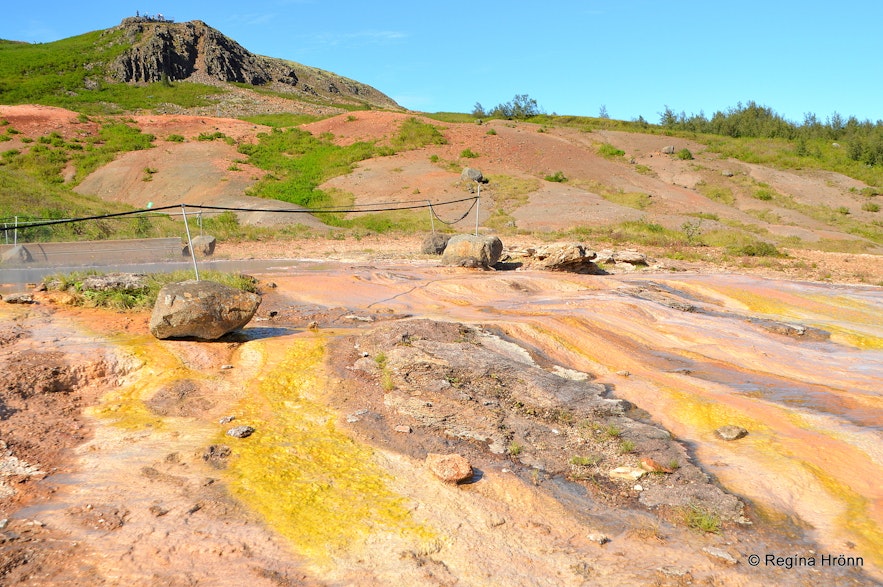
She told me about this incident and how the skin on his foot rolled up and left the foot of the poor man raw. That mental image stayed with me and I never take any risks in Iceland's geothermal areas.
She was staying at the hotel for the night and Geysir didn't erupt during the day, but in the middle of the night loud thumps were heard and it was like the earth was being ripped apart, and Geysir erupted beautifully. What a sight it must have been for a young girl :)

There never seem to be enough warning signs in geothermal areas, as some people don't know that the water is extremely hot.
And some even cross the boundaries to get better photos or stick their hand into the geysers to check the temperature, and don't seem to realize how dangerous this is!
Even Nonni did it when he was travelling here in the 19th century and wanted to test the temperature of Geysir.
Nonnahús & Nonni - the Honorary Citizen of Akureyri
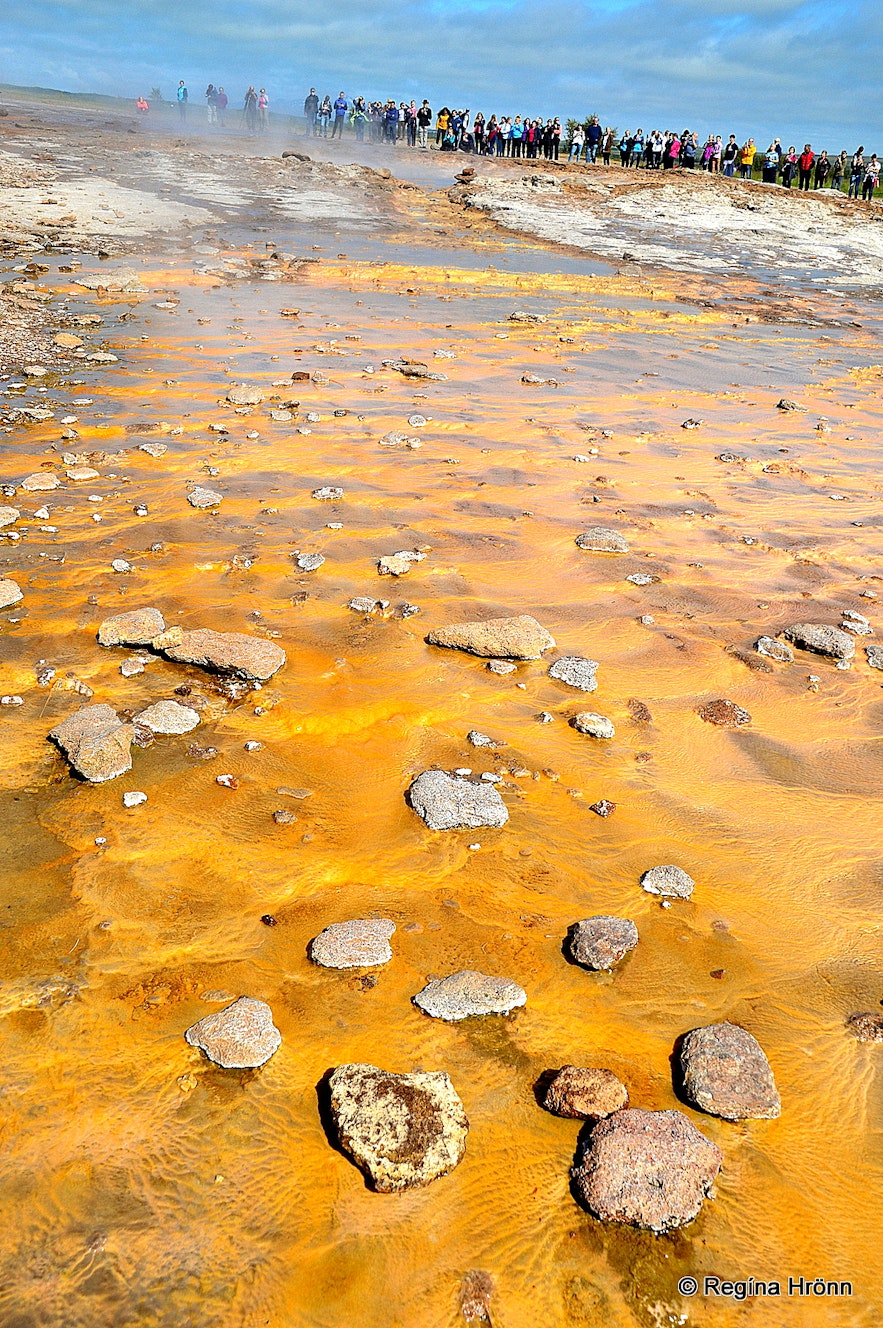
The ropes for the marked-off areas are not high, but that doesn't mean less danger, only that we like to keep the geothermal area as intact as possible.
In September 2010 the boundaries/ropes were put higher up so that there should not be any confusion anymore as to where it is allowed to walk in the Geysir geothermal area; only on the paths.

It pains me to see that some people ignore the safety ropes and f.ex. step inside the closed-off Konungshver and leave their footsteps in the mud.
It is both dangerous and inconsiderate. And it is hard to clean geothermal mud from your shoes. It can stick to your shoes like heavy cement as I experienced in the geothermal area at Þeistareykir in North Iceland.
The colourful Þeistareykir Geothermal Area in North-Iceland

Every year people get injured in the geothermal areas. In 2010 a 2-year-old girl got injured close to Strokkur. She tripped over a rope, which defined the walking paths, and into the run-off water from Strokkur; she got burnt in the face and on her hands :(
In the following years, three children got injured, and a tourist stepped into a hot spring.
Small children should always be carried by their parents in geothermal areas and children should be under supervision the whole time they are visiting this high-temperature geothermal area.
Also, be careful in the wintertime as the paths can be covered with ice and very slippery.
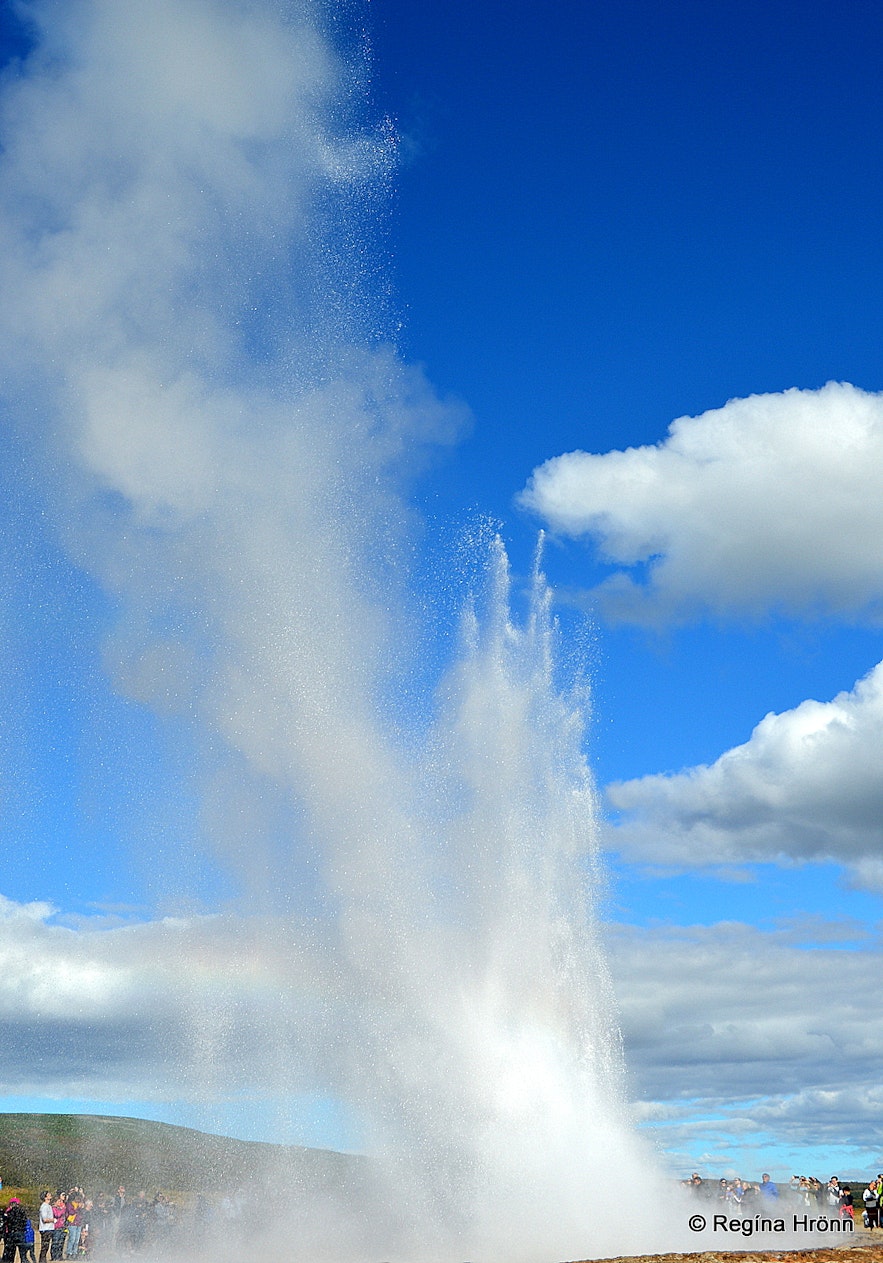
An accident took place when a sudden wind blew Strokkur straight towards an Icelandic family which was standing at a safe distance outside the safety lines. So even standing at a safe distance can cause accidents if the wind is blowing suddenly.
A helicopter had to come and fly the family to the nearest hospital, which is 62 km away.
Always take the wind direction into account when you choose where to stand to watch Strokkur erupt.
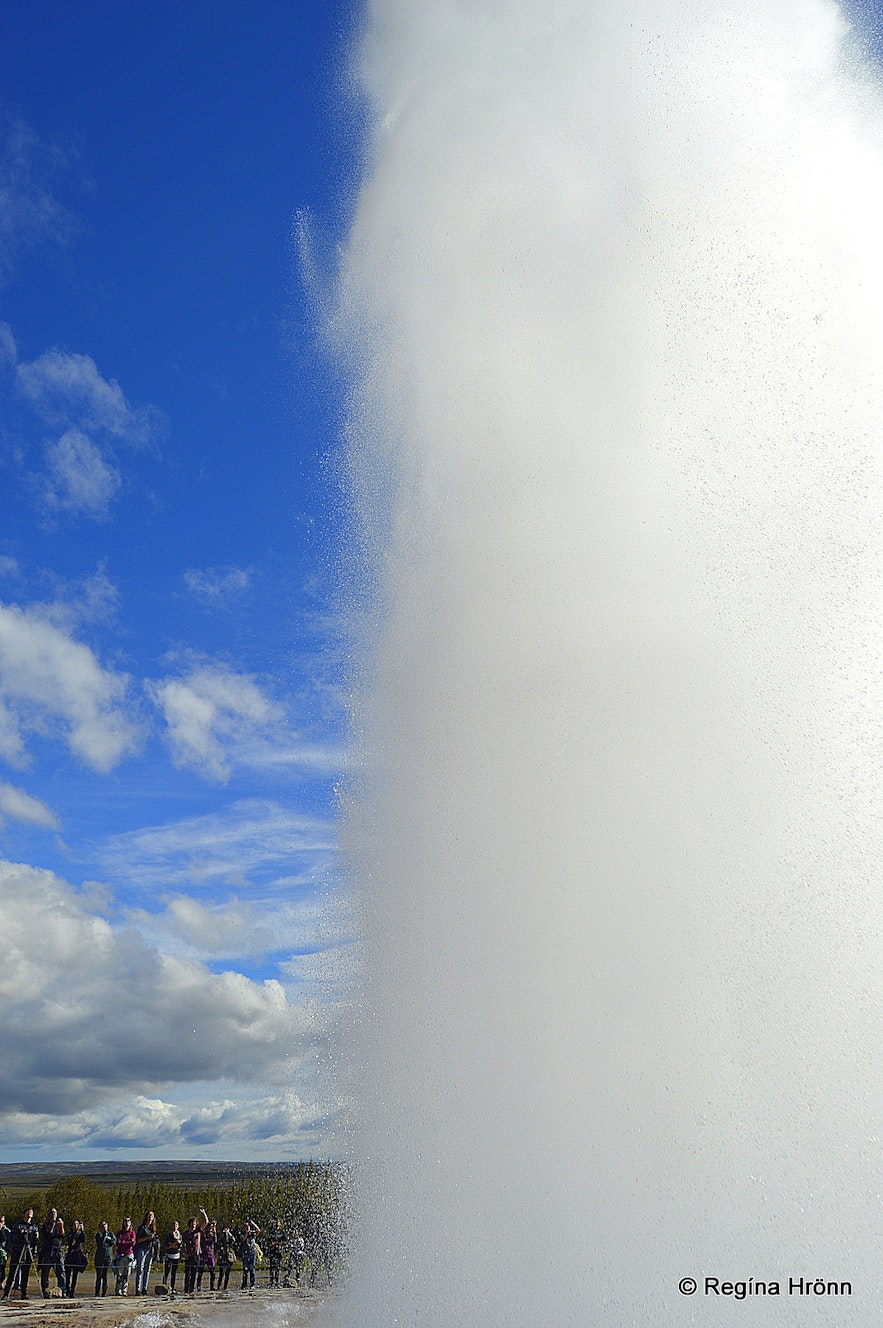
Spectators stand all around Strokkur, which should be ok if no wind is blowing, but as we learned from this accident, a sudden wind can blow the hot water in the direction of bystanders.
One year a tourist got burns on both feet when he stepped into a hot spring in the middle of the night. In the photo below you can see what this area looks like at the dusk.
Never enter these areas after dark as you might accidentally step into a hot spring hidden beneath a thin crust or in the grass.
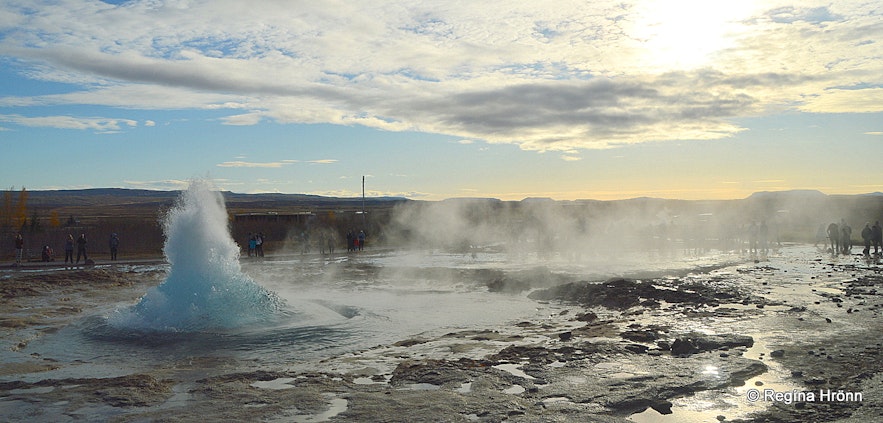
I have only once seen Strokkur erupting in the dark. We reached the Geysir geothermal area in the dark and parked the car in the small northern parking lot and stayed outside the fenced-off area. We had dinner in the car, overlooking the geothermal area.
Nobody was around and then Strokkur erupted out of what seemed to be nowhere in the darkness; a magnificent sight!
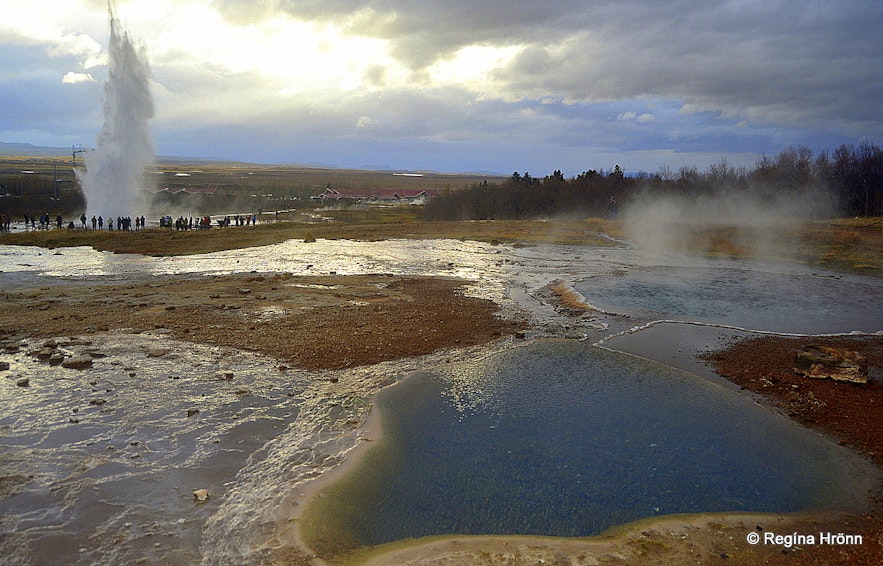
We were coming from Mývatn in the north and had returned through the central highland via Kjalvegur - Kjölur road, that is why we were at Geysir so late that night.
We stopped on the way at one of the most magnificent geothermal areas in Iceland; the high-temperature geothermal area Hveradalir in Mt. Kerlingarfjöll in the highland.
A fascinating Hike through the Geothermal Area of Hveradalir in Mt. Kerlingarfjöll via Kjölur Road
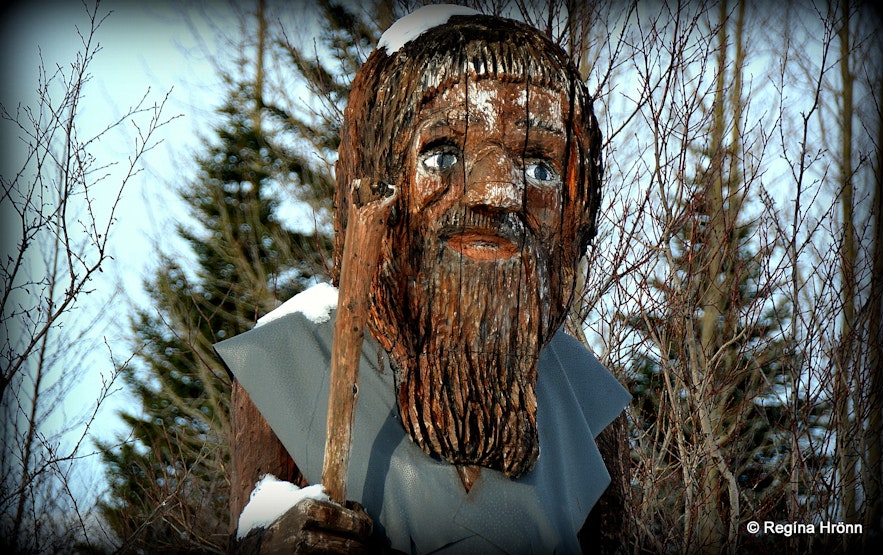
I have my photo taken by it every time I visit the Geysir geothermal area.
Icelandic folklore is filled with stories about trolls and elves in Iceland and in many places in Iceland you will find petrified trolls, who didn't reach their cave and got turned into stone by the first rays of the sun.
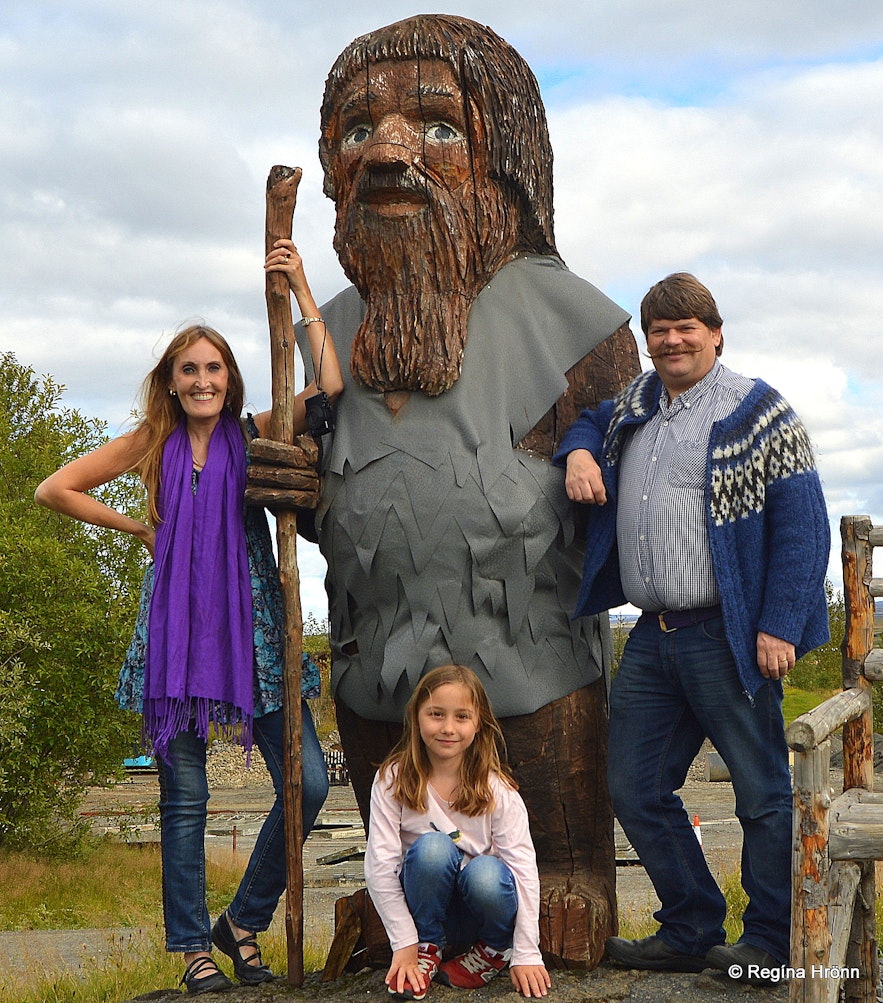
I have written another travel-blog about A Visit to the Icelandic Haukadalsskógur Forest with a Dip in Kúalaug Hot Pool where you can find the folklore about the troll Bergþór in Bláfell.

See also other troll stories :
Kerlingarskarð Pass in Snæfellsnes in West-Iceland - the Folklore of the Giantess & her Fiancé
The 3 Trolls who wanted to separate the Westfjords Region from the Mainland of Iceland - Icelandic Folklore - Vestfjarðatröllin
You might also notice another statue of two guys in a strange position and wonder what it represents. I am often asked what on earth the guys are doing. This is a wooden statue of two men wrestling or glíma as we say in Icelandic.
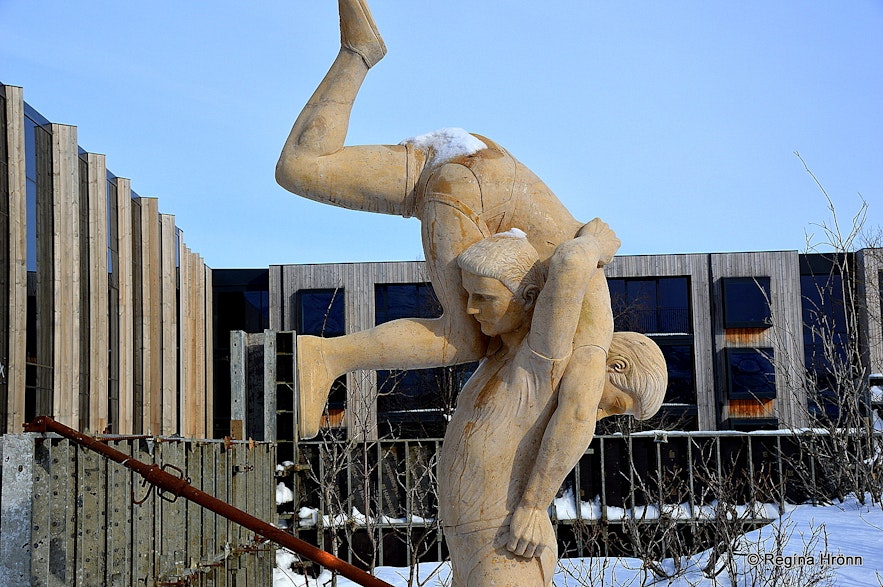
One of them is Sigurður Greipsson (1897-1985), who built and founded a Sporting Academy at Geysir in Haukadalur (1927-1971), Iceland's first Sporting Academy.
Sigrður was a great wrestler and he held the title of the Wrestling King of Iceland for 5 consecutive years.
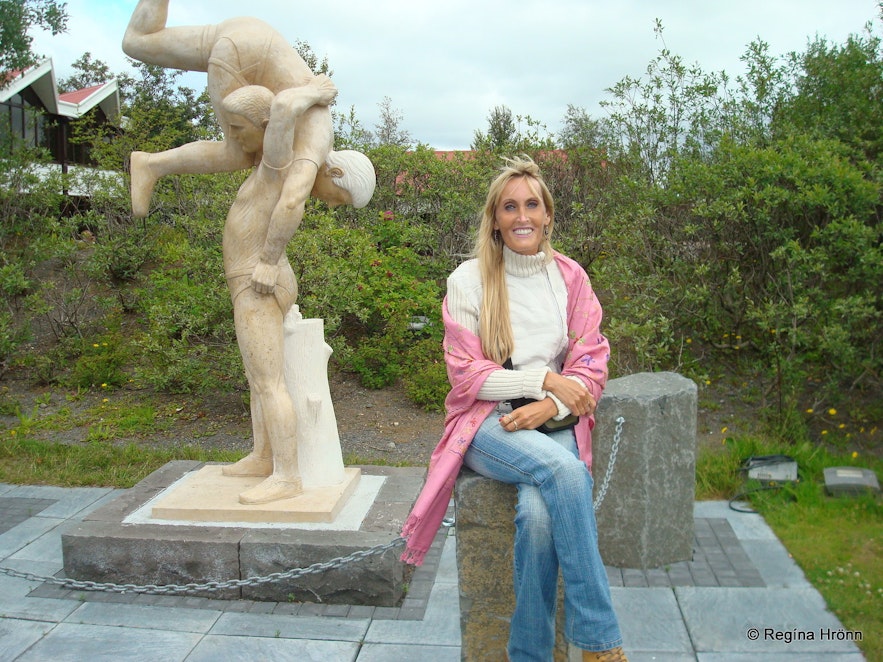
You will also notice a huge statue of wrestlers in the restaurant area at Geysir by Lucy Unwin. The theme at Geysir is wrestling in honour of the memory of Sigurður.
Wrestling was a national sport in Iceland, and you can read more about Sigurður and wrestling on the following website: Geysir Glíma
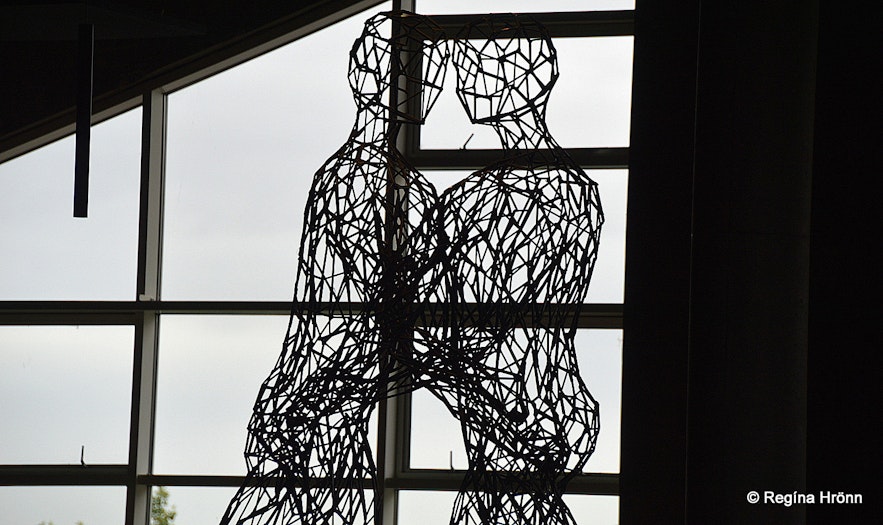
The Geysir geothermal area is 100 km away from Reykjavík and the Golden Circle is around 250 km, depending on detours, and will normally take some 8 hours to complete with stops.
To visit this area you can rent a car in Reykjavík or join one of the many Golden Circle tours.

Have a lovely time at the Geysir geothermal area and stay safe :) The nearest attraction is the majestic Gullfoss, the Golden waterfall which gives a name to the Golden Circle:
Hvítá frá upptökum til ósa - Hjálmar R. Bárðarson
Íslandsferð J. Ross Browne 1862
Geysir - fornleifaskráning
Jarðskjálftarnir miklu á Suðurlandi
Mbl.is - Konungssteinarnir við Geysi
See more blogs

Chasing Waterfalls in Iceland
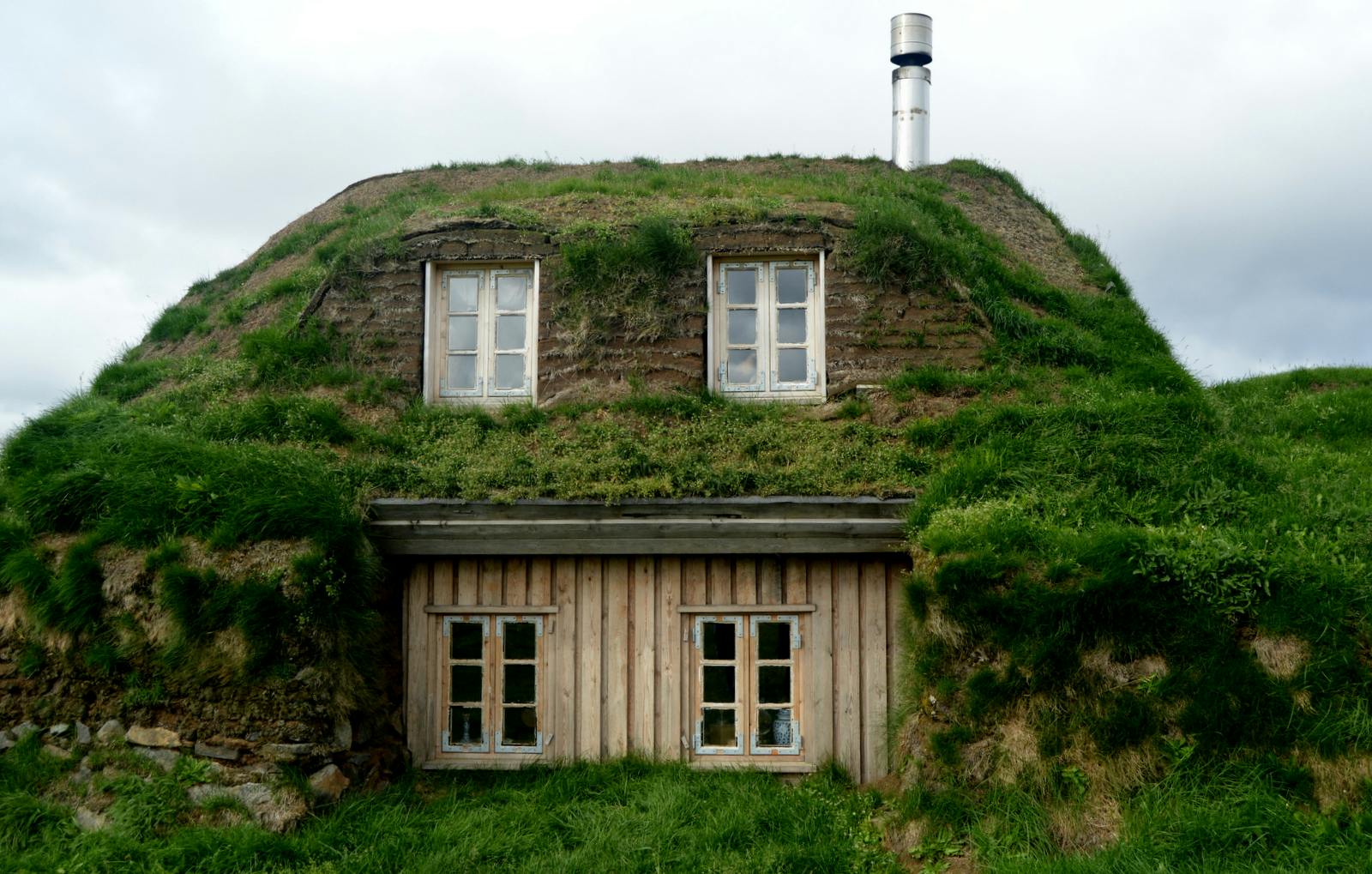
Sænautasel Turf House in the Highland of Iceland
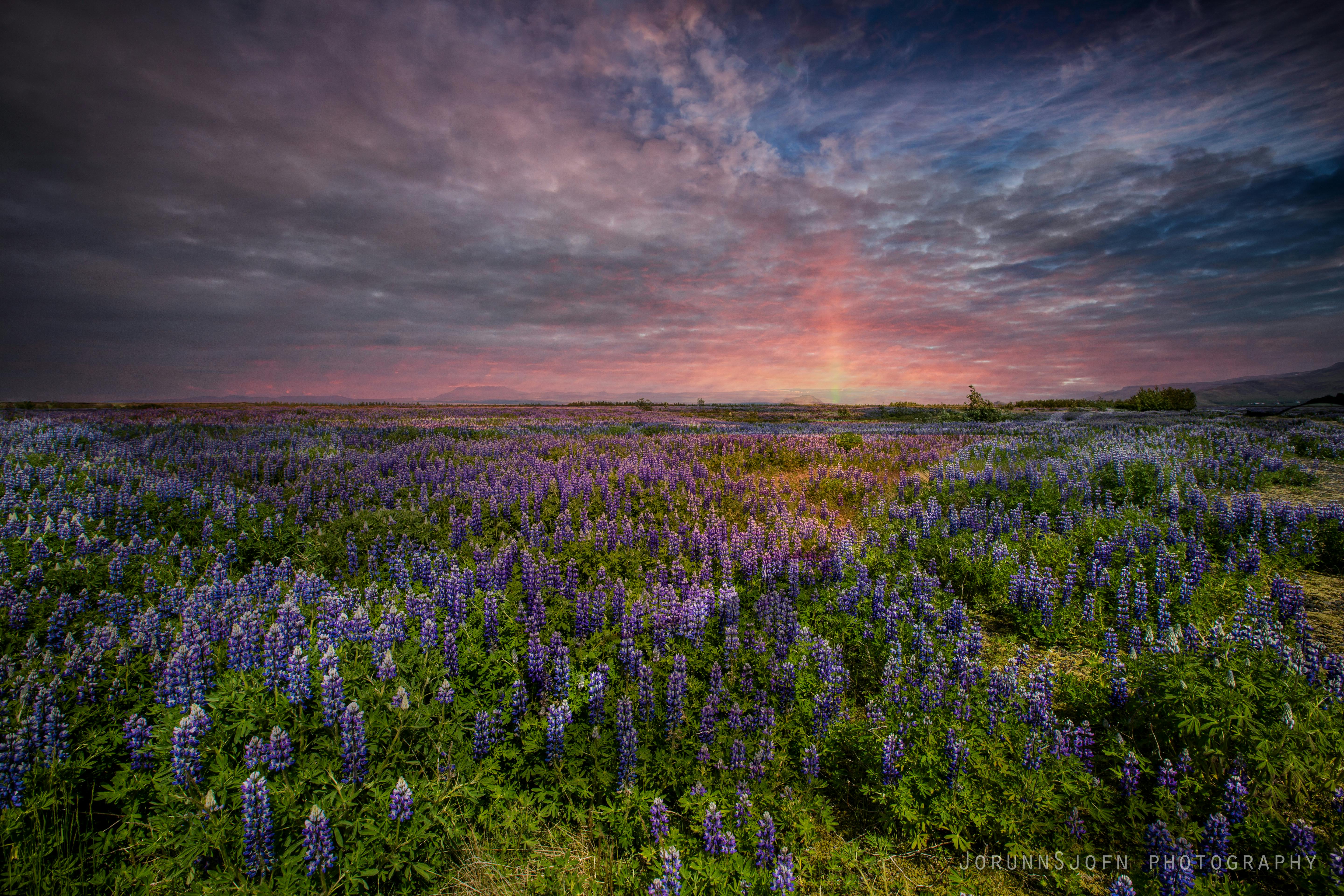
The Dynamic Plant Lupine
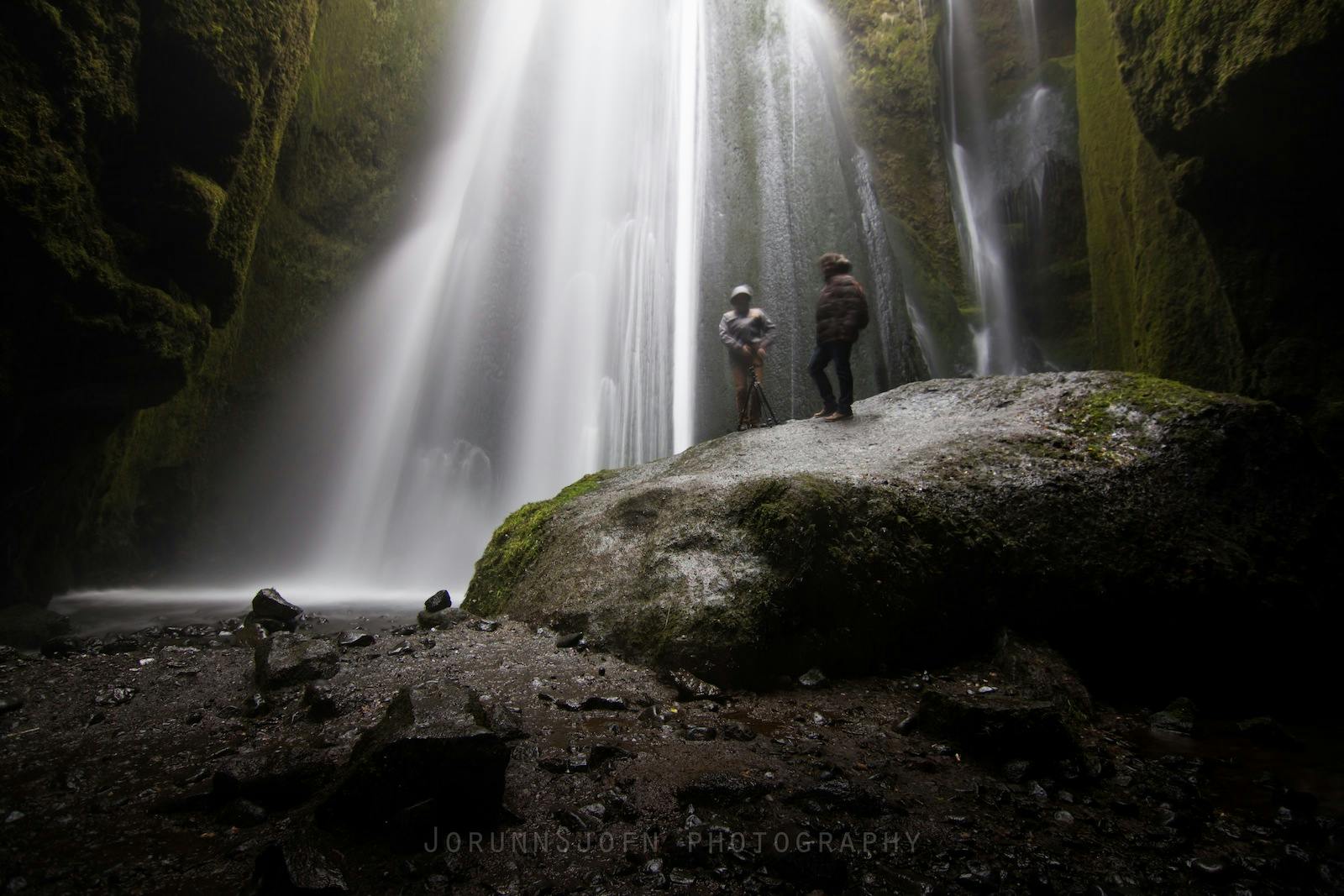
Secret waterfall on the South Coast
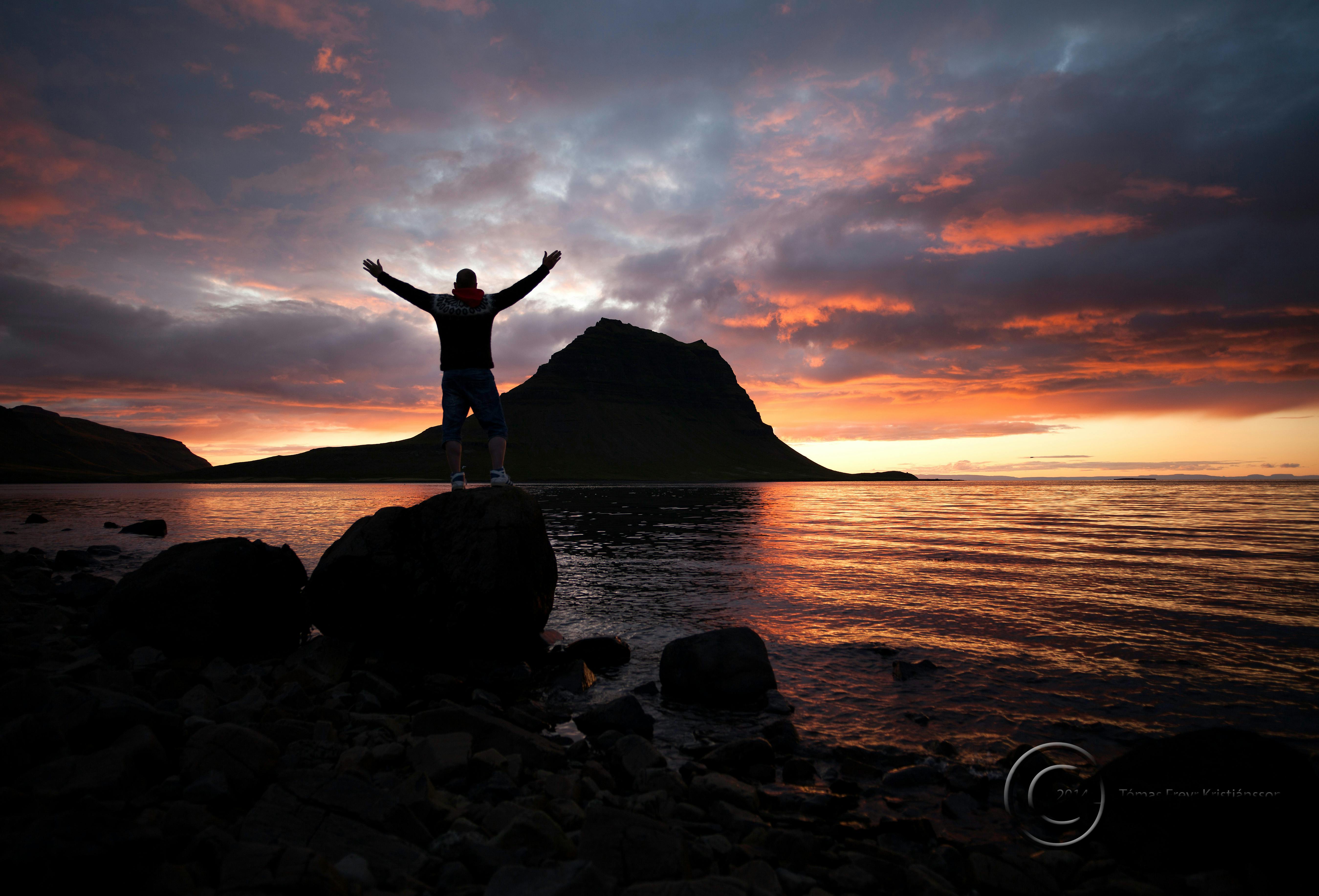
Midnight Sun Season in Kirkjufell
Other interesting blogs.
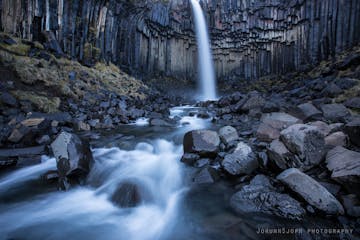
Download Iceland’s biggest travel marketplace to your phone to manage your entire trip in one place
Scan this QR code with your phone camera and press the link that appears to add Iceland’s biggest travel marketplace into your pocket. Enter your phone number or email address to receive an SMS or email with the download link.
Top things to do in Iceland
Book your complete trip with the best companies only

Explore an Ice Cave

Visit a Live Volcano

Find the Northern Lights

Visit the Blue Lagoon

Go on a Road Trip

Do the Golden Circle

See the Glacier Lagoon

South Coast Tours

- Discover Iceland Locations

The Great Geysir and Geyser Strokkur
Iceland’s geysers and hot springs.
The geysers that adorn the bathrooms of all over the world owe their nomenclature to the Icelandic word “geysir”, which comes from the Icelandic Old Norse verb ‘Geysa’, meaning to “gush forth”. Also, all of the world’s hot springs that eject hot water are called geysers, in all tongues of the world. Interestingly in Iceland, the word Geysir means only one thing: it’s the name of one geyser, The Great Geysir.
Visiting the geysers of the Haukadalur Valley is a must on the Golden Circle tour. Although the Great Geysir is basically inactive, its little brother Strokkur is doing its part of the job for the amusement of travelers and locals alike.
Discover Iceland offers range of private tours in Iceland to see Geysir. The most popular private tour includes Langjökull Glacier visit, see Golden Circle Glacier Private Tour and is delivered using Super Jeep. The classic Golden Circle private tour includes the sides Þingvellir, Gullfoss and Geysir as well as some secret stops along the way. Discover Iceland can plan multi day tours in Iceland from landing to departure which includes a stop at Geysir, contact [email protected]
The Active Geyser Strokkur
Another geyser called the Strokkur lies about just 50 mts south of it. This geyser erupts a lot more frequently than the Great Geyser. Thus the geyser Strokkur finds its pride of place in photos and brochures. Nearby there are around 30 smaller geysers and hot pools, including a tiny one aptly called: The Little Geysir.
Only lucky tourists get to see the eruptions of the Great Geyser, as they are unpredictable and the geyser is quite innactive. Many a times there is a long lull before an eruption. The Great Geyser is the first one in history to come to the notice of Mankind and to be written about extensively. Though the geysers are more than 10,000 years old, first references can be found in the 13th century. During the age of enlightenment the term ‘Geyser’ became popular in scientific circles to describe hydrothermal activity.
The geyser has had its ups and downs. In the year 1845, it is alleged that the eruptions reached a height of 170 meters. Prof Bunsen is accredited to doing research on the geyser and bringing out scientific explanations about its activity.
Buying and Selling the Geyser
The Great Geysir is not without its share of interesting history. Till the year 1894 the area was owned by a local farmer. His family had financial problems and was forced to seld the land.
First the land was offered to the State, but Congress did not show interest in it and refused to acquite the property. Lord James Craig, a whiskey distiller from Ulster province, who later went on to become the Prime Minister of Northern Ireland, had on the other hand been very interested in purchasing the geysers. After being contacted by his tour guide in Iceland that the land could now be bought, he went ahead with the purchase. Lord James Craig paid 3,000 DKK for the land.
James Craigavon as he was later called, erected large fences and started a business by charging an entrance fee for visitors to watch the geyser.
After a year, he gave the area as a gift to a friend of his, E. Rogers, who altogether cancelled the access charges. After his death, his nephew Hugh Rogers inherited the site. In 1935 the land was sold for 8,000 ISK to a wealthy bussinesman and filmmaker, Sigurður Jónasson.
The new owner donated it to the Icelandic people.
The geysers and Strokkur receive up to 6,000 visitors per day nowadays. There have been attempts to apply entrance fees that help develop and protect the area. The government maintains that according to the 1935 agreement, the land within the fenced area is owned by the state.


Guide to Iceland’s Geysir Hot Spring Area
By: Author Emily
Posted on Last updated: November 25, 2023
There are few places were you can witness the immense power of the earth up close, but Geysir Hot Spring Area in Iceland is one of those places. Prepare to be awed by Iceland’s most active geyser and see one of the world’s most famous geysers in the world. This guide will introduce you to Geysir and give you all the details to plan a perfect visit.
In this Guide
Here’s what we’re covering in this post. We invite you to read the full guide or jump ahead to the section you’re most interested in.
- Vocab Lesson: Geysir vs Geyser
What is Geysir Hot Spring Area
- Plan your Visit to Geysir
- Safety at Geysir
- Get Ready for your Visit to Geysir
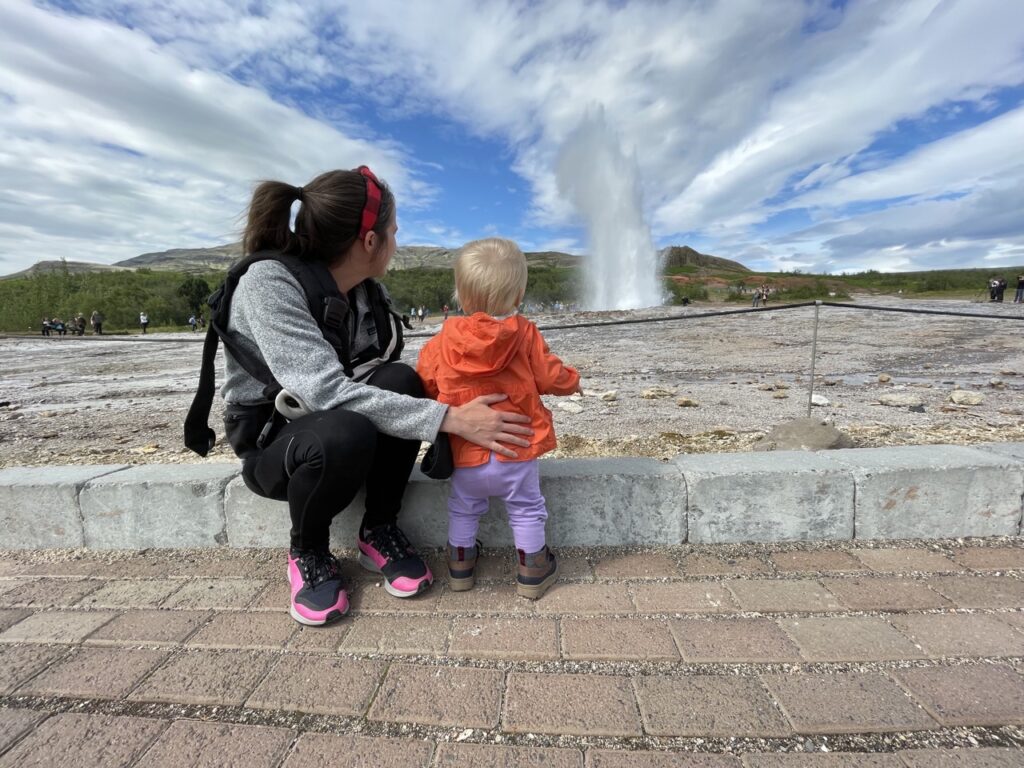
Geysir vs Geyser
Okay, time for a quick vocab lesson! I promise I have not been misspelling “geyser” as “geysir” so far in this post. Let’s take a quick dive into the etymology here.
- Geysir : Icelandic word meaning “the gusher”
- Great Geysir: The name given to a specific hot spring in Iceland that gushed water up from the ground – the first written account of this geological phenomenon
- Geyser : Generic English term for the geological phenomenon of a hot spring that gushes water up from the ground
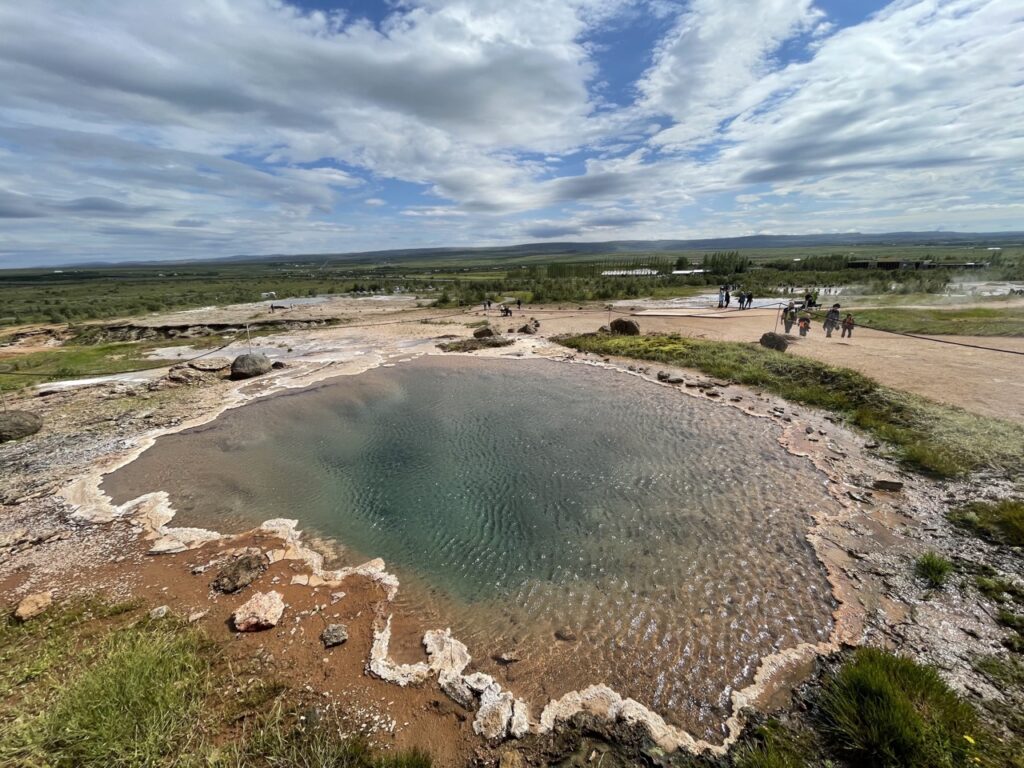
What you’ll commonly read is that the English word “geyser” is derived from the Icelandic word, “geysir,” meaning “to gush.” Sure, this is technically true, but it leaves out an interesting and important step in the middle.
The more accurate way to say this is that the English term “geyser” comes from the specific Icelandic hot spring named Great Geysir, which literally means “the gusher.”
The generic English term “geyser” wasn’t adopted because it meant “gushing.” The term was adopted from a specific gushing hot spring, Great Geysir, which the Icelandic people named after their own word for gushing (which actually came from the Old Norse word “geysa.”)
Am I the only one who thinks this difference matters? Cool, cool.
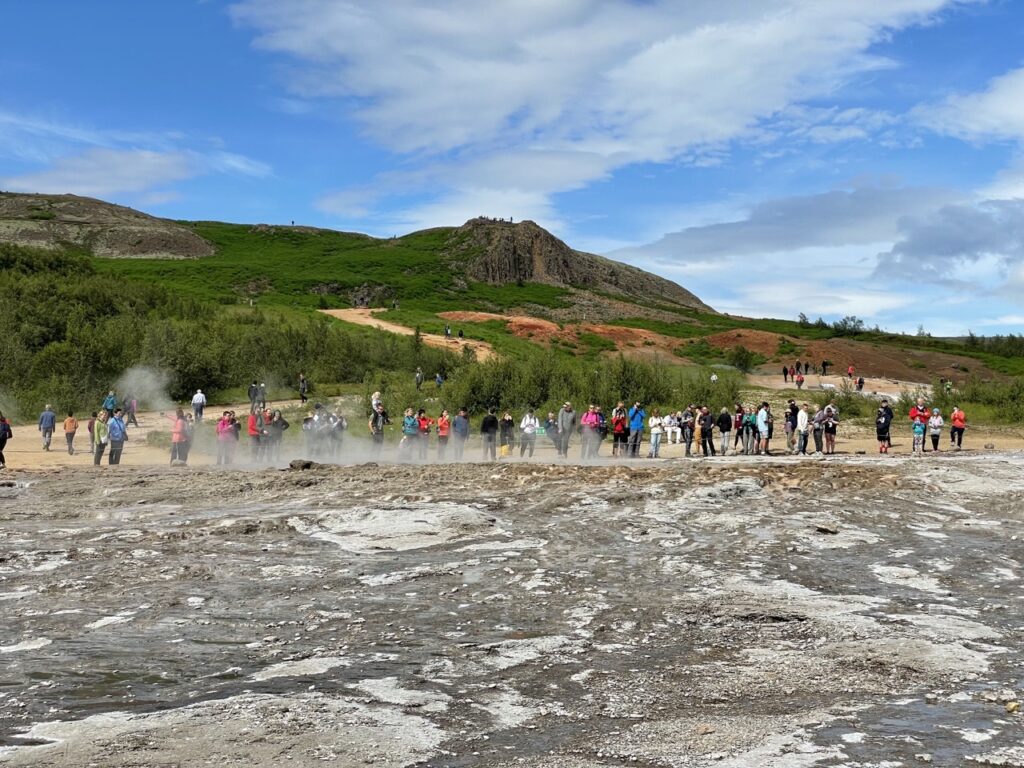
What’s actually important to note here is how I will use these terms in this post. As I’m an English speaker, I will use the term “geyser” when referring to the geological phenomenon. I will use the term “Geysir” as a shorter way to refer to the entire site of the Geysir Hot Spring Area.
The Geysir Hot Spring Area (Geysir) refers to a geologically active area in southwest Iceland. There are 30ish hot pools and small geysers in the area, but the main draw is the two largest geysers: Strokkur and Great Geysir.
Great Geysir is the namesake and most famous geyser at Geysir. It’s the first geyser ever documented in written history and has historically reached heights of 500+ feet. Today, Geysir is mostly dormant and eruptions are years apart.
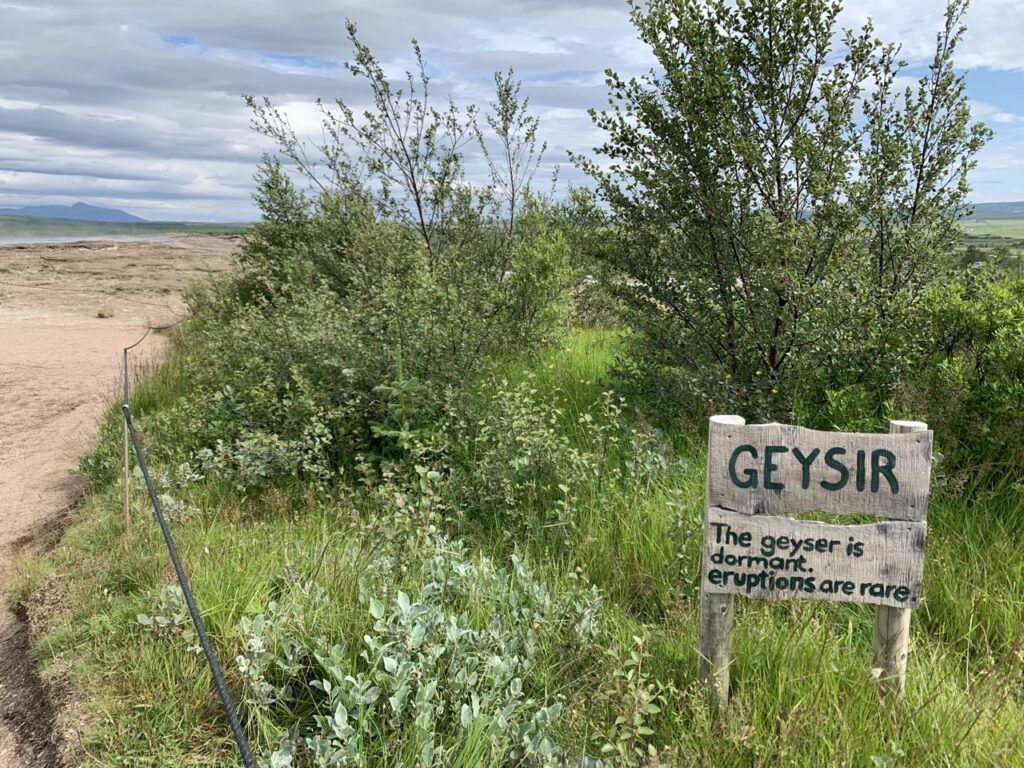
Strokkur is the most popular geyser at Geysir due to its frequent eruptions. Stokkur is the most active geyser in Iceland and erupts regularly, every 5-10 minutes, reaching heights of 50+ feet in the air.
In addition to the main geysers, there are several smaller hot springs and geysers in the area. You can see spouts of steam and streams of boiling hot water flowing throughout the area. The hot springs are visible from a protected brick pathway that cuts through the area and leads to the main geysers.
Plan your Visit to Geysir Hot Spring Area
Now that you’re clear on geysers and Geysir, let’s get to planning your visit. The nearby area has been built up for tourists, which makes it a really easy and pleasant stop. There is shopping, hotels, restaurants and more, all within walking distance from the main parking lot. Let’s dive in.
When to visit Geysir
Geysir Hot Spring area is open all year. When choosing your preferred season to visit, keep in mind that this attraction is all outdoors, meaning you will be exposed to the elements. As a reminder, Iceland has a temperate maritime climate, meaning it’s warm in the summer (May – October) and cold in the winter (November – April).
When choosing what season to visit, evaluate everything you want to do in Iceland during your trip. Other activities, like the Northern Lights (winter) or driving the full ring road (summer), will dictate your season more than Geysir will.
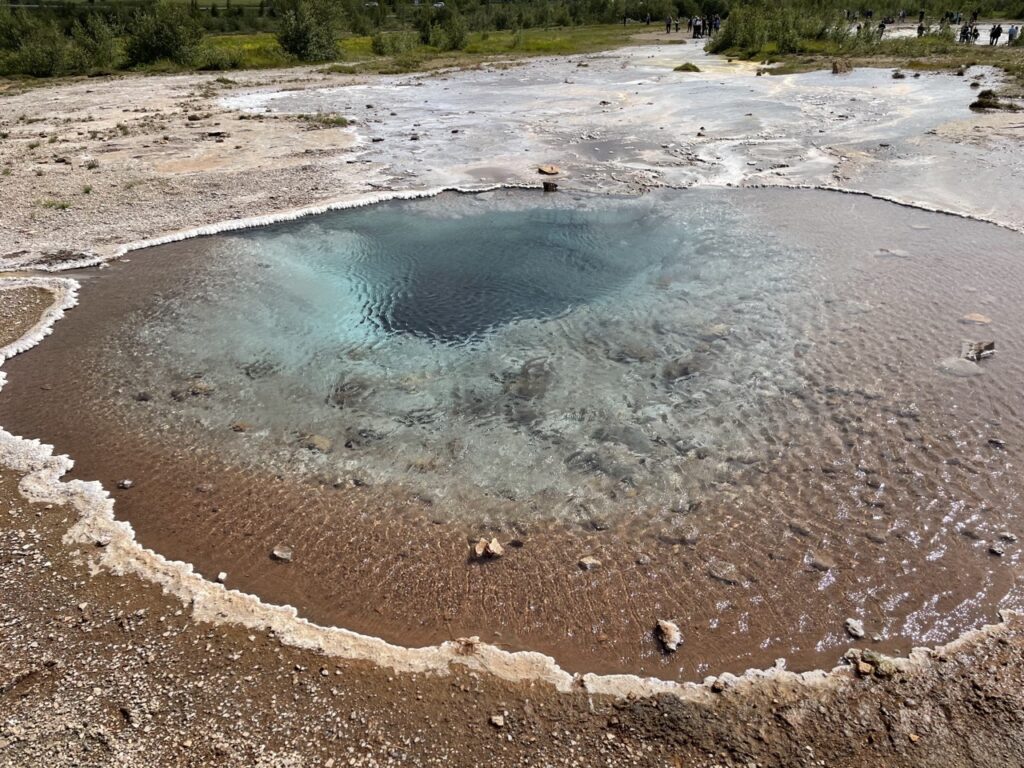
How to get to Geysir
Geysir Hot Spring Area is located about 65 miles east of Reykjavik.
It’s easy to get to via car, which takes about 90 minutes if you drive straight through. The route passes Thingvellir National Park at about halfway, which many people will choose to stop at.
There is free parking available at Geysir. The main, largest lot is located on the south/east side of Route 35. It takes about 6 minutes to walk from the parking lot toStrokkur, the active geyser.
Unfortunately you cannot get to Geysir Hot Spring Area by bus or public transit.
If you don’t want to or can’t rent a car to drive to Geysir, the other option is to visit with a tour group. Most of these tours will cover the full Golden Circle route and span a variety of activities and durations.
Amenities at Geysir
Across the street from the hot springs and adjacent to the main parking lot is a visitor center. There’s a gift shop, restaurants, and restrooms available. The amenities listed below are all available at the visitor center area.
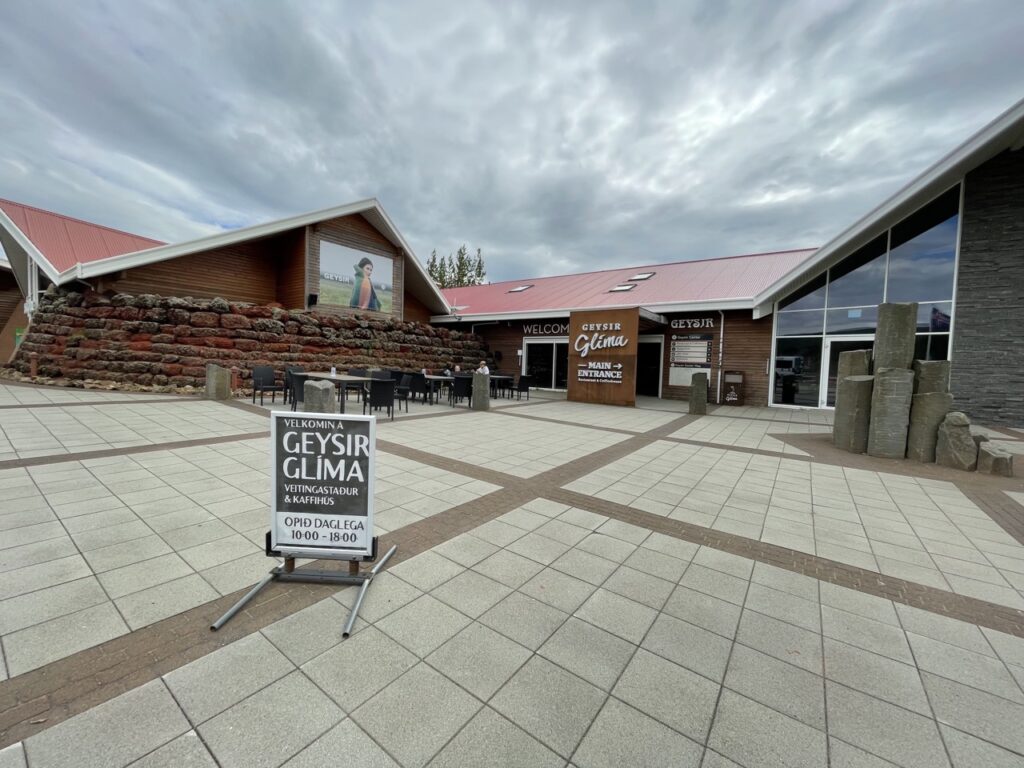
- Wifi : Yes, free wifi
- Bathrooms: Yes, bathrooms are available and free to use
- Souvenirs : Yes, lots. You can find everything from coffee mugs to traditional Icelandic sweaters for purchase in the gift shop.
- Parking : Yes, free parking
- Coffee : Yes, there is a coffee shop inside that serves coffee and hand-pulled espresso beverages.
- Food: Yes, a variety of food options, including vegetarian sandwiches, were available
- Dining Space: The tables for dining are located indoors. (Noting this due to the pandemic for people who may only want to dine outdoors.)
How much does it cost to visit Geysir
It is free to visit Geysir Hot Spring Area, including free parking.
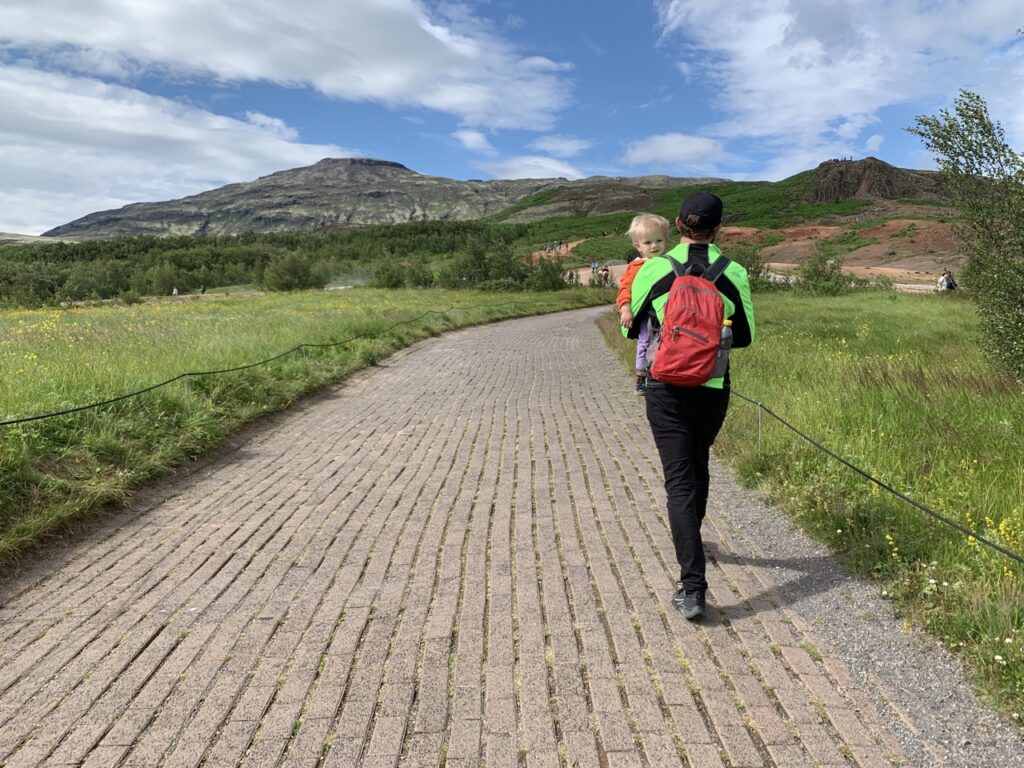
How Much Time to Spend at Geysir
We recommend spending 1.5 – 2 hours at Geysir Hot Spring Area. We’d break that up as one hour watching Strokkur geyser, 30 minutes exploring the rest of the hot springs and geysers, and then a flexible 30 minutes for amenities at the visitor center.
The active geyser, Strokkur, erupts every 5 – 10 minutes. We recommend staying for several eruptions, and changing your location between them for different views and angles. We think one hour watching the geyser is sufficient, though taking good photos may take longer.
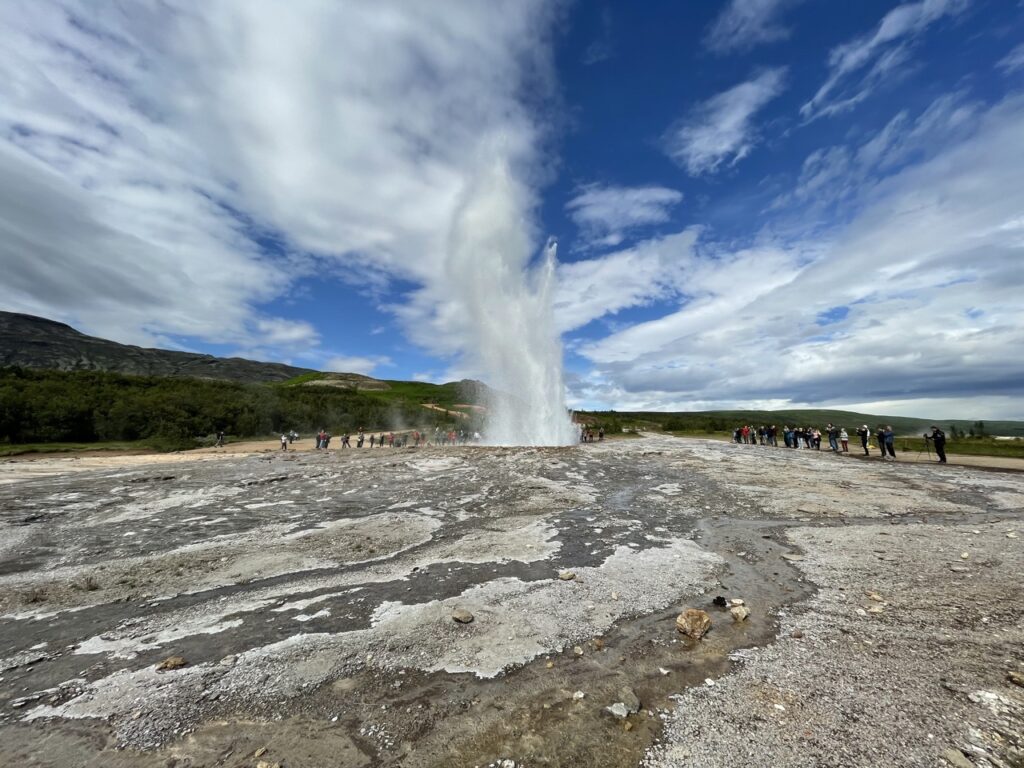
The walk from the parking lot to Strokkur goes through some of the hot springs and passes one of the smaller geysers. Then just past Strokkur, is Geysir. This famous geyser is mostly dormant, but is a pretty hot spring pool. There’s also a walking path to an elevated view of the geysers, which takes about 10 minutes.
All of these smaller attractions and walks will add up and likely take at least 30 minutes.
Lastly, you may want to plan a 30-minute buffer for a stop at the visitor center. The lines can get quite long for food during lunchtime, though. So if you want to eat there during busy times, it may take closer to an hour.
Geysir is actually a great spot to grab lunch if you’re doing the Golden Circle. Of the three main sights ( Thingvellir , Geysir and Gullfoss ), Geysir has the best food options in terms of quality, quantity of options and space to eat.

Where to stay at Geysir
There are places to stay at Geysir, but we recommend staying in Reykjavik . You will have far better choices and prices for accommodations in Reykjavik than in Geysir. Since it’s only a 90 minute drive, Geysir is an easy day trip from Reykjavik.
Geysir is also the second stop on the Golden Circle , which is the most popular tourist route in Iceland. Most visitors will move on from Geysir to their next stop, Gullfoss waterfall.
However, if you do want to stay in Geysir, you have some options.
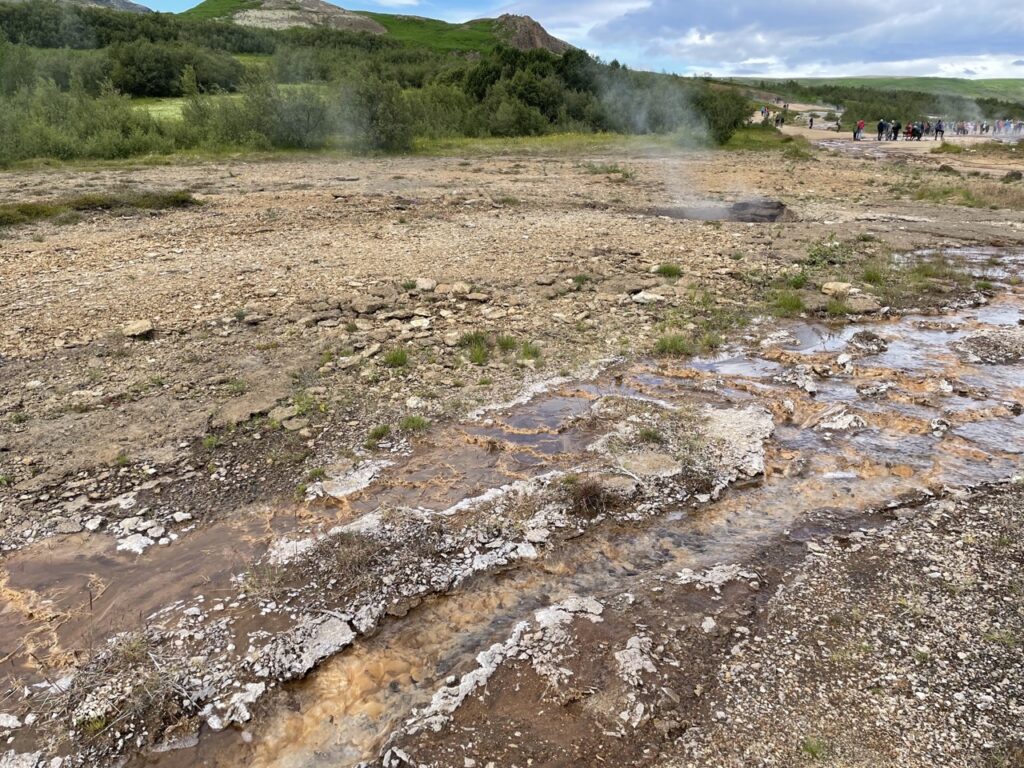
There are two hotels, Hotel Geysir and Litli Geysir Hotel, located across the street from the hot springs and adjacent to the visitor center. These hotels will cost between $150 and $250 USD per night, depending on when and how you book.
There is also a full-service campground across the street from the visitor center and just south of the hot springs. Tent camping and RV / van camping is allowed. Camping costs 1800 ISK ($14 USD) per night for adults and 500 ISK ($4 USD) for children 8-15. Children 7 and under are free. Reservations for camping are not required and you simply pay at the service house when you arrive.
Safety at Geysir Hot Spring Area
Geysers and hot springs are formed by geothermal activity. Magma under the earth’s crust heats rocks near the surface, which heat the groundwater. The hot water is forced up, and depending on the pressure and general underground structure, results in hot springs (pools of naturally hot water) or geysers (forceful bursts of water and steam from the ground).
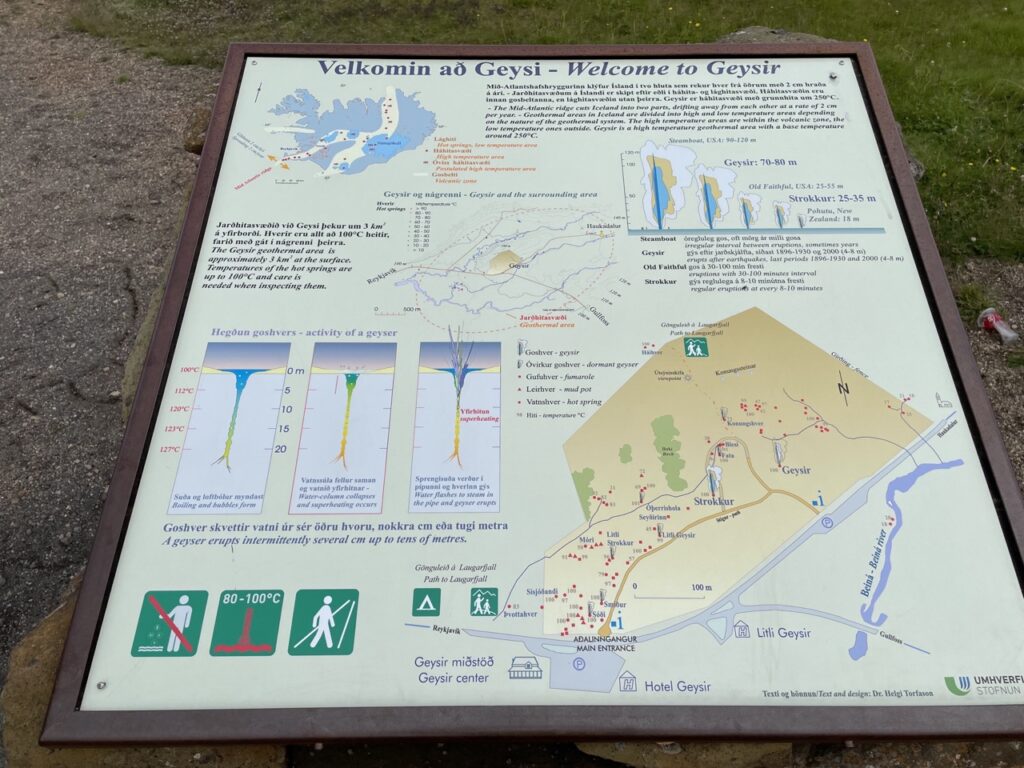
Some hot springs in Iceland are safe to swim in, but Geysir Hot Spring Area is not one of them. The water that bubbles above the ground and fills the hot springs at Geysir is extremely hot — 175°F – 215°F. It’s so hot that it would burn your hand immediately if you were to touch it. (And as a nearby sign will tell you, the nearest hospital is 62 km away which would make for a long, painful journey.)
Sidebar : I personally have had a carafe of 185°F (ish) coffee spilled on my foot, and let me tell you, it is absolutely awful. I’ve had a child, and I think that burn was more painful. Do. Not. Touch. The. Water .
I don’t say this to scare you, but to remind you to respect the nature at work here. Fortunately, the Geysir area is designed for tourists and is generally safe as long as you follow safety protocols.
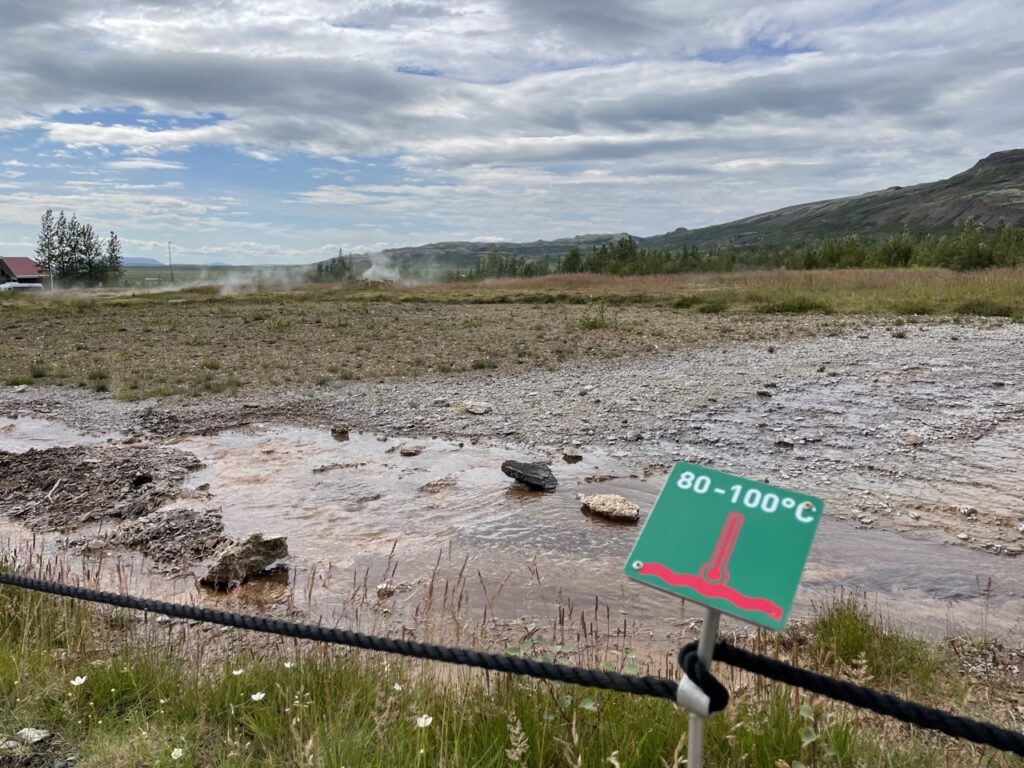
Safety Tips for Geysir Hot Spring Area
- Stay on the protected paths . The walking paths are clearly marked and roped off from the dangerous areas. Do not cross or reach over the ropes for any reason.
- Don’t touch the water. It’s so tempting to see the stream and want to check how hot it us. DON’T DO IT. It’s almost 200°F and will burn you immediately. You don’t have to confirm.
- Stay outside of the Strokkur splash zone . The area around the active geyser is roped off. This is to protect spectators from the geyser and the geyser from spectators. Do not cross the rope. You may still get wet outside the rope, depending on the wind and where you’re standing, but it will not burn you. The water actually cools extremely quickly after it’s expelled from the earth.
- Keep children close . As a parent of a fast and wobbly toddler, this is top of mind for me. The hot springs are roped off, but a child could slip under the rope in no time and that is terrifying. If you have a runner, be sure to hold them or keep them in a carrier while walking through the hot spring area. Near Stokkur, theres much more room to let them walk around safely.
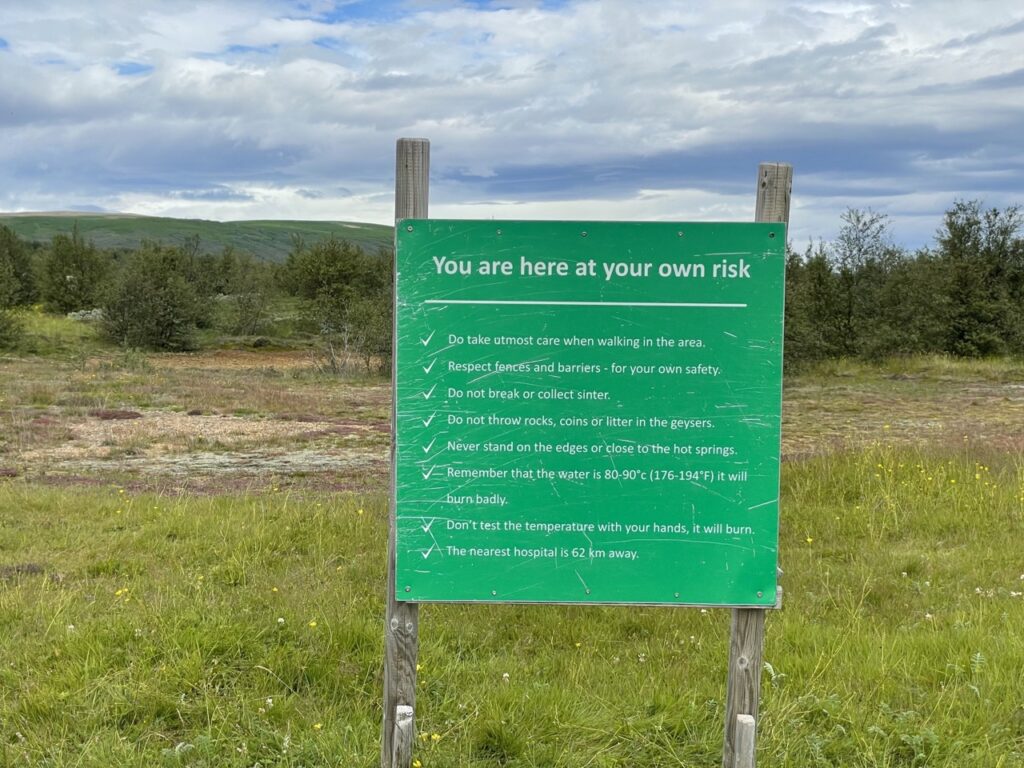
Get Ready for your Visit to Geysir Hot Spring Area
With the logistics out of the way, it’s time to get ready for your visit! Here are a few things to know before you go to Geysir.
Tips for Visiting Geysir
- Change up your view point. There is 360 viewing of Strokkur geyser. Consider making your way all the way around it, watching the geyser erupt from different angles and lightening.
- Turn on Live Photo. If you have an iPhone, be sure Live Photo is on. This will help to capture more of the eruption with each click of the camera. Then you can select the perfect frame later.
- Set a timer. Strokkur erupts every 5 – 10 minutes, but you never know when it’s coming. Set a timer for 5 minutes after the last eruption and then glue your eyes and camera to the geyser so you don’t miss it.
- Get a treat first . The visitor center sells ice cream, coffee and other snacks. Consider picking up one of these items and bringing it to Strokkur. Grab a seat on the side and enjoy your snack while casually watching the geyser erupt in the background. It’s so much better than drinking your coffee in the parking lot or eating in the cafeteria.
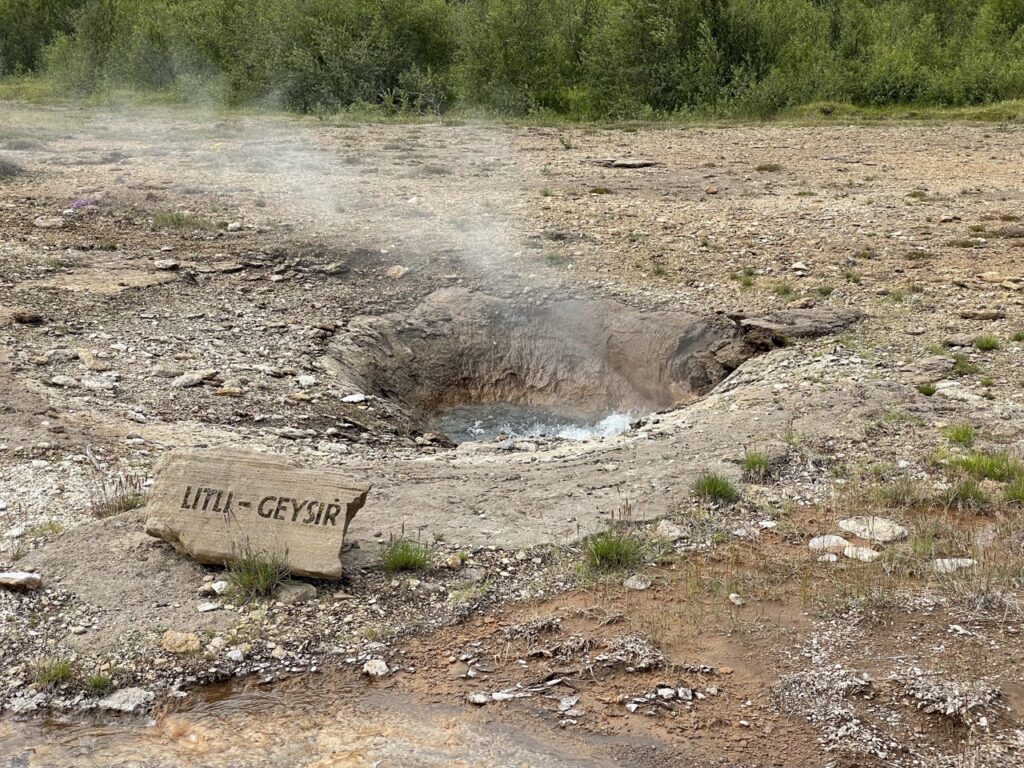
What to Wear to Geysir
Geysir Hot Spring Area is an outdoor activity. There is no protection from the sun or rain, so dress for the weather and elements. Generally speaking, since it’s a shorter stop, most people will not need any specific gear or extra attire to visit Geysir.
In the summer months, light layers are key. We recommend a long sleeve base layer with built in UPF, even if it’s warm. Then layer on a light jacket or fleece. If you only have room for one jacket, make sure you choose one that’s water resistant .
If you’re visiting in the winter, bundle up as temperature dictates. The paths can be slippery when covered in snow and ice, so boots or shoes with good traction are super important.
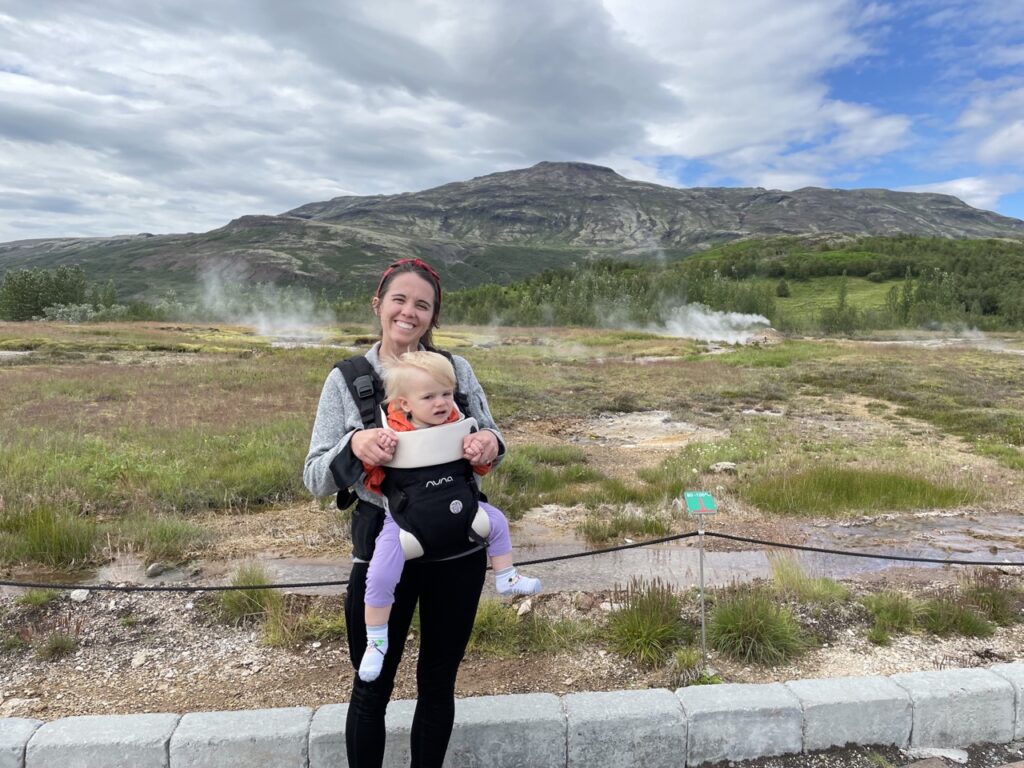
What to bring to Geysir
In additional to the clothes on your back, there are a few more things we recommend bringing with you. Also be sure to check our minimalist Iceland packing list to help get ready for your whole trip.
- Texting Gloves : If you’re visiting in the winter, definitely bring texting gloves ! You will want to have your phone or camera out and ready for most of the time you’re at the geyser. These gloves will allow you to keep your hands warm and take photos at the same time.
- Baby Carrier: Parents of small children will want to pack a baby carrier. While some paths are brick, much of the area is rocky gravel and not idea for strollers. We used the Nuna CUDL carrier. We also have a separate post dedicated to baby wearing for travel , which includes lots of tips and reviews of our favorite baby carriers.
Conclusions
The Geysir Hot Spring Area is a great place to watch the immense forces of the nature at play. As someone who has never seen an active geyser before, I found this to be an incredible experience. If you’re visiting Iceland, you can’t miss a Golden Circle road trip with a stop at Geysir Hot Spring Area.
We hope you found this guide useful in planning to visit to Geysir. If there’s anything we missed, let us know in the comments! Whether you’re in Iceland now or planning your dream trip, we hope you have an amazing adventure.
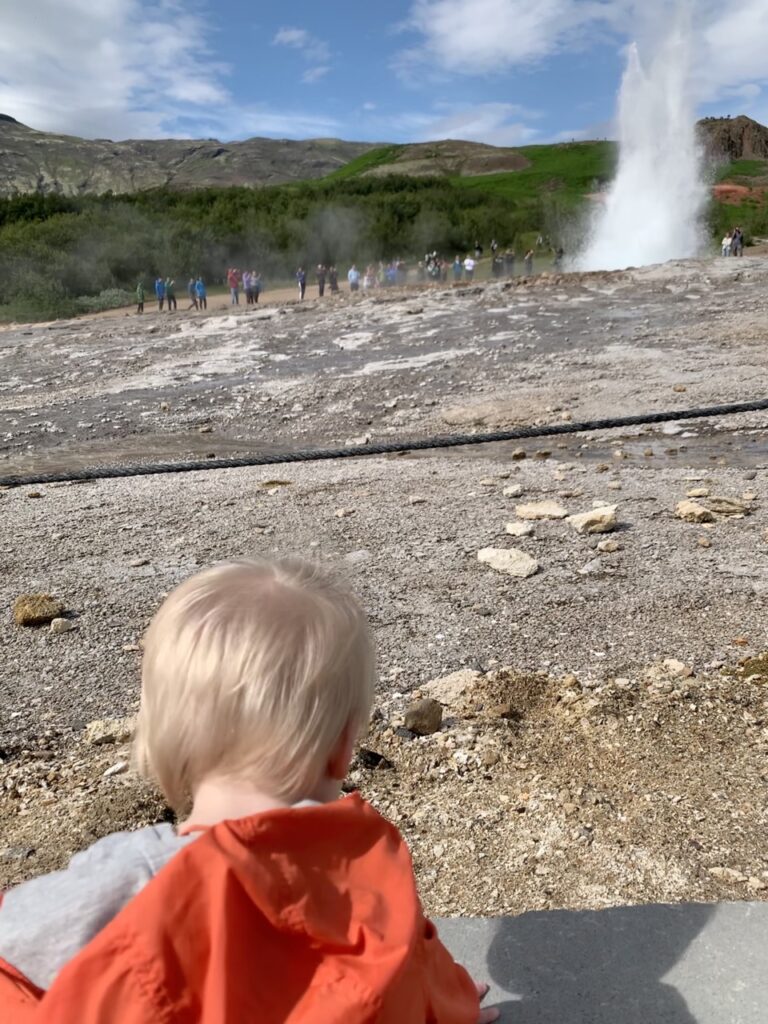
Our Full Iceland Itinerary
Planning a trip to Iceland? Here’s a look at our full itinerary for this trip…
- Minimalist Iceland Summer Packing List (That Fits in One Carry-On!)
- Detailed 3-Day Reykjavik Itinerary with Walking Routes
- Reykjavik City Guide – Everything to Know About Iceland’s Capital City
- Whale Watching in Reykjavík with Special Tours
- Planning Guide: Self-Drive the Golden Circle in Iceland
- Guide to Thingvellir National Park in Iceland
- Guide to Gullfoss Waterfall in Iceland
- Guide to Iceland’s Geysir Hot Spring Area
- A Perfect Visit to Seljalandsfoss Waterfall + Bonus Hidden Waterfall
- Planning Guide: Skogafoss Waterfall in Iceland
- Guide to Dyrhólaey Nature Reserve on Iceland’s Southern Coast
- Complete Guide to Vik, Iceland
- Guide to Reynisfjara Black Sand Beach in Iceland
- Guide to Jökulsárlón, Iceland’s Glacier Lagoon
Tuesday 26th of July 2022
Followed your blog step by step and had a fabulous day. Thanks!!!!
Wednesday 27th of July 2022
This makes me so happy! I'm so glad to hear it was helpful and you had a great day!
How to Plan a Family Summer Vacation to Iceland - Mommy Levy
Wednesday 27th of April 2022
[…] also known as hot springs, are Iceland’s major tourist attractions. The most famous and active geysers are located on the southern side of Iceland. The most active and visited geyser is Strokkur. […]
Iceland's Geysir Geothermal Field: The Complete Guide
:max_bytes(150000):strip_icc():format(webp)/1_ErikaOwen-600x900-5bb3bec6c9e77c00260f18c6.jpg)
Roc Canals Photography /Getty
Geysir Parking
The waterfalls may get the most hype when it comes to Iceland , but there’s another natural phenomenon that will have you just as awestruck: geysirs. A physical representation of the tensions happening underneath our feet, geysirs can be found all around the Land of Fire and Ice. If you’re looking to find a field full of them, head to the Geothermal Field. Here, you’ll find the simply named Geysir, the king (or queen) of all geysirs in the country with its reliable spout of boiling-hot water.
Located in Haukadalur, the field is nestled into an area called the Southern lowlands — it’s also where you’ll find a neovolcanic zone, in other words, a place with regular volcanic activity. (Remember: Volcanic activity can refer to more than just massive eruptions that we’re used to seeing in movies.)
The Geysir Geothermal Field is a must-see for anyone visiting Iceland. Although touristy, it’s such a beautiful reminder that there’s a lot going on right underneath our feet. Ahead, you’ll find everything you need to know, from planning your trip to seeing all there is to see.
The springs of water housing the main Geysir and the smaller Marteinslaug and Gufubadshver springs are evidence of a much larger body of water that used to exist in this area. You can still see the outlines of an ancient basin that used to cover much of the field, but the remaining springs of water are believed to be the oldest. If you look carefully — and you’re lucky — you may even find plant fossils in the area. The earliest account of Geysir dates back to 1294, but the water flow eventually tapered off due to the movement of the tectonic plates in the area. In 2000, it was back in action after nearby earthquakes sparked new movement.
The Geysir Geothermal Field is considered part of the neovolcanic region, meaning there is a form of volcanic activity happening, but not in the traditional sense. In other words, you won’t be seeing any volcanoes shooting spouts of lava into the air here. But the water you do see shooting into the air has been heated from deep within the Earth, making it a part of a volcanic system.
According to Extreme Iceland , you can find very physical evidence of this area’s importance in history: Konungasteinar, or three stones that house the initials of three kings who have ruled Iceland and visited Geysir (Christian IX in 1874, Frederik VIII in 1907, and Christian X in 1921).
What to See and Do
Visiting the Geysir Geothermal Field is about one thing: Seeing a lot of water catapulted into the air from small holes in the ground. It’s just as majestic as you would think, especially if you’re not expecting it. While you can find other places around Iceland with bubbling basins of water, this is one of the most impressive. It’s home to the aforementioned Geysir, which sends boiling water flying up to 100 feet in the air every 10 minutes or so. You’ll also find Strokkur in the same field, which shoots water upwards of 32 feet in the air every 15 minutes.
You can visit the Konungasteinar stones, as well — there’s a pathway that will take you to them from a panoramic viewing area in the field (there’s a map at the entrance that will mark out points of interest).
What to Expect
Expect lots and lots of people. Given Geysir’s location on the Golden Circle , tour buses visit this area every day and even more people take advantage of the easy driving from Reykjavik to take a day trip out of the city. If you want to avoid the largest crowds, come early in the morning (think: 8 a.m.) or later at night (go as late as possible during the summer months and take advantage of the Midnight Sun).
There are clear walkways and a large map at the entrance which not only points out where you can find Geysir and Strokkur, but also the science behind the natural wonders. Be careful if you’re going right after or while it’s raining: The area can get quite muddy and there are some steep walks to the panoramic view.
How to Get There
It’s very easy to get to the Geysir Geothermal Field from Reykjavik. By car, it’ll take you about an hour and 45 minutes along Þjóðvegur 1. The drive time is worth it: You can check out Geysir, Gullfoss, and Silfra Fissure all in the same afternoon. If driving on your own isn’t part of your plan, there are plenty of tour operators that offer Golden Circle bus tours. I recommend checking out the Golden Circle and Silfra Diving experience from Iceland Adventure Tours if you’re looking to take in all of the sights and do something a bit adventurous with your day.
Iceland's Golden Circle: The Complete Guide
Thingvellir National Park: The Complete Guide
The Top 22 Things to Do in Iceland
The Best Day Trips From Reykjavik
The Top 10 Places to Visit in Iceland
The 10 Best Things to Do in Iceland During the Winter
Best Blue Lagoon Tours in Iceland
Your Trip to Iceland: The Complete Guide
Weather in Iceland: Climate, Seasons, and Average Monthly Temperature
18 Most Beautiful Islands in the World
Yellowstone National Park: The Complete Guide
The Top Waterfalls to Visit in Iceland
Reykjadalur Hot Springs: The Complete Guide
The 20 Best Hot Springs Destinations in the World
Landmannalaugar: The Complete Guide to Iceland's Central Highlands
The Best 10 Hikes in Iceland
- Insider Tips & Exclusive Offers Sign Up
- Customer Support & FAQ ISK USD EUR GBP Currency: € EUR
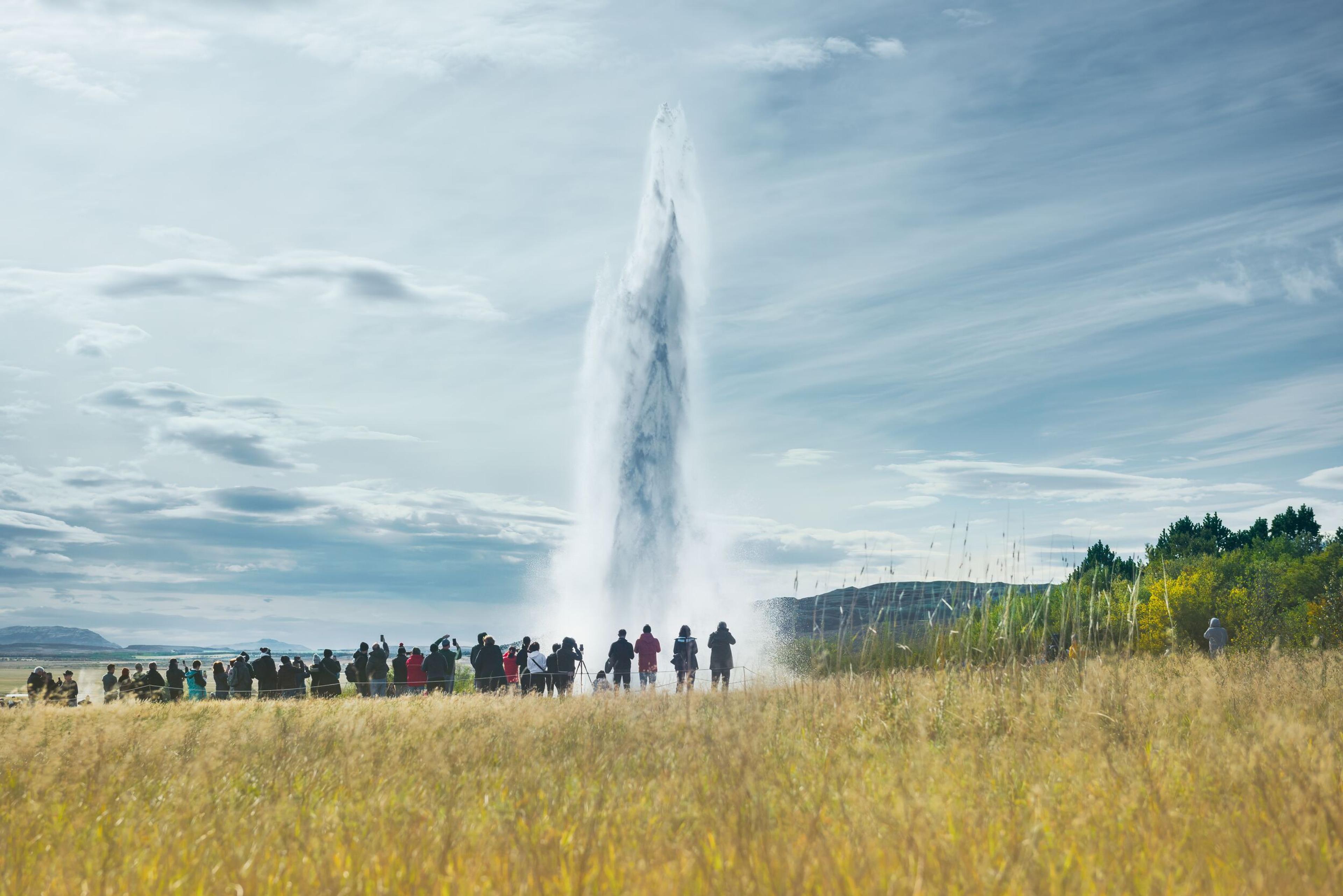
Related tours
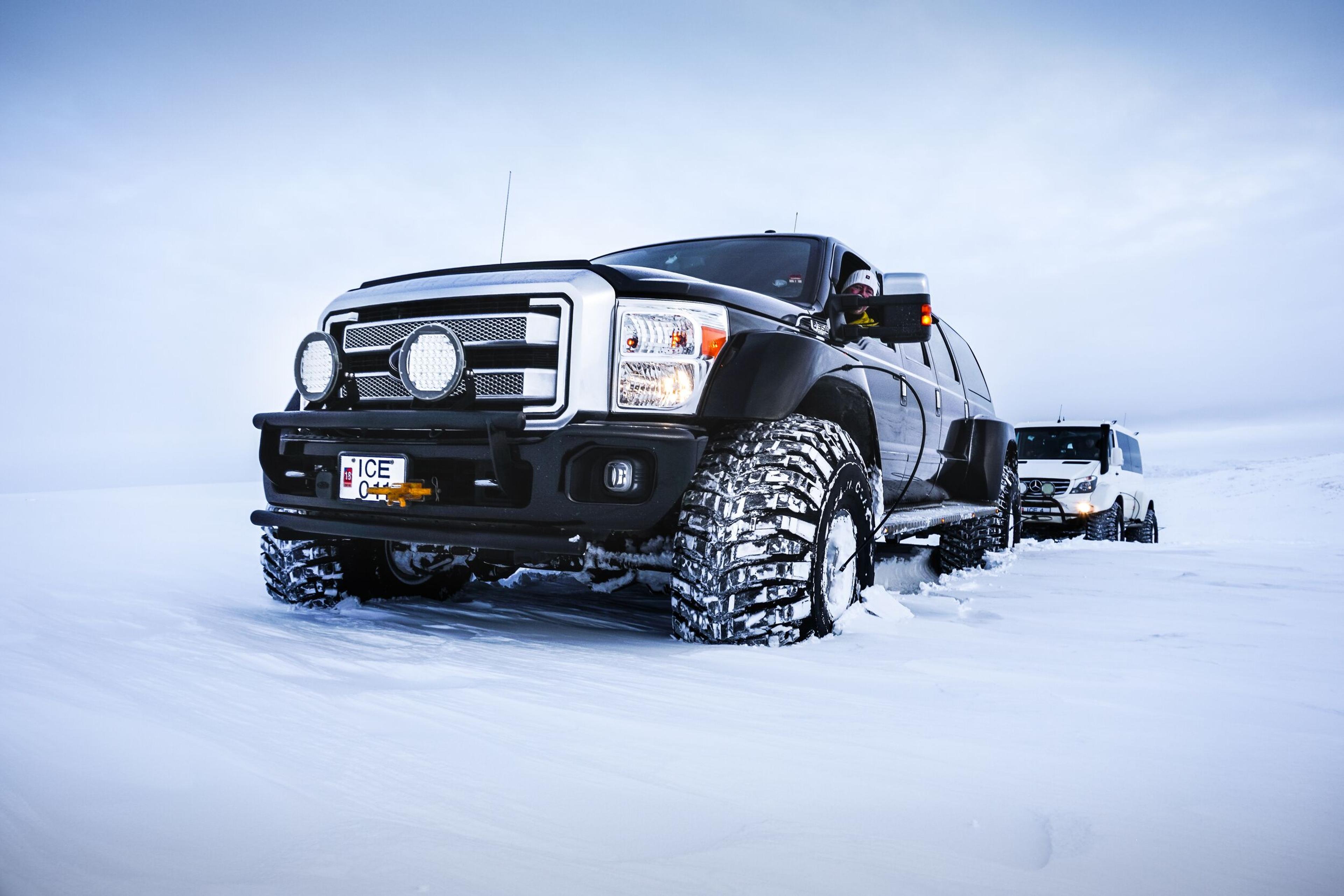
Golden Circle and Glacier Super Jeep Tour
Experience the iconic Golden Circle of Iceland in unparalleled style and comfort with our luxury Super Jeep tour. Perfect for families, friends, or solo explorers, this adventure takes you off the traditional paths and into the heart of Iceland’s breathtaking landscapes, including a snowmobile ride across the majestic Langjökull, Iceland’s second-largest glacier.
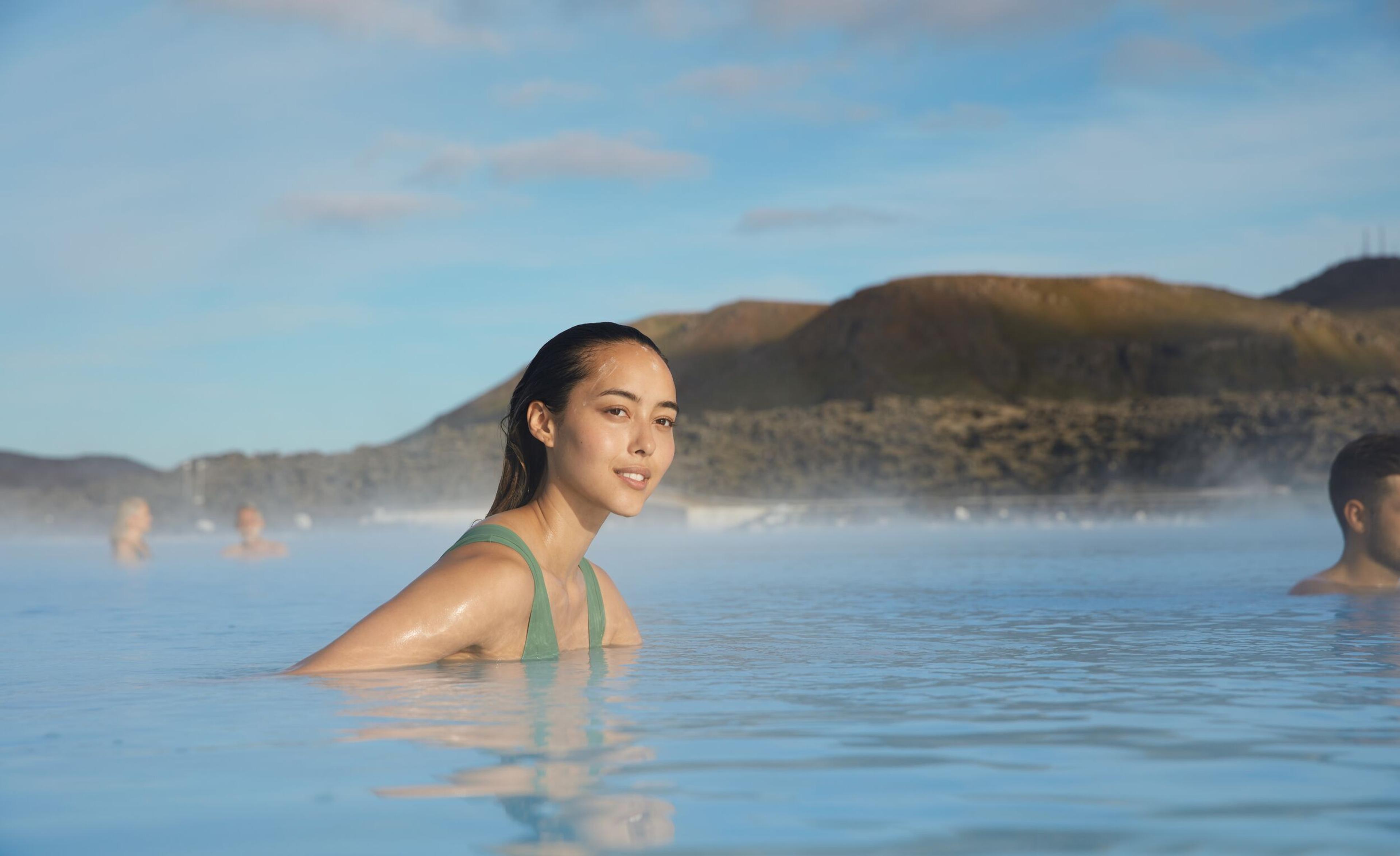
Golden Circle & Blue Lagoon
Experience the best of Iceland with this package of two of the island’s most popular tours in one day! The Golden Circle encompasses the must-see sights of Þingvellir National Park, the golden Gullfoss waterfall, and the bubbling geothermal region of Geysir. After touring the landmarks, soak in the milky blue healing water of the Blue Lagoon.

The Golden Circle & Friðheimar Greenhouse
This best-selling tour of Iceland’s most famous south Iceland landmarks includes a visit to Friðheimar Greenhouse. The Golden Circle encompasses the must-see sights of Þingvellir National Park, the golden Gullfoss waterfall, and the bubbling geothermal region of Geysir. Experience the classic Golden Circle landmarks with a sustainable twist, a stop at Friðheimar!
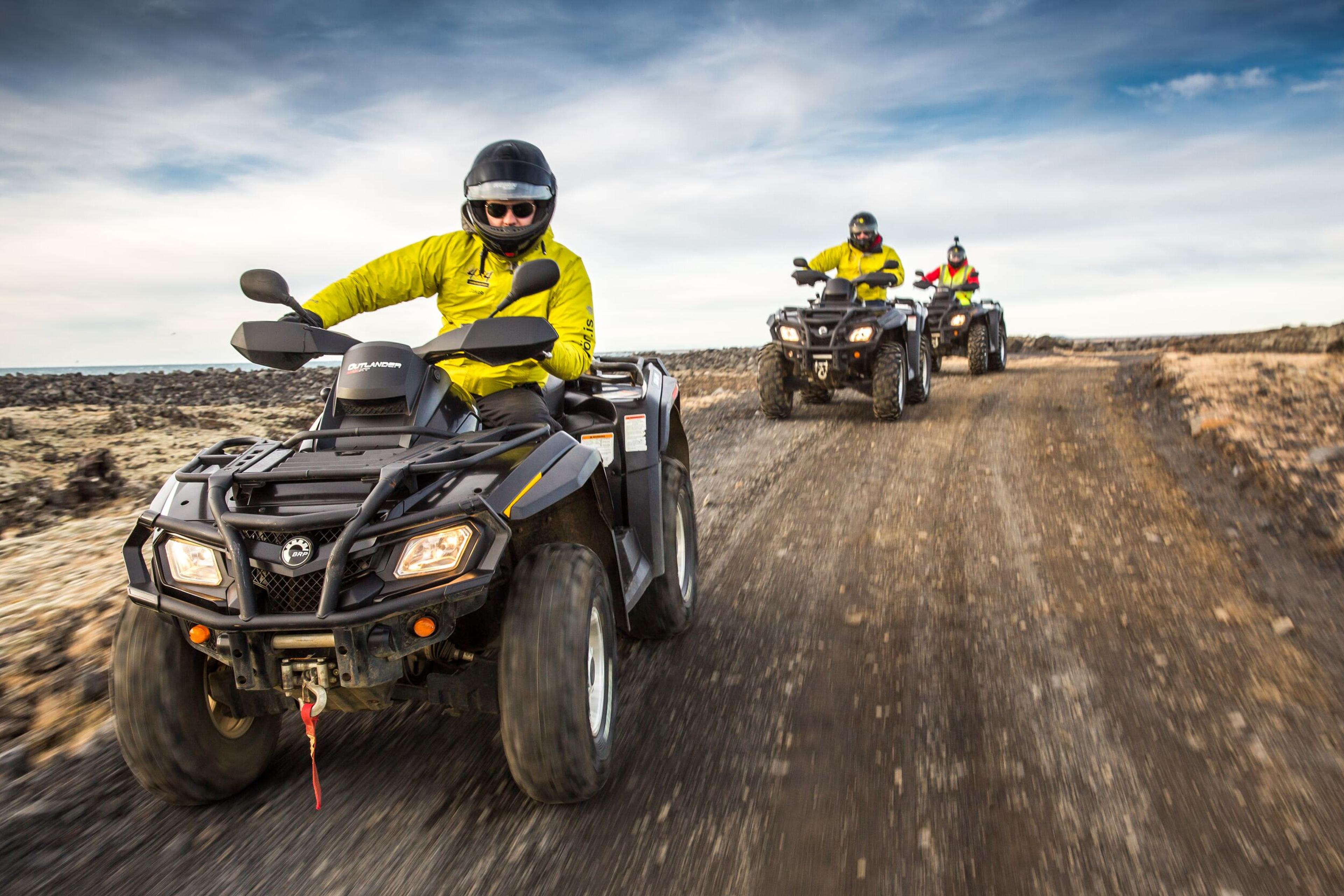
ATV & Golden Circle
Join us for an unforgettable adventure with our ATV Quad Bike and Golden Circle combo tour! Experience the thrill of riding through diverse terrains on an ATV, followed by a journey to iconic Icelandic landmarks. Get ready for an exhilarating day of exploration and discovery!
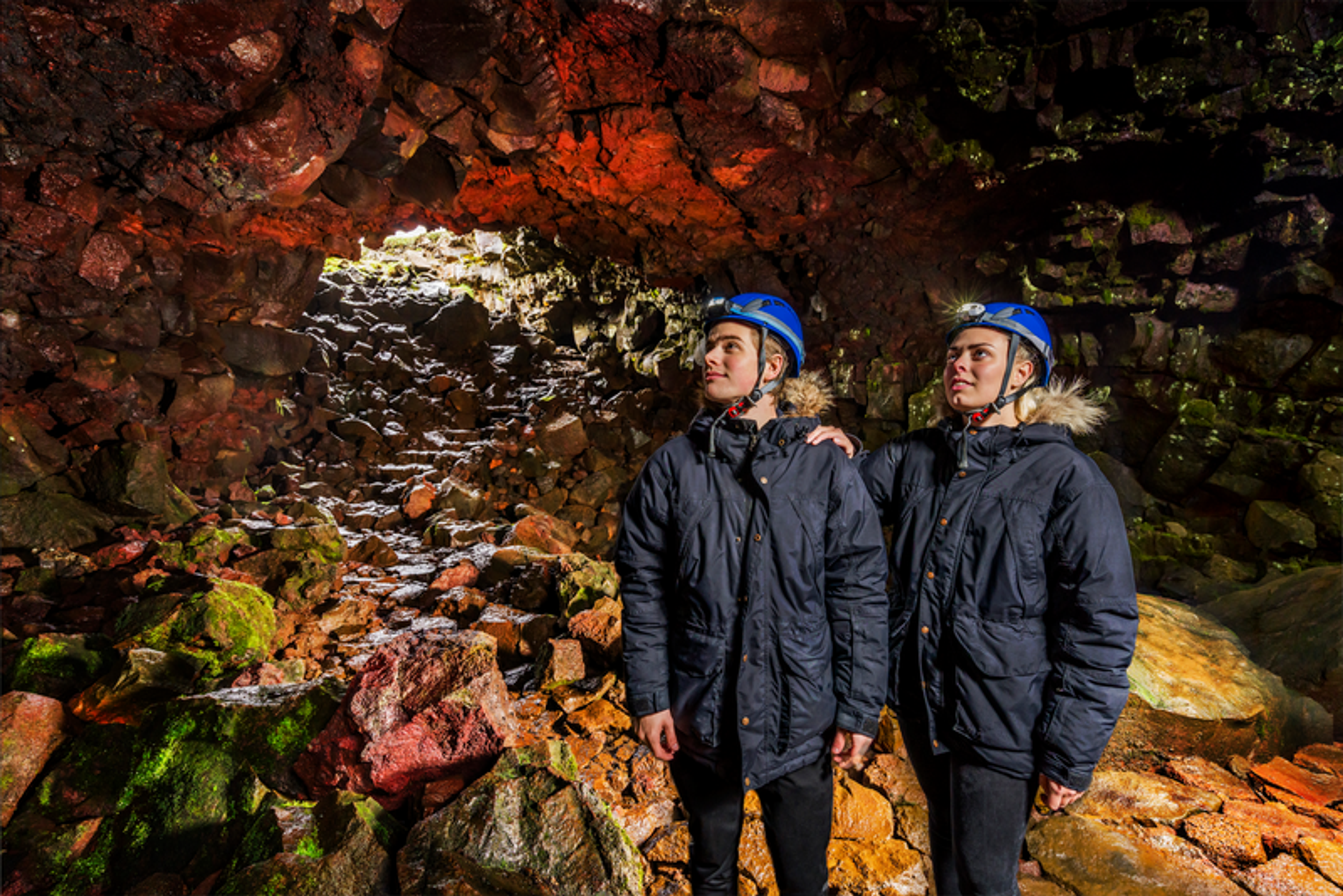
Golden Circle & Lava Tunnel - Combo Deal
Nature, culture, and history prevail in this combination tour, which takes you to the sites of the Golden Circle and inside the Lava Tunnel Raufarhólshellir cave. Experience a new world of Iceland's natural wonders -- Gullfoss waterfall, the Geysir geothermal region, Þingvellir National Park and the raw beauty of a lava tunnel. This is an easy, guided tour with no caving experience required.

Hiking, Hot Springs and Northern Lights
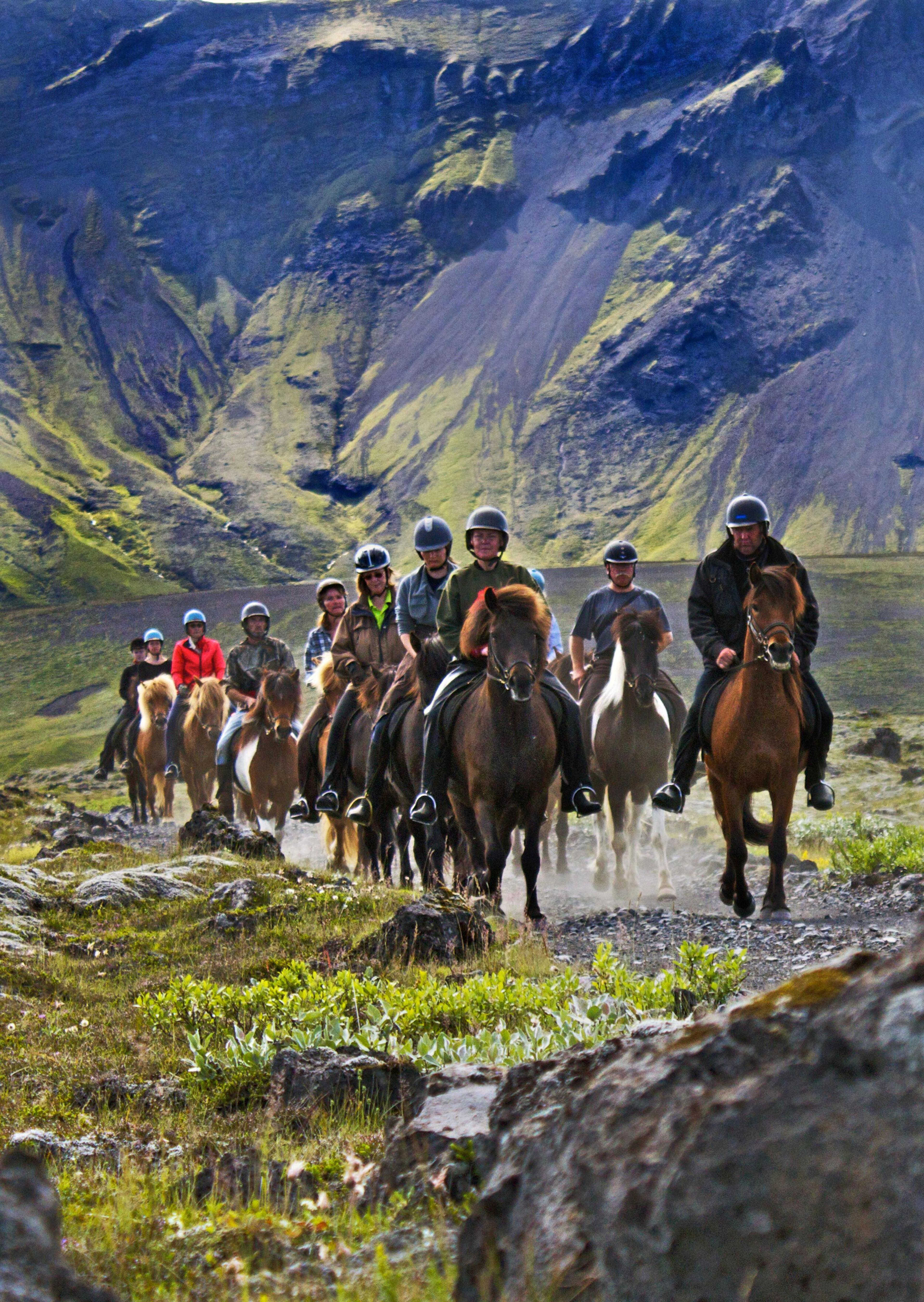
Horse Riding & Golden Circle
Join us on our Golden Circle & Horse Riding tour, where you'll immerse yourself in Iceland's stunning landscapes on horseback. Discover the wonders of the Golden Circle and the unique charm of Icelandic horses in one unforgettable adventure!
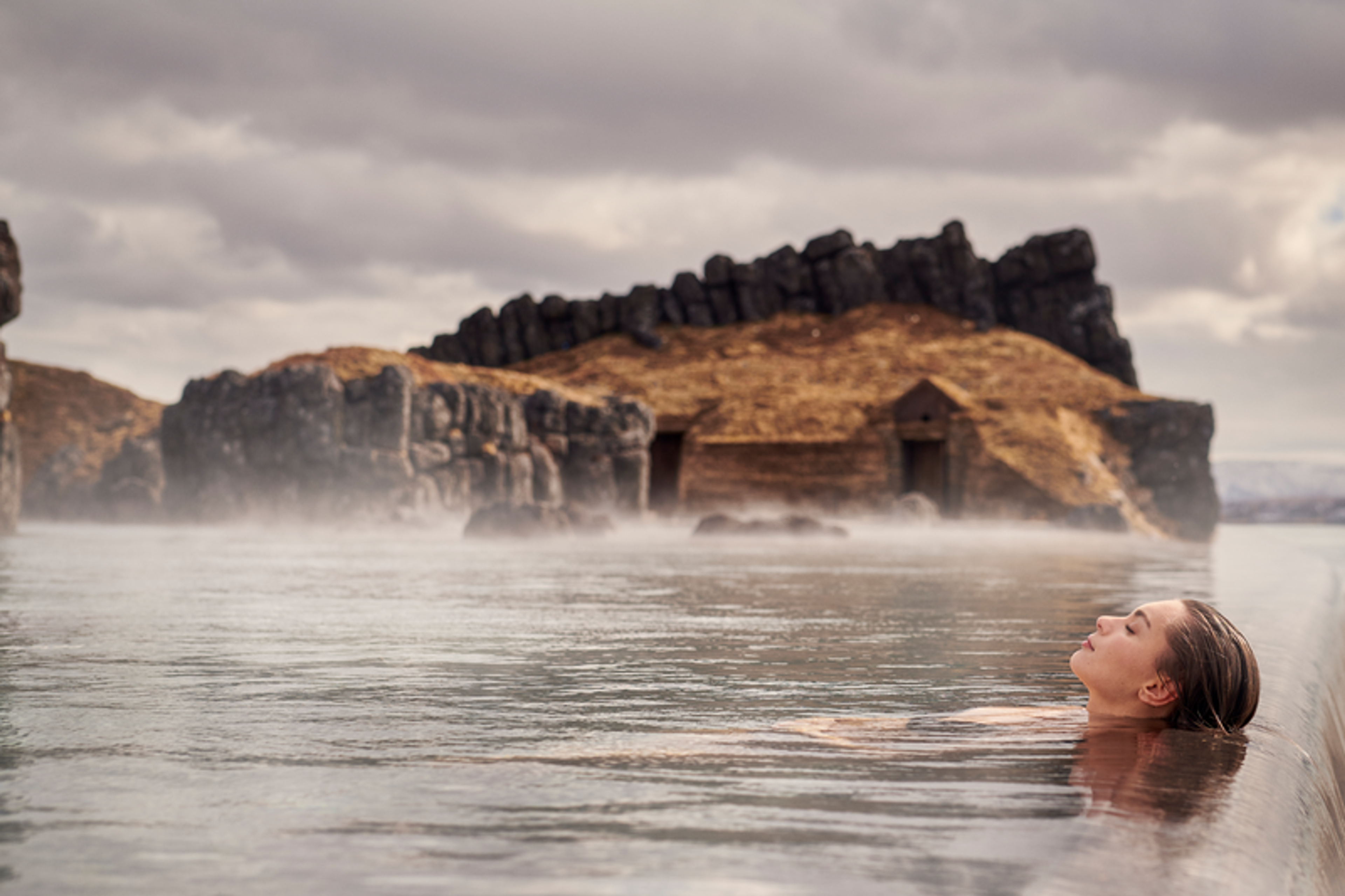
Golden Circle & Sky Lagoon
Plan for a fantastic day of seeing the classic Golden Circle landmarks capped off with a visit to the dreamy Sky Lagoon! The Golden Circle encompasses the must-see sights of Þingvellir National Park, the golden Gullfoss waterfall, and the bubbling geothermal region of Geysir. After touring the sights, relax at Reykjavík’s newest luxury bathing experience, the Sky Lagoon.

The Golden Circle & Fontana Wellness
Experience the classic Golden Circle landmarks before heading to the healing Fontana Wellness facilities! The Golden Circle encompasses the must-see sights of Thingvellir National Park, the golden Gullfoss waterfall, and the bubbling geothermal region of Geysir. Cap off your sightseeing day with a healing visit to Fontana Wellness.
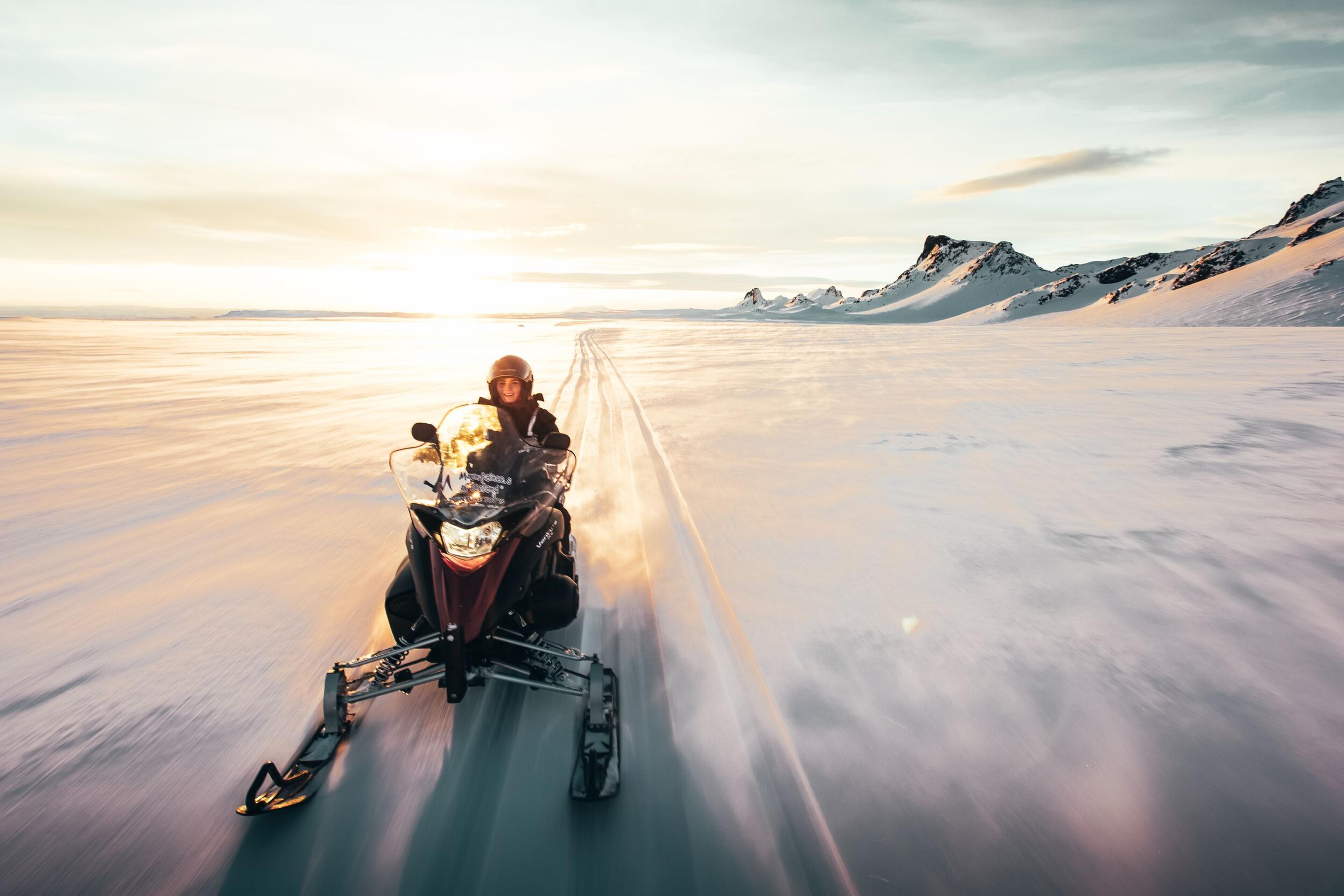
Golden Circle & Glacier Snowmobiling
Experience the landmarks of the classic Golden Circle in South Iceland with an exciting snowmobile ride on this unforgettable day tour. The Golden Circle encompasses the must-see sights of Þingvellir National Park, the golden Gullfoss waterfall, and the bubbling geothermal region of Geysir. Cap off your sightseeing adventure with a thrilling snowmobile ride on Langjökull glacier!

The Golden Circle & Northern Lights - Combo Deal
Want to see the sites of the Golden Circle and hunt for the northern lights but have a limited amount of time? Consider this express Golden Circle/Northern Lights tour! Experience the landmarks of the classic Golden Circle in South Iceland on this unforgettable day tour. The Golden Circle encompasses the must-see sights of Thingvellir National Park, the golden Gullfoss waterfall, and the bubbling geothermal region of Geysir. After your return to Reykjavík, a guide will lead you on a search for the elusive northern lights!
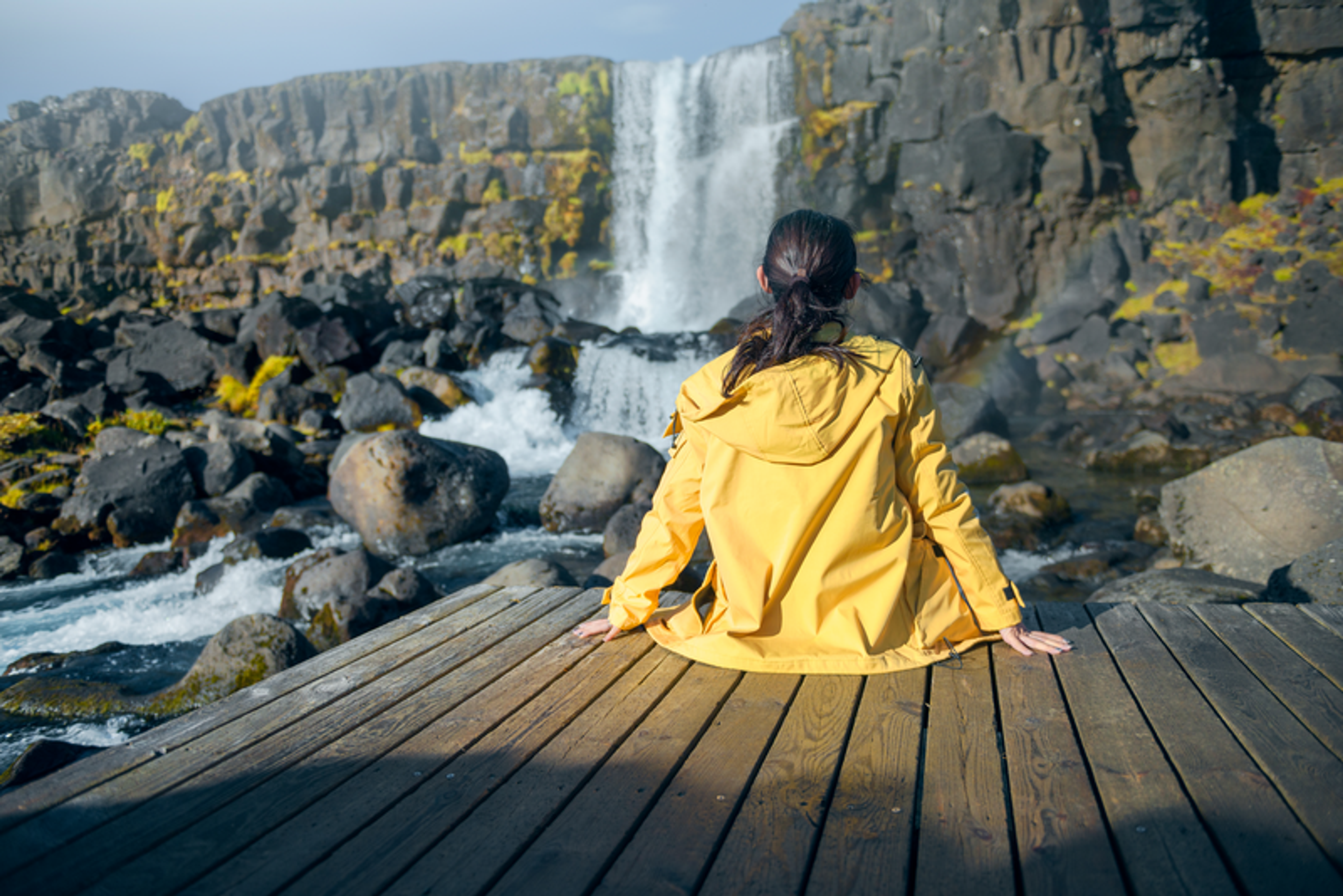
The Golden Circle & Hop On Hop Off - Combo Deal
Experience the best of Iceland's natural wonders and the charm of its capital city with our Golden Circle & City Sightseeing combo. This tour combines an insightful 8-hour journey through the iconic Golden Circle, with a visit to the Fridheimar Tomato Greenhouse along the way, and additionally, the flexibility of exploring Reykjavík at your own pace on the Hop On Hop Off bus.
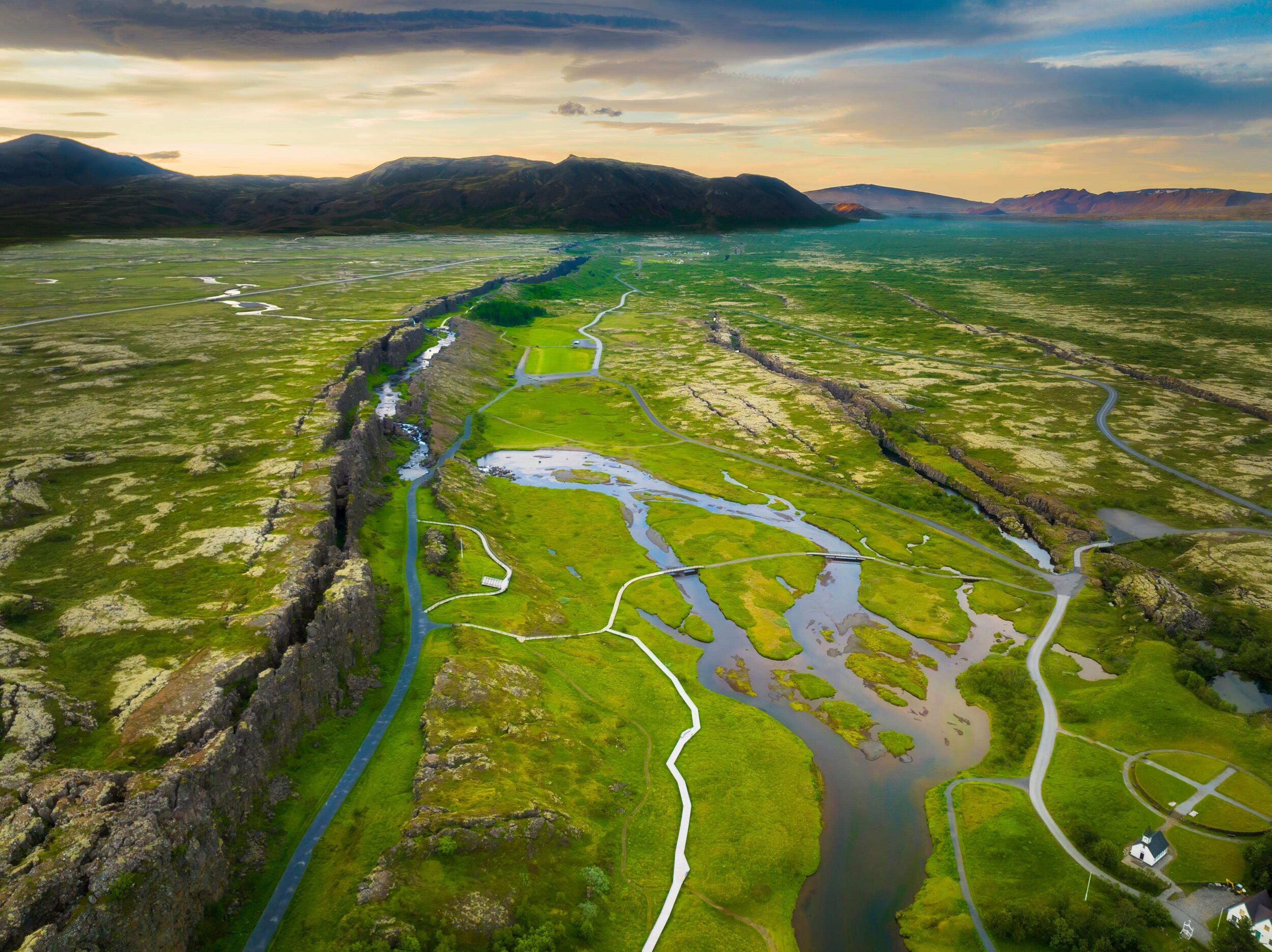
Golden Circle Direct
Want to see the sites of the Golden Circle but have a limited amount of time? Consider this express Golden Circle tour! Experience the landmarks of the classic Golden Circle in South Iceland on this unforgettable day tour. The Golden Circle encompasses the must-see sights of Þingvellir National Park, the golden Gullfoss waterfall, and the bubbling geothermal region of Geysir.
Encountering Iceland’s Geology in Geysir
The history of geysir hot springs.
When groundwater is heated by volcanic activity, the result is geysers that rumble and hiss beneath the earth. Some are more active than others – shooting jets of water high into the air when they erupt. The Geysir area of geothermal activity in Iceland is named for the Great Geysir that has erupted sporadically in the Haukadalur Valley over the centuries. This is where the English word “geyser” originates – a term that has been in use since 1647. The Great Geysir has been erupting since the 13th century but has been relatively inactive since 1916. The last eruption of the Great Geysir was in 2000 and it is currently considered dormant.
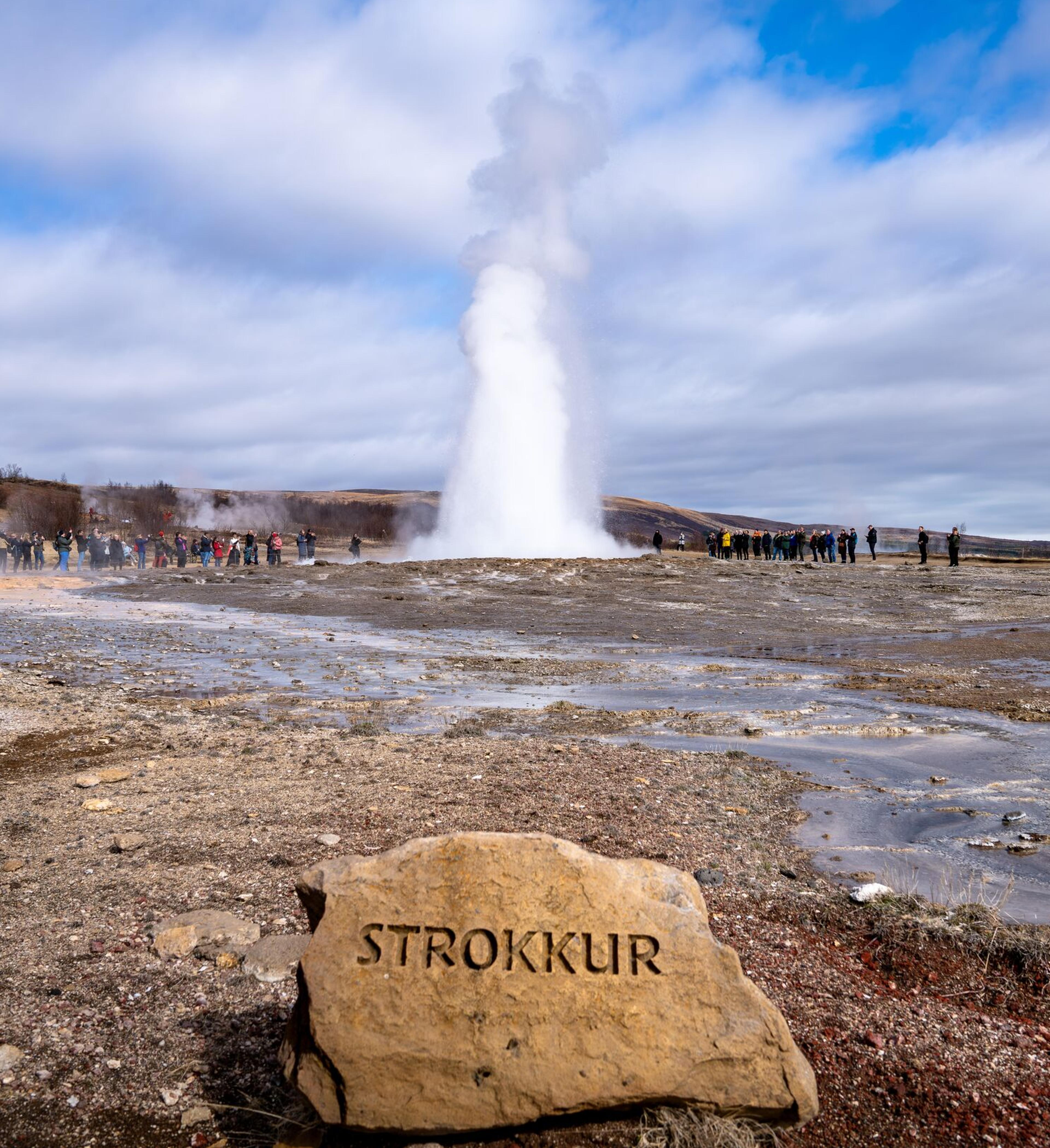
The main attraction at Geysir: Strokkur
The main attraction at Geysir, Strokkur geyser erupts every six to ten minutes. A jet of water bursts through the ground, shooting up to 40 metres in the air (but usually between 15 and 20 metres). Before each eruption, you can gather around to hear the gurgle and rumble of the geyser building up. Moments before it goes off, you can feel the faint rumble of seismic activity and hear the slosh of boiling water in Strokkur’s chamber beneath the surface. Geysir hot springs in Iceland put on quite a show every day.
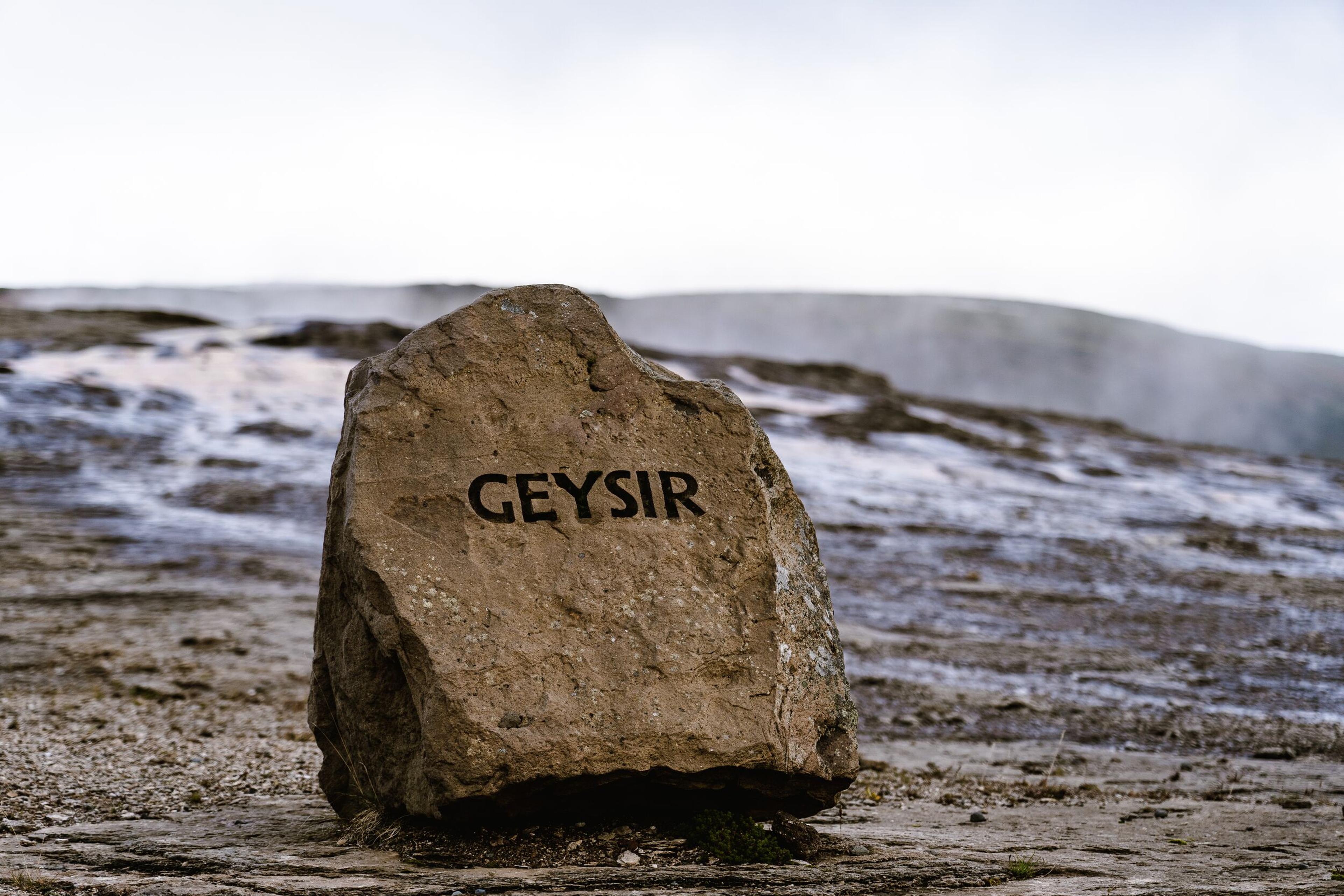
The Great Geysir
Within the protected park, you’ll also find the site of the Great Geysir geyser. As the name suggests, this is Iceland’s largest geyser. At the moment, the Great Geysir is dormant and only tends to erupt after earthquakes or considerable seismic activity in the area. But you can still enjoy a walk to this part of the park, following the short, easy trail past bubbling hot springs and geothermal streams. There’s also the Litli Geysir – a small yet active geyser that has a constant wisp of steam rising from its mouth. It is one of thirty or so smaller geysers in the Haukadalur Valley area, so there is plenty to see when you get here.

Exploring around Geysir
Most organised tours of the Golden Circle that stop at Geysir allow around an hour to explore the area. That’s enough time to catch a few eruptions of Strokkur, wander through the steaming landscape of the area and check out some of the smaller geysers and hot pools. There’s also a café serving rustic, filling Icelandic soups and sandwiches, toilets for a comfort break, and a gift shop selling souvenirs and outdoor gear.

How to stay safe at Geysir
There are many geothermal pools across Iceland and bathing in the naturally-heated water is a common pastime. However, the pools at Geysir are not for bathing. The temperature of the water is between 80 and 100 degrees even when it reaches the surface and can be as hot as 240 degrees beneath the surface. For this reason, you should stick to the marked paths and stay behind the ropes and barriers around the hot springs, streams and geysers.
The water that bursts forth from Strokkur is also boiling hot, so there is a cordon around the site of the eruption, which you should never cross.
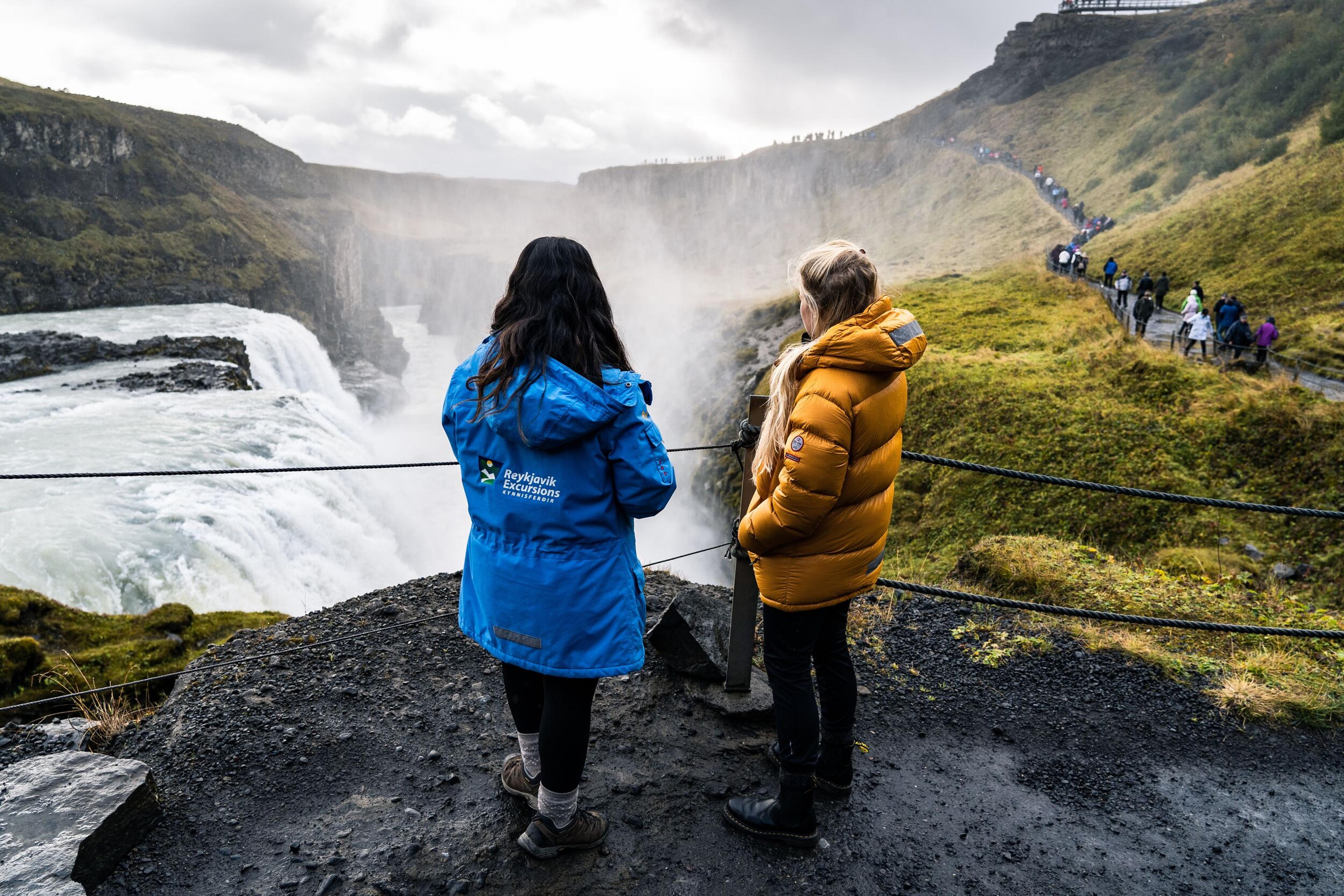
Sights and activities around Geysir
Geysir is one of the three main sights of the Golden Circle route from Reykjavík, along with Gullfoss waterfall and Þingvellir National Park. Day tours from the capital cover all three sights in a single day, and it is also a popular self-drive route. Gullfoss is close to Geysir, just under 10 kilometres away, so only a ten-minute drive. If you plan on staying overnight in the area, there are a handful of hotels, campsites and guesthouses between Geysir and Gullfoss. The small settlement of Reykholt is 20 kilometres away where you’ll find a slightly wider selection of accommodation and the famous Friðheimar tomato greenhouse and restaurant which features as a lunch stop on many Golden Circle day tours from Reykjavík.
As well as the three main highlights of the Golden Circle and the tomato greenhouse , tours from Reykjavík can include other activities along the way – horseback riding across the rugged landscape, or monster truck rides onto the surface of Langjökull ice cap. Many people add a visit to one of Iceland’s geothermally heated pools like the Laugarvatn Fontana or Secret Lagoon for a soothing soak – one that isn’t as hot as Geysir!
All About Geysir
What is geysir in iceland.
Geysir is a protected area of geothermal activity in Iceland where boiling-hot pools bubble and steam and lively geysers erupt like clockwork. Geysir can also refer to a specific geyser in the area – the Great Geysir – which is now dormant. It is where the English word “geyser” comes from.

Where is Geysir in Iceland?
Geysir is in the Haukadalur Valley, on Route 35 or Route 37 from Þingvellir national park. It’s within southwest Iceland, along the famous Golden Circle route from Reykjavík.
How to get to Geysir Iceland?
Most people reach Geysir by following the route of the Golden Circle from Reykjavík, taking in the sights of Þingvellir national park where the continental plates meet, and the thundering wonder of Gullfoss waterfall along the way.
Geysir is around 100 kilometres from the capital city and the entire route of the Golden Circle is 230 kilometres (around 140 miles) long. A well-trodden route, the Golden Circle is easy to do as a self-drive adventure if you are hiring a car.
The roads are cleared of snow year-round, but it is always best to check the SafeTravel app before driving anywhere in Iceland. The Golden Circle and Geysir is a popular day trip from Reykjavík and there are lots of different itineraries available on guided tours
How long to spend at Geysir Iceland?
You should plan to spend around an hour at Geysir to give you enough time to walk the trail through the geothermal area of bubbling activity and see the old site of the Great Geysir eruption.
You’ll also want to wait for Strokkur to erupt – it goes off like clockwork every ten minutes or so. Across the road from the geothermal park, there’s a café and gift shop so this is the perfect opportunity to refuel and stop for a comfort break.
How often does Geysir erupt in Iceland?
The Great Geysir is no longer active (at least it hasn't erupted since 2016), so it does not erupt any more. However, within the Geysir area of geothermal activity, you can see Strokkur erupt on schedule.
A jet of boiling-hot water bursts forth from the landscape every six to ten minutes, giving you enough time to set up a tripod and camera to capture the moment.
Is it free to see the Geysir in Iceland?
Entry to the area of geothermal activity and witnessing Strokkur erupt is free of charge. There is also no fee to use the car park. However, you might want to bring some money to buy refreshments from the café or something to commemorate your visit from the gift shop.
How long is the walk to Geysir?
The Geysir area of geothermal activity is just across the road from the car park and café. Walking to the Strokkur geyser takes around five minutes and following the paths around the entire park takes between half an hour and forty-five minutes. It is all flat.
Do you have to hike to Geysir?
It is an easy, flat walk from the car park to Geysir’s pools, rivers and rumbling geothermal activity. While there is a path that runs through the parkland, it would be considered a leisurely stroll to reach the Strokkur geyser, rather than a hike.
Where is Strokkur geyser in Iceland?
Strokkur geyser sits within the Geysir area of geothermal activity. It’s a short walk from the main car park, past the hot springs and streams that simmer with activity. You’ll find it beside the Hvítá River, in the southwest of Iceland.
Which is the best Geysir to see in Iceland?
Iceland’s most active geyser is Strokkur. It is the only geyser you can watch erupt with predictable regularity. It erupts every six to ten minutes. For this reason, Strokkur is considered the best geyser to see in Iceland. If it was as regular as Strokkur, the Great Geysir would, without doubt, take the top spot of geysers in Iceland as it boasts a much bigger plume of water when it does go off. However, the Great Geysir has been dormant for the past couple of decades – the last time it erupted was in 2000, after an earthquake in the area. There was also a small activity in 2016, but it wasn’t a huge eruption.
Is Geysir part of the Golden Circle in Iceland?
Geysir is one of three main natural attractions that make up the basic itinerary of the Golden Circle route. It is close to Gullfoss – the tumbling waterfall that gives the Golden Circle its name.
The third natural wonder of the Golden Circle is Þingvellir national park where you can see the chasm between the Eurasian and North American continental plates.
Of course, there are additional sights that can be added to a Golden Circle itinerary, like secret geothermal lagoons, glacier hikes, lava tunnels and the caldera of an ancient volcano.
How to dress for visiting Geysir in Iceland?
You don’t have to wear anything special to visit Geysir in Iceland but, like all outdoor sites on the island, it is a good idea to bring a waterproof jacket in case it rains (and for potential spray from Strokkur geyser), sturdy walking boots and layers.
In summer, a breathable tee-shirt, long-sleeve jumper and waterproof jacket should suffice. In winter, you’ll want to have a thicker layer like a fleece or woolly jumper to keep the chill at bay, plus a hat, scarf and gloves.
When is the best time to see Geysir in Iceland?
There are no opening hours at Geysir – it is open 24 hours a day. You can even come here to spot the northern lights after dark if you want. The best time of day to visit Geysir is in the early morning or later on in the evening when there are fewer crowds.
The best time of year to visit Geysir depends whether you want to enjoy the balmier weather and long hours of daylight in summer, or if you want to witness the drama of the Haukadalur Valley covered in snow during winter. Geysir is a year-round destination, and the cold weather doesn’t affect the clockwork timing of the Strokkur geyser.
Related Attractions
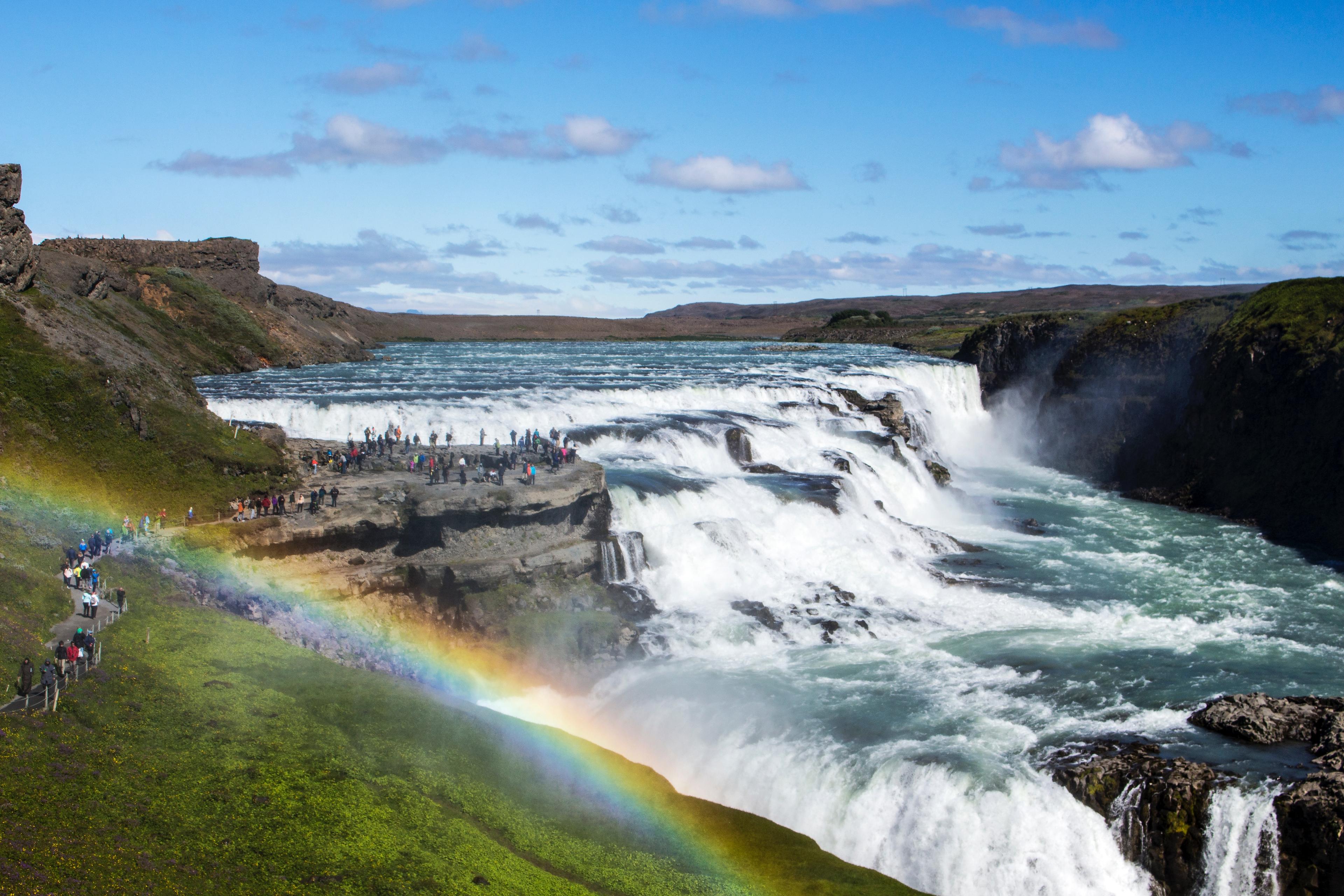
Gullfoss Waterfall

Golden Circle

Þingvellir National Park
Sign up for our newsletter
Subscribe to our newsletter for exclusive tips, personalized travel advice, and early-bird offers on unique experiences!
- Exclusive Insights
- Tailored Travel Tips
- Early Access to Offers
Sign up today!
By subscribing you are accepting our privacy policy
Geysir Hot Spring
Photo gallery.

Geysir – Where the Earth Comes Alive
We sometimes forget what happens below the surface. But it’s hard to ignore how alive Iceland is underground when it’s literally bursting forth with steam, gushing water and gasps from onlookers. Nowhere in the country are the geothermal marvels of Iceland more dazzling than at the Geysir geothermal area.
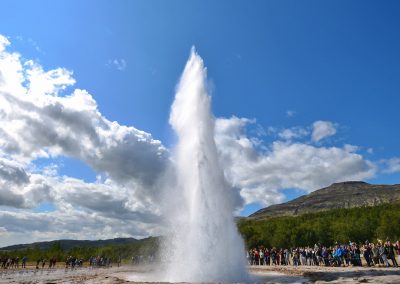
The Namesake of all Geysers
The area is named after the large, infamous grandfather of all geysers, called “Geysir” (GAY-seer). With sprays once said to be up to 170 meters, the wonder of Geysir has been drawing crowds since the 17th century. And despite a variety last-ditch efforts like dumping over 100 kg of hand soap into the spring and digging draw-off trenches, Geysir’s eruptions have since dwindled.
The Workhorse Strokkur
While all the fame and glory goes to Geysir, the real work of erupting is left to another powerful hot spring nearby, Strokkur, which faithfully erupts every 7 to 10 minutes in a rousing display of geothermal might and fills the valley with oohs and ahhs.
The Science of Wonder
While the hot springs steal the show, a lot of Iceland’s other geothermal marvels are also on display here: fumaroles, bubbling mud pots and the eerie blue glow of colloidal silica pools. The explanations behind these phenomenons are a fascinating look into the often hidden world of geothermal science.
An Insider Tour
While Geysir is a frequent stop on many visitors’ itineraries, there is more than meets the eye. The area is rich with history, like the Irishman who bought Geysir for 3000 kr. and the story of Ari “The Wise”.
Beyond the immediate Geysir area there are also a number of sites hidden away in the surrounding foothills, like the world arboretum tucked away in Haukdalsskógur forest and a secret thermal pool perfect for soaking.
Discover the Geysir geothermal area with ILT and enjoy a richer experience of Iceland’s spectacular natural wonders. Contact us to find out how we can make your trip Geysir a memorable one.
ENQUIRY FORM
Please fill out the enquiry form below and we will reply as soon as possible.
How many travellers?
Give us a call
+354 554 7500 Weekdays 9 AM - 5 PM GMT
Request a callback
We will call you
Click here to send us an email or just fill out the form below
How can we help?
Feel free to ask a question or simply leave a comment.
Iceland Luxury Tours
Borgartun 23 105 Reykjavik, Iceland Phone: (+354) 554 7500 Email: [email protected]
Our office is open from 9 to 5 on weekdays and our phone-number is +354 554 7500 .
In case of an emergency our emergency phone-number is +354 694 7500 .
Request a Callback
Let us know how to get back to you.
2 day luxury package
3 day luxury package, privacy overview.
Iceland is open for travel. Check volcano updates here
- Language/Currency EN Language EN English DE German CN Chinese $ USD ISK ISK $ USD € EUR CA$ CAD £ GBP

Geysir Hot Springs in Iceland
Discover the great geysir and strokkur geysers.
Attractions
- Popular tours
- About Geysir
- The History
Strokkur geyser
What causes a geyser to erupt.
- How to get there
- Other Facilities near
- Accommodation
Geysir in Winter
- What not to do
- Interesting places near
- Subscribe Newsletter
Geysir is Iceland’s famous geyser located along the Golden Circle in the Haukadalur Valley. In recent years, the Great Geysir has stopped erupting. Luckily, the neighboring Strokkur geyser continues puts on a magical show every 4-10 minutes. Stop by to check out Geysir and Strokkur for a once-in-a-lifetime experience!
View our selection of Golden Circle tours
POPULAR TOURS THAT VISIT THE GEYSIR AREA
Geysir is a part of the Golden Circle, here are all the tours visiting the Golden Circle

Golden Circle Superior
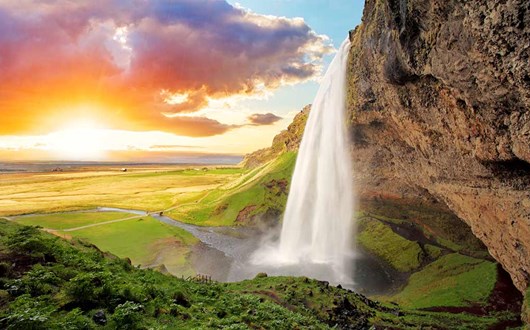
3 Day South Coast & Golden Circle Tour
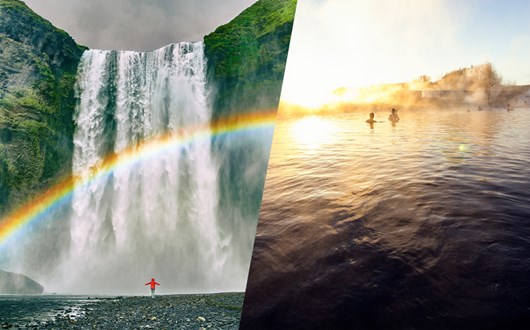
Golden Circle & Secret Lagoon
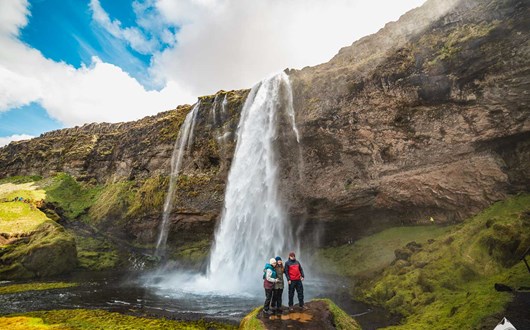
6 Days Around Iceland Adventure
Geysir in Haukadalur is the most famous geyser in the whole wide world. It is, after all, the one all the other geysers are named after. Geysers are a rare phenomenon and knowledge about them is quite limited. They were almost an unknown thing in the Western world until the 19th century.
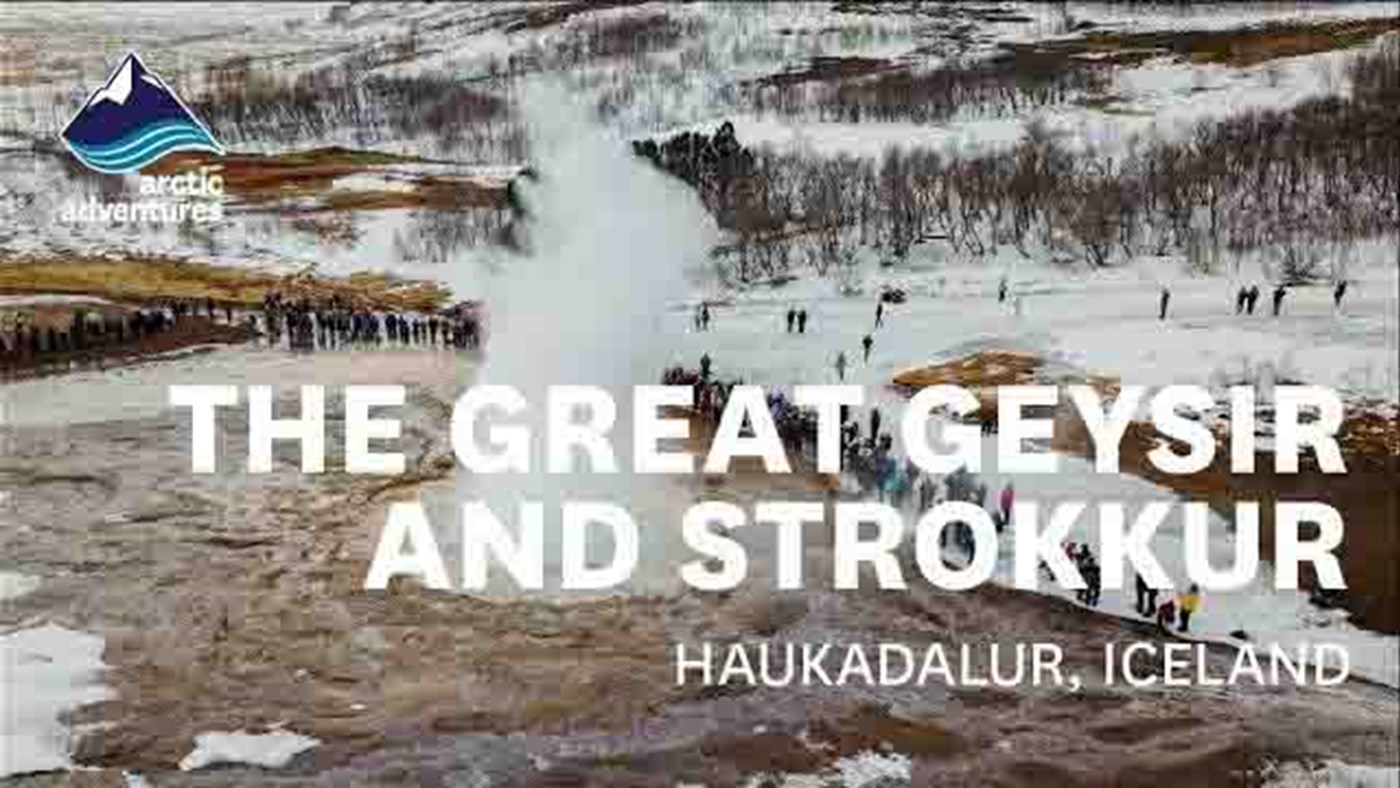
The History of Geysir
The geysers in Haukadalur were first mentioned in literature in the year 1294. That year, enormous earthquakes shook the ground, which both created new geysers and ruined some geysers already in the area.
Earthquakes have been known to restart Geysir’s activity but in the year 1630 an earthquake woke Geysir up after 40 years of hibernation. The eruption was so powerful it shook the surrounding ground.
The name Geysir can first be found in literature from the 18th century, they’re described as an unusual natural phenomenon which, at this time, was already of great interest.

In the year 1845, Geysir would erupt up to 170 meters (557,7 ft) into the air but a year later it was only reaching the height of about 43-54 meters (141-177 ft).
Subsequently, it went almost dormant until the year 1896 when another earthquake revived the beast. As a result, it would erupt multiple times a day, sometimes lasting up to an hour each time and going up to 60 meters (196,8 ft) in height.
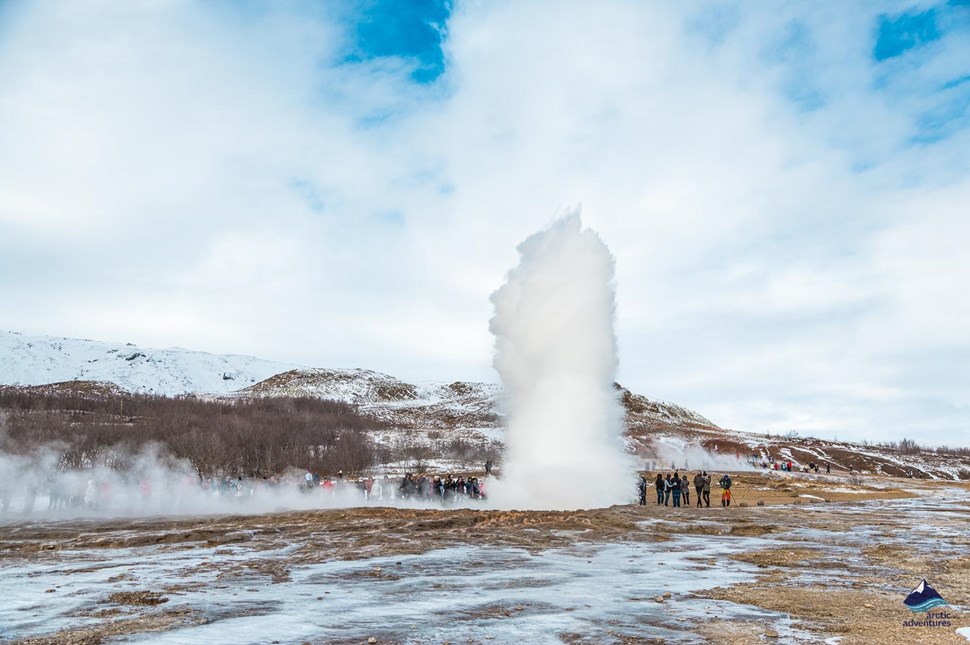
In 1910 Geysir erupted every 30 minutes but five years later the time between the eruptions was six hours. A year later the eruptions had ceased.
In 1981 the eruption was forced again but this time soap was used to do the job! In the 90s, due to environmental concerns, the soap trick practices less and less but the government authorized for geologists to do it especially for Iceland’s National Day, the 17th of June.

The geyser was greatly affected by an earthquake again in 2000 and the eruptions reached up to 122 meters (400 ft) height and even lasted for two days. This made Geysir one of the highest geysers ever in history.
From 2000 the eruptions were around eight times a day but in July 2003, the activity had decreased down to three times a day. Today Geysir’s activity is very low but who knows when it will decide to erupt again, maybe you’ll get to witness it!

Strokkur geyser is the most active geyser in Iceland and erupts naturally every 4-10 minutes, it usually erupts up to 15 or 20 meters (49-65,6 ft). In history books, you can find accounts of it having gone up to 40 meters (131 ft).
Strokkur and Geysir are believed to be the same age. However, since Geysir was considered to be the more magnificent Strokkur, it wasn’t mentioned in any written books until 1789.
In the 20th century, yet another earthquake clogged the Strokkur conduit again. Since 1963, Strokkur has been erupting rhythmically like a rocket into the Icelandic sky!

The timespan between spouts varies, but most people get a gut feeling just before the moment arrives. So what are the signs you should watch out for? When you see the surface of the pool boiling a little more volatile than usual, then swaying a little, this usually means that an eruption is imminent.
Finally, the surface of the scalding pool will retract back a little – when this happens, Strokkur is well and truly primed for action. Set your camera to sports action mode and get ready to witness one of Mother Nature’s showstoppers!

Golden Circle Tours
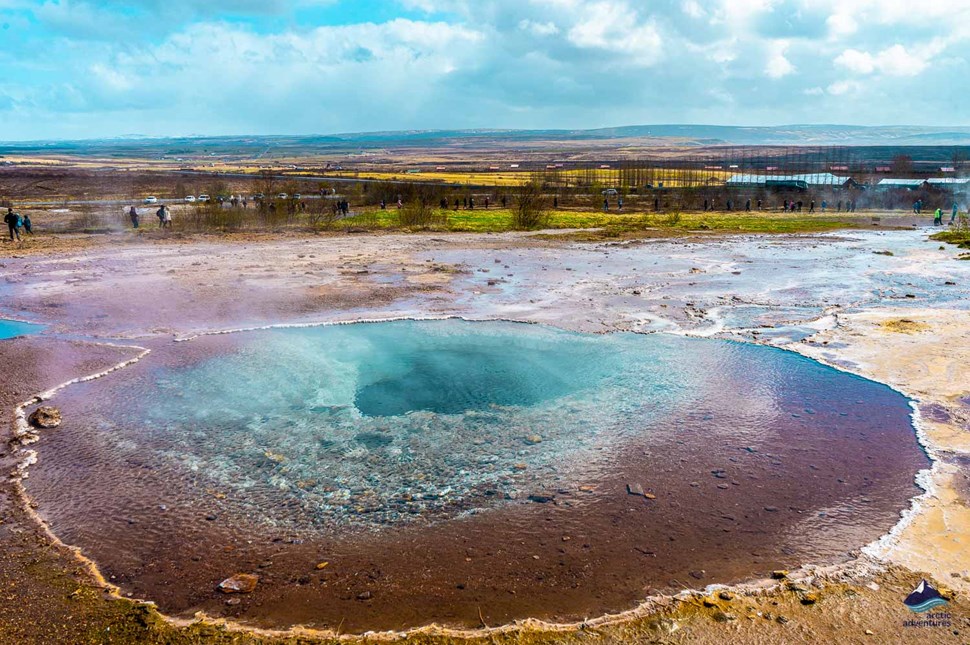
For tourists and locals alike, we’re lucky to have a reliably erupting geyser at a geothermal field so close to Reykjavík . Luckily, it also sits directly inside the hugely popular Golden Circle area .
Various geological factors have to combine for a geyser to exist, making them very rare in nature. In order for a geyser to erupt, the following features must all be present:
- The molten magma has to be sufficiently close to the surface of the earth make the rock hot enough to boil water. No hot rocks = no geyser!
- A sufficient and continuous source of flowing underground water is an essential component of any erupting geyser. Drains from Langjökull Glacier pass close by on its journey to Haukadalur, and through porous lava, a constant water supply to Strokkur is achieved.
- There must be a conduit to carry the water to the ‘chamber’ or reservoir which holds the water. This sits underground beneath the opening of the hot spring.
- The vent and its plumbing system need to have a silica lining to prevent the water from draining away.
Where are Geysir and Strokkur Located?
The geysers are one of the attractions of the famous Golden Circle . Situated in the geothermally active valley of Haukadalur in South Iceland 99.2 km (61,6 mi) from Reykjavík if you take the Þingvallavegur route, otherwise around 107 km (66,4 mi).
GPS Coordinates of Strokkur: 64.3127° N, 20.3008° W
How to get to Geysir and Strokkur?
The Geysir hot spring area is easily accessible, it is located on road nr. 35 is open almost 365 days out of the year.

Driving from Reykjavík to Geysir you can take two routes. The more common one is through Mosfellsdalur, past Thingvellir National Park following road number 36. The road soon switched to road 365 and as you pass Lake Laugarvatn it turns to road 37. Continue on this road without any turns.
The second way is via Road 1. It takes you through Hveragerði and right before you reach the town of Selfoss you make a turn left onwards to Lake Laugarvatn. This route will take you past Kerið Volcanic Crater and Faxi waterfall as you follow road 35 there rest of the way.
Other Facilities near the Great Geysir
There are display boards at the entrance to the Geysir Geothermal Area showing information about the geysers and other geothermal activities found in the valley.
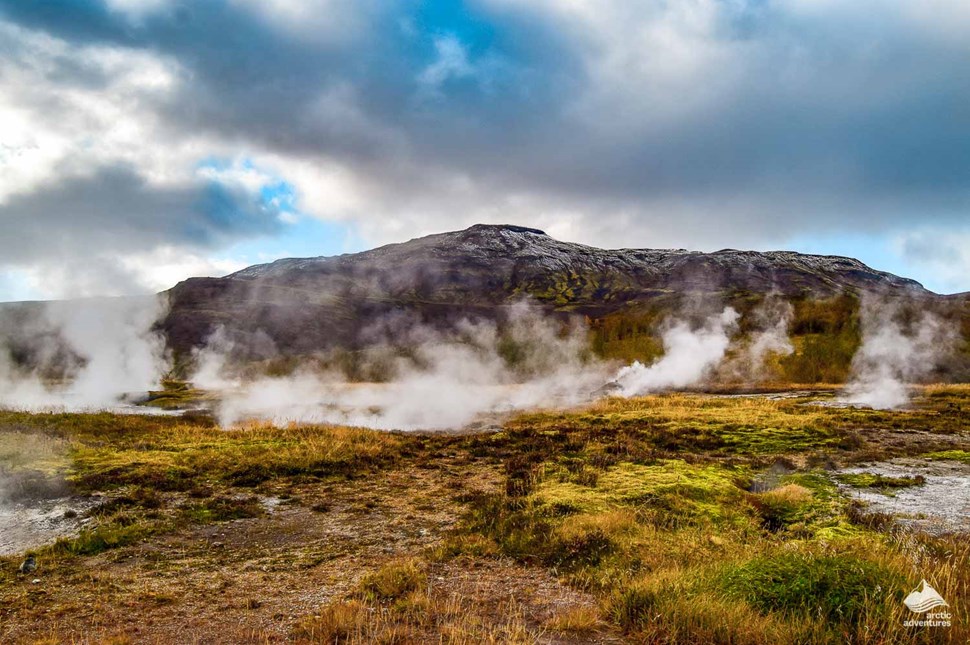
Entry to the toilets in the Geysir Center is free of charge. There are two car parks in the vicinity of the Geysir Geothermal Area. One is on the opposite side of the road at the Geysir Center.
Another car park on the same side of the road. This car park is closer to the geysers and is a better option for those with small children, limited mobility or wheelchairs.
Accommodation and Hotels near Geysir and Strokkur
At the Geysir location, just across the street from the mighty geysers, you will find two hotels and a cottage so finding accommodation should not be a problem.
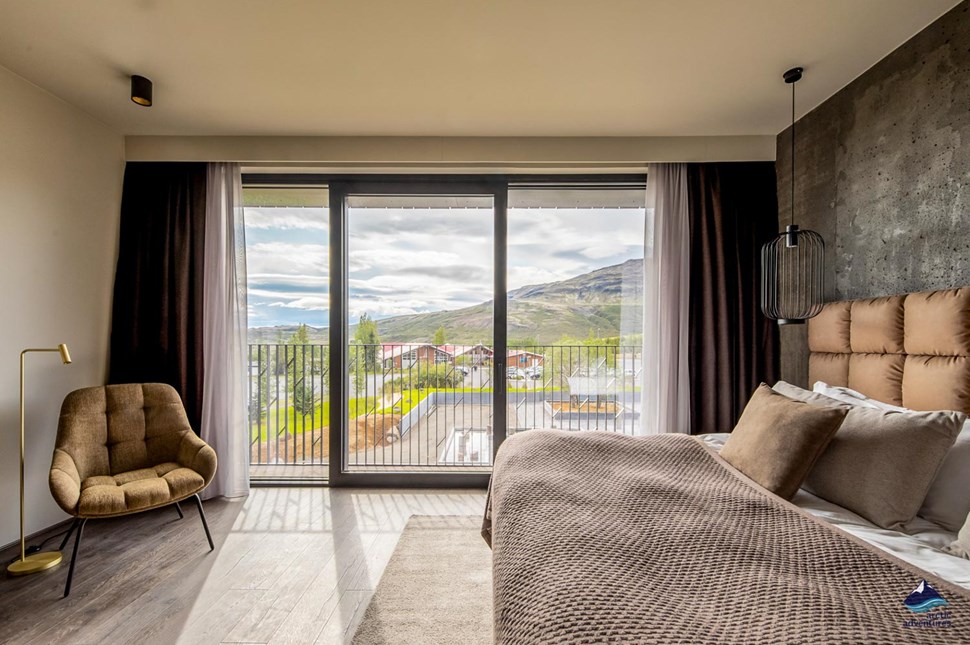
If you wish to stay away from the Geysir area, to possibly find more tranquility and less traffic, we will also mention cabins and other options further away. The top options are the closest ones to Geysir.
- Hotel Geysir
- Litli Geysir Hotel
- Hotel Gullfoss
- Mengi Kjarnholt
Guesthouse, B&B and Farmstays
- Jaðar The Old House
- Efstidalur II
Cabins and Cottages
- Geysir Cottage
- Geysir Hestar
- Úthlíð Cottages
- Eyjasol Cottages
- Sacred Seed
- Árbakki Farmhouse Lodge
Camping near Geysir and Strokkur
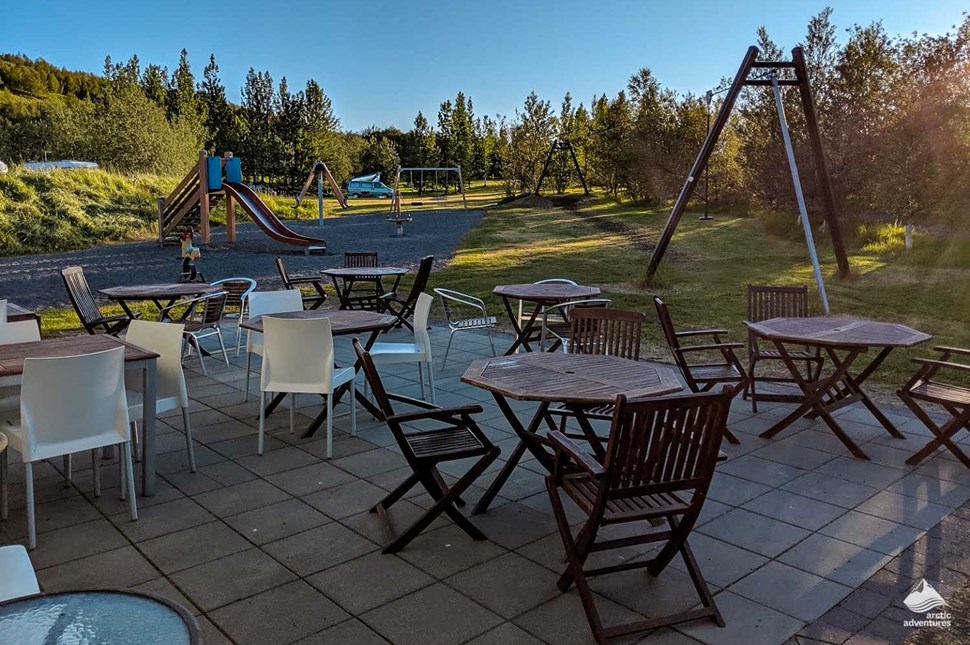
Geysir Camping Ground is located within a walking distance from Geysir. Facilities on-site include showers, toilets access to electricity, washing machines, WIFI, a golf course, and a playground. Open from the 15th of May till the 15th of September.
Skjól Camping Ground is located in between Gullfoss and Geysir. Their facilities include a restaurant, showers, WCs, WIFI, washing machines, access to electricity, a restaurant, a golf course, walking paths, and wheelchair accessibility. Open all year round.
Faxi Camping Ground is a quiet and beautiful location next to the waterfall Faxi. The facilities include cooking facilities, electricity, WCs, showers, a swimming pool, a restaurant, and walking paths. Open from the 15th of May till the 30th of September.
Úthlíð Camping Ground a charming camping sight near Geysir. Facilities include cooking facilities, WCs, showers, electricity, a golf course, a playground, and a swimming pool. Open from May to September but all year round for campers.
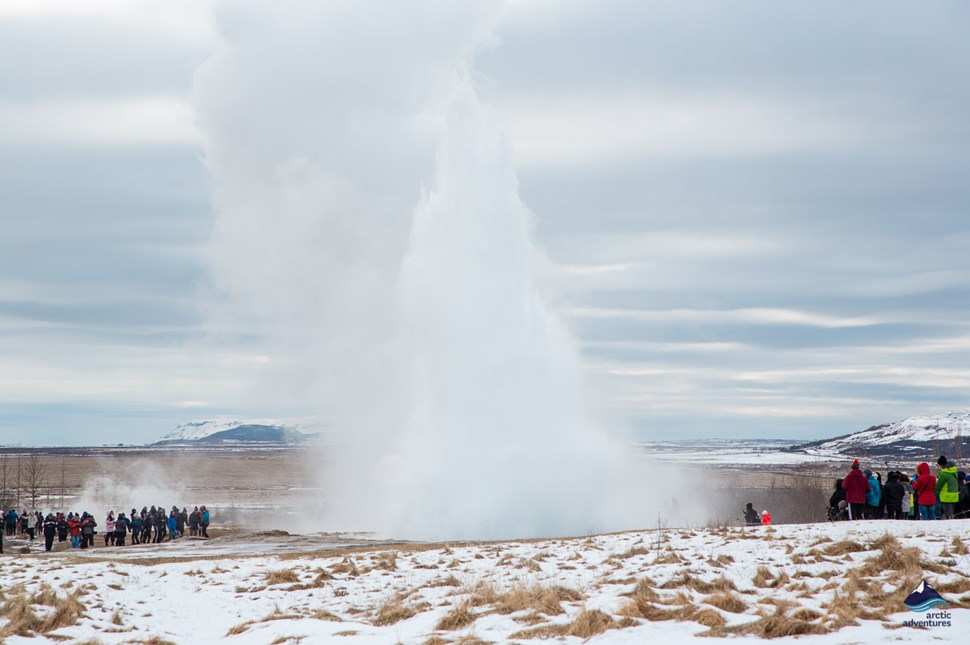
The Geysir area is a fascinating attraction any season, all year round. The steam and smoke that surrounds the area take on the otherwise frosty atmosphere and a true collision of ice and fire takes place.
The ground can get quite slippery so it is important to be mindful of your step. Keep in mind that even when visiting a geothermal area such as this one the temperatures aren’t high so you need to dress according to weather forecasts. Dress smart – layers are key!
Geysir is also a great location to see the winter Northern Lights. If you seek to witness the magical aurora, check out our Golden Circle and Northern Lights tour .
What not to do at Geysir and Strokkur?
Go within the lines! The water is extremely hot and the lines have been put up after accidents have happened. Follow the rules, there is a reason for them.
Go there without visiting Gullfoss , the waterfall is only about 7 min driving distance away. You simply can’t visit the area and skip Gullfoss .
Litter! The area is greatly kept and it’s important that we do what we can to help to keep it that way.
Interesting places near Geysir
- Gullfoss waterfall
- The Secret Lagoon
- Skáltholt Churches
- Friðheimar Tomato and Horse Farm
- Faxi waterfall
- Efstidalur Farm
- Drumbó River Rafting Base
- Laugavatn and Fontana Spa
- Kerið Volcanic Crater
- Sólheimar Eco Village
- Brúarfoss Waterfall
- Þingvellir National Park
- Silfra Fissure
FAQ about Geysir
Is geysir active when did geysir last erupt.
Geysir hadn’t erupted since the year 2000 before a suddenly bursting up into the air in February 2016. This shows you that it is still active although not at a frequent level.
Can you bath in Geysir or Strokkur?
No, absolutely not! The temperature is anything from 85°c to 120°c.
Is there a place to eat at Geysir?
There are great restaurant options both at Geysir in Geysisstofa and at Súpa and also at neighboring attractions and farms (Við Faxa, Efstidalur II, Lindin, Friðheimar and Héraðsskólinn Restaurant, and Bistro). For more on what delicacies this area has to offer, see our Best Food on the Golden Circle blog post.
What are the eruption times of Strokkur?
Strokkur erupts every 4-10 minutes, on a rare occasion you might have to wait 15 minutes between eruptions. The force of each burst can though vary quite a lot so you might need to watch a couple to get a high one.
Share our passion for Iceland, get top travel stories & special offers to your inbox
Please enter keywords
- Destinations
- South Iceland
- Reykjavik Area
- West Iceland
- North Iceland
- East Iceland
- Travel Tips
Everything You Need To Know about Geysir
The Geysir Geothermal Area is a steaming and bubbling center of geothermal activity in the South West of Iceland.
It is situated along the world-famous Golden Circle sightseeing route, which can be driven in a day from the capital city of Reykjavik. You won’t be able to jump into any hot springs at The Geysir Geothermal Area, as the geothermal water is hot enough to burn.
Visiting the geysers, fumaroles, and mud pots is an exhilarating experience nonetheless. This is one of the few places in the world where you can watch boiling water and steam erupt from the earth on such a regular basis.
If you are thinking about visiting The Geysir Geothermal area during your visit to Iceland, this article will tell you everything you need to know. From driving directions to where to stay and tips for escaping the crowds, we have got you covered!
How To Get To Geysir
Geysir is situated in the Haukadalur valley in the South of Iceland.
The best way to get there is to take a self-drive tour of the Golden Circle. This will allow you to take things at your own pace, and give you the flexibility to stop off at your favorite places along the way.
It is also possible to take a guided bus tour to Geysir. This normally works out more expensive than renting a car, but it’s a good option for people that don’t feel confident to drive in Iceland or who prefer the social aspect of a group tour. It is about 100 km from the capital city of Reykjavik, which takes about 1.5 hours to drive. We recommend that you leave as much time to drive as possible, especially in the wintertime when there is frequent snowfall.
Driving Directions From Reykjavik to Geysir
The driving directions to Geysir will depend on which other parts of the Golden Circle you would like to visit, and what time of day you would like to see the different stop-offs. You may want to read the Golden Circle guide to help you plan this.
Whether you complete the sightseeing loop clockwise or counterclockwise, the driving time to Geysir is almost the same.
Gullfoss (about a 10 minutes drive from Geysir area)
Heading North Out of Reykjavik
If you decide to drive the Golden Circle clockwise, you will take the Northbound Ring Road (Route 1) out of the Reykjavik.
After Lagafell, you will exit the Ring Road and take up Road 36. Follow Road 36 through Selholt and keep going through Thingvellir, staying on Road 36 until you have the chance to exit onto road 365 towards Laugarvatn.
After passing through Laugarvatn, you will take Road 37 towards Stekka. Stay on Road 37 until you get to Muli. You will hop onto Road 35 for the last short stretch to Geysir. Look out for signage.
If you want to finish the Golden Circle route, you would carry on a little further up the road to see Gullfoss (about a 10 minutes drive). You would then turn around, keeping on Road 35 in the direction of Reykholt. After passing through Reykholt, you would keep going towards Selfoss, before turning right to take the Road 1 back to the city.
If you have any problems finding it, online maps will be able to help you.
Heading South Out Of Reykjavik
If you prefer to head South out of Reykjavik, the anti-clockwise Golden Circle drive won’t take you much longer. Take the Southbound Ring Road (Route 1) out of Reykjavik. Just before arriving in Selfoss, you will take up Road 35 (Biskupstungnabraut.) You will stay on this road for almost the whole way to Geysir. You know you’re on the right track if you pass through Reykholt. Eventually, you will turn right to stay on Road 35. Keep your eyes open for signs now, because you are very close.
If you want to complete the Golden Circle, you would carry on up the road to see Gullfoss, then turn around and head back towards Reykjavik via Road 37 to Laugarvatn. At Laugarvatn you would pick up Road 36 through Thingvellir National Park, before taking up the Ring Road (Route 1) South for the final stretch to Reykjavik.
If you have any problems finding your way, just look at the maps online.
Facilities at Geysir
Once you arrive in Geysir, you will find all the facilities that you need.
The Geysir Center is right next door, with toilets, shops, restaurants, and accommodation. There is both a luxury hotel and a simple campsite available, depending on your needs.
You don’t need to spend the night there to visit the shops or restaurants, most people spend around an hour at Geysir.
There is no charge to enter the Geothermal Area anymore. It was bought from a private owner by Sigurdur Jonasson, who gifted the thermal field to the Icelandic people. It has remained in public ownership ever since, and you do not have to pay to walk around and enjoy the amazing Geysers and Fumaroles.
Like a lot of places in Iceland, the products and cuisine at The Geysir Center might seem expensive for people unused to Iceland’s prices. If you are traveling on a tight budget, you might want to consider bringing along a packed lunch to eat as a picnic.
For tips about cheap things to see and do when you are in Iceland, you can check out this article.
Staying Safe In The Geysir Geothermal Area
It is really exciting when the steam and boiling water comes bursting out of the ground.
Make sure you keep a good distance from the geysers, respecting all barriers and pathways that have been put in place for your safety.
The bubbling pots of boiling mud might capture your attention too. Stay on the paths, and do not try and walk right up to them! Take it from international pop star Ed Sheeran, who wandered away from the main path and found his foot plunging into a boiling mud pot. He was lifted to the hospital in an air ambulance, but the skin on his foot was seriously burned. Luckily, he has recovered with nothing but scarring now.
You need to keep a close eye on children and make sure they don’t wander off the path and hurt themselves. Do not throw anything into the geysers, mud pots, or fumaroles.
If you follow this advice, there is nothing to worry about!
You can find lots more information about staying safe in Iceland in this article.
How To Escape The Crowds at Geysir
It’s not possible to completely avoid the crowds at Geysir.
Iceland welcomes over 2 million visitors every year, compared to just 350,000 residents.
There are more visitors in the summer than the winter, though the winter tourist industry is catching up. If you do want to visit at a quieter time, it’s a good idea to come before 10 am or after 4 pm, when most of the organized tour groups will not be running.
This is easier in the summertime when Iceland experiences very long hours of daylight (the midnight sun.) In the winter, the nights are very long, and there are only a few soft hours of sunlight every day.
So even though there might be fewer tourists overall, they are more likely to be concentrated into the same short window of daylight.
The good thing about visiting Iceland in the wintertime is that you have the chance to go ice-caving and to see the Northern Lights.
What to Wear At the Geysir Geothermal Area
You don’t have to wear anything special to visit the Geothermal Area.
Summer or winter, it’s a good idea to have a good quality waterproof coat with you and warm mid-layers, because Iceland’s weather can be cool and unpredictable.
If you are visiting in the cold months, you may want to consider buying or hiring some crampons from a camping shop. These are spikes that go over your normal shoes, preventing any slips on the ice.
People wear them all the time in Iceland’s winter, including around the capital city.
What is a Geyser?

The word geyser comes from the Old Norse for ‘geysa.’ This means to gush or to rush forth. The word was first used to describe The Great Geysir, which is currently going through a dormant period.
The Great Geysir of Iceland gave its name to all other geysers. It was the first geyser to ever be described in literature back in the 13th century.
Geysers are like a vent in the earth that releases boiling water and steam.
They occur when there is
- a source of water
- a source of heat (from magma close to the earth)
- a difficulty for water to drain away
Silica-rich soil traps the water in certain spots under the ground. As the geothermal heat raises the temperature of this trapped water, pressure builds. When there are enough pressure and heat, boiling water and steam explodes out of the earth.
They will not erupt again until they have filled back up with water, and enough heat and pressure have accumulated.
Some geysers erupt every few minutes, and some every few years. It depends on a lot of different factors, though they can be triggered into an active or dormant faze by earthquakes.

Which Geysers Are Active In Iceland?
The world-famous Geysir is currently going through an inactive period. When it does erupt, the explosion is enormous! It regularly goes up to 70 meters (230 feet). In 2000, after being reawakened by seismic activity, it erupted to an unbelievable 122 meters (400 feet)!
Over the years, people have used different methods to try and trigger Geysir to erupt on demand. For example, people have tried throwing in rocks, adding soap, or digging trenches to feed it more water.
Adding soap worked pretty effectively, but this has now stopped for the sake of the delicate local ecosystems that were being polluted. Digging trenches also worked for a time. The trenches encouraged more water to flow into Geysir so it would fill up and need to explode more regularly. However, the channels would quickly get silted up.
Rather than trying to manipulate Geysir to explode, the authorities have realized that natural processes should be left alone. It is now strictly prohibited to throw anything into a Geysir!
Smiður and Litli-Strokkur are two other active geysers in the area.
Strokkur is a geyser right next to Geysir, and it regularly erupts. It usually goes off every 10 minutes. It isn’t the largest geyser in the world, but it is still very exciting to watch.
What is a Fumarole?
As well as the explosive geysers, you will find lots of fumaroles in the Geysir Geothermal Area.
Fumaroles are rising columns of steam and gases that drift out of the earth. They are named after the Latin word ‘fumus’, which means smoke. They are a lot less dramatic than geysers, but they are still beautiful and intriguing.
Just like with geysers, you should keep your distance! Fumaroles can contain gases that are toxic to people, but they are generally good for soil fertility.
They appear at active volcanoes, around small cracks in the earth and on the surface of lava flows.
What is a Mud Pot?
Mud pots are rather less beautiful than fumaroles. They are bubbling pools of boiling mud that can be found in geothermal areas, including around Geysir.
What is dangerous about mud pots is that they melt the rock and earth beneath the surface. Inquisitive people might leave the path to get closer and find their foot going through the thin crust surrounding the mud pot.
This is exactly what happened to Ed Sheeran.
The mud is extremely hot and will give lifelong burns if you step in it. If you stick to the path and respect the barriers in place, you do not need to worry about safety.
Please make sure the little ones understand the risks and keep a close eye on them!
What’s that smell?

You may notice an unpleasant, eggy smell and yellow stains on the ground near fumaroles and other hot springs around Iceland.
This is due to sulphuric gas which crystallizes on the ground.
Although not pleasant, you don’t need to worry about it from a safety perspective when visiting a managed hot spring or walking on the paths around Geysir. In high quantities, the gases from fumaroles are toxic.
This is why you should keep to paths, and you should not jump into any random hot springs that you do not know to be safe.
To find out more about the hot springs and swimming pools of Iceland, you can check out this article.
What to do in the Area?
Geysir is only 10 minutes down the road from Gullfoss (The Golden Waterfall) so you can easily see them both whilst you are in the area!
Gullfoss is a spectacular waterfall. A fine mist comes rising from the crashing water, which is filled by tiny rainbows when caught by the midnight sun. It is also considered one of the founding places for feminism and environmentalism in Iceland, due to an extraordinary woman that refused to let it be destroyed by a hydroelectric dam.
Here are some more ideas for what to get up to during your visit to Geysir Geothermal Area.
Golden Circle Route
As we mentioned before, Geysir can be found along the Golden Circle sightseeing route. This is often completed in a day from the capital city of Reykjavik.
The other main attractions on the Golden Circle route are Gullfoss waterfall and Thingvellir National Park, the home of Iceland’s Althing. The Althing was Iceland’s first parliamentary body, which came together in Thingvellir over 1000 years ago.
The parliamentary processes have stayed largely unchanged right up to this day!
Lesser-known stops on the Golden Circle include:
- Skaholt Town
- Kerid Crater
- þórufoss waterfall
- Faxi waterfall
- Fontana Thermal Baths
- Fakasel Horse Baths
- Thjorsardalur Valley
- Langjokull Glacier
There are also some delicious restaurants located at working farms along the route, which use local ingredients. To find out more details, you can check out our Golden Circle Guide.
Explore the South Coast
Visiting Geysir could also be integrated into a self-drive tour of the South Coast of Iceland.
The Golden Circle would be a bit of a detour from the coast. It can easily be included if you have a few days to spend in the South of Iceland.
Black volcanic beaches, Puffins, Glacial Lagoons, and Hiking Trails are all waiting to be discovered on the South Coast.
If you have the time and energy, you could always drive the entire Ring Road route , and add in a Golden Circle trip to Geysir at the beginning or the end of your trip.
We would recommend taking at least two weeks to do this epic road trip.
Relax in Some Hot Springs
Technically the Geysir Geothermal Area is a series of 10,000-year-old hot springs, but you can’t bathe in any of the water here. It is too hot, and would instantly burn your skin.
For your safety, you will need to head to a managed pool like the swimming pool at the Hotel Geysir, or to the nearby Fontana Thermal Baths or The Secret Lagoon.
The pool at Hotel Geysir is only for the use of staying guests, but Fontana Thermal Baths and The Secret Lagoon are available to visit for a day.
The Secret Lagoon is the oldest geothermal swimming pool in Iceland. Lots of tourists like to visit The Secret Lagoon for its green surroundings, and a baby geyser that you can see from the pool. The facilities are fairly basic, with changing rooms and showers and some snacks and drinks available.
The Secret Lagoon certainly has charm, but you will probably find it to be expensive and crowded compared to many other options. Fontana Geothermal Baths are usually less busy, and they also sell lava bread which is baked in the volcanic earth for 24 hours before being served.
It’s delicious (and much less intimidating than other Icelandic specialties like rotten shark meat and puffin)!
After enjoying the mineral richness of the thermal baths, you can wake yourself up with a quick dip in the lake on the edge of the facility. Though less busy than The Secret Lagoon, the Fontana Thermal Baths can still be crowded due to their location on the Golden Circle.
Go Hiking in Haukadalsskógur Forest
You won’t find many forests in Iceland.
Conditions don’t make it easy for trees to thrive, and the early forests were largely wiped out by the settling Norse people. They used the wood to create pasture land for livestock and build the first farms and towns of Iceland.
Recently, great effort has been made to protect Iceland’s remaining trees and reforest the bare land. Haukadalsskógur forest is a result of these efforts. It is a large managed forest that can be found on the Golden Circle route. It is usually completely missed by tourists.
Here you will find some lovely walking paths, one of which is fully wheelchair accessible.
This is a very special place in the hearts of Icelandic people, who don’t have very many forests that they can enjoy.
If you want to go for a walk in the forest, you will find it right next to Geysir Geothermal Area. Follow the small road past Geysir Geothermal Area until you come to a fork. If you take the right-hand fork, you will find a place to park as well as the old Haukadalskirkja Church.
You should only drive up here if you are insured to drive on F roads. Make sure you park before going further than this church and don’t attempt to drive on the small forest tracks even with a 4×4. These are meant for walkers only.
Don’t forget to wear your bathing suit underneath your clothes as there are some small hot spring pools like Kualaug which you could relax in after your walk. Kualaug is only the size of a hot tub, and there are no changing rooms or facilities.
The temperature is around 38 degrees centigrade (100.4 Fahrenheit) and can be an enjoyable place to bathe for a couple of people. Some people describe it as a pleasant muddy puddle, so don’t let your expectations get too high!
Where to Stay when visiting the Geysir Geothermal Area?
A lot of people choose to visit Geysir as part of a day trip from Reykjavik and stay in the capital city. If you decide you’d like to stay closer to the Geysir Geothermal Area, here are a few ideas! Please remember to book your accommodation way in advance because it soon gets filled up in Iceland. Campsites are the only exception to this, as people are encouraged to turn up on the day without booking.
Hotel Geysir
Hotel Geysir is part of the larger Geysir Center complex. As well as the accommodation provided in the modern hotel, 24 extra Rooms are provided in cabins beside the river. They each have two beds, a bathroom, and a comfortable living space.
There are a swimming pool and two hot tubs available for guests, as well as wifi and onsite restaurants and gift shops. The complex couldn’t be any closer to Geysir or Strokkur, and you can easily wander over to them in a couple of minutes.
Geysir Center Campsite
There is also a campsite available at the Geysir Center.
It costs 1,800 ISK (around 13USD) to camp for the night at the time of writing. We recommend that you double-check their website for an exact price before booking.
You don’t need to book for a camping spot. So long as your group is 20 people or less, you can turn up on the day and expect them to have room for you. After paying in the service building, you can pitch up your tent and relax with a beer.
Toilets and showers are available, but a shower costs 500 ISK (around 3.5 USD).
Wild camping is strictly prohibited in Iceland, and tents and camping vehicles must stay in registered campgrounds. There are very few exceptions to this rule, only in the most remote highland mountain trails to allow mountaineers to do multi-day treks with their tents.
If you would like to find out more about camping in Iceland, you can read this article.
Hotel Gullfoss
You will find Hotel Gullfoss just down the road from Geysir.
This is a very pleasant hotel, with a warm welcome and modern Scandinavian design. It will only take 10 minutes to drive there. Gullfoss, or The Golden Waterfall, is within a 5-minute drive of the hotel. Activities like Horse Riding Tours and Glacier Walking can also be arranged close by.
See you soon!
We hope you enjoyed this article about the Geysir Geothermal Area. We have lots of helpful resources available throughout our website, including some lovely self-drive tours for you to book. We look forward to welcoming you to Iceland soon!
Recent Videos
The animated history of iceland, an introduction to icelandic culture, top 10 adventure activities in iceland, gullfoss (“golden falls”) waterfall, iceland, 10 things to know before you visit iceland | ultimate iceland travel tips 2023, iceland highlands | the 7 most unreal locations you have to see, exploring west iceland | places to see and things to do, iceland’s westfjords: a top travel destination for 2022, remote and magical, welcome back, create free account.
It's free. No subscription required
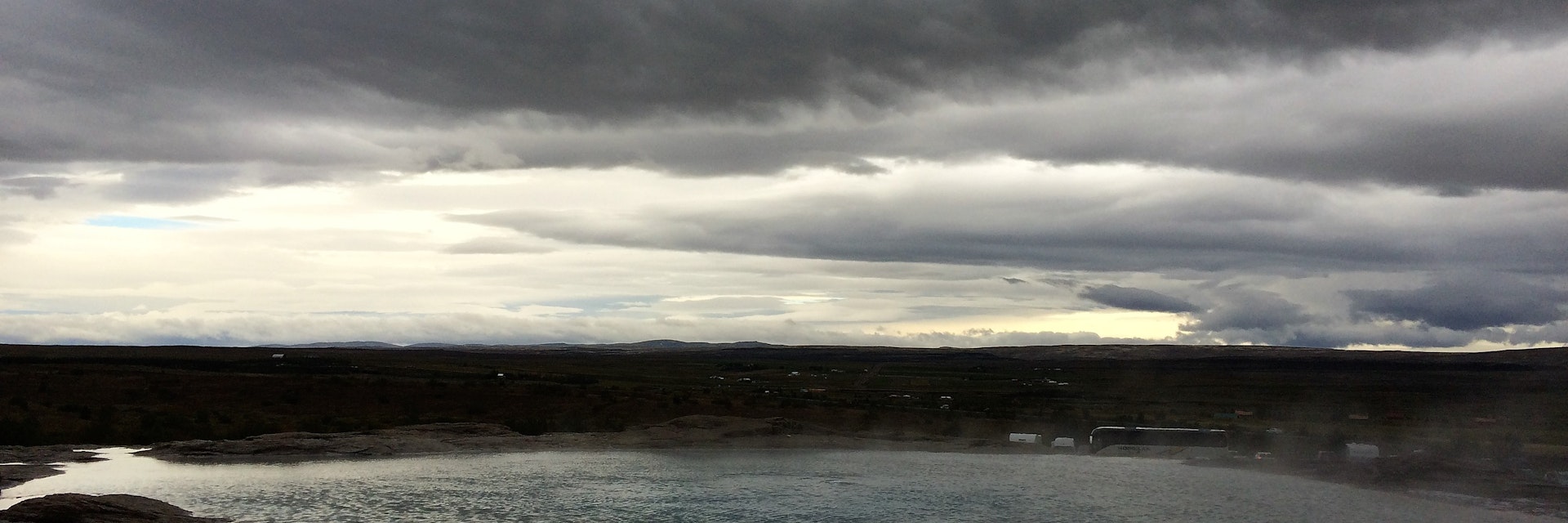
Top choice in The Golden Circle
One of Iceland’s most famous tourist attractions, Geysir (gay-zeer; literally ‘gusher’) is the original hot-water spout after which all other geysers are named. Earthquakes can stimulate activity, though eruptions are rare. Luckily for visitors, the very reliable geyser, Strokkur , sits alongside. You rarely have to wait more than five to 10 minutes for the hot spring to shoot an impressive 15m to 40m plume.
Discovered in the Haukadalur geothermal region , the Great Geysir has been active for perhaps 800 years, and once gushed water up to 80m into the air. But the geyser goes through periods of lessened activity, which seems to have been the case since 1916.
The undulating, hissing geothermal area containing Geysir and Strokkur was free to enter at the time of writing, though there have been discussions about introducing a fee.
Biskupstungnabraut
Lonely Planet's must-see attractions
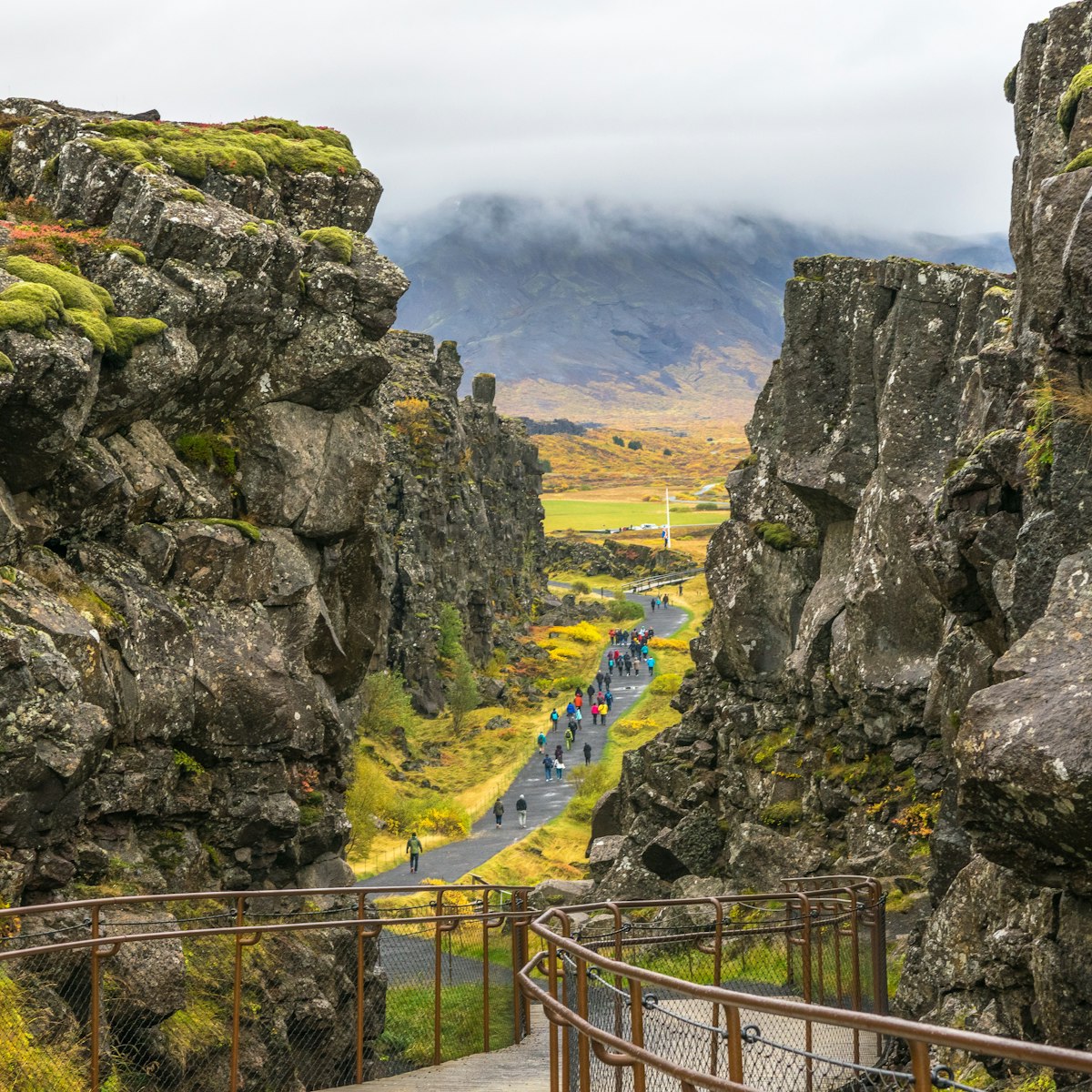
Þingvellir National Park
23.65 MILES
The world’s oldest parliament, Althingi (pronounced ál-thingk-ee; also called Alþing) was uniquely situated at this monumental site where two tectonic…
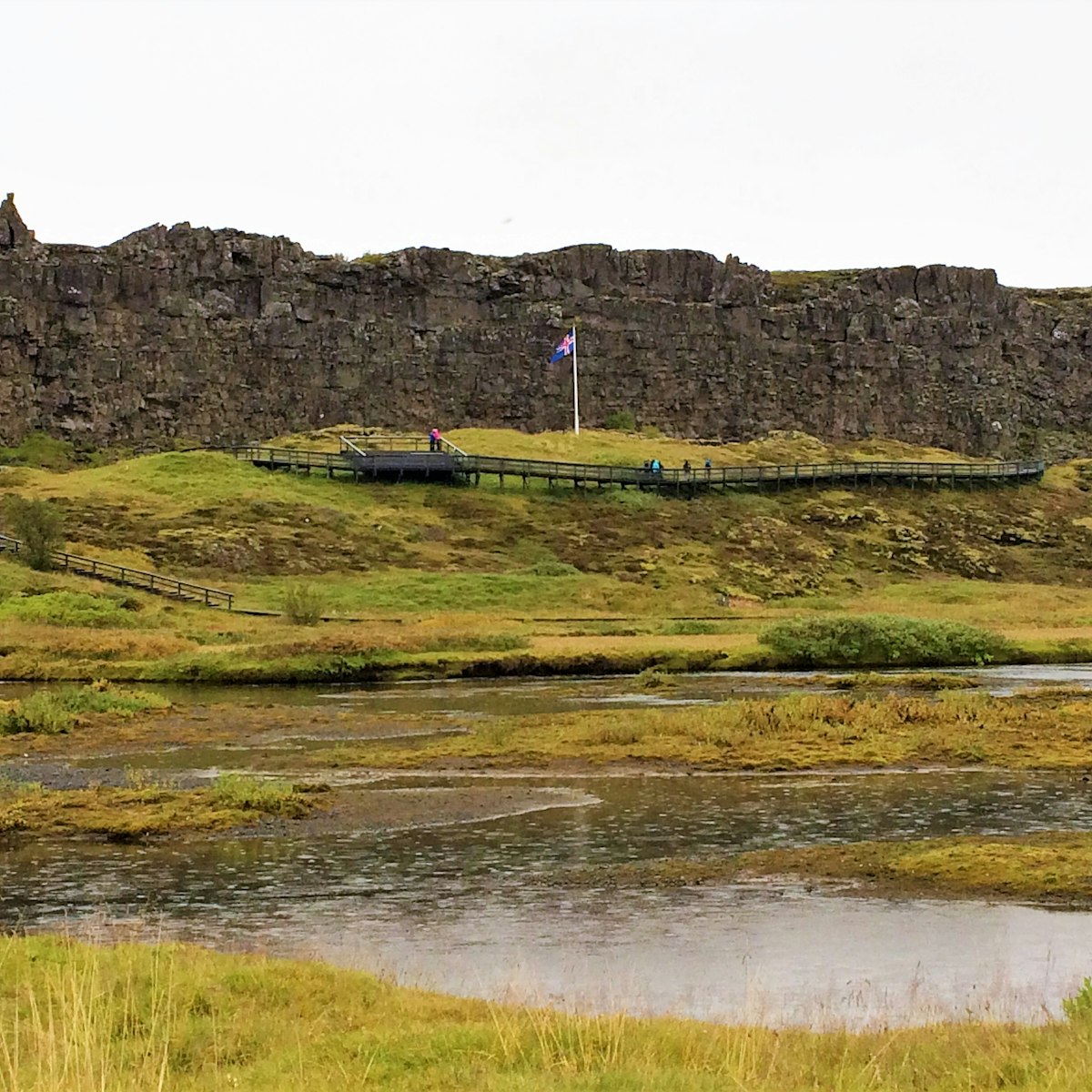
Alþingi Site
24.97 MILES
Near the dramatic Almannagjá fault and fronted by a boardwalk is the Lögberg (Law Rock), where the Alþingi (Parliament) convened annually. This was where…

Tectonic Plates
24.47 MILES
The Þingvellir plain is situated on a tectonic-plate boundary where North America and Europe are tearing away from each other at a rate of 1mm to 18mm per…
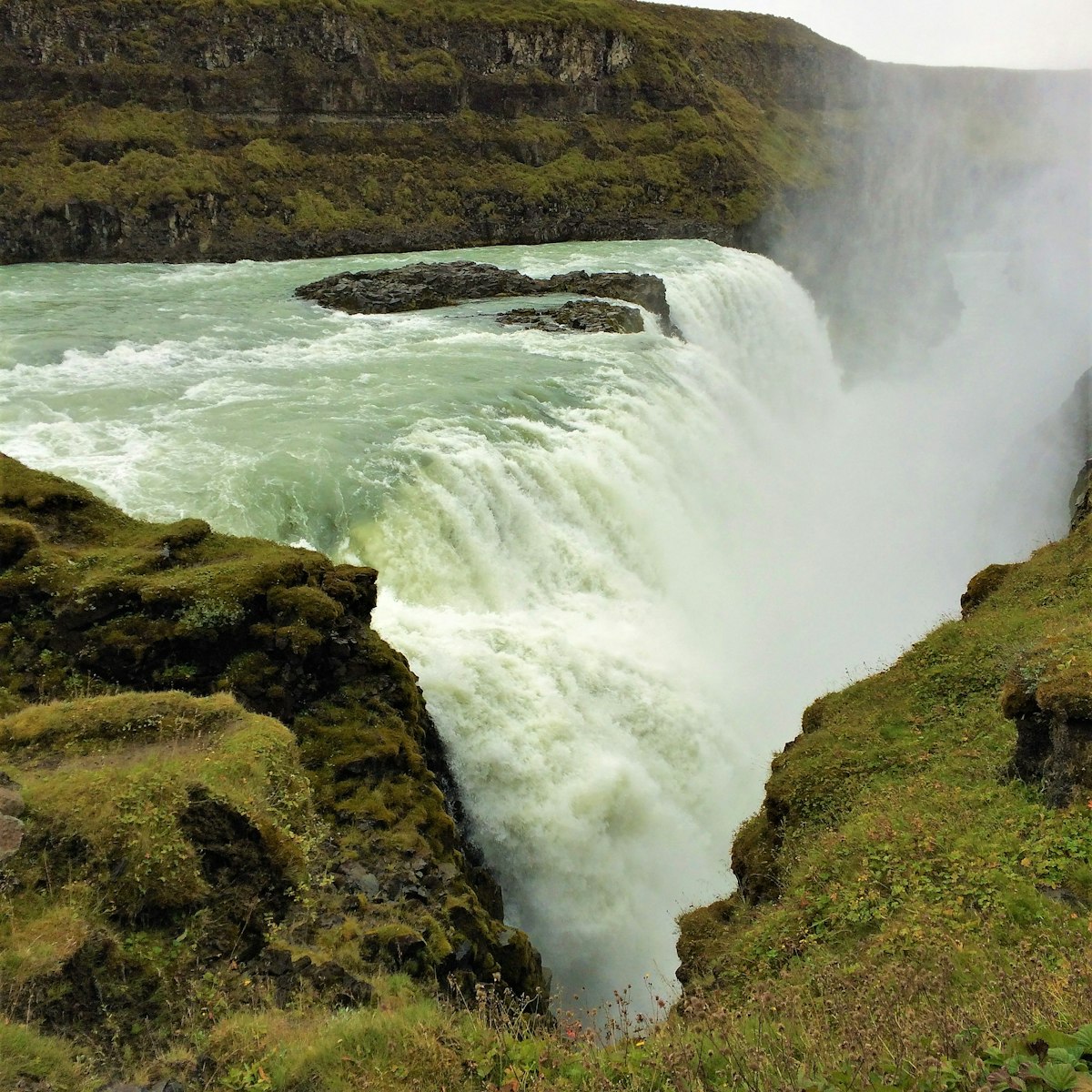
Iceland’s most famous waterfall, Gullfoss is a spectacular double cascade dropping a dramatic 32m. As it descends, it kicks up magnificent walls of spray…

Buried by white volcanic ash in 1104 during one of Hekla’s eruptions, this ancient farm once belonged to Gaukur Trandilsson, a 10th-century Viking who…

29.04 MILES
At the head of Hvalfjörður, and up Botnsdalur valley, lies Glymur, Iceland’s highest waterfall (198m). From the trailhead, it’ll take a couple of hours to…

22.87 MILES
The Langjökull ice cap is the second largest glacier in Iceland, and the closest major glacier to Reykjavík. It's accessed from the 4WD Kaldidalur or…

Iceland’s second-highest waterfall, Háifoss is a magnificent 128m-high cascade that plunges off the edge of a majestic plateau into an undulating lava…
Nearby The Golden Circle attractions
1 . Strokkur
Follow the path to where a circle of people is usually waiting in anticipation. They are here to see this magnificent geyser spurt water up to 40m in the…
2 . Gullfoss
3 . Skálholt Church
14.56 MILES
This modern church was built to replace the Skálholt cathedral, which was demolished by an earthquake in the 1700s. The museum in the basement tells the…
4 . Skálholt
14.57 MILES
For centuries (between 1056 to 1785) Skálholt was a political and cultural hub in Iceland, and one of only two areas overseen by bishops. In the wealthy…
5 . Slakki Petting Zoo
14.98 MILES
For more than 20 years, this petting zoo in small-town Iceland has been a popular hang-out for families passing through the village of Laugarás. Orphaned…
6 . Þjórsárstofa
18.71 MILES
The informative Þjórsárstofa, in a large white building, has an excellent display about the nearby attractions (crashing waterfalls and an atmospheric…
7 . Hjálparfoss
19.21 MILES
Twenty-six kilometres northeast of Árnes along Rte 32, take a short (1km) detour along a signposted track to this delightful waterfall. The azure falls…
8 . Þjóðveldisbærinn
19.66 MILES
Þjóðveldisbærinn is a reconstruction of Stöng, exactly reproducing its turf-covered layout and its neighbouring church. Staff here wear period dress and…
Iceland’s Geysir & Strokkur Hot Springs: A Complete Guide
Geysir Hot Spring Area is one of my favorite stops along Iceland’s Golden Circle. Less than 2 hours drive from Reykjavik, you can reach this remarkable landmark easily by driving a car or taking a Golden Circle day tour .
In this travel guide, I’ll share Haukadalur valley (the Geysir area) and useful information to plan your trip to Geysir and Strokkur.
Haukadalur geothermal area
The Haukadalur geothermal area has a surface area of approximately 3 km² and became active more than 1000 years ago.
It sits on the drifting outskirts of the Neovolcanic zone, resulting in sustained geothermal activities.
Haukadalur area boasts an abundance of hot springs and geysers, including the powerful Geysir, Strokkur, Smiður, and Litli-Strokkur. Therefore, it’s often known as Geysir hot spring area.
This valley of hot springs is also home to translucent blue pools, mud pots, and beautiful exotic-color mineral ponds.
Wandering around the area, you can spot several little geysers and small natural vents from which steam rises.
I was also amazed at the colorful ground dyed brightly with sulfur (yellow), copper (green), and iron (red).

The Great Geysir Iceland
Geysir, or the Great Geysir, is located in South-west Iceland, in the geothermal area of Haukadalur Valley.
The famous Geysir gives its name to other similar ones around the world. Its circular pool is 18 m (60 feet) in diameter and 1.2 m (4 feet) deep.
Geysir has been relatively inactive for many years, except for renewed activity in 2000 after an eruption at Mount Hekla.
While it’s rarely active, the water could reach up to 70 meters (230 feet) once it erupts.
The most active Geysir in Iceland is Strokkur, the main attraction in Haukadalur’s hot spring.
Strokkur erupts boiling water as high as 30 meters (100 feet) every few minutes, making it a remarkable scene.

What is the eruption time of Strokkur?
Strokkur usually spouts every 5 to 10 minutes between eruptions, and you may have to wait for 15 minutes on rare occasions.
As each burst can vary and the height of the spout can change, you should watch it a few times to see the highest one.
What are the signs of eruptions you should watch out for?
While the period varies, you can watch out for some signs. If the pool’s surface boils a little more tense than usual, it’s a sign of an eruption.

Does it cost to visit Geysir?
No. You don’t have to pay an entrance fee to visit the Haukadalur geothermal area. However, you should follow the tips below to have the best experience.
Tips to visit Geysir and Strokkur
I know it’s tempting to go near the geyser on your visit, but don’t!
The steam is very hot. You should stay within the marked area and stay away from the geyser when it erupts.
Also, don’t crowd Strokkur; always be careful when approaching hot springs or mud pots.
Stay on formal paths or established tracks. The ground may be treacherous, suddenly giving way beneath you.
Also, do not litter.

Best time to visit Geysir Geothermal Area
While the Geysir hot spring area opens every day, you should visit in the morning before 10 am or in the afternoon after 4 pm to avoid the crowd.
Also, for the best experience, you should avoid the high tourist season, which lasts from June to August. The geyser hot spring area will be filled with tourists most of the time.
Read more : Check out my article for the best time to visit Iceland .

Where are Geysir and Strokkur located?
Geysir is a prominent part of the Golden Circle along with Thingvellir National Park and Gullfoss Waterfall.
Geysir and Strokkur are located in Haukadalur valley, southwest of Iceland, on route 35. The GPS coordinate is 64.3104° N, 20.3024° W.
How to get to Geysir and Strokkur from Reykjavik?
You can get to Reykjavik’s Geysir hot spring area by bus or car.
You can take two routes from Reykjavík to Geysir: Route 36 and Road 1.
The common option is to take the Þingvallavegur route (route 36).
You’ll drive through Mosfellsdalur valley and past Thingvellir National Park. Continue east on Route 36, turn left on Route 365, and turn left on Route 37 at Lake Laugarvatn.
At the end of Route 37, turn left and take Route 35 northeast to Hótel Geysir, next to the hot springs.
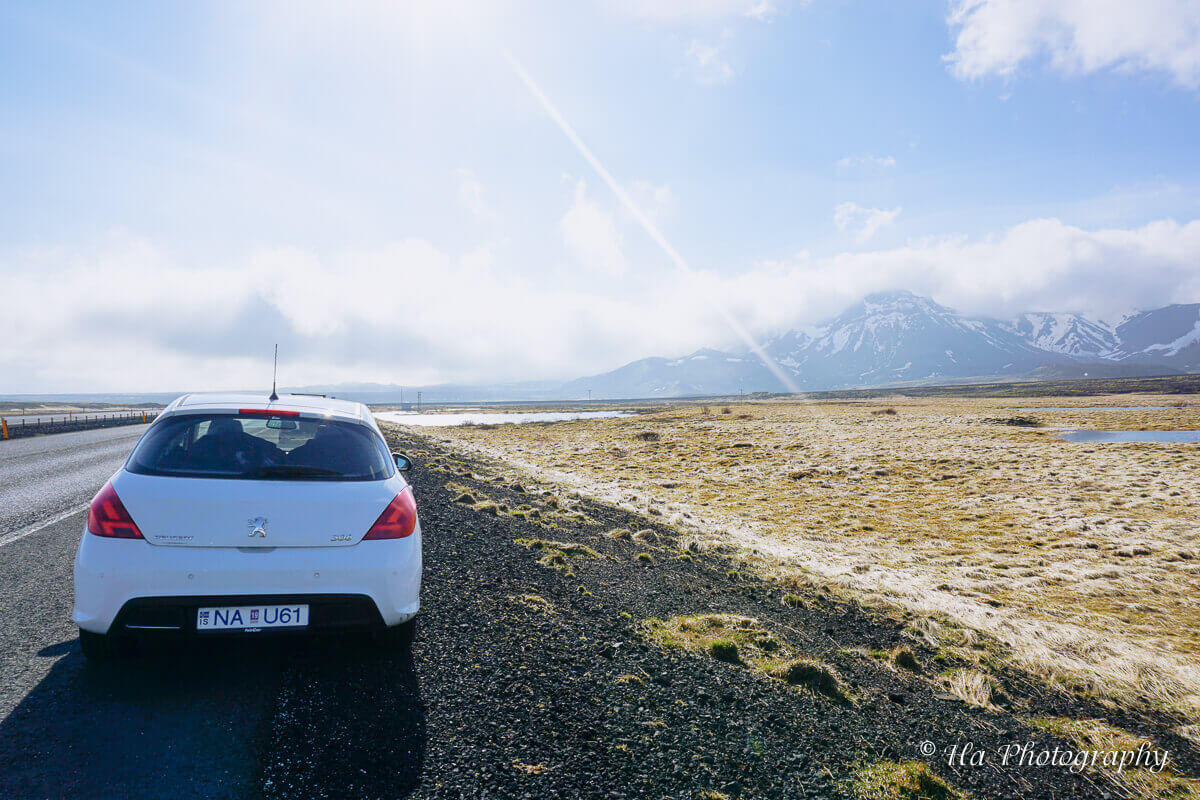
Road 1 (The ring road)
The second option is via Road 1. This route will take you past Hveragerði town. Before reaching Selfoss town, you should make a left turn onward to Lake Laugarvatn.
You’ll also drive past Kerið Volcanic Crater and Faxi waterfall as you follow road 35 the rest of the way.
Read more : You can read our car rental guide and Iceland driving tips to prepare for your trip. Check your car options here.
You can also get from Reykjavík to Geysir by bus. You can take Reykajvík Excursions’ “Iceland on Your Own” bus service between Reykjavík and Akureyri stops.
In summer, the bus departs daily at 8 am from the BSÍ bus terminal in Reykjavík. The journey takes about two hours, as the bus stops at major sites and waits 30 minutes so travelers can explore.
Places to stay near Geysir and Strokkur
Hotel geysir.
Located just across the road from the geyser, this four-star hotel is an excellent place to stay.
Hotel Geysir offers comfortable and bright rooms and suites with stunning views. The onsite restaurant serves a delicious breakfast and a buffet from noon till late.
Geysir Hestar
Geysir Hestar is a lovely horse farm near Gullfoss and Geysir, providing rooms and private cottages.
The rooms here are pretty small but cozy. The main guesthouse has a shared small kitchenette with complimentary tea and coffee and shared separate bathrooms and showers.
A cottage will be a better choice if you travel in a group. It is furnished with a small but fully equipped kitchen, a living room, a 2-bed bedroom, and a loft with four beds.
Camping sites near Geysir and Strokkur
Camping is an excellent way to spend a night in Iceland. You can find a few camping sites in the area.
Geysir Camping ground
You can find this campsite opposite the Geysir Centre, within walking distance.
- Facilities : It has Wifi, washing machines, toilets, shower facilities (500 ISK per shower), access to electricity (900 ISK), a golf course, and a kids’ play area.
- Price : It costs 1800 ISK/night per adult.
- Availability : It opens from the 15th of May to the 15th of September.
Skjól Camping Ground
Skjól site is located between Geysir and Gullfoss.
- Facilities : It has a restaurant, Wifi, washing machines, toilets, shower facilities (500 ISK per shower), electricity (1000 ISK/ day), a golf course, and wheelchair accessibility.
- Price : It costs 2000 ISK/night per adult.
- Availability : It is open all year.
Úthlíð Camping Ground
This camping ground is about 10 km (6.2 miles) from Geysir.
- Facilities : You’ll have cooking equipment, WCs, showers, electricity (1000 ISK), a golf course, a playground, and a swimming pool.
- Price : Expect to pay 1500 ISK/night per adult.
Best places to visit near Geysir
There are plenty of beautiful attractions to visit after Geysir.
A trip to Gullfoss is a must, as the waterfall is just about a 10-minute drive from Geysir. Also, you should visit nearby places such as:
- Thingvellir National Park
- Silfra Fissure
- Haukadalur Church
- The Secret Lagoon
- Kerið Volcanic Crater
- Faxi waterfall
- Laugarvatn town
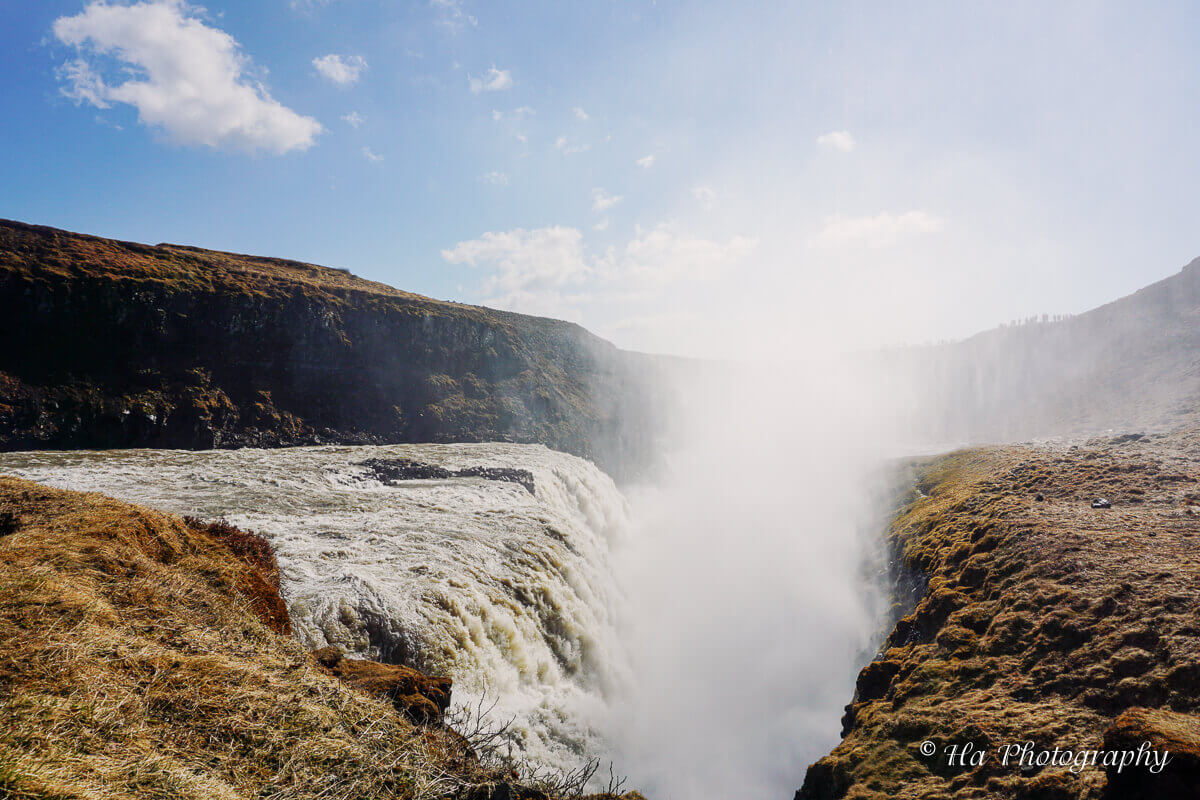
Ha is an avid traveler and writer with a background in marketing & hospitality. She's lived in a few countries and traveled to more than 30. When she's not traveling or writing, Ha loves trying new recipes.
Similar Posts
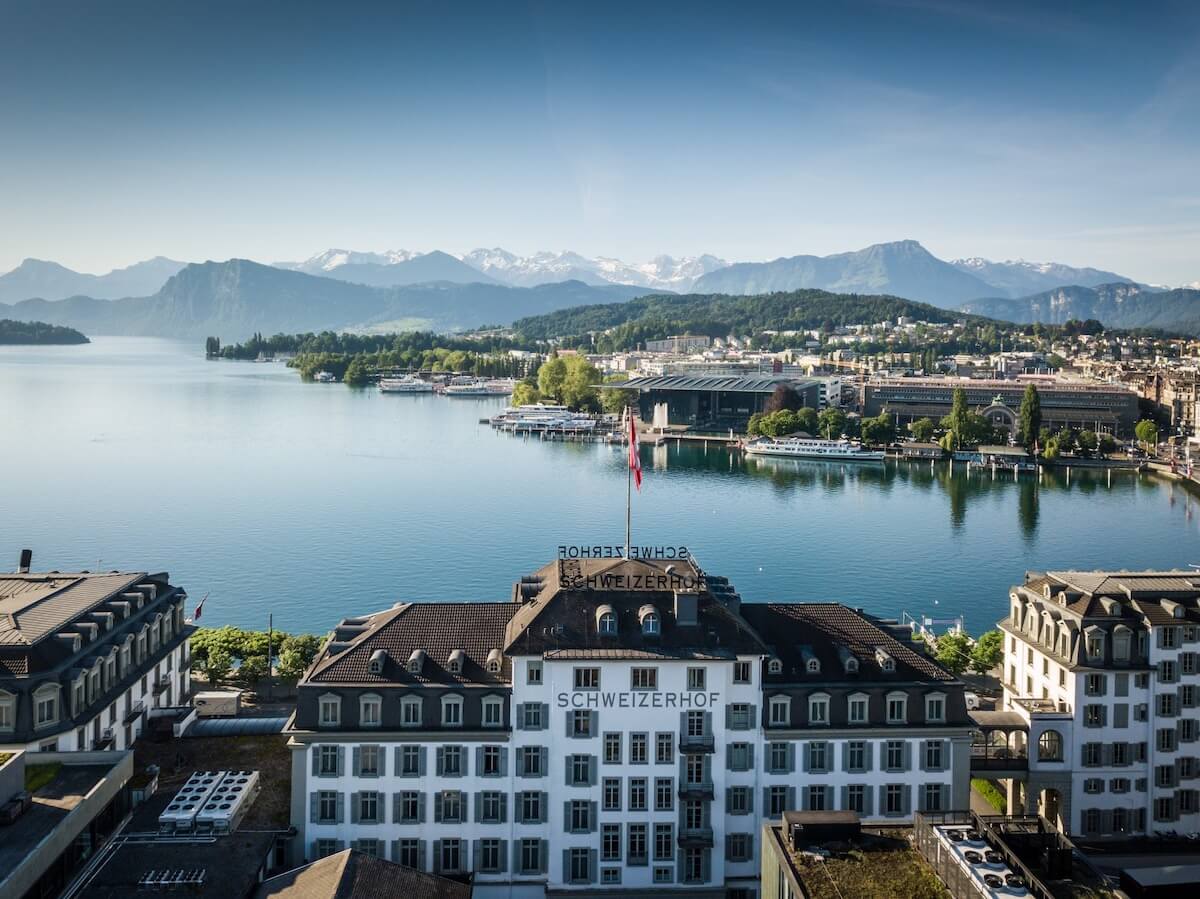
Where To Stay In Lucerne: Best Areas & Hotels
With its peaceful lakefront, historic architecture, and grand mountain views, it’s no wonder why many choose to make Lucerne their…
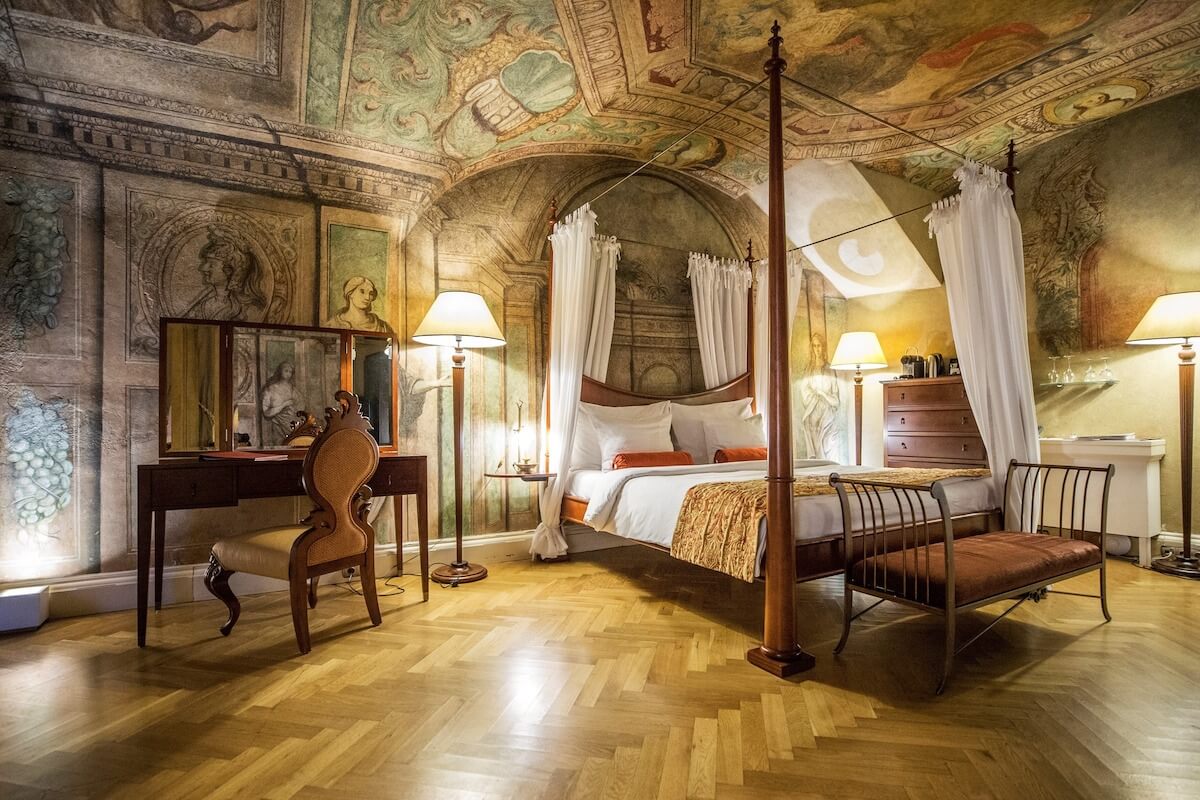
Where To Stay In Prague: Best Areas & Hotels
Where to stay in Prague? Home to stunning architecture and some of Europe’s best cuisine and nightlife, it’s no surprise…
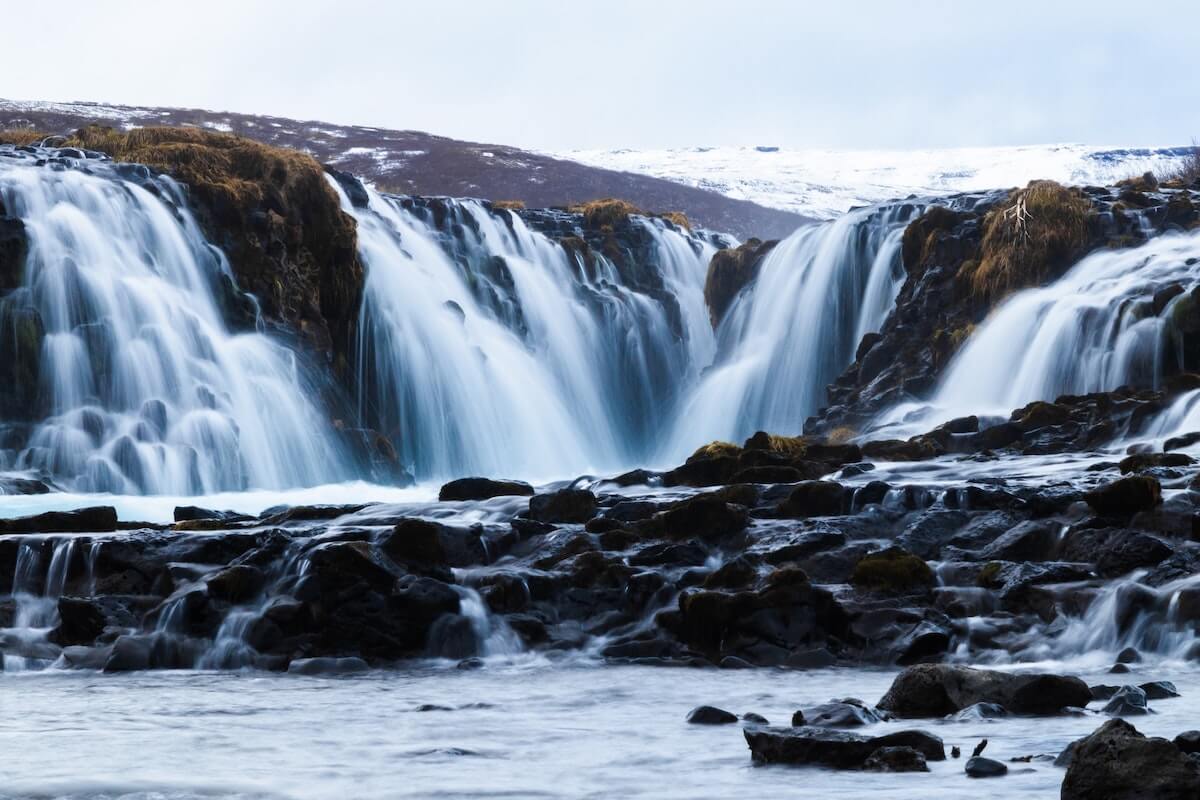
Useful Guide To Bruarfoss Waterfall, Iceland
Have you ever wanted to explore one of the most breathtaking waterfalls in Europe? Look no further than Bruarfoss Waterfall…
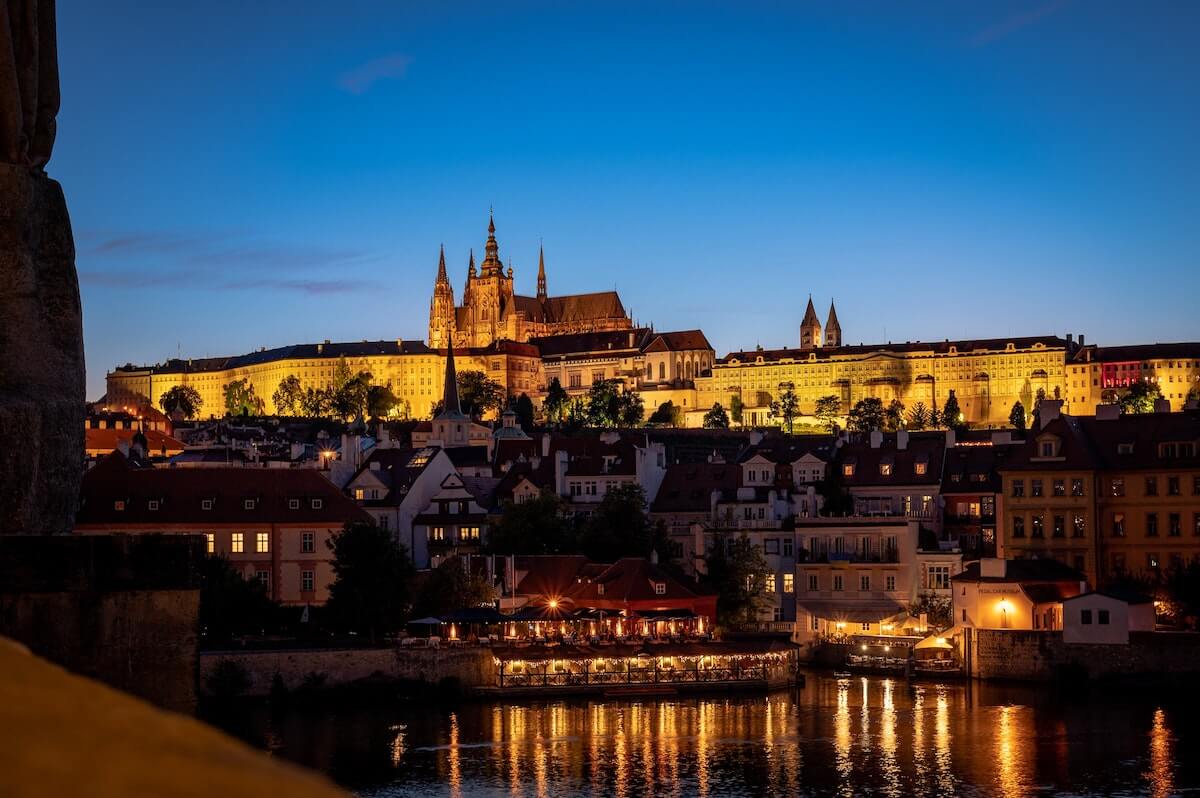
13 Best Things To Do At Night In Prague
From taking a romantic stroll along the Charles Bridge to dancing the night away in a bustling nightclub, there are…
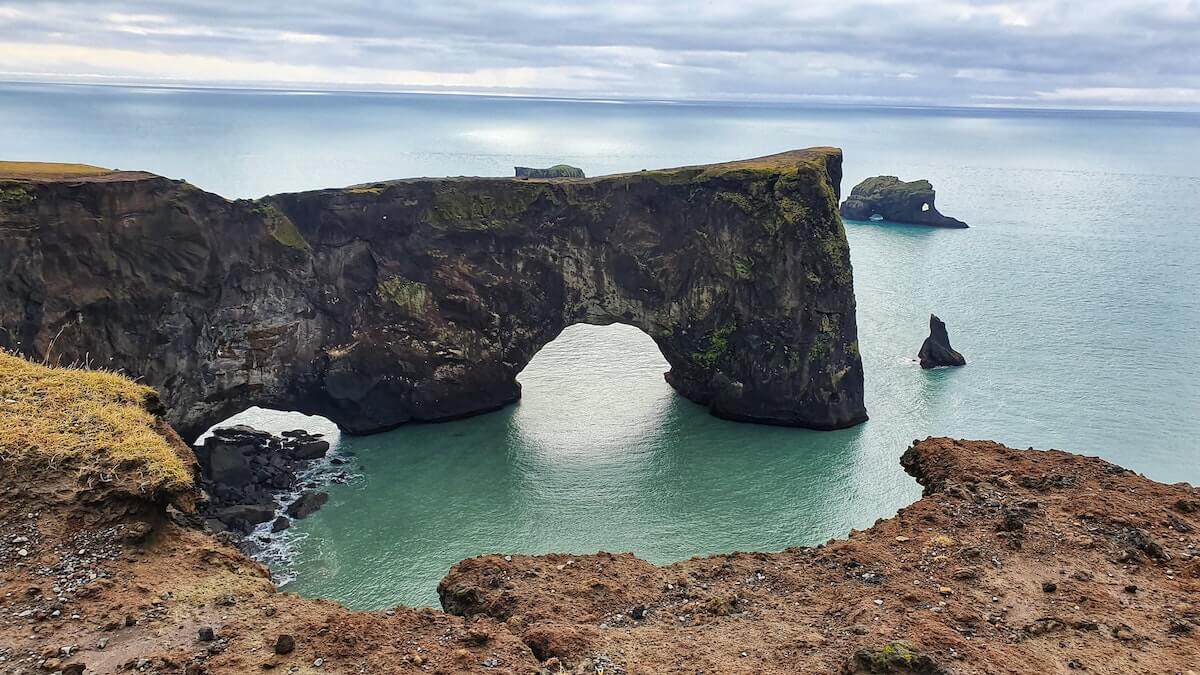
A Complete Guide To Dyrholaey, Iceland
From breathtaking ocean views to fascinating natural rock formations, Dyrhólaey is a must-see on your Iceland bucket list. In this…
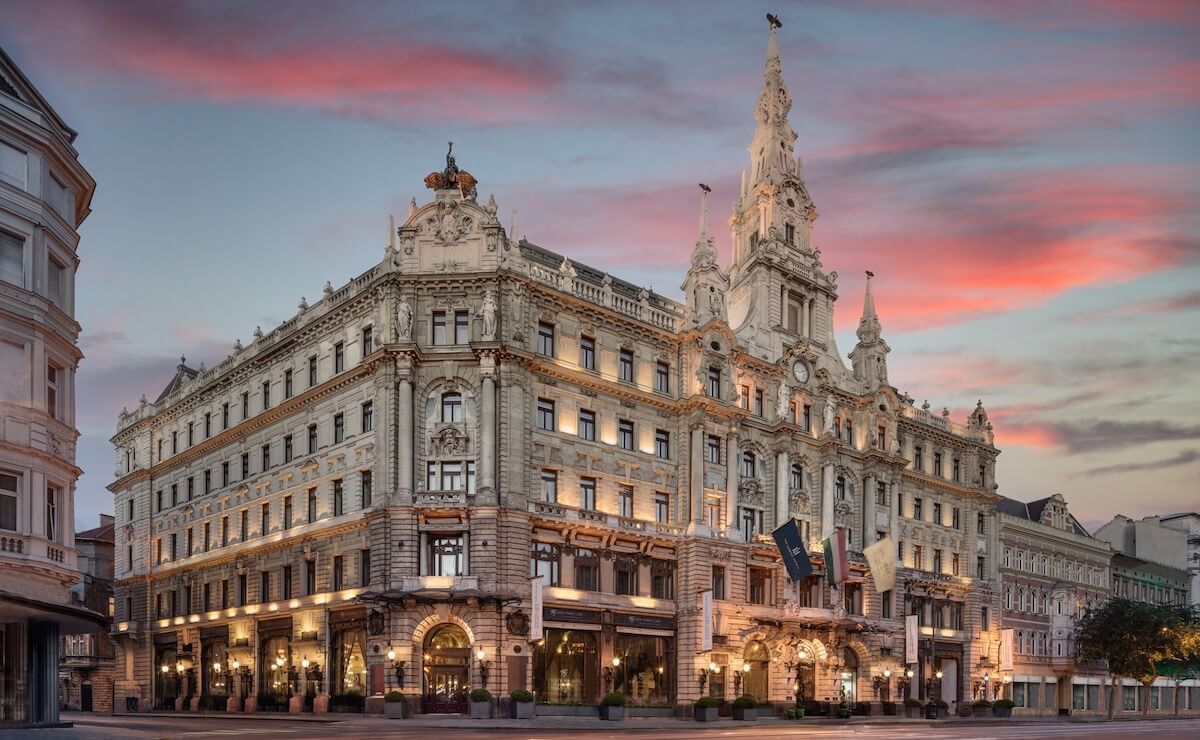
Where To Stay In Budapest: Best Areas + Hotels
Where to stay in Budapest? With so many options, it might seem impossible to narrow down the choices. In this…
Leave a Reply Cancel reply
Your email address will not be published. Required fields are marked *
Information about the volcanic eruption on the Reykjanes peninsula. Read updates here !
- Explore other regions:
- Travel Trade
Or try searching by Category and/or Location
Geysir Geothermal area
One of the greatest natural attractions of Iceland and part of the famous "Golden Circle Tour," The Great Geysir, or Stori-Geysir, has been dormant since 1916 when it suddenly ceased to spout. It came to life only once in 1935 and quickly went back to sleep. Since then, its repose has sporadically been disturbed by the dumping of tons of carbolic soap powder into its seething orifice to tickle it to spout.
It is not exactly known when Geysir was created. It is believed that it came into existence around the end of the 13th century when a series of strong earthquakes, accompanied by a devastating eruption of Mt. Hekla, hit Haukadalur. In this geothermal valley, Geysir is located. What is known is that it regularly spouted every third hour or so up to the beginning of the 19th century and, after that, progressively at much longer intervals until it completely stopped in 1916. Whether its silence is eternal or temporary, no one knows.
When it was alive and shooting, it could thunderously blast a spectacular jet of superheated water and steam into the air as high as 60 to 80 meters, according to different sources. Its opening is 18 meters wide and its chamber 20 meters deep. One reason for cessation is believed to be the accumulated rocks and foreign objects thrown into it by thousands of tourists throughout the years. Though definitely damaging, this could not be the only reason for its dormancy.
The Great Geysir was among the most notable geysers in the world, such as those in Yellowstone Park, New Zealand, and North Iceland. The English word "geyser" is derived from the Icelandic word "geysir," which means gusher. Though the Great Geysir itself is now more or less inactive, the area surrounding it is geothermically very active with many smaller hot springs.
The attraction of the area is now Strokkur (The Churn), another geyser 100 meters south of the Great Geysir, which erupts at regular intervals every 10 minutes or so, and its white column of boiling water can reach as high as 30 meters. The whole area is a geothermal park sitting on top of a vast boiling cauldron. Belching sulfurous mud pots of unusual colors, hissing steam vents, hot and cold springs, warm streams, and primitive plants can all be found here.
A short distance away to the west stands the small Laugarfjall Mountain with a panoramic view overlooking the Geysir area. King Christian IX of Denmark visited the area in 1874 and by the foot of the mountain are the rocks where he leaned while his hosts tried to impress and amuse him by boiling eggs in the hot springs. The rocks are now called Konungssteinar ("The King's Stones").
- N64° 18' 49.512" W20° 17' 58.160"
- Get directions
- Postal code: 806
- Road number: 36
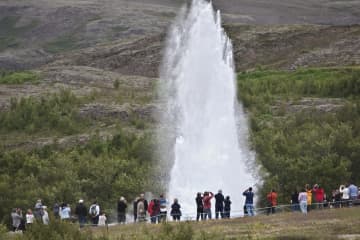
Litli Geysir Hotel
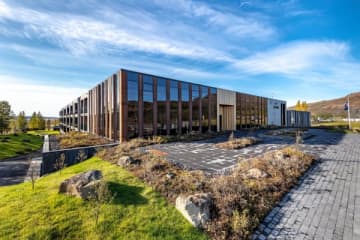
Hotel Geysir
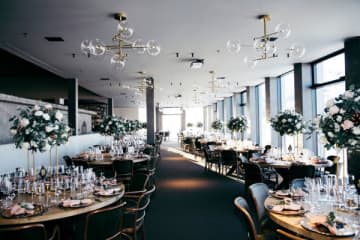
Geysir Restaurant
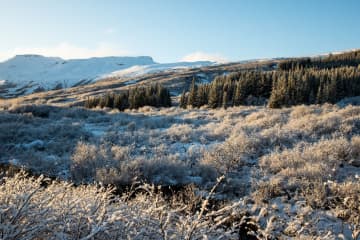
Haukadalsskógur Forest
Geysers of Iceland: Names, Facts, and Features
Iceland is the motherland of some of the most famous geysers in the world. In fact, the word geyser itself stems from the Old Norse word “geysa” which means “to gush” or “to rush forth.” Geysers are defined as hydrodynamic and thermodynamically unstable hot springs. Today, it is estimated that there are between 20 and 29 active geysers in Iceland and over 38 locations with extinct or dormant and sealed geysers. Some of the active geysers in iceland are small with infrequent water blasts, and others erupt violently and often. In Iceland, most geysers have short lifespans; they are activated by earthquakes or deactivated after tectonic movements close their vents. Currently, the tallest erupting geyser in Iceland is Strokkur (eruptions up to 40 meters in height). In the past, the first spot was taken by Geysir, which had 170-meters tall eruptions. However, in recent years, Geysir erupts infrequently with blasts that are only 10 meters tall.
Here is a list of the Geysers of Iceland:
- Strokkur (15-40 meters)
- Geysir (5-10 meters)
- Óþerrishola (3 meters)
- Álfaauga (1 meter)
- Gey 2 (1 meter)
- Blesi (1 meter)
- Konungshver
- Litli Geysir (10 meters)
- Litli Strokkur (9 meters)
- Smiður (3-5 meters)
- Stjarna (3.5 meters)
- Deildartunguhver (3 meters)
- Vellir (1 meter)
- Dynkur (Reykholt)
- Kópareykjahverir
- Skrifla (Reykholt)
- Sturlureykjahver
- Bræðrahver (1 meter)
- Gjósandi (0.5 meters)
- Grænihver (3 meters)
- Nýi Strokkur (1 meter)
- Bræðraauga (3 meters)
- Eyvindarhver (0.5 meters)
- Gamli Fagrihver (45 meters)
- Gamli Strokkur (45 meters)
- Rauðihver (1.5 meters)
- Ystihver (3 meters)
- Syðstihver (3 meters)
- Leppaluði borehole
- Önnuhver (Ruslahver)
- Spýtir (0.2-0.5 meters)
1. Strokkur
Strokkur Geyser in Iceland is located in the southwest. The Strokkur Geyser’s coordinates are 64.3127° N, 20.3007° W . Strokkur is a fountain type of geyser that forms small blue water bulbs before erupting, which it does every 6 to 10 minutes. With eruptions as high as 15 to 40 meters, Strokkur is the tallest geyser in Iceland and the most popular. In the past, Strokkur’s water eruptions were up to 60 meters high. Interestingly, Strokkur was first mentioned in 1789 after an earthquake unblocked its conduit. Tours and Tour Guides for the Strokkur Geyser in Iceland are available. Many tourists visit the Haukadalur Geothermal Field to see the spectacular Strokkur Geyser.
Geysir Geyser (also known as the Great Geyser) in Iceland is located in the southwest. The Geysir Geyser’s coordinates are 64.3104° N, 20.3024° W. In the past, Geysir used to be the tallest geyser with eruptions tall between 120 and 170 meters. Today, Geysir rarely erupts with water eruptions as high as 5 to 10 meters. The Geysir Geyser is more active after earthquakes. Tours and Tour Guides for the Geysir Geyser in Iceland are available. Geysir was the first known geyser to modern Europeans and the first one to be described in printed materials. It also gave the name to all other geysers in the world.
3. Óþerrishola
Óþerrishola Geyser (also known as Rainmaker) in Iceland is located in the south. The Óþerrishola Geyser’s coordinates are 64.3125° N 20.3040° W . Óþerrishola is an unusual thermal spring. Most of the time, it is a calm water pool with a small 25-centimeters in diameter conic sinter shield and a seemingly endless 108-meters deep hole in the center. However, before it starts raining as the atmospheric pressure drops, Óþerrishola turns into a fervent geyser with eruptions as high as 3 meters. Once the rain is over, the geyser returns to its calm and silent state. Tours and Tour Guides for the Óþerrishola Geyser in Iceland are available.
4. Álfaauga
Álfaauga Geyser in Iceland is located in the southwest . Álfaauga features intense blue springs, and the geyser rarely erupts. However, in recent years the Álfaauga Geyser has been more active with water eruptions up to one meter in height. Tours and Tour Guides for the Álfaauga Geyser in Iceland are available.
Gey 2 Geyser in Iceland is located in the southwest . Today, the geyser erupts up to one meter in height. The eruption could be taller if soap is added, but this is not allowed. Tours and Tour Guides for the Gey 2 Geyser in Iceland are available.
Blesi Geyser (known as the Blazer) in Iceland is located in the southwest. The Blesi Geyser’s coordinates are 64.3134° N, 20.3012° W . In the past, Blesi gave water eruptions up to one meter in height. Today, Blesi is dormant and beautiful looking. It consists of two ponds separated by a narrow wall. The temperature within the Blesi pond reaches up to 100 degrees Centigrades. Tours and Tour Guides for the Blesi Geyser in Iceland are available. Early settlers used to wash their clothes in the small but hot Blesi water.
Fata Geyser (known as the Bucket or Pail) in Iceland is located in the southwest. Fata is an irregular and now dormant geyser with a characteristically striking blue color. Its eruptions were several meters tall. Fata was quite active following the earthquakes in June 2000, but the activity stopped completely in 2004. Tours and Tour Guides for the Fata Geyser in Iceland are available.
8. Konungshver
Konungshver Geyser (King’s Hot Spring ) in Iceland is located in the southwest of the island. The Konungshver Geyser’s coordinates are 64.3141 ° N, -20.3036 ° W. Konungshver was activated after the earthquakes in 1896, and its activity stopped one year later. While it was active, it gave water eruptions of more than one meter. Following the earthquakes in 2000, the water in the Konungshver Geyser started boiling. The vent of the Konungshver Geyser is covered with boulders which might be preventing its activity. Tours and Tour Guides for the Konungshver Geyser in Iceland are available.
9. Litli Geysir
Litli Geysir (the Small Geyser) in Iceland is located in the southwest. The Litli Geysir’s coordinates are 64.3113° N, 20.2964° W . Until the late 19th century, Litli Geysir was active and resulted in noisy, violent, and feathery eruptions up to 10 meters tall. Today, it classifies as a weak and perpetual spouter. Tours and Tour Guides for the Litli Geysir in Iceland are available.
10. Litli Strokkur
Litli Strokkur (the Small Churn) in Iceland is located in the southwest of the country. In the past, Litli Strokkur gave 9-meters tall and powerful eruptions but today it is inactive. Tours and Tour guides for the Litli Strokkur Geyser in Iceland are not available.
11. Seyðirinn
Seyðirinn Geyser (the Boiler) in Iceland is located in the southwest. Seyðirinn is a dormant geyser in the form of a fumarole. In theory, it could be reactivated with soap, but that is not allowed. If reactivated, it is expected to give very tall, fountain-like eruptions. Tours and Tour Guides for the Seyðirinn Geyser in Iceland are not available.
12. Sísjóðandi
Sísjóðandi Geyser (the Eternally Boiling) in Iceland is located in the southwest of the country. The Sísjóðandi Geyser’s coordinates are 64.3107° N, 20.3024° W . Sísjóðandi is a permanent spouter and boiling mud-pot with some geyser-like characteristics. Its hot water was used for washing clothes before, but today it is used to heat the nearby hotel . Tours and Tour Guides for the Sísjóðandi Geysir in Iceland are not available.
Smiður Geyser (the Carpenter) in Iceland is located in the southwest of the country. The Smiður Geyser’s coordinates are 64.5557 ° N, 21.9008° W. Smiður is an artificially dug boiling spring with no geyser activity. Tours and Tour Guides for the Smiður Geyser in Iceland are not available.
Sóði Geyser (the Messy One) in Iceland is located in the southwest. Sóði is an inactive geyser that was first spouted in 1940. If reactivated with soap, it can give 20-meters tall eruptions. Tours and Tour Guides for the Sóði Geyser in Iceland.
15. Stjarna
Stjarna Geyser (the Star) in Iceland is located in the southwest. Stjarna formed in 1896 after an increased earthquake activity and disappeared afterward. Today, the Stjarna Geyser is classified as extinct. Tours and Tour Guides for the Stjarna Geyser are not available.
16. Deildartunguhver
Deildartunguhver Geyser in Iceland is located in the west. The Deildartunguhver Geyser’s coordinates are 64.6646° N, 21.4112° W. Deildartunguhver is the largest spring in Iceland and a constantly boiling source of geysers and spouters. With an average discharge of 180 liters per second, Deildartunguhver is the most powerful thermal spring globally . The height of its eruptions was 4 meters in the past and has now decreased to 3 meters. Tours and Tour Guides for the Deildartunguhver Geyser in Iceland are available.
Vellir Geyser (also known as Árhver ) in Iceland is located in the west. The Vellir Geyser’s coordinates are 64.0452° N, 21.9753° W . Vellir is unique because it is located on a small island within the Reykjadalsá River . In the past, the eruptions of the Vellir Geyser were up to 11 meters tall. Today, Vellir is almost dormant, with eruptions barely one meter in height (could reach 2 meters if soap is added). Tours and Tour Guides for the Vellir Geyser in Iceland are available.
18. Dynkur (Reykholt)
Dynkur Geyser in Iceland is located in the west. The Dynkur Geyser’s coordinates are 64.6642° N, 21.2883° W. Today, Dynkur is under a concrete lid and most likely dormant underneath the cover. Tours and Tour Guides for the Dynkur Geyser in Iceland are not available.
19. Kópareykjahverir
Kópareykjahverir Geyser in Iceland is located in the west. Kópareykjahverir is now dormant. Tours and Tour Guides for the Kópareykjahverir Geyser in Iceland are not available.
20. Skrifla (Reykholt)
Skrifla Geyser in Iceland is located in the west. The Skrifla Geyser’s coordinates are 64.6645° N, 21.2892° W. Today, Skrifla is under a concrete lid and stones and most likely dormant. Tours and Tour Guides for the Skrifla Geyser in Iceland are not available.
21. Strokkur
Strokkur Geyser in Iceland is located in the west. The Strokkur Geyser’s coordinates are 64.6978° N, 21.2419° W. Strokkur is now a dormant geyser. Tours and Tour Guides for the Strokkur Geyser in Iceland are not available.
22. Sturlureykjahver
Sturlureykjahver Geyser in Iceland is located in the west. Sturlureykjahver is now extinct. Tours and Tour Guides for the Sturlureykjahver Geyser in Iceland are not available.
23. Bræðrahver
Bræðrahver Geyser in Iceland is located in the Central Highlands. The Bræðrahver Geyser’s coordinates are 64.8650° N 19.5584° W. Bræðrahver is a spouter with a sinter cone and geyser-like features. Up until 1888, Bræðrahver gave 3-meters tall eruption, and today its water blasts do not exceed more than one meter. In recent years, the spring is closing and will probably disappear. Tours and Tour Guides for the Bræðrahver Geyser in Iceland are available.
24. Gjósandi
Gjósandi Geyser in Iceland is located in the Central Highlands. The Gjósandi Geyser’s coordinates are 64.8656° N 19.5593° W. Gjósandi used to give more violent and noisy eruptions, but today its strength is decreased, giving half a meter water blasts. Tours and Tour Guides for the Gjósandi Geyser in Iceland are available.
25. Grænihver
Grænihver Geyser in Iceland is located in the Central Highlands. The Grænihver Geyser’s coordinates are 64.8651° N 19.5583° W. Grænihver is the largest geyser in the Hveravellir Geothermal Field. Grænihver features a turquoise pool which is calm most of the time, and when it erupts, it gives water blasts of up to 3 meters. Tours and Tour Guides for the Grænihver Geyser in Iceland are available.
26. Nýi Strokkur
Nýi Strokkur Geyser in Iceland is located in the Central Highlands. Nýi Strokkur is a spouter with geyser-like characteristics. The eruptions of Nýi Strokkur reach up to one meter in height. Tours and Tour Guides for the Nýi Strokkur Geyser in Iceland are not available.
27. Bræðraauga
Bræðraauga Geyser in Iceland is located in the Central Highlands. Bræðraauga is the dormant twin to the still active Bræðrahver . In its active days, Bræðraauga erupted up to 3 meters in height. Tours and Tour Guides for the Bræðraauga Geyser in Iceland are not available.
28. Eyvindarhver
Eyvindarhver Geyser in Iceland is located in the Central Highlands. The Eyvindarhver Geyser’s coordinates are 64.8650° N 19.5594° W. Eyvindarhver used to be powerful, but in 1930 it calmed down, and today it is extinct. Tours and Tour Guides for the Eyvindarhver Geyser in Iceland are not available.
29. Gamli Fagrihver
Gamli Fagrihver Geyser in Iceland is located in the Central Highlands. Until the 1930s, Gamli Fagrihver was a powerful geyser erupting up to 45 meters in height. Today, Gamli Fagrihver is a large sinter cone filled with almost boiling water (95 degrees Centigrade). Tours and Tour Guides for the Gamli Fagrihver in Iceland are available.
30. Gamli Strokkur
Gamli Strokkur Geyser in Iceland is located in the Central Highlands. Gamli Strokkur had 45-meters tall eruptions until the 19th century, but today it is extinct and not detectable at all. Tours and Tour Guides for the Gamli Strokkur Geyser in Iceland are not available.
31. Rauðihver
Rauðihver Geyser in Iceland is located in the Central Highlands. The Rauðihver Geyser’s coordinates are 64.8650° N 19.5591° W. Rauðihver used to be an intermittent hots spring which in the period between 2008 and 2009 started erupting 1.5-meters tall blasts or orange-colored, muddy water and turned into a geyser. Tours and Tour Guides for the Rauðihver Geyser in Iceland are available.
32. Ystihver
Ystihver Geyser in Iceland is located in the north. In fact, Ystihver is the northernmost geyser in the world. As a fountain-type of geyser, it has a massive sinter cone with a 10-meters diameter. In the past, Ystihver erupted rarely. However, in 1904 its water levels were increased by carving canals, which resulted in Ystihver erupting every few minutes with blasts between 15 and 25 meters tall. Later, in 1970 a borehole managed these eruptions, and today, the Ystihver Geyser gives less frequent 3-meters tall eruptions. Tours and Tour Guides for the Ystihver Geyser in Iceland are available.
33. Uxahver
Uxahver (Hot Spring of Ox) in Iceland is located in the north. The Uxahver Geyser’s coordinates are 65.8855° N, 17.3102° W. During the 19th century, Uxahver was one of the most powerful geysers, giving 9-meters tall eruptions every couple of minutes. In 1872 a massive earthquake destroyed most of the houses in the area and put the Uxahver geyser in a calm state. In 1900 it suddenly became active again, but in 1970 it was covered with concrete to redirect the hot water for greenhouses. Tours and Tour Guides for the Uxahver Geyser in Iceland are not available.
34. Syðstihver
Syðstihver Geyser in Iceland is located in the north. The Syðstihver Geyser’s coordinates are 65.8832 ° N 17.3099 ° W. Syðstihver had two openings and erupted simultaneously from both of them giving water blasts up to 9 meters in height. Later on, the eruptions decreased in size and strength, and today, Syðstihver is in a dormant state. Tours and Tour Guides for the Syðstihver Geyser in Iceland are not available.
Grýla Geyser in Iceland is located in the southwest . The Grýla Geyser’s coordinates are 64.0094° N 21.1901° W. Grýla was active until the 1970s and today are dormant and extinct. Tours and Tour Guides for the Grýla Geyser in Iceland are not available.
36. Leppaluði borehole
Leppaluði borehole Geyser in Iceland is located in the southwest . The Leppaluði borehole Geyser’s coordinates are 65.8867° N 17.3084° W. Leppaluði borehole is an artificial spouter which in 2007 resulted in 10 to 12 meters tall eruptions. Tours and Tour Guides for the Leppaluði borehole Geyser in Iceland are unavailable .
37. Önnuhver (Ruslahver)
Önnuhver Geyser in Iceland is located in the southwest. Önnuhver was activated in 1947 after an earthquake. Interestingly, its eruption threw out all of the garbage that was thrown inside. Tours and Tour Guides for the Önnuhver Geyser in Iceland are not available.
Spýtir Geyser in Iceland is located in the southwest. Spýtir was a bubbling basin with up to 5 centimeters wide bubbles, filled with superheated water, and surrounded by smaller geysers. Today, Spýtir is relatively calm and inactive. Tours and Tour Guides for the Spýtir Geyser in Iceland are not available.
Svaði Geyser in Iceland is located in the southwest. Svaði used to be one of the more powerful geysers in Iceland, erupting muddy waters up to several meters in height. Today, Svaði is an extinct geyser. Tours and Tour Guides for the Svaði Geyser in Iceland are not available.
What are the Fields that have numerous Geysers?
In Iceland, there are five main geothermal fields and areas. Here is a list of those areas.
- Haukadalur Geothermal Area
- Deildartunguhver and Surrounding Areas
- Hveravellir Geothermal Field
- Hveravellir (Husavik) Geothermal Field
- Geothermal Areas Around HveragerðI Town.
1. Haukadalur Geothermal Area
The Haukadalur Geothermal Area in Iceland is located in the southwest of the country. The 6 square kilometers field is home to some of the most popular and beautiful geysers not just in Iceland but in the world. The most well-known geysers in the area are Strokkur and Geysir, but there are over 40 other geothermal features.
2. Deildartunguhver and Surrounding Areas
Deildartunguhver and Surrounding Areas are located in the western parts. In addition to thermal springs and fountain-like geysers, the area is famous for its waterfalls, Hraunfossar and Barnafoss. The field has only two active geysers at the moment ( Deildartunguhver and Vellir ) and several dormant ones.
3. Hveravellir Geothermal Field
The Hveravellir Geothermal Field is located in the Icelandic Central Highlands. The beautiful field is a popular tourist attraction and home to some of the most spectacular geysers and hot springs such as Gjósandi, Öskurhóll, Fagrihver, Bræðrahver, Grænihver, and Rauðihver.
4. Hveravellir (Husavik) Geothermal Field
Hveravellir (Husavik) Geothermal Field is in the northeast of the island . Today, the field has only one active geyser, Ystihver, which is also the northernmost geyser in the world. The other geysers in the field are either dormant or covered with concrete, such as the case with Uxahver.
5. Geothermal Areas Around HveragerðI Town
The HveragerðI field is a relatively small area in the southwest of the country. It is named after the nearby town, which is popularly known as “the Earthquake Town” or “the Hot Spring Town.” The small field is geothermally active and marked by the presence of many volcanic hot springs and geysers.
Which Region of Iceland does have the most Geysers?
The southwest region of Iceland has the most geysers. More precisely, the geysers are spread across several Iceland regions , starting from southwest to northeast. Basically, the Iceland geysers form a belt that marks the boundary between the Eurasian Tectonic Plate and North American Tectonic Plate.
What are the facts about Geysers in Iceland?
Geysers are short-lived in Iceland – they are either formed after earthquakes or fueled by seismic activity and then go into dormant states. At the moment, there are between 20 and 29 active geysers spread throughout the country. There are also 38 known locations where geysers existed in the past. Interestingly, most of the geysers that are still active mark less prominent eruptions, and geysers that were once over 100 meters tall today give water blasts that are only a couple of meters in height. However, Iceland remains a popular destination for tourists, and geysers and hot springs are a significant contributing factor. Each year, geysers and other landmarks and sites attract over 2.000.000 visitors.
How many Geysers are there in Iceland?
In Iceland, there are 20-29 active geysers and around 38 locations with dormant or now extinct geysers. The geysers are spreading in a belt-like form, starting in the southwest up until the northeast.
What is the biggest Geyser in Iceland?
The biggest geyser in Iceland is Strokkur. Its eruptions are between 15 and 40 meters tall, noisy, and violent. In the past, Strokkur resulted in higher eruptions, up to 60 meters in height. Strokkur is located in the southwest and is among the most popular geysers in the world. Strokkur’s hallmark is the deep blue bulbs of water that boil before eruptions.
What are the Active Geysers in Iceland?
The active geysers in Iceland are Strokkur, Geysir, Óþerrishola, Álfaauga, Gey 2, Deildartunguhver, Vellir, Bræðrahver, Gjósandi, Grænihver, Grænihver, Nýi Strokkur, Ystihver, Uxahver, and Spýtir.
What are the Passive Geysers in Iceland?
The passive geysers in Iceland are Blesi, Fata, Konungshver, Litli Geysir, Litli Strokkur, Seyðirinn, Sísjóðandi, Smiður, Sóði, Stjarna, Dynkur (Reykholt), Kópareykjahverir, Skrifla (Reykholt), Strokkur, Sturlureykjahver, Bræðraauga, Eyvindarhver, Gamli Fagrihver, Gamli Strokkur, Rauðihver, Syðstihver, Grýla, Leppaluði borehole, Önnuhver (Ruslahver), and Svaði.
What are the Settlements near Geysers in Iceland?
There are many Icelandic cities and settlements near geysers. For example, there are several geysers within proximity of Iceland’s capital Reykjavik . Strokkur, the largest geyser in Iceland, is one of the three attractions on the popular Golden Circle route (together Gullfoss Waterfall and the Þingvellir National Park ) and close to the capital. Also, some of the most historic farms like Reykholt, Útey, Hveragerði, Syðri Reykir have developed near geysers.
What is the prominence of Geysers for Iceland’s Geography?
Geysers have a beneficial impact on the Icelandic economy in two ways. First, they are a source of heat, and second, they attract tourists. However, there are also some side effects to geysers. Namely, they prevent certain areas from being industrialized.
What are the Benefits of Hot Springs in Iceland?
The benefits of Hot Springs can be classified into two main categories, economic benefits, and health benefits. The group of economic benefits includes the use of geysers as heat sources and the attraction of tourists. On the other hand, the group of health benefits includes relaxation, rejuvenation, improved circulation, eczema treatment, musculoskeletal pain relief, etc.
What are the Spa Tours in Iceland?
Spa Tours In Iceland are popular not just for tourists but locals as well. There are many different spa tours – some longer and with heftier price tags and others short and more affordable. In general, such spa tours have prices that start at around $50.
Related Posts
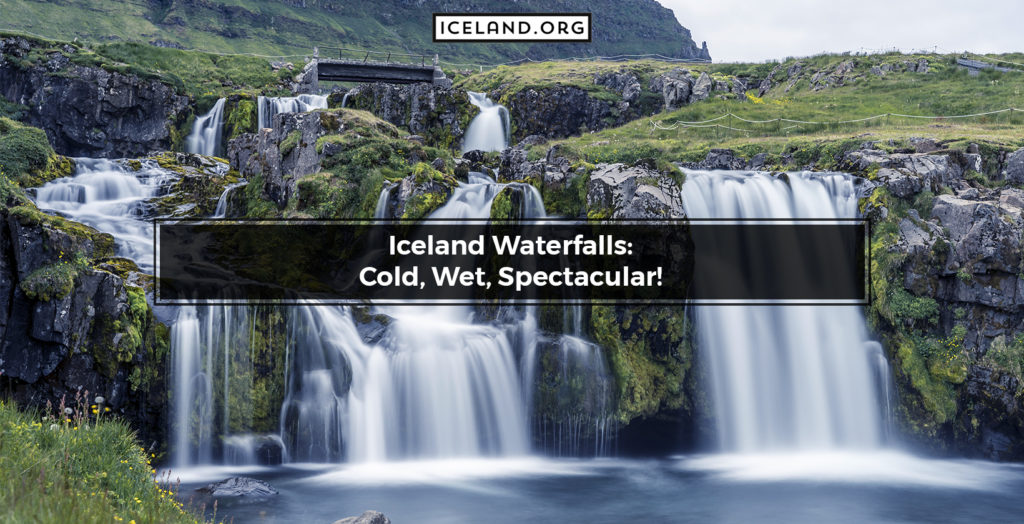
Iceland Waterfalls: Cold, Wet, Spectacular!
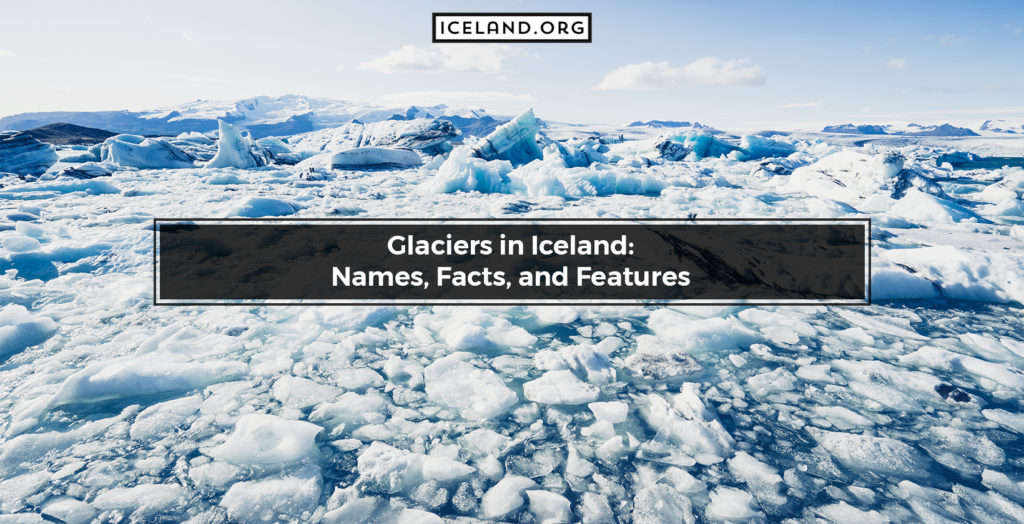
Glaciers in Iceland: Names, Facts, and Features
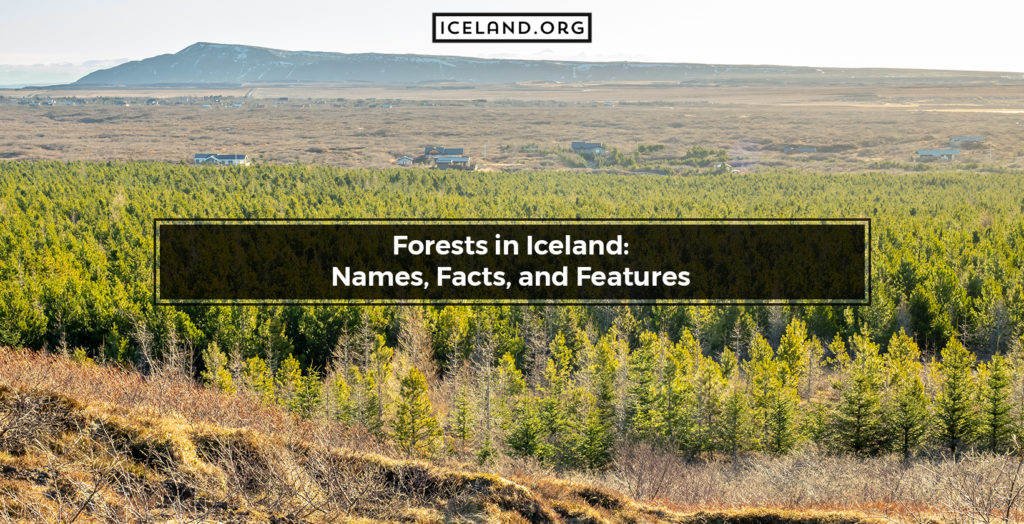
Forests in Iceland: Names, Facts, and Features
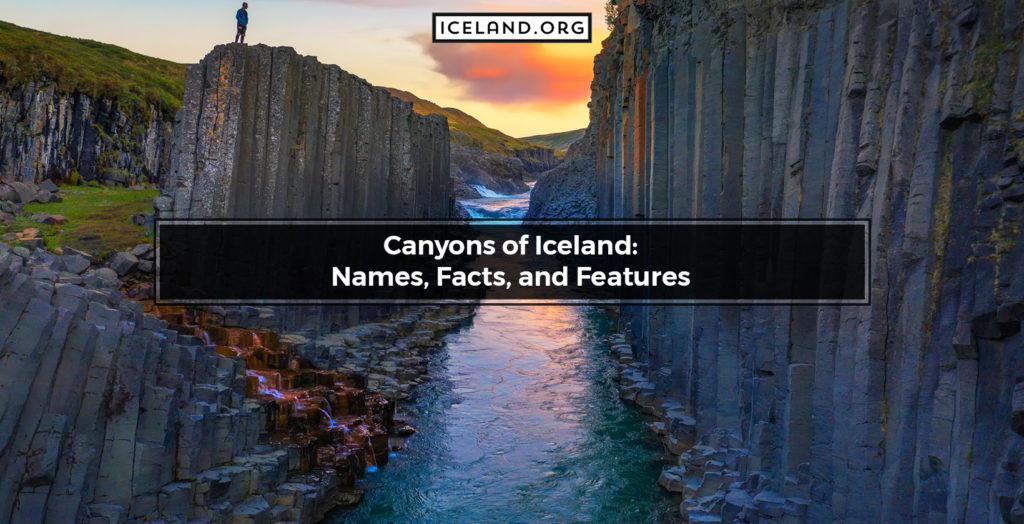
Canyons of Iceland: Names, Facts, and Features
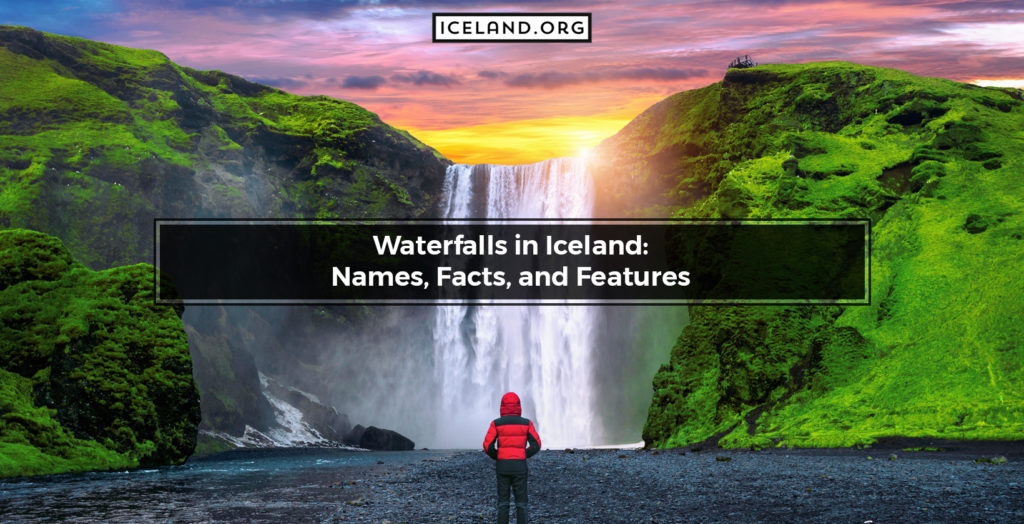
Waterfalls in Iceland: Names, Facts, and Features
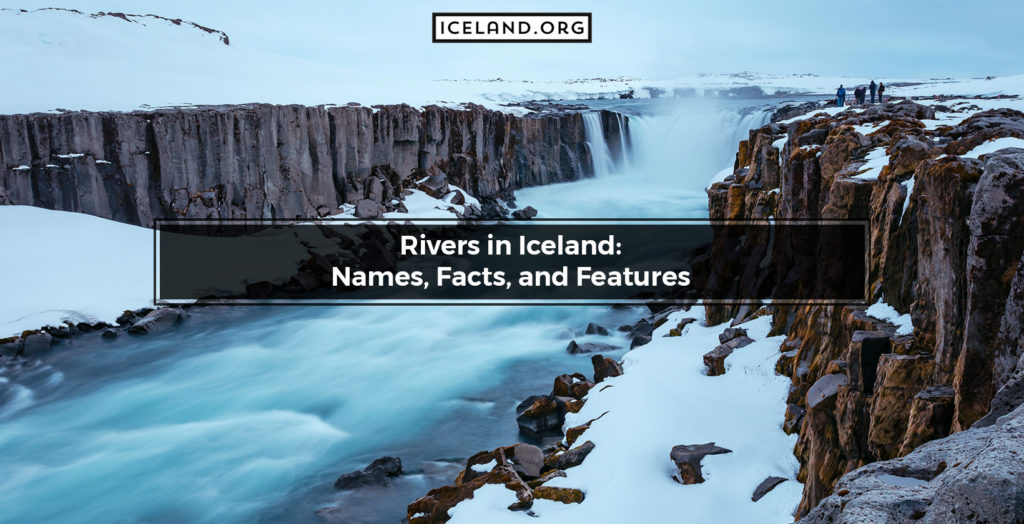
Rivers in Iceland: Names, Facts, and Features
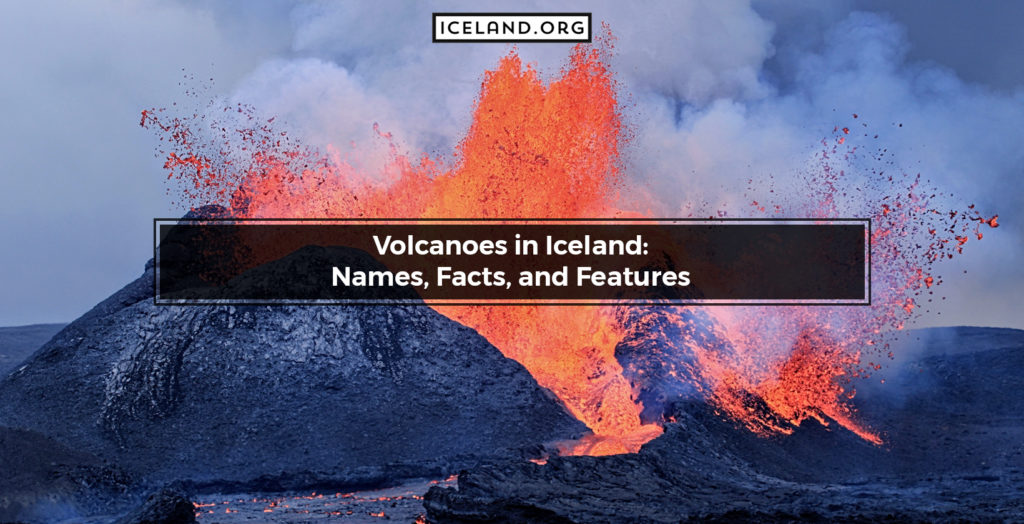
Volcanoes in Iceland: Names, Facts, and Features
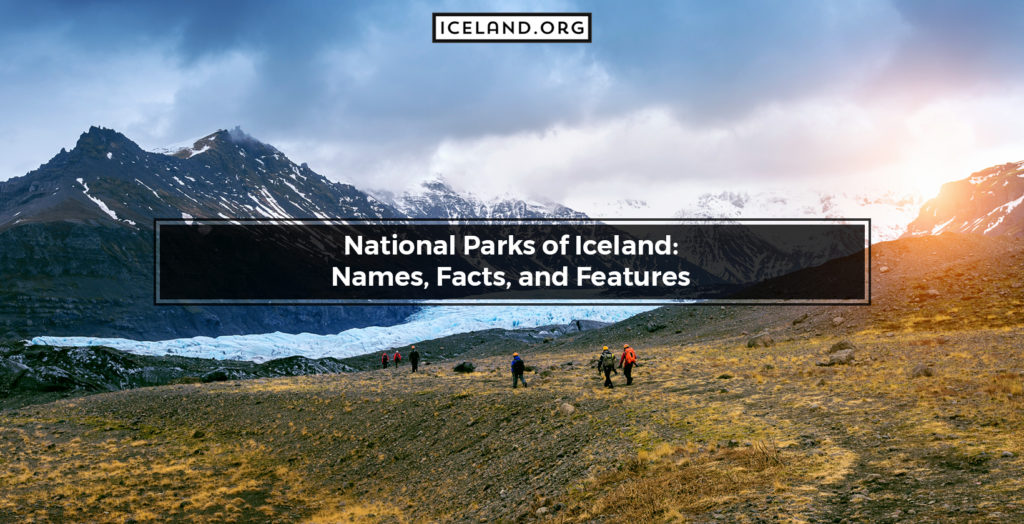
National Parks of Iceland: Names, Facts, and Features
Forget Mykonos and Santorini, Syros is the best Greek island. Here are 10 of my favorite things to do there.
- Syros, a short ferry ride from Mykonos, is a luxurious and underrated island to visit in Greece .
- I visit every year , and love spending the day at a beach club and seeing a show at Apollon Theater.
- Belle Époque, Theosis, and Allou Yialou are some of the best places to eat and drink on the island.

Tourists flock to the Greek islands of Mykonos and Santorini every summer. But people are finally starting to catch on to the fact that many popular destinations are overpriced and overcrowded.
Luckily, Greece has over 220 inhabited islands to explore — and just a short ferry ride from Mykonos lies Syros.
My grandmother is from the island, and I visit it every year. It's one of the most underrated and luxurious destinations in Greece.
Here are 10 of my favorite things to do on Syros.
Grab a coffee at Belle Époque in Miaouli Square.
One of Syros' most prominent landmarks is Miaouli Square, located just a few steps away from the harbor in the main city of Ermoupoli.
It's a great place to start exploring the island — people of all ages gather to chat and catch up, kids play, and teens socialize on the steps of the town hall.
I love sitting in one of the many cafés around the plaza, like Belle Époque, and enjoying pastries and Greek coffee while I watch the town go by.
Take a dip at Ciel Syros.
Ciel Syros is a beach bar located near the picturesque neighborhood of Vaporia. But there's no sand there — you can eat and drink on a promenade over the water and dive directly into the sea.
The water here is a beautiful, deep, clear blue, but there are no shallows, so it's only recommended for strong swimmers.
You may occasionally get sprayed by waves while enjoying your drinks, but the atmosphere is always fun, especially on summer afternoons when there are endless parties with Greek music.
Window shop in the streets of Ano Syros.
If you can manage all the steps, walking uphill to Ano Syros from Ermoupoli is a treat.
You'll find a lot of craft, jewelry, clothing, and other shops, as well as cute cafés to explore in this part of the island.
Make sure to arrive in the morning or late afternoon as many stores close for a bit around midday.
Get a cocktail at Theosis.
Theosis Bar is a newer addition to Ano Syros. It's o wned by the same man who operates Kouchico — one of the best cocktail bars in Ermoupoli — and serves carefully curated and crafted drinks.
Instead of tables, people sit around a pedestrianized square on stairs and cushions, making the upscale atmosphere feel more casual and less stuffy.
Catch a show at the Apollon Theater.
Designed as a miniature version of the La Scala opera house in Milan, Apollon Theater hosts shows and performances on the island.
It's also one of the many reasons Syros is considered an island of the arts. Each year, the venue hosts multiple events, including an international film festival .
Spend the day lounging at Ono Concept beach club.
Agathopes Beach has always been popular with families and tourists thanks to its clear, shallow water and golden sand.
With the addition of the elegant Ono Concept beach club, which opened a few years ago, beachgoers can tan on luxurious lounge chairs while enjoying food, coffee, and cocktails.
Tour Chatzakis Winery.
In the northern part of the island, where few tourists (or even locals) venture, there's an amazing winery with a stunning view .
I recommend touring the Chatzakis facility in the evenings. Guests can sample the wines alongside charcuterie and snacks while enjoying a mesmerizing Greek sunset.
Enjoy dinner and a sunset at Allou Yialou.
Syros has become well known for its gastronomy, and Allou Yialou at Kini Beach is one of the best upscale taverna experiences.
Indulge in classic Greek family-style dining featuring plenty of seafood. You can also catch a stunning sunset here as the restaurant faces west.
Stay at one of many converted neoclassical houses.
The architecture in the streets of Ermoupoli is more reminiscent of Venice than the other Greek islands .
Syros has always been known as a very aristocratic island, and some of its old, pastel-colored neoclassical houses have been renovated into boutique hotels.
Check out Aristede Hotel, Villa Selena, or Arion for historic and luxurious accommodations with incredible hospitality.
Go to Loukoumia Leivadaras to try one of the island's specialty sweets.
Syros is famous for its loukoumia, the Greek version of Turkish delight .
The treat is available at many shops across the island, but Loukoumia Leivadaras is one of the most highly rated.
- Main content
Green Energy
Electrek green energy brief.
- Offshore wind power
Watch the world’s first artificial energy island being built [video]
The first of 23 caissons for Princess Elisabeth Island, the world’s first artificial energy island, is nearly complete.
Princess Elisabeth Island will be an electricity grid at sea that will connect offshore wind farms to the Belgian mainland and also serve as a hub for future interconnectors with the UK and Denmark. Belgian electricity transmission system operator Elia is the project’s developer.
The 20,000-ton caissons, which will form the energy island’s outer walls, are being built at Jan De Nul Group and DEME’s construction site in Vlissingen, the Netherlands. It takes around three months to build one caisson. The production process is split into five 20-day stages. The caissons are moved between the different work sites using “runners,” which takes about six hours.
When the caissons are ready, a semi-submersible vessel will transport them further down the harbor, where they’ll be temporarily stored in the water. They’ll then be moved to their final location in the North Sea this summer, weather allowing, said maritime infrastructure company Jan de Nul .
You can watch a time-lapse video of Princess Elisabeth Island’s first caisson being built here:
Princess Elisabeth Island is part of the larger Princess Elisabeth Zone, a future 3.5 gigawatt (GW) offshore wind farm in the North Sea, around 45 km (28 miles) off the Belgian coast. The world’s first artificial energy island will receive power from the wind turbines via undersea cables, and it will then be converted to high-voltage electricity and distributed to the Belgian mainland and other European countries. The energy island will combine both direct current (HVDC) and alternating current (HVAC).
The energy island will be finished in late 2026 when the electrical equipment will start to be installed. Princess Elisabeth Island is expected to be fully connected to all wind farms and the mainland by 2030.
Read more: 2023 was a record year for wind power growth – in numbers
If you live in an area that has frequent natural disaster events, and are interested in making your home more resilient to power outages, consider going solar and adding a battery storage system. To make sure you find a trusted, reliable solar installer near you that offers competitive pricing, check out EnergySage , a free service that makes it easy for you to go solar. They have hundreds of pre-vetted solar installers competing for your business, ensuring you get high quality solutions and save 20-30% compared to going it alone. Plus, it’s free to use and you won’t get sales calls until you select an installer and share your phone number with them.
Your personalized solar quotes are easy to compare online and you’ll get access to unbiased Energy Advisers to help you every step of the way. Get started here . –ad*
FTC: We use income earning auto affiliate links. More.


Electrek Green Energy Brief: A daily technical, …
Michelle Lewis is a writer and editor on Electrek and an editor on DroneDJ, 9to5Mac, and 9to5Google. She lives in White River Junction, Vermont. She has previously worked for Fast Company, the Guardian, News Deeply, Time, and others. Message Michelle on Twitter or at [email protected]. Check out her personal blog.
Michelle Lewis's favorite gear

MacBook Air
Light, durable, quick: I'll never go back.

Because I don't want to wait for the best of British TV.
Watch CBS News
Victims of Nazi concentration camps built in British Channel Islands finally being counted
By Holly Williams
April 21, 2024 / 7:00 PM EDT / CBS News
The names Auschwitz, Bergen-Belsen and Buchenwald are infamous as the scene of atrocities -- concentration camps, run by Adolf Hitler's notorious SS.
But what you may be surprised to learn, as we were, is that two Nazi concentration camps were established on British soil in the Channel Islands, around 80 miles from the British mainland. The islands lie just off the coast of France, became possessions of the English crown around a thousand years ago – and were occupied by Germany for nearly five years during World War II. Even in the United Kingdom many people don't know about the camps -- and as we discovered, exactly what happened there is hotly disputed.
Holly Williams: It's pretty well hidden, isn't it?
Marcus Roberts: Yeah, well, if you--
Holly Williams: It's all overgrown.
Marcus Roberts: If you didn't know how to get here, you wouldn't easily stumble across it.
Marcus Roberts: This was a sort of back entrance…
There's not much left of the Third Reich's Lager Sylt concentration camp… on the windswept island of Alderney -- about three miles long and one and a half wide – nature is gradually swallowing up its crumbling concrete walls.
Holly Williams: And the camp's up here…--
Marcus Roberts: These take you straight into the-- the camp.
Holly Williams: Wow.
Marcus Roberts is an Oxford-educated amateur historian who runs heritage tours. He's spent years researching this forgotten chapter in British history.
Marcus Roberts: So undoubtedly if you wanted to put-- a pin on the map, you could say, "This is where the Holocaust happened on British sovereign territory."
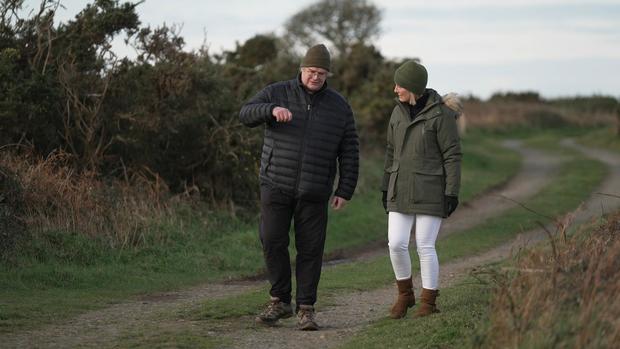
When Germany invaded France in 1940, the British government calculated that the Channel Islands had no strategic value – and gave them up without a fight. Nearly all of the residents of Alderney decided to evacuate before the German troops arrived. On the empty island, the Germans set up two concentration camps – as well as labor camps. They brought in prisoners of war and forced laborers to build giant fortifications that still survive today -- part of Hitler's Atlantic wall to protect against Allied attack. A minority of them were Jewish – others were from Russia, Ukraine, Poland, and Spain.
Holly Williams: I understand this was called the Tunnel of Death?
Marcus Roberts: Yes. It was notorious in the memory of prisoners. On two occasions, they were forced to cram in here in an apparent rehearsal for their own death.
After the war, in 1945, the British military investigated the camps, and put the death toll on Alderney in the low hundreds. Some of those who lost their lives were buried under this plot of land. But Marcus Roberts and others argue that more than 10,000 must have died on the island – based on controversial calculations about the size of the labor force needed to build the fortifications. Roberts told us it's because he's Jewish that he's determined to count all of the dead.
Marcus Roberts: There is the-- the Jewish instinct to, you know, leave no one behind
Holly Williams: You're trying to make sure that all the Jewish dead are counted?
Marcus Roberts: Remembered. If you don't remember a life, it's as if they've never lived at all.
Most academics dispute Roberts' estimate of the death toll, but partly as a result of those disagreements, last year the British government appointed a team of researchers to comb through archives across Europe, and more accurately count the number of prisoners who died on Alderney. Dr. Gilly Carr -- an archaeologist at Cambridge University -- is coordinating the review.
Holly Williams: Why is this just a document search, not a dig?
Gilly Carr: It is likely that some of the people in mass graves were Jewish. And according to Halakha or Jewish law, you cannot disturb the dead. But the second reason is that according to prisoner statements, some people were dumped at sea or thrown off cliffs. What are we going to do? Dig up the entire island? Well, we can't do that.
The researchers are drawing on rich material. The Nazis were meticulous record keepers -- and British archives contain first hand testimonies from survivors.
Holly Williams: Look at this. "We were beaten with everything they could lay their hands on: with sticks, spades, pickaxes."
Gilly Carr: It sounds absolutely ghastly.

Holly Williams: "On certain days, five to six, up to 10 men died."
Dr. Carr told us there's no evidence that gas chambers were used on Alderney -- but there were summary executions, and the prisoners built the Nazi fortifications on starvation rations.
Holly Williams: Were they taken to Alderney to be worked to death?
Gilly Carr: They were certainly seen as expendable. The aim was to get every ounce of work out of them. And if they died, it didn't matter, and that was kind of perhaps "expected."
Holly Williams: They were disposable human beings.
Gilly Carr: Yes. Yes.
Holly Williams: How did your father end up in Alderney?
At a pub in the Channel Islands, we met Gary Font. His father – Francisco Font – fought on the losing side in the Spanish Civil War, was arrested in France, handed over to the Germans, and sent to a concentration camp on Alderney. Francisco survived, and later married a British woman -- Gary's mother.
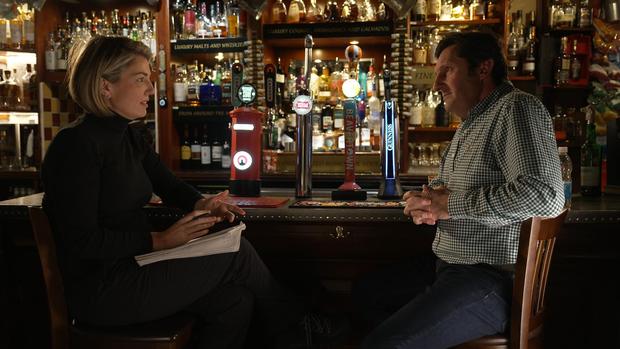
Gary Font: He witnessed-- the execution of a young Soviet boy who decided to leave the working detail and to change his footwear. So he started to pick up these paper bags, and wrap them 'round his feet, and then tie them with string. And a SS guard had seen him do this, and walked up to him and-- and shot him-- point-blank range.
Gary told us his father's experiences left him scarred.
Gary Font: I saw the emotion on his face. Yeah, it's a tough one.
Holly Williams: Do you think that emotion came from-- that he had survived the War in Spain, and survived the camp here?
Gary Font: Yeah, exactly. That was the first time I realized, "Wow, you know, this man has a deep-rooted emotion inside of him that he could never get out."
The British government's effort to get the truth out – by recounting the dead – was commissioned by Lord Pickles – a former cabinet minister and now the U.K.'s envoy for post-Holocaust issues.
Lord Pickles: The figures vary, not by a few hundred, not by a few thousand, by-- by tens of thousands.
Holly Williams: So it was the controversy that prompted you to commission the review?
Lord Pickles: Yes. It seemed to me that the sensible thing was, "Well, okay. Let's do that-- this in the open. Let's do it fully transparent.
He's also asked the researchers to put names to as many of those killed as they can.
Lord Pickles: If you remember them as individuals, then it's another blow against Hitler. Hitler wanted to eradicate the memory of people.

Holly Williams: So this is kind of an ongoing fight against Hitler and his ideas?
Lord Pickles: Hitler's evil hand still continues to affect-- to affect Europe and to affect the world.
But it's taken nearly 80 years for the British government to re-examine what happened on Alderney -- and to make its report public. The official British investigations in 1945 were classified for decades. And unlike the trials of Nazi officials in Nuremberg -- the British authorities failed to prosecute a single German officer who worked on Alderney – even though many of them ended up in British prisoner of war camps.
Holly Williams: I mean just to be clear, these are possible war criminals. The British government has gathered evidence against-- against them. And they are in British custody.
Gilly Carr: Yes, they are at this point, yes.
Holly Williams: A sort of slam-dunk case?
Gilly Carr: You'd have thought.
That's led Marcus Roberts and others to claim that the British government tried to cover-up the extent of the atrocities on Alderney. Dr. Carr told us that could be true -- but one key document from the British War Office investigation that may explain why there were no prosecutions is missing.
Gilly Carr: It could have been shredded-- decades ago as part of, "What do we need these files for anymore?
Holly Williams: But could it also have been shredded for more nefarious purposes?
Gilly Carr: I have no idea. In order for me to say there was a cover-up, I want to see the decisions taken. I want to look through those steps and to make up my own mind.
Holly Williams: Why might the British government have tried to cover up or whitewash what happened on Alderney and-- and maybe more broadly, on the Channel Islands?
Gilly Carr: There are some things that-- that happened that might not-- that the British government might not necessarily have wanted a wider audience to know about.
Those things – once feared too troubling for the broader public – happened on three of the other Channel Islands -- where most residents did not evacuate before the occupation. When the Germans arrived, the locals mostly cooperated – often with little choice. Hitler's portrait was hung outside this cinema on the island of Guernsey. Nazi propaganda showed the British police working for German troops. And British newspapers on the islands printed orders from Berlin.
Holly Williams: This is a British newspaper. And it's got the swastika on top.
Linda Romeril: That's right.

At the official archives on the island of Jersey, Linda Romeril showed us how British officials implemented Nazi policies -- asking Jewish residents to identify themselves, and then confiscating their assets.
Linda Romeril: There was a huge amount of requisitioning of people's houses, people's property during the occupation period.
But some resisted -- risking punishment to paint anti-nazi graffiti, and illegally listening to British news on the radio.
Jenny Lecoat: That's my great aunt Louisa. I suspect that she was probably quite steely.
One member of the resistance was Louisa Gould -- who hid an escaped Russian prisoner in her home for nearly two years. Jenny Lecoat told us when her great aunt Louisa was finally caught, she was sent to Ravensbruck concentration camp in Germany.
Holly Williams: She was killed in a Nazi gas chamber?
Jenny Lecoat: She was gassed to death, yeah.
Holly Williams: After the occupation, did the British government get in touch with your family to talk about what Louisa had done during the occupation, and about her murder by the Nazis?
Jenny Lecoat: The British government, I think, were kind of ashamed. They were horrified it had happened, and they didn't really want to get too involved in what had gone on there.
Holly Williams: Not wanting to talk about the resistance? Or not wanting to talk about the occupation at all?
Jenny Lecoat: Well, it was such a mixed picture. There were people who had resisted the Germans as much as resistance was possible within a tiny, nine-by-five-mile island. And there were also people who'd collaborated. Some people had betrayed their own country. The only possible legislation was treason, which was still a hanging offense. They didn't wanna get into that. That was the confusing, messy, dirty mixed picture of-- of the Channel Islands occupation.

We'll learn more about that messy, dirty history when the British government's review of the death toll at the camps on Alderney is published next month. But it's unlikely to satisfy everyone.
Marcus Roberts: Some kind of-- ap-- apology and, you know, moral recompense would be helpful.
Holly Williams: You-- you want the British government to apologize--
Marcus Roberts: Yeah. I'd like--
Holly Williams: --for not having prosecuted alleged war criminals?
Marcus Roberts: Yeah. So I think it would be appropriate for them to recognize what should have been done, didn't happen.
The horrors carried out on this tiny, remote island are difficult to imagine... the victims were silenced and buried… but now, nearly eight decades later, they're finally being counted.
Produced by Justine Redman and Erin Lyall. Associate producer, Matthew Riley. Broadcast associate, Eliza Costas. Edited by Peter M. Berman.

Holly Williams is a CBS News senior foreign correspondent based in the network's CBS London bureau.
More from CBS News

Secret army of women who broke Nazi codes get belated recognition

The hidden costs of unpaid caregiving in America
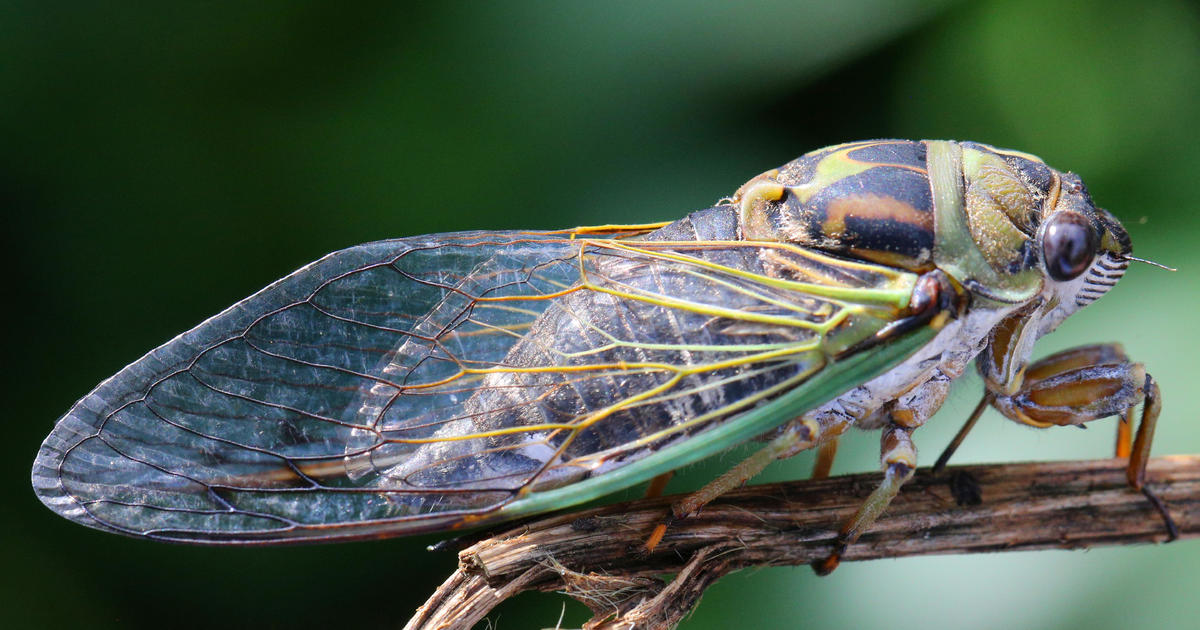
Cicadas are so loud that South Carolina residents are calling police

Romance scammers turn victims into "money mules"

IMAGES
VIDEO
COMMENTS
Geysir is a famous hot spring in the geothermal area of Haukadalur Valley, found in south-west Iceland. Geysir is less than two hour's drive from the capital, making it easily accessible for many joining a Golden Circle day tour or those who rent a car.It is also visited on countless vacation packages and self-drive tours, such as this 6-Day Guided Winter Tour and this 7-Day Road Trip.
Get started by exploring our tours to visit Geysir and Strokkur geyser in Iceland. GOLDEN CIRCLE BLOG. Your Top 15 Must-See Places Around Iceland. Volcanic peaks, Europe's largest glaciers, and otherworldly coastlines—Iceland is home to some of the most captivating landscapes in the world. And on a trip to Iceland, you'll experience some ...
The distance from Geysir to Reykjavik is 66 miles (106 km) and takes approximately 1 hour and 30 minutes when traveling via routes 37 and 365. This will take you via Thingvellir (Þingvellir) and Laugarvatn, which offer some great sights and accommodation options, if needed.
STROKKUR GEYSIR. Strokkur is the largest geyser in Iceland, located in the Geysir Geothermal Area of Haukadalur Valley in the Golden Circle. It is one of the most popular tourist attractions in the country. As mentioned earlier, it erupts hot water up to 15-20 meters (49-65 feet) and sometimes even as high as 40 meters (131 feet).
15. Golden Circle and Sky Lagoon Geothermal Spa Tour from Reykjavik. Combine the best of the most popular tour in Iceland with a relaxing soak in a geothermal spa on the Golden Circle and Sky…. 16. Private Tour Of The Golden Circle With Farm Visits In Iceland. This tour is a perfect introduction to Iceland.
Geysir. One of the highlights of Iceland's Golden Circle, Geysir is home to geysers - yes, that's where we get the English word from! - which hurl boiling water up to 200 feet into the air. Book a guided tour. Along the Haukadalur valley lies one of the most active geothermal areas in Iceland, home to a number of geysers - including one called ...
The original Geysir. The Geysir geothermal area is a well-known high-temperature geothermal area. And Geysir itself is one of the best-known geysers in the world and has given a name to other spouting hot springs around the world; geyser.In Icelandic, the term Geysir is derived from the verb gjósa, which means to erupt.. The Icelandic pronunciation of Geysir is like "hey!"
The Active Geyser Strokkur. Another geyser called the Strokkur lies about just 50 mts south of it. This geyser erupts a lot more frequently than the Great Geyser. Thus the geyser Strokkur finds its pride of place in photos and brochures. Nearby there are around 30 smaller geysers and hot pools, including a tiny one aptly called: The Little Geysir.
What is Geysir Hot Spring Area. The Geysir Hot Spring Area (Geysir) refers to a geologically active area in southwest Iceland. There are 30ish hot pools and small geysers in the area, but the main draw is the two largest geysers: Strokkur and Great Geysir. Great Geysir is the namesake and most famous geyser at Geysir.
Expect lots and lots of people. Given Geysir's location on the Golden Circle, tour buses visit this area every day and even more people take advantage of the easy driving from Reykjavik to take a day trip out of the city. If you want to avoid the largest crowds, come early in the morning (think: 8 a.m.) or later at night (go as late as ...
The Geysir area of geothermal activity in Iceland is named for the Great Geysir that has erupted sporadically in the Haukadalur Valley over the centuries. This is where the English word "geyser" originates - a term that has been in use since 1647. The Great Geysir has been erupting since the 13th century but has been relatively inactive ...
The area was once known for the famous Great Geysir, which was once of the most powerful geysers in the world. It's claimed that the old geyser would blast water over 500 feet in the air back in the 19th century. In fact, it's the Great Geysir that gave use the term "geyser" that all other geysers are known by today.
A favorite stop along the Golden Circle is the highly active Geysir Hot Spring Area with boiling mud pits, exploding geysers and Strokkur. Geysir Hot Spring Photo Gallery
The Namesake of all Geysers. The area is named after the large, infamous grandfather of all geysers, called "Geysir" (GAY-seer). With sprays once said to be up to 170 meters, the wonder of Geysir has been drawing crowds since the 17th century. ... Iceland Luxury Tours. Borgartun 23 105 Reykjavik, Iceland Phone: (+354) 554 7500
Strokkur geyser. Strokkur geyser is the most active geyser in Iceland and erupts naturally every 4-10 minutes, it usually erupts up to 15 or 20 meters (49-65,6 ft). In history books, you can find accounts of it having gone up to 40 meters (131 ft). Strokkur and Geysir are believed to be the same age.
The world's original geyser, the Great Geysir (Great Geyser) is the source of the English word after which all other geysers are named. Geysir literally means "gusher" in Icelandic, and this natural phenomenon in the Haukadalur geothermal region has been active for more than 10,000 years; records of hot springs activity in the region date back to 1294.
The word geyser comes from the Old Norse for 'geysa.' This means to gush or to rush forth. The word was first used to describe The Great Geysir, which is currently going through a dormant period. The Great Geysir of Iceland gave its name to all other geysers. It was the first geyser to ever be described in literature back in the 13th century.
Geysir. One of Iceland's most famous tourist attractions, Geysir (gay-zeer; literally 'gusher') is the original hot-water spout after which all other geysers are named. Earthquakes can stimulate activity, though eruptions are rare. Luckily for visitors, the very reliable geyser, Strokkur, sits alongside. You rarely have to wait more than ...
Where are Geysir and Strokkur located? Geysir is a prominent part of the Golden Circle along with Thingvellir National Park and Gullfoss Waterfall. Geysir and Strokkur are located in Haukadalur valley, southwest of Iceland, on route 35. The GPS coordinate is 64.3104° N, 20.3024° W.
For a look at southern Iceland's most popular natural wonders in one day, take this Golden Circle day trip from Reykjavik that includes a stop at the Blue Lagoon. The 186-mile (300-km) loop provides the opportunity for you to marvel at Gullfoss Waterfall, the Geyser area and Thingvellir National Park. Admire the otherworldly landscape of craters and canyons, and finish up at the Blue Lagoon ...
It is not exactly known when Geysir was created. It is believed that it came into existence around the end of the 13th century when a series of strong earthquakes, accompanied by a devastating eruption of Mt. Hekla, hit Haukadalur. In this geothermal valley, Geysir is located. What is known is that it regularly spouted every third hour or so up ...
Tours and Tour Guides for the Fata Geyser in Iceland are available. 8. Konungshver. Konungshver Geyser (King's Hot Spring) in Iceland is located in the southwest of the island. The Konungshver Geyser's coordinates are 64.3141 ° N, -20.3036 ° W. Konungshver was activated after the earthquakes in 1896, and its activity stopped one year ...
concerts.livenation.com
My grandmother is from the island, and I visit it every year. It's one of the most underrated and luxurious destinations in Greece. Here are 10 of my favorite things to do on Syros.
The first of 23 caissons for Princess Elisabeth Island, the world's first artificial energy island, is nearly complete. The 20,000-ton caissons, which will form the energy island's outer walls ...
Marcus Roberts: These take you straight into the-- the camp. Holly Williams: Wow. Marcus Roberts is an Oxford-educated amateur historian who runs heritage tours.